- Skip to right header navigation
- Skip to main content
- Skip to secondary navigation
- Skip to primary sidebar
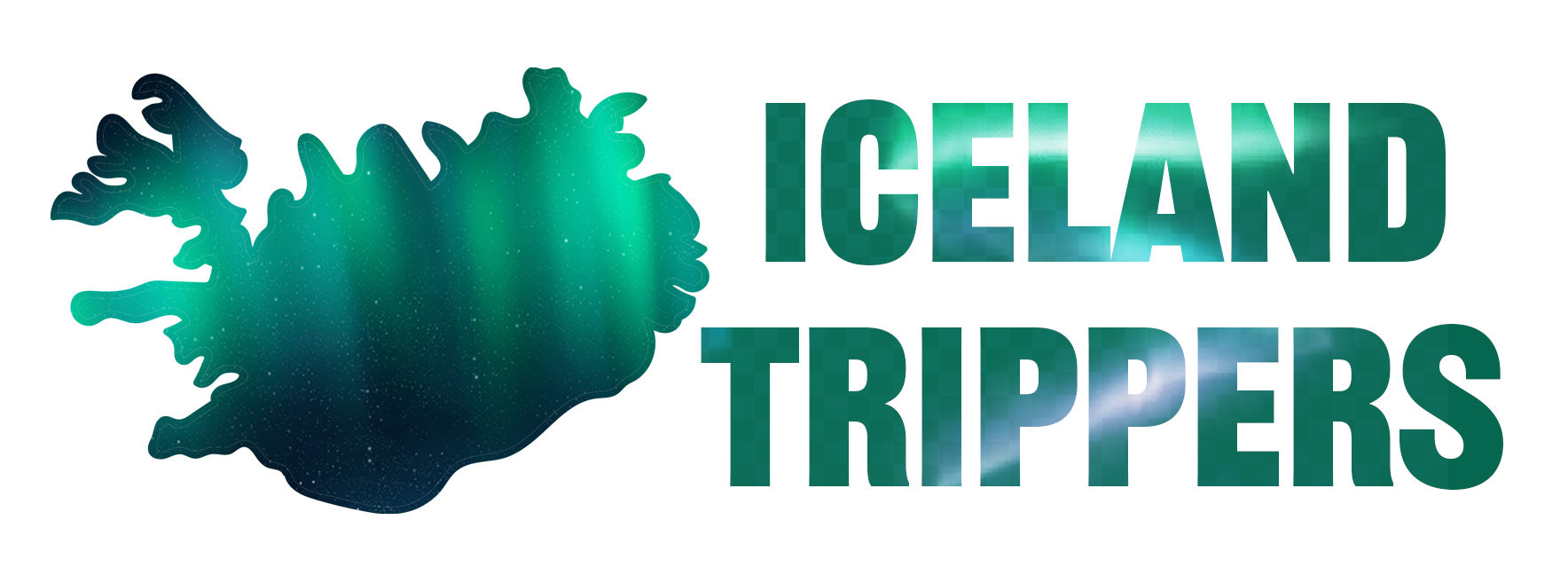
Learn how to easily plan your dream trip to Iceland with helpful guides and tips!
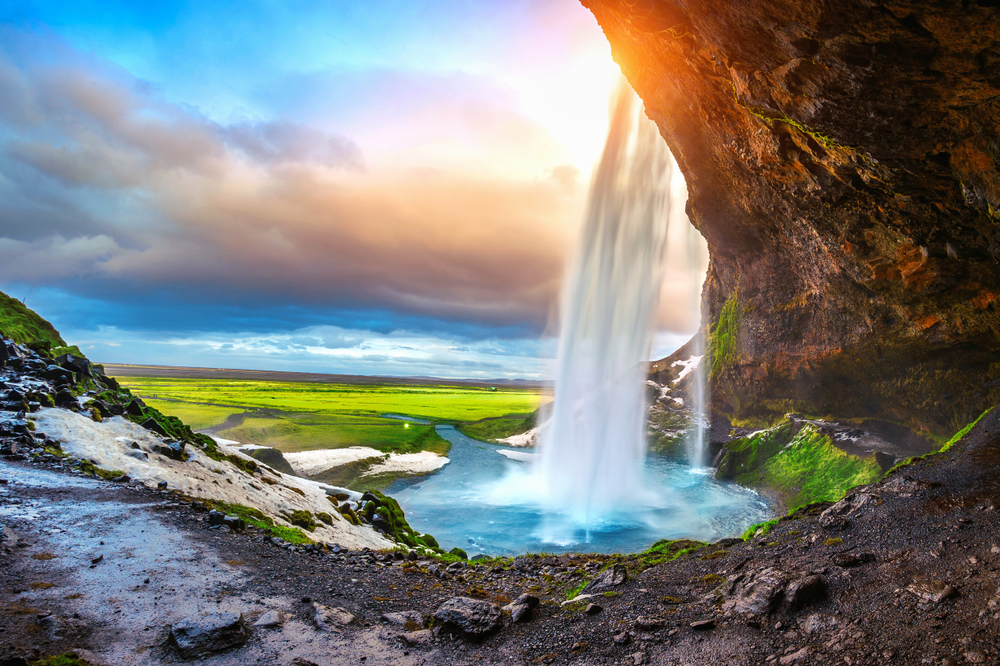

Best (And Worst) Time To Visit Iceland (Month By Month!)
February 19, 2022 // by Iceland Trippers // Leave a Comment
Deciding on the best time to visit Iceland for your needs is one of the most important parts of planning an Iceland trip. If you are unsure where to start, we have made it super easy for you by explaining what you can expect month by month.
This complete guide to the months and seasons of Iceland will fully prepare you for your trip. All of the most common questions are answered, such as when to see special things like the Northern Lights, lupine flowers, and puffins.
Planning your trip to Iceland last minute?
Make sure to book your hotels and tours in Iceland in advance to ensure availability! The longer you wait, the more difficult it gets. Here are my top picks for your trip :
Top Experiences And Tours In Iceland:
- Golden Circle Full Day Tour From Reykjavik (Likely to sell out!)
- Silfra Snorkeling Tour (Includes photos + only small group)
- South Of Iceland Full Day Trip (Our pick!)
- Whale Watching In Reykjavik (On a luxury yacht)
- Northern Lights Bus Tour (Great to go with a local)
- Ice Cave Tour And Glacier Hike (Likely to sell out)
Tickets You MUST book in advance:
- Keflavik > Reykjavik Bus Airport Transfer (Skip the line!)
- Sky Lagoon Entrance Ticket (Includes 7-step spa ritual)
- Blue Lagoon Entry Ticket With Drink (Likely to sell out!)
Top picks for places to stay in Iceland:
- Hotel South Coast (Great central location)
- Grandi Reykjavik (Includes free breakfast)
- Hotel Kria (Close to black sand beach)
- Hotel Skaftafell (Mid-range price)
Iceland is amazing , but it is also a country that must be taken seriously. Winter in Iceland is beautiful, but you must plan accordingly if that is when you are planning to visit. However, even summer has its drawbacks.
Not to worry, we have all the information you need to check off all of your Iceland dreams. The best months to visit Iceland might depend a little bit on the season, but it depends the most on you!
Get a FREE printable “Hidden Gems In Iceland” E-book by joining our private Iceland Facebook Group and sharing your photos and asking for tips and tricks.
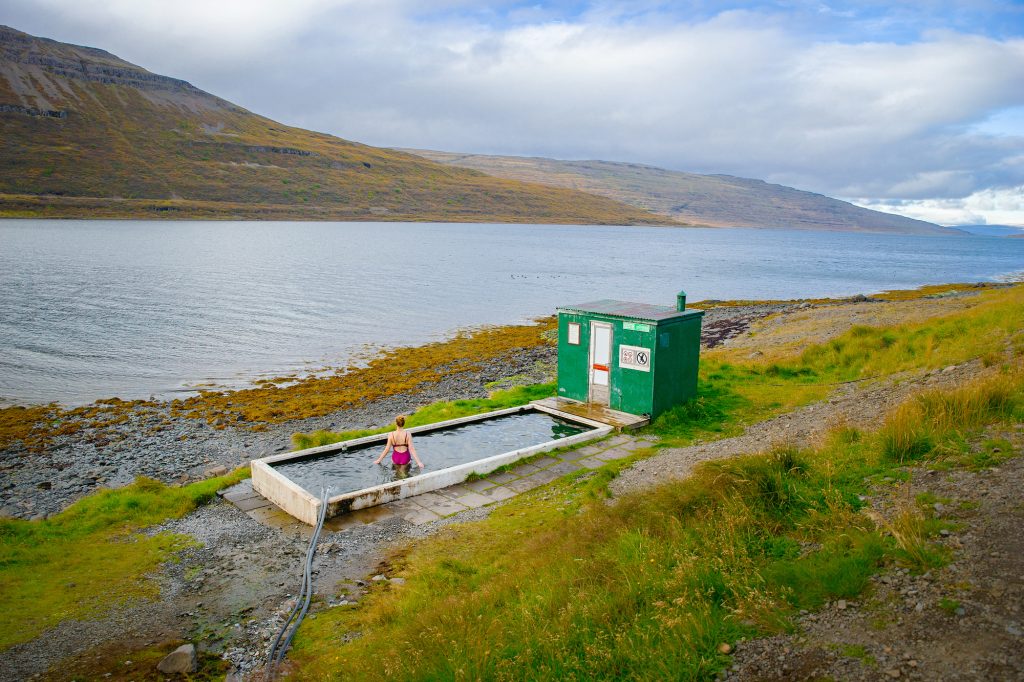
High and Low Seasons for Visiting Iceland
Like any popular tourist destination, Iceland has an “on” season and an “off” season. These times are otherwise referred to as high and low seasons (with the in-betweens being called shoulders).
The high season is when the majority of the tourists come to visit. This is generally due to the nice weather and ease of access. This is when most people plan their Iceland itinerary !
But just because the weather is colder in the low season does not mean you should not visit! Many people enjoy the low and shoulder seasons more because there are fewer crowds and it is cheaper, making it the best time to travel to Iceland for a lot of people.
You might be surprised to learn that there are indoor and outdoor activities for all of the seasons. Iceland is beautiful inside and out no matter when you visit.
High Season: June-August
Summer, summer, summer! This is the high season in Iceland for the obvious reasons: weather and temperature. It is undeniably the best weather to visit Iceland with much more sun and higher temperatures.
However, this is also by far the most expensive time to visit Iceland. Airfare, hotel fees, food prices–everything costs a pretty penny during the summer.
Not to mention the crowds. The high season is high season because it is when most people visit Iceland.
While the cost and the crowds are pretty big negatives, the high season has phenomenal positives as well. Especially if you are wanting to go to Iceland for the great outdoors. Most roads will be open during this time as well.
At the end of the day, it is all about your priorities. If weather and being able to spend the maximum time outside every day is your top priority, you are going to want to come to Iceland during the high season.

Shoulder Season: Sept-Oct & April-May
Shoulder seasons are the traveling industry’s best-kept secret. Okay, so it is not super-secret, but it still is not something people talk about as much as they should.
We hear about the high and low seasons all the time, but not so much about the shoulder seasons. They are the very beginning and the very ending of the classic tourism season.
This means that there are still more people than in the low season, but not the huge crowds of the high season. Prices are a little higher too, but still generally reasonable.
The best part of the shoulder season is that the weather is still reasonable. It may not be as great as the high season, but still totally tolerable!
Low Season: November-March
The low season in Iceland is during the typical winter months. For a country named after ice, Iceland’s winters are not that bad!
While there are some road closures, the country is still quite explorable and traversable during the cold months. And if you are coming to see the Northern Lights, this is the time to do it!
This is also the time to come if you are on a serious budget and need to take advantage of the low season prices. Traveling does not have to empty out your bank account.
The lack of crowds makes it the best season to visit Iceland on a budget! There are some trade-offs for coming during the off-season in Iceland, but there are some definite benefits too. This is actually our favorite time to go!
As we said above, the best time to visit Iceland depends on your Iceland priorities!
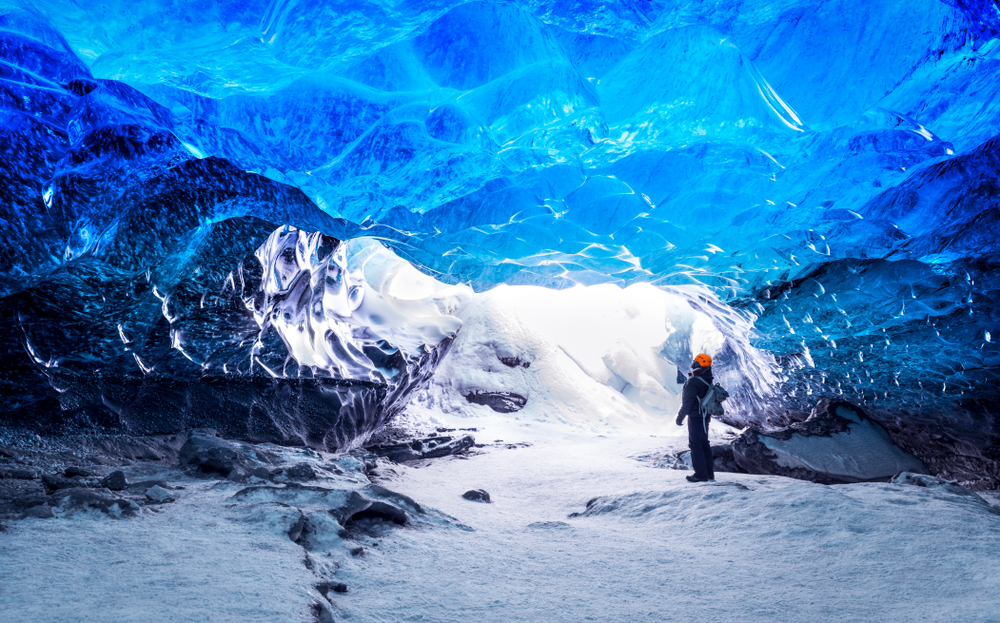
Visit Iceland in Summer if You:
-Love the idea of 24-hour sunshine. Ah, the midnight sun–you are not alone if this is on your bucket list ! If you have dreamt of Iceland’s 24-hour daylight, the summer might be the best time for you to visit.
-Are enamored with the brilliant green of summer. Iceland starts greening back up in the spring, but summer is the best time to visit Iceland if you want to see green everywhere.
The iconic lupine flowers bloom in June and July as well, creating swatches of purple across the landscape. If you want to photograph these flowers make sure to time your trip right.
-Want the best chance to spot whales. Whale watching is a popular tour in Iceland. The magnificent beasts can be spotted offshore from April through October, but the peak time to see them is in the summer.
In summer, more species are in the area and boat tours are less likely to get canceled because of weather.
-Plan on camping. Since the weather is calmer and less unpredictable during the summer, camping in Iceland is a better option for this season. You will have the least rainfall and less wind. This is especially good if you are tent camping.
-Are not bothered by crowds. Everyone loves the gorgeous, summer Iceland scenery. And we mean everyone . Iceland is a super crowded place in summer so keep that in mind.
If you hate crowds, you can still do alright coming in the summer. You will just want to visit the less popular places in the country. They may be less popular, but Iceland is amazing no matter where you go.
-Are totally invested in the traditional sense (read: financially). If you are not concerned about how much your trip to Iceland is going to cost, that saves you a lot of seasonal concerns.
Iceland is stunning in the summer, and we cannot blame you for wanting to visit when everything is so vibrant.
Just keep in mind that it is already expensive to travel to Iceland, let alone during the summer. During the high season, top tourist destinations and locations charge top dollar for everything.

Visit Iceland in Winter if You:
-Want to spot the Northern Lights. You can see the Northern Lights in the fall, but there is a caveat. You will have to stay up until around 2 am. If staying up all night is not your vibe, then winter is the best time to go to Iceland to see the Northern Lights!
In winter, there are not many daylight hours. The sun is only up from around 11 am to 3 pm. However, the increased darkness means a better chance of spotting the Northern Lights. Around midnight is the best time to spot them, but earlier or later is possible too.
-Want to visit an ice cave. The incredibly-formed ice caves are some of the best natural features in Iceland and can only be visited in the winter. Tours are lead from November to March.
-Love a good winter wonderland. There is just something magical about the way snow completely changes Iceland’s landscape. Many people absolutely love coming to Iceland during this time of year because of this.
If you love the beauty of winter, then it is the best time to visit Iceland! Keep in mind that snow has drawbacks since some roads will be closed.
-Want to stand out from the crowd. While a lot of people enjoy Iceland in the winter, the number of people who go is nothing compared to the summer.
If you are looking to do something a little different and unique, winter just might be the best time for your visit to Iceland. It certainly is not a bad time!

Visit Iceland in Fall if You:
-Do not like crowds but still want to see the Northern Lights. Even though this is the off-season, it is prime viewing time for the Northern Lights.
This is because the weather is so nice! You do not have to freeze to see the Northern Lights, just come during the fall.
An extra bonus is that there are really not very many tourists during this time. Fall is the best time of the year to visit Iceland if you want to miss the crowds and do not mind coming when it is a little colder.
-Love fall colors. Iceland is not a country that is typically praised for its fall foliage, mostly because there are not many trees. However, what trees there are turn golden along with the grasses, to create a beautiful landscape.
-Want to experience the Iceland Airwaves music festival. If you have not already heard about it then you might not know what a big deal the Iceland Airwaves music festival is. But if you have heard of it then you already know that it is a must-see!
It is a super popular music festival that happens each fall in Iceland. Usually, it is held sometime in November, but do an internet search to find the exact date.
If you love music, this festival is a great addition to your Iceland plans! Fall is the best time to go to Iceland to check it out!

Visit Iceland in Spring if You:
-Love puffins! Spring is the best time to visit Iceland if you want to see puffins . These adorable birds start arriving around April for their yearly nesting.
Puffins are some of the cutest birds out there, and you can find them all over! If you are coming to catch sight of or photograph them, just check in advance to make sure they will be in the area where you are going.
-Want to road trip without snow. As we said above, some of the roads can close in the winter. Spring is the best time to come to Iceland for better weather and open roads. That melting snow also helps to make the waterfalls flow stronger.
Not to mention that the world is coming back to life in the most beautiful way! There is something about the colorful bursts of color against the gray of winter that makes spring like no other season.
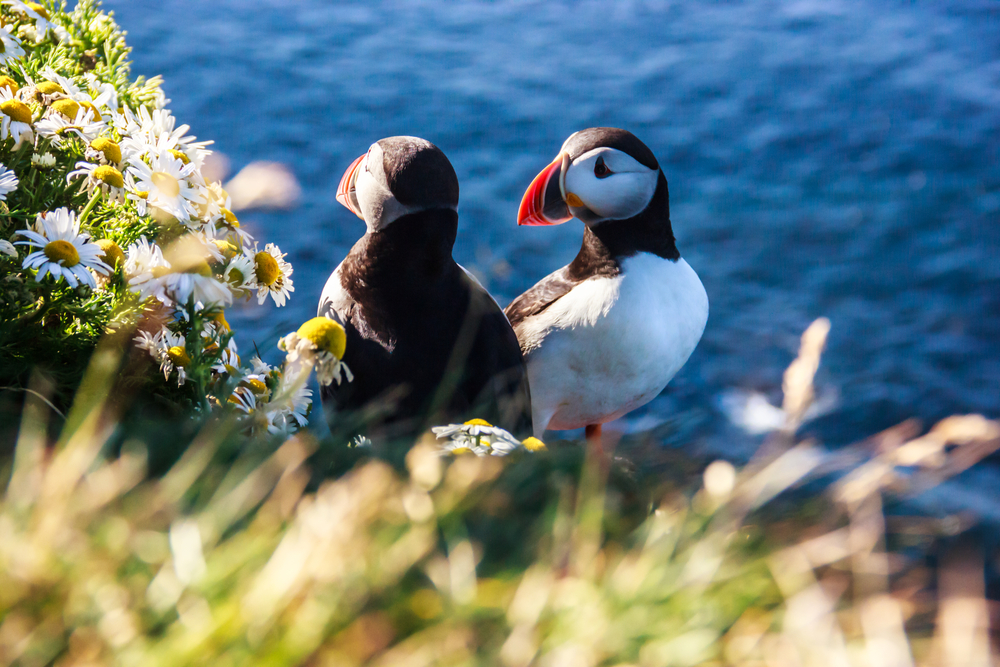
Best Time to See Northern Lights in Iceland
If you are interested in the Northern Lights, you are interested in Iceland! While there are many different places to see the Northern Lights in the world, Iceland is hard to beat.
Especially considering that there are places where you can watch them from a hot tub! The Northern Lights In Iceland are a huge draw, and if they are the reason you are coming you are not alone!
If you are wondering what is the best month to see the Northern Lights in Iceland, there are a few choices. It is possible to see the Northern Lights any month between the end of September and the end of March.
Just like the sun is out all night during summer, the nights are very long in the winter. The closer to mid-winter you visit, the longer the night and thus the higher chance of seeing the lights.
You definitely will not be able to see them during the summer! Winter is when you should book your Iceland trip if the Northern Lights are a priority.
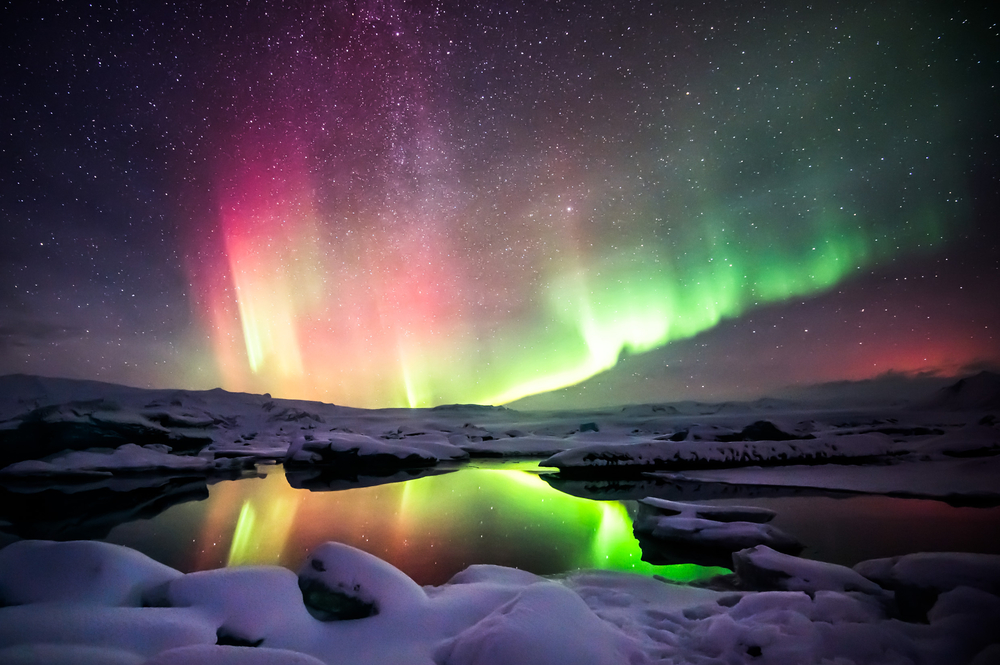
Cheapest Time to Visit Iceland
Unfortunately, Iceland is one of the more expensive countries to visit. We have gone over and over because we believe the experience is worth the money .
However, there are things you can do to make your trip much less expensive. One of those things is visiting during the Iceland off-season.
If it is your goal to do Iceland without dumping a ton of cash, we absolutely recommend the shoulder seasons or winter. Visiting right before or right after the high season of summer can save you a lot of money.
If saving money is a high priority, winter is absolutely the best time to visit Iceland. And pro tip: use grocery stores to cut down on costs even more!
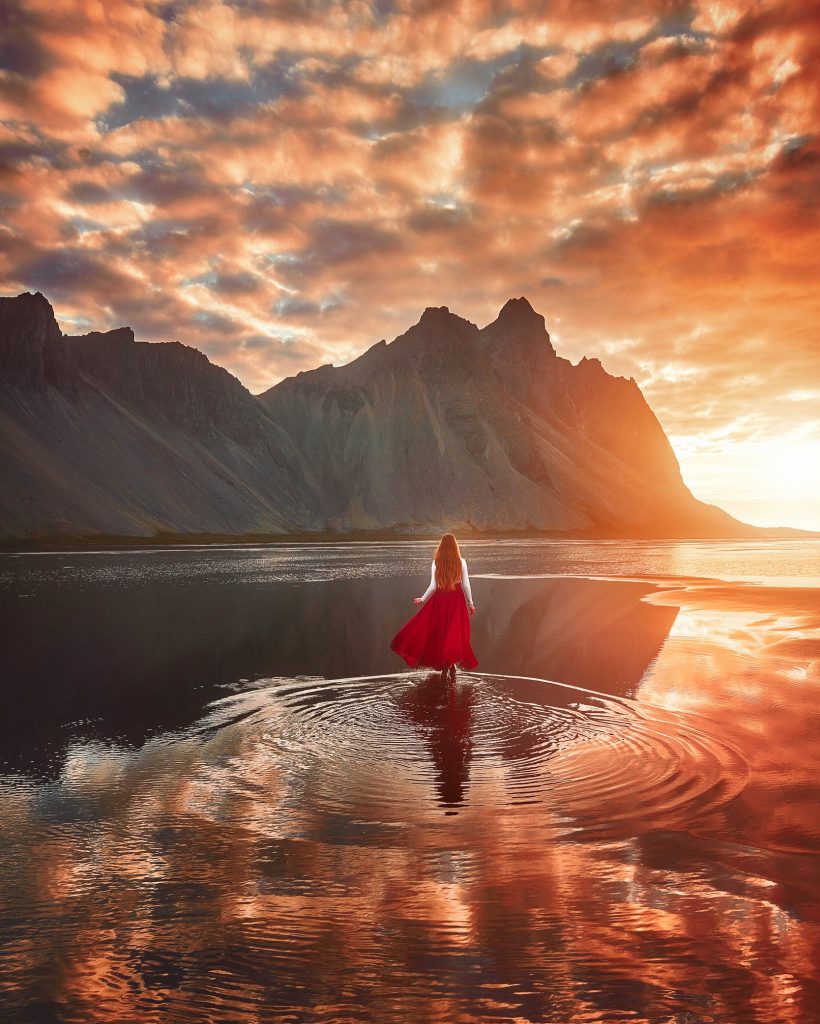
Iceland Weather Breakdown by Month
So far we have been referring to entire seasons, but we know that is kind of broad. Especially when you are planning the trip of a lifetime!
That is why we are going to break everything about Iceland Weather down month by month . This way you can know exactly what to expect.
After all, sometimes the best time to visit Iceland is simply when it best fits into your life. Whenever you make the trip, our month-by-month breakdown will help you make the most of it.
Iceland Weather in January
Happy New Year! January is a great time to visit Iceland. During this time of year you will find highs of about 36 ° F and lows of about 27 ° F.
Is that warmer than you expected? For a country named after ice, Iceland’s winters are actually quite moderate when compared with a lot of other places in the world!
That being said, January in Iceland is the coldest and windiest month. You will want to bring warm clothing and dress appropriately! Expect lots of snow and ice.
Iceland Weather in February
Honestly, the temperatures do not change much in February. What does change is the hours of daylight!
At the beginning of January, you will only get about 4 hours of daylight a day. By the end of February, this increases to about 10 hours.
February is a great month to come because there is more daylight but the crowds and costs are still at a minimum. Check out our post on things to know before you visit Iceland in February!

Iceland Weather in March
March continues with the increase in daylight hours, with about 13 hours of sunshine a day by the end of the month.
Winter weather continues in Iceland in March , although it starts sticking more to the mountaintops and less to the streets. As with most places, the weather is also better in southern Iceland than in northern Iceland.
However, it is still cold pretty much everywhere. We are getting closer to spring, but you would not really know it yet. The temperatures are still averaging between 27 ° F and 36 ° F.
Iceland Weather in April
The weather finally begins to make a bit of a change in April. Temperatures range between 32 ° F and 41 ° F during this warmer month.
What is more, there is a lot less snow! Spring starts to show its face about this time, with the country beginning to green back up again. Migratory birds start to return, including puffins.
We are also looking at around 17 hours of daylight in April as we officially move out of the low season and into the shoulder season. Don’t forget to check out this post about visiting Iceland in April!
Iceland Weather in May
May is seriously one of the best times to visit Iceland! Especially if you love the sun! The days have 20 hours or more of sunlight. It is also the driest month, with the least rainfall.
The highs are also much closer to 50 ° F, which means you almost do not even need a jacket depending on where you are from.
Of course, you will still want to bring your jackets . While the weather is much more temperate, there will still be some cold days. However, it is totally livable and the country is also becoming so much more green!
Iceland in May is also still shoulder season, which means you will not have to try so hard to find your own space while enjoying the sunshine.
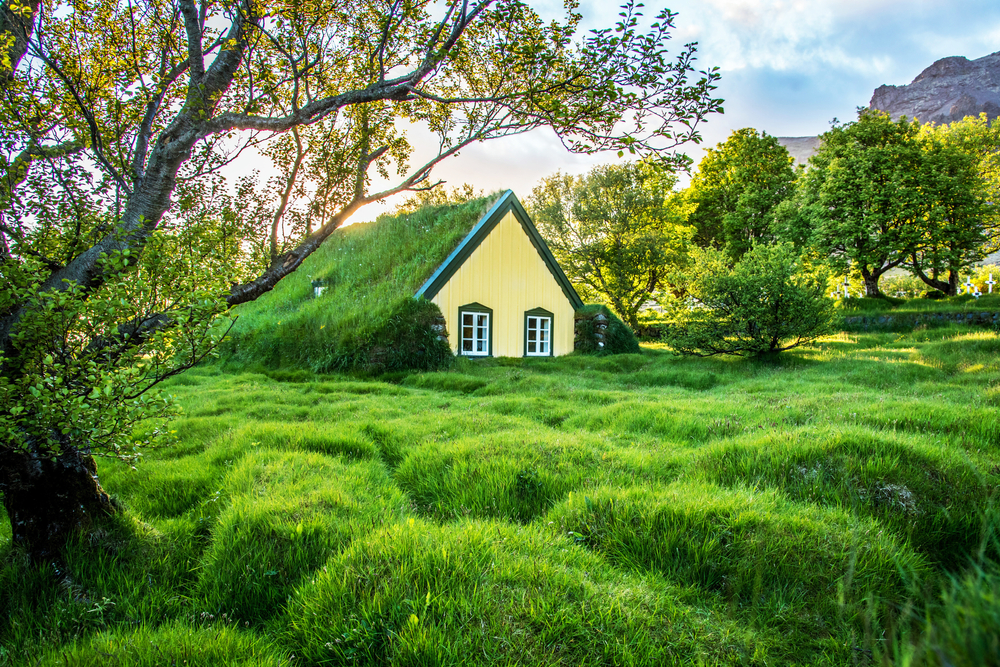
Iceland Weather in June
Welcome to high season! While it is called the high season because it is most popular among tourists, June in Iceland is also the high season for the longest days.
If getting the most out of each day is important to you, then June is the best month to visit Iceland. You can explore for many more hours in daylight.
June nights only last for about 3 hours, beginning around 11:30 PM! Yeah, blackout curtains are a big thing in Iceland summers!
While the highs average around 52 ° F, they can get much higher than that. June is the beginning of summer, and also the beginning of real warmth.
Iceland Weather in July
Now, if you are interested in heat rather than warmth , July might be a better time to visit Iceland. It is the best time of year to visit Iceland for heat, as the hottest month of the year. It is also the least windy month.
The weather in Iceland in July is generally extremely pleasant during this time of the year. While the nights are a little longer, at about 4 hours long, they do not increase by much!
Keep in mind that “hot” does not mean the same thing in Iceland as it does in other places. The average highs are around 56°F. That is part of why it is one of the most popular times to visit because it does not get any warmer than this.
Iceland Weather in August
August is the last month of the high season. While the beginning of the month is still as warm as July, temperatures start to go down by the end of the month.
August is the best time to go to Iceland if you do not mind the crowds due to the fairly standard daylight hours. The sun sets around 9 PM and rises around 5 AM. August has the least cloudy days as well.
Do keep in mind that August in Iceland goes quickly from summer to fall. By the end of the month, the slight bite to the air will have you wishing for warm pumpkin pie and spiced apple cider.
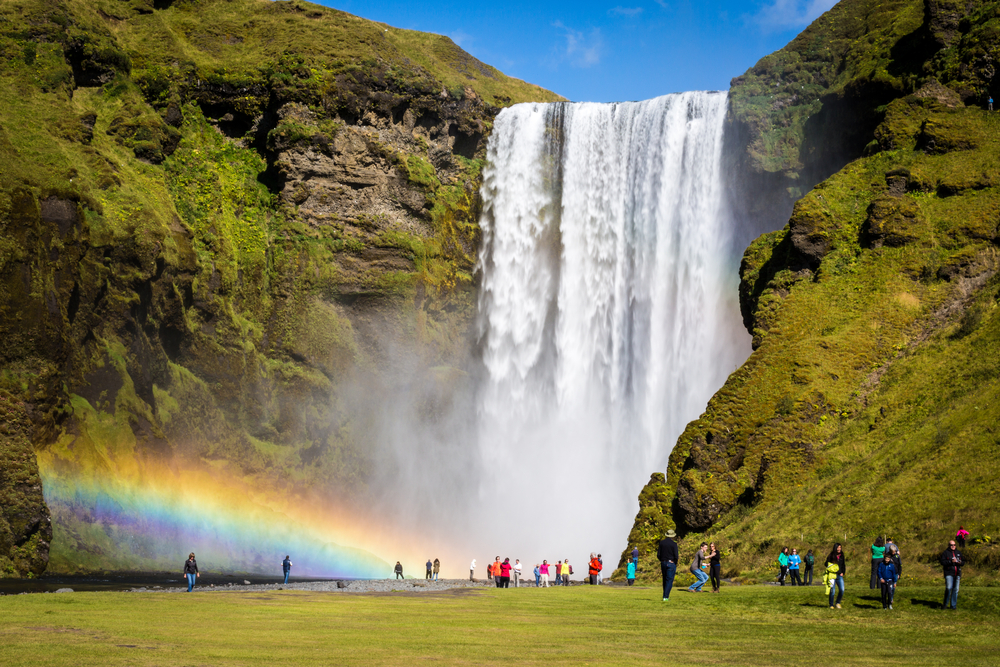
Iceland Weather in September
September still has great sunshine for Iceland, but it does go down to just below 12 hours by the end of the month. It is the warmest month with a chance to see the Northern Lights.
Temperatures are still quite nice, and we are back in shoulder season. This means that you can enjoy the nice weather and decent daylight hours without all the crowds of summer.
By the end of the month the likelihood of snow increases. If you visit Iceland in September , you will want to pack your warm clothing!
Iceland Weather in October
October in Iceland is still technically part of the shoulder season, but it is starting to feel much more like the low season of winter. Daylight is down to about 8 hours a day.
In addition, the average temperature is dropping back down to about 41 ° F. While it is not absolute winter yet, the weather should be taken into consideration at this point.
Bring warm clothes and waterproof ponchos. October is the wettest month in Iceland with an average of 14 days with precipitation.
Although it is colder, October is the best time to visit Iceland if you want to explore with as few crowds as possible. The roads are still open and you can still go pretty much everywhere you want.
Iceland Weather in November
Welcome to winter and the off-season in Iceland. November begins the coldest time of the year, although December and January are colder. This is when the snow starts to fully cover the island.
The average temperature is 38 ° F, but it can get much colder. Daylight only lasts about six hours.
We love to visit Iceland in the low season, and really do think it is one of the best times to visit Iceland. You just have to be prepared for the lower temperatures and the weather.
Iceland Weather in December
The last month of the year is one of the coldest months, second only to January. Temperature highs only reach about 39 ° F. It gets as cold as 21 ° F.
In addition, Iceland in December sees quite a lot of precipitation and snow. Daylight hours are generally pretty short.
However, this does make it and January the best time to visit Iceland for the Northern Lights! However, it is also the cloudiest month, meaning the lights can get obstructed.
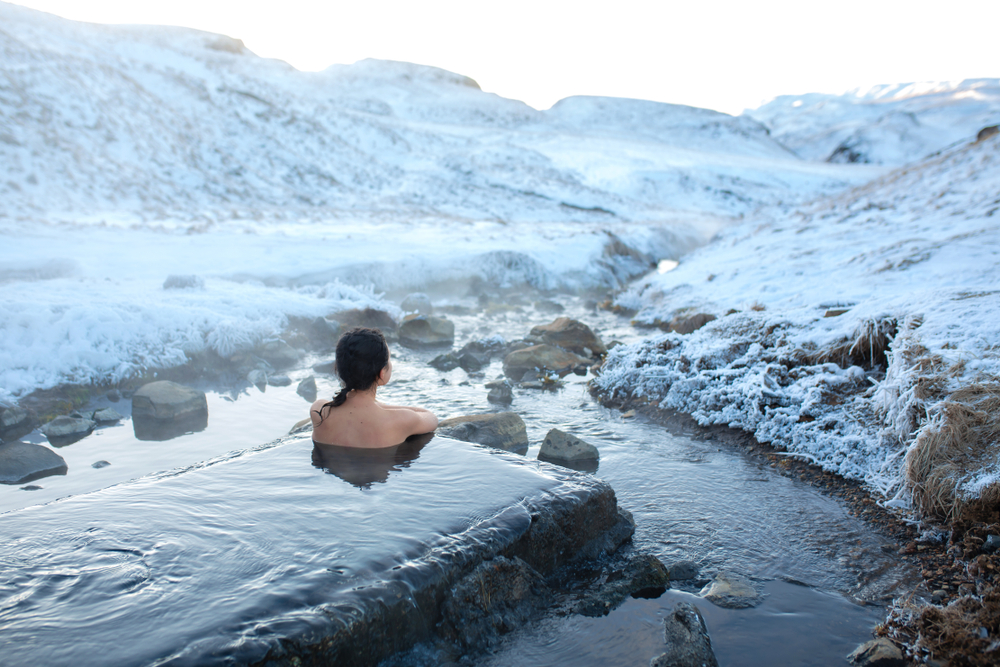
Iceland Events and Activities by Month
While the weather is a big deal, sometimes it is not as important as what you can do. After all, most weather is survivable if you plan and dress accordingly.
If you are more curious about what is going on than what temperature it will be, we have you covered! We have broken down the events and activities you can do during each month of the year.
You might be surprised by some of your options, especially during the winter!
Iceland in January
Can you even go wrong with New Year’s Eve when you are celebrating in a different country? Especially Iceland!
The country takes this holiday seriously with partying on New Year’s Eve, sleeping on the first, and shopping on the second.
And then there is Christmas–that is right, Christmas extends into January in Iceland, with the last day being on the 6th. If Christmas is your favorite holiday, then the end of December and the beginning of January is definitely the best time to visit Iceland.
Another great January tradition in Iceland is Thorrablot . This pagan celebration was canceled when Iceland went Christian but has had a resurgence in the last couple of centuries.
It is a week-long celebration of an Icelandic tradition that will not disappoint. If you want to feel like a local, prepare yourself for some things you have never eaten before, like rotten shark meat, boiled sheep’s head, and congealed sheep’s blood.
Iceland in February
February is beloved for the Winter Lights Festival . As a celebration of bright and happy things, you will love the way they light the streets with brilliant fluorescence to chase the darkness of winter away.
Öskudagur is basically Icelandic Halloween. The kids dress up in great costumes, and instead of the “trick or treat” chant, sing for their candy.
The Icelandic Food and Fun Festival is a fantastic festival that celebrates Icelandic cooking. And not even the kind that uses blood and rotten shark meat! It is all about using ingredients native to Iceland and enjoying all the culinary joys the country has to offer.

Iceland in March
Did you know that Iceland had its own prohibition period? Beer with an alcohol level of over 2.2% was banned for the majority of the 1900s but legalized again in 1990.
Iceland celebrates this legalization with the unofficial holiday, Beer Day, on the first of March every year! We think you can probably guess what the main activities are. (Drinking beer.)
DesignMarch is similar to the Food and Fun Festival in that it is a celebration of Icelandic creativity. The event features purely Icelandic products and goods.
Continuing in a similar fashion, the Reykjavik Folk Festival honors centuries of traditional music and song.
Iceland in April
Iceland celebrates Easter for days just like Christmas. Honestly, we do not know why more countries do not do holidays like this! Celebrating with just one day is so minimal!
Easter lasts from Holy Thursday to Easter Monday in Iceland. It is generally spent with family, rather than with huge parties.
April’s other holiday is the first day of summer. Given the dark of winter and the light of summer, and the very small in-betweens, Iceland actually does not traditionally recognize spring and autumn as seasons. So summer starts in April!

Iceland in May
The Reykjavik Art Festival is a big deal in May! People come from all over the world to participate in and experience creativity and fun.
If art is not your thing, May still might be the best time to visit Iceland with the Rite of Spring Festival. We know, we know, we just told you there is no spring in Iceland.
But when Iceland gave up its traditional calendar, they adopted spring and autumn into their new calendar. And they like to welcome spring with heartfelt jazz and folk music!
Iceland in June
It should come as no surprise that a country that willingly eats rotten shark meat celebrates the sea! Iceland’s Festival of the Sea happens in June, and it honors the country’s long tradition of seafaring.
Iceland also celebrates its independence from Denmark every June 17th. Like the 4th of July in the United States, Iceland National Day is a country-wide affair filled with parades, concerts, and general enjoyment of Icelandic culture.
Summer Solstice takes advantage of the Midnight Sun with all-night rock concerts. You can also join the locals in watching the sun set and rise all within the course of 2-3 hours.
Another unique Iceland festival is the International Viking Festival . It is a days-long holiday event that pays tribute to Iceland’s fierce Viking history.
Iceland in July
Innipukinn Festival is another music festival that happens in July. If you are not already getting the sense that you can hit up a music festival basically anytime you visit Iceland, well, you can. Icelandic people really love their music, okay?
They mix things up a bit with LungA , a festival specific to the Icelandic town of Seyðisfjörður . This festival still has music (as any good festival does) as well as art!

Iceland in August
Verslunarmannahelgi–say that five times fast, we dare you! Honestly, if you can pronounce it once we will be impressed. Verslunarmannahelgi happens the first weekend of August and is a quick bank holiday (kind of like Labor Day in the US). People generally celebrate by going camping.
Gay Pride comes the second weekend of August, and nowhere celebrates it as Reykjavik does! With parades, parties, and concerts, this is truly a vibrant and fantastic event.
If you like running, (like, really like) then the third weekend of August is the best time to visit Iceland! This is when the Reykjavik Marathon occurs, and it is another event that attracts people from all over the world!
The marathon wraps up with Menningarnott , a fantastic cultural celebration with cultural events, fireworks, and you guessed it, great music!
Iceland in September
The capital city of Reykjavik has two festivals in September, making it the best time to visit Reykjavik if you are wanting to have some fun during the shoulder season.
First is the Reykjavik International Literary Festival . This one is not just a big deal to Iceland, it is actually the biggest literary festival in Northern Europe!
Next is the Reykjavik International Film Festival . There is just something about literature and film that make them go hand in hand. Both of these festivals draw people from all over the world, but especially the film festival!
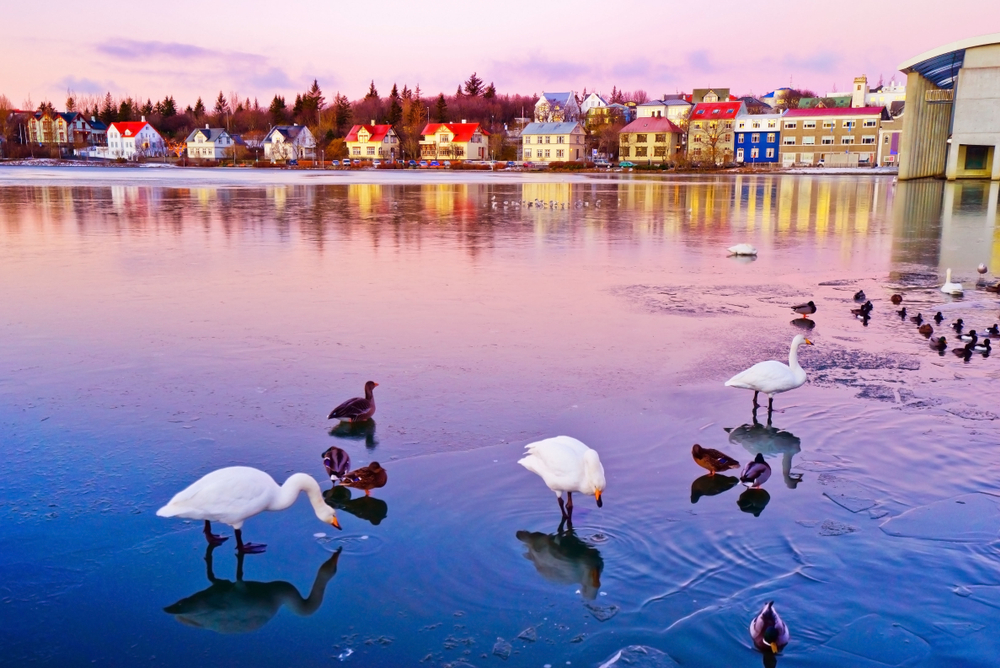
Iceland in October
Iceland Airwaves is another music festival but centers on indie and alternative music rather than the traditional folk and rock music of so many other festivals. Of course, folk and rock music still abound!
Iceland also celebrates Halloween in October, although they have not been celebrating it as long as other countries and do it a little differently. It is more of an adult holiday, but still features costumes!
Iceland in November
November does not have a whole lot going on in the realm of festivals and events. What it does have, though, it makes sure to do well.
Frostbiter is Iceland’s Horror Film Festival. So while Iceland does not have much going on in November, it is still the best time to visit Iceland if you love horror!
Iceland in December
Sorry not sorry, but Iceland has the best Christmas lights. Seriously, you have to check them out! Because the country is so dark all the time in December, they go all out with the Christmas lights.
And the way they make such a contrast against the dark? Unbeatable.
Everything about Iceland Christmas is simply unbeatable. From the concerts to the food to the country’s own unique and fun traditions, you will absolutely love it.
New Year’s Eve is filled with fireworks, bonfires, and singing. There are even costumes!
And they do not wrap things up and go to bed at midnight. Iceland New Year partying lasts long into the early hours of the next day.
December is the best time of year to travel to Iceland if you love all the December holidays!
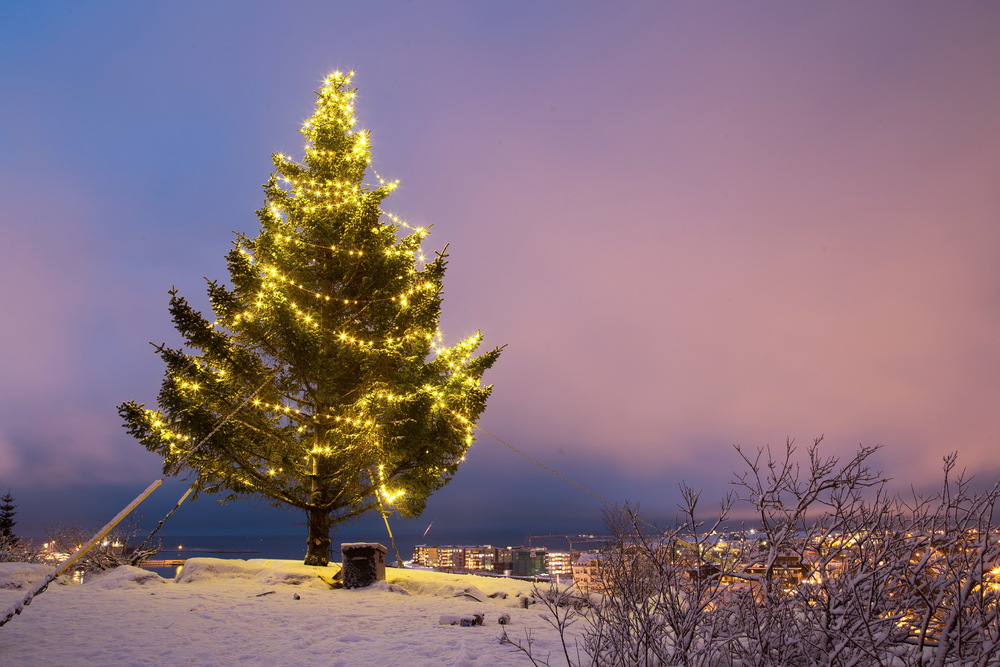
When is the Worst Time to Visit Iceland?
Honestly, there is really no bad time of year to visit Iceland as long as you plan accordingly. After reading this article, you should have a good idea of what each month has to offer in terms of weather, natural events, and festivals.
As long as you visit when you want to and pack according to the season , you will be in Iceland at the right time.
If you want to see the Northern Lights, summer is the worst time to visit Iceland. But, if you want clear roads for your rental car and warm weather, then winter is the worst time to visit.
So, When is the Best Time to Visit Iceland?
At the end of the day, the best time to visit Iceland is 100% up to you! Whatever your interests are and your budget will determine when you should visit this amazing country.
After all, this is your trip to Iceland. Plan it around what you want to see and do.
Do you want the midnight sun and purple, lupine flowers? Come during summer. Hate crowds and overpaying, but want decent weather? Give shoulder season a try. Does your Iceland bucket list involve the Nothern Lights or ice caves? Winter is your best bet!
Iceland is gorgeous year-round, and you really cannot go wrong no matter when you visit!

We hope our guide to the best time to visit Iceland has been helpful! Feel free to let us know when you decide to go in the comments below. What is your favorite time to travel to Iceland?

Reader Interactions
Leave a reply cancel reply.
Your email address will not be published. Required fields are marked *
Save my name, email, and website in this browser for the next time I comment.
- Skip to main content
- Skip to secondary menu
- Skip to footer
ZigZagonEarth
Plan unforgettable road trips!
Best time to visit Iceland in 2023 (northern lights, wildlife, roads…)
Last updated on November 1, 2023 by Claire Robinson - this article contains affiliate links. If you purchase through them, I get a small commission ( more )
When is the best time to visit Iceland? The truth is: anytime of the year. However, you may be interested in specific sights, so below are more specific answers:
- best time to visit Iceland for northern lights,
- Best time to see puffins, whales, lupin flowers in Iceland,
- best months to visit Iceland based on driving conditions and crowds.
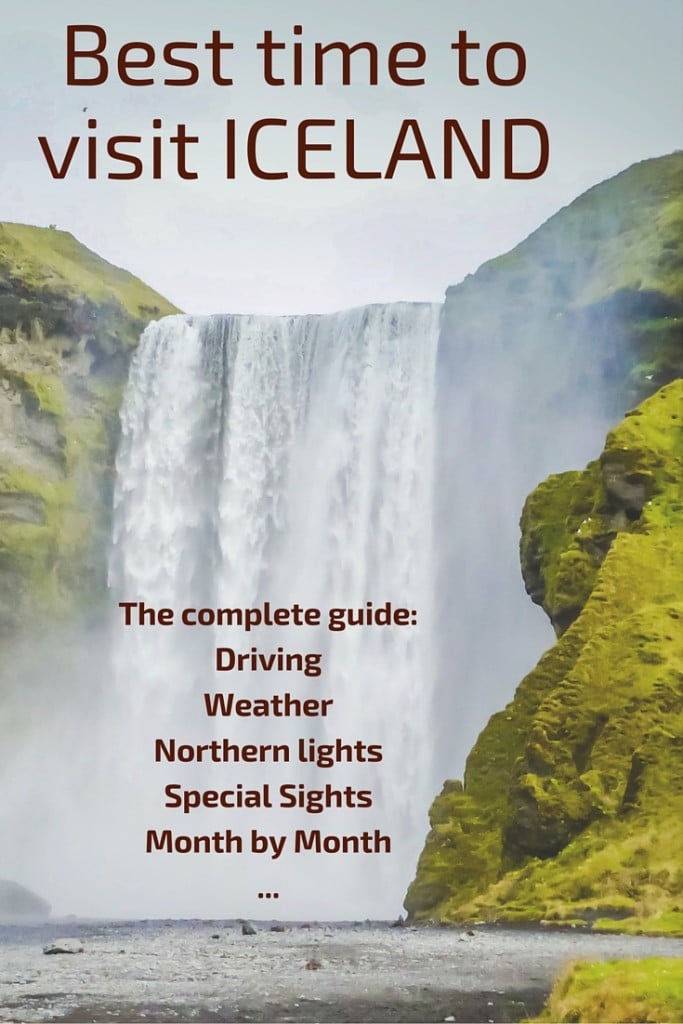
OVERALL – When is the best time to visit Iceland in 2023?
Visual overview – every year.
It really depends on what you want to see. The article below, gives you explanations about where and how to see all those special sights, but here is an overview picture to help you identify the best time for you to visit Iceland:
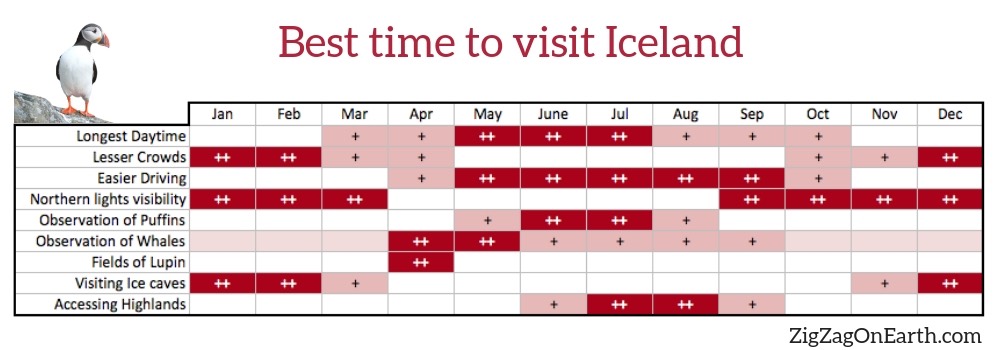
Best month to visit Iceland in Summer
I think Beginning of September is the absolute best time to visit Iceland because:
- Roads are in good condition
- The day is long enough to be able to see many Iceland Attractions
- There is enough nighttime to have a chance to see the Northern Lights
- There are less tourists than in Summer, but accommodations are still open
- The Central Highlands roads are normally still open
It is my opinion that it is the best time to see Iceland generally, but it does not take into account your wishes for special sights. So, let’s have a look in more details.

My favorites to plan your Summer Iceland trip:

My favorite platform to rent a car in Iceland: Discovercars

My favorite places to stay around Iceland:
- Reykjavik , the capital, of course: Reykjavik Konsulat Hotel
- Vik to explore the South Coast: Hotel Vik i Myrdal
- Lake Myvatn, in the north: Hotel Laxa
- Borgarnes , between Snaefellsnes and Silver Circle: Hotel Hamar

My favorite bus tour from Reykjavik (Summer): Amazing Snaefellsnes Peninsula

My favorite activity around Iceland (Summer): Whale watching from Husavik (best) or Reykjavik or Akureyri

My favorite platform to book travel-packages in Iceland: guidetoiceland
Best month to visit Iceland in Winter
I think the end of February is the absolute best time to visit Iceland in Winter because:
- The natural ice caves are still accessible

Before my tips + photos, here are my favorites to plan your Winter Iceland trip:
- Vik to explore the South Coast: Hotel Vik i Myrdal
- Lake Myvatn, in the north: Hotel Laxa
- Borgarnes , between Snaefellsnes and Silver Circle: Hotel Hamar
My favorite bus tour from Reykjavik (Winter): Chasing Northern Lights even without guarantee of seeing them

My favorite activities around Iceland: Visiting an ice-cave and Walking on a glacier
Specifics for 2023
Things to consider if planning a trip to Iceland in 2023 (in theory, but check the latest decisions for large gathering due to the virus):
- 3rd to 6th February – Reykjavik Winter Lights Festival
- Late March – Iceland Winter Games (maybe)
- June – Reykjavik Arts Festival
- June 17 – Icelandic National Day
- 8nd to 13th August – Reykjavik Pride
- December – Christmas villages
- Mid-December – Yule Lads Baths in Myvatn
You can see the complete list of festivals and events here
Best time to visit Iceland for Photography
There is no answer to that. There are great opportunities all year long with midnight sun in June, auroras in Winter… I would just recommend avoiding July and August as those are the most crowded months without something extra specific to photograph.

Conditions – Best times of the year to visit Iceland (weather, daytime, crowds…)
Length of the days.
Because of its Northern Latitude, sunrise and sunset times in Iceland vary greatly. So depending on when you visit the country, you might be limited in terms of light and can see more or less locations during the day.

Below is the amount of daylight to expect for different periods of the year
- March – 10 to 13 hours of daylight
- April & May – 13 to 20 hours of daylight
- June – 20 to 24 hours of daylight
- July & August – 15 to 20 hours of daylight
- September & October – 8 to 14 hours of daylight
- November to February – 4h30 to 8 hours of daylight
It is also important to consider how long nighttime is to see the Northern lights (more on that later).
WEATHER – Best time to travel to Iceland
I don’t recommend using weather as your first criteria for the best time to visit Iceland as it is very unpredictable. In the same day you can see the blue sky, get rain, experience strong windy moments and even get snow!
You don’t come to Iceland for the weather. Any conditions will render the landscapes magical. Just have a look at Jokulsarlon below:

You should just know that it can be cold in Summer and it is actually not as cold as we imagine in Winter. For example:
- Average temperatures in January are between -3°C and 2°C (not the -20 we were all imagining…)
- Average Iceland Summer temperatures : 8 to 15°C
Check out my complete article with detailed suggestions and tips on what to wear and pack for Iceland
How to avoid the crowds in Iceland
Of course, the Summer months are the more crowded. Actually the land is so vast that you don’t feel it when driving. You feel the crowds at each of the famous locations e.g. Golden Circle, Jokulsarlon, Seljalandsfoss.
- Therefore, I recommend traveling in April/May or September/October
- If you really want to travel in Summer, then you either go very early to avoid the crowds (lots of daylight hours) or you go to less visited areas such as the Westfjords.
Planning – Best time to go to Iceland
Driving conditions.
Driving might be one of the most important things to consider when deciding the best time for you to visit Iceland:
- The F roads to the magnificent Central Highlands are open only from Mid-June to September (depending on conditions)
- Apart from Road 1, ice and snow will be your driving partners from November to March
Check out my articles about Driving in Iceland in Summer and Driving in Iceland in Winter with videos.

Need to rent a car in Iceland?
- Compare prices on my favorite platform: Discovercars.com – one of the best rated comparison sites!
- Prefer a compact car for the narrow streets in villages
- Consider their full coverage option – it for peace of mind!
- Book early to have a large choice of vehicles!
See all my tips

Accommodations
There are more and more accommodations in Iceland so it might change. But keep in mind (at least for a couple of years):
- In Summer there are many tourists and accommodations are full very quickly
- In Winter, there are not many open accommodations, so they also get booked quickly
- The shoulder months of May and September are maybe the easier time to find accommodation in Iceland
In any case, if you plan on visiting remote locations in Iceland, you should book your hotels or guesthouses in advance. Check out my Iceland Accommodations article for general information and 12 suggestions with personal reviews.
Planning a road trip – things to see
It is possible to go on a road trip both in Summer and in Winter. However, in Winter, many points of interest are not accessible. The places that can be visited in both Summer and Winter offer magical experiences all year round. Below you can compare the waterfall of Skogafoss in both seasons. You can see more example on my Summer vs Winter article .

To plan your itinerary, you can check out:
- My general post about planning an Iceland road trip
- My suggested itineraries for 5 days in Iceland
- My suggested for 7 days in Iceland itineraries
- My 4 itineraries to spend 10 days in Iceland
- And my favorite itinerary for 14 days around Iceland
- or get one of my practical eBooks to help you plan your ideal itinerary:
Plan your dream trip to Iceland with my guides!
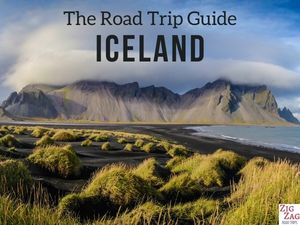
- 8 easy-to-plan maps
- 100+ pre-selected locations
- GPS coordinates
- Useful planning tips
- 130+ large photos
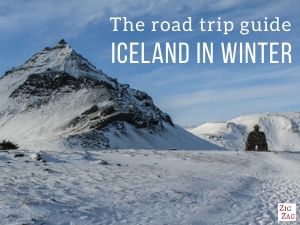
- 6 easy-to-plan maps
- 75+ pre-selected locations
- 115+ large photos
Best time to visit Iceland for NORTHERN LIGHTS
The northern lights, also called aurora borealis, are lights (often green) which seem to dance in the sky. To be able to see them, you need a dark night and a clear sky. So, when is the best time to visit Iceland for Northern lights?

Best time to go to Iceland for Northern lights
The best months to see the Northern Lights are from late September to March , when there is enough nighttime to be able to see them. There is nothing specific per year.
Best month to see northern lights in Iceland – can viewing be guaranteed?
No, there are no guarantees. There is no one month that you can pick and when you are sure you will be able to see the auroras. It depends on the solar activity and the cloud coverage. When the sky is all cloudy, you will see nothing at all.
Try not to plan your trip during the full moon. The darker the night the better.
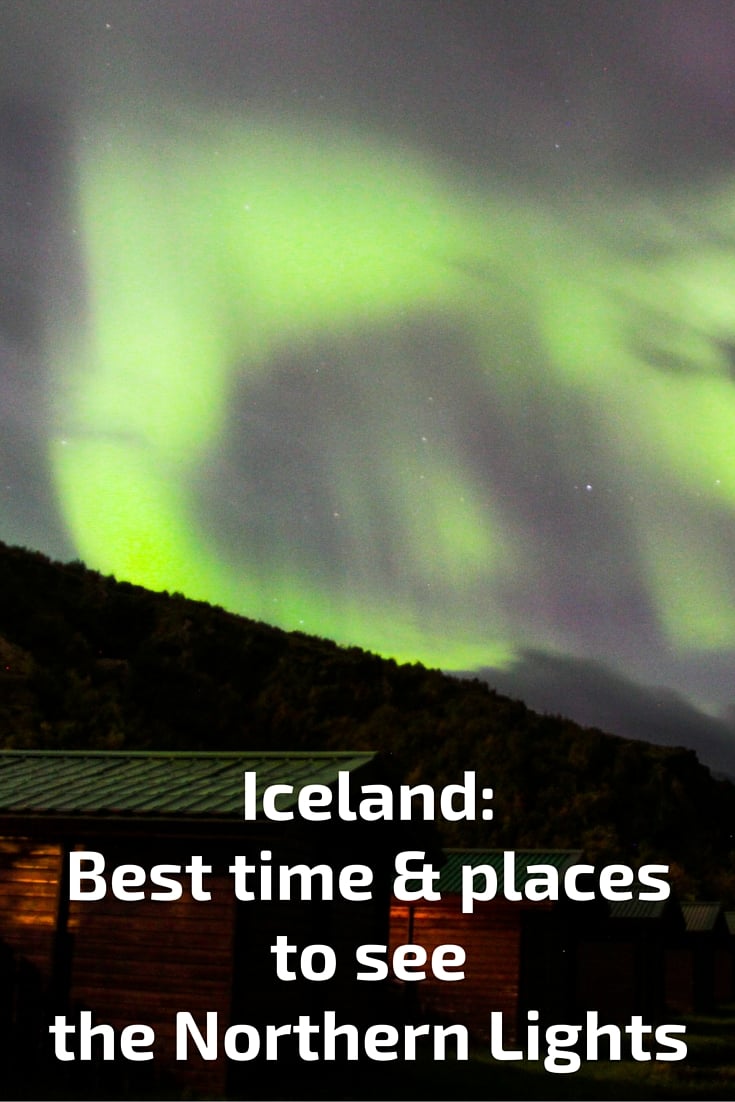
Best places
- In remote locations away from any light source
- North Iceland is considered to be better as you have more clear nights
- Facing North is also recommended. Although not a rule – so for example, Kirkjufell is a great location
Practical Guide – Interested in hunting and capturing the Aurora Borealis? Learn more on how to see the northern lights in Iceland with tools to use, how to get ready, tips to photograph the Northern Lights…

Northern Lights excursions
If you don’t want to chase them yourself, you should consider organised tours in the evening. There are different options, for example from Reykjavik:
- BUS TOUR – One of the cheapest options is to go on a bus tour. You leave from Reykjavik and the driver takes you to the best spots he knows depending on the forecast – Check out Program, availability and Price
- SMALL GROUP TOUR – This is my favorite option, it is easier to go from one spot to another chasing the Northern Lights because you can gather everyone more quickly and you can go off the beaten tracks – Check out Program, availability and Price
- NORTHERN LIGHTS CRUISE – A more original option is to go on a boat off the coast of Reykjavik to find the dark and hopefully see the Northern Lights – Check out options
- A Cruise option is also available from Akureyri in the North – Check out Program, availability and Price
Best time to see WHALES in Iceland
Iceland is a great place to observe whales, as they enjoy the cold waters and abundant feeding grounds. Species visiting the island include the orca, minke, humpback and blue whale.
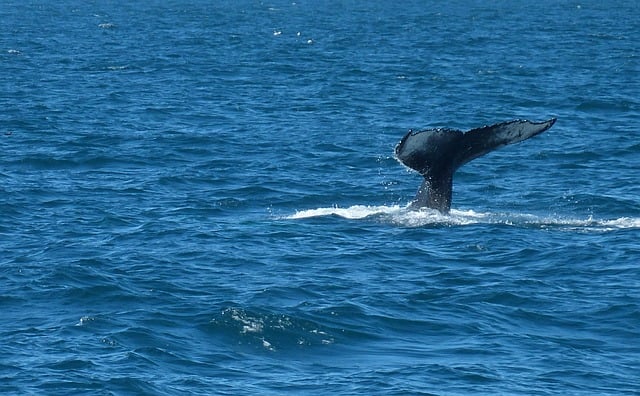
Whale watching Iceland – best time of the year:
- Whales can be seen around Iceland all year
- However, more sightings are reported between April and September
- Killer whales are mostly spotted in April and May
Best places
Whale watching Boat tours depart mostly from Reykjavik (South West) and Akureyri or Husavik (in the North). The North is considered a better whale watching spot.
Whale excursions options
- Whale watching cruise from Reykjavik, on a boat with heated cabin – Check out program and Book
- Whale watching experience from Reykjavik on a Boat – Check out program and Book
- 3 hours Whale watching boat trip from Akureyri in the North – Check out program and Book
- Or leave from the Traditional fishing town of Husavik – Check out program and Book
I don’t drink coffee
But I also like other drinks and sweets! Do you like the free content you find on my blog? All my tips and practical information, without intrusive advertising…

Best time to see PUFFINS in Iceland (and places)
The puffin is a strange looking bird with a black back, white underparts, and a distinctive colorful beak.

Best time to see Puffins in Iceland
- Puffins come to the coast to nest from May to Mid-August, which is the Iceland puffins’ season
- From mid-June to mid-July, the parents fly back and forth from the sea to the nests with food, so it is a great time to observe them
Best places to see them
Iceland is the perfect place to see puffins. Actually it is the best place in the World, because it home to the majority of the world’s population. Love this fun fact? Find out more in this list of 25 fun facts about Iceland .
There are good places to see puffins in both South and North Iceland. However it is way easier to admire them from a boat. Iceland Mag has a great article and a map with prime locations to observe the puffins in their natural environment.
Puffin Excursions
As I said, they are easier to observe by boat. There are specialized excursions departing from Reykjavik – Check out this tour with great reviews
Best time to see ICE CAVES in Iceland
Ice caves are cavities that form naturally in a glacier and create strange formations.

November to March. Outside of this period the cave can collapse
Around glaciers… You should not go visit them by yourself. Always go with an experienced guide. Organized tours are available and should be booked in advance
Some might notice a cave in Langjokull toured in summer. This is not an ice cave but a man-made tunnel in the ice.
Most beautiful
Know that caves disappear every year. New ones are formed, sometimes similar, others are completely different. Do not expect to see what you see on the professional photos they use for marketing. If you are on Winter self-drive road trip , I would choose the Jokulsarlon Tour by Guide to Iceland. This may not be the most impressive of the blue caves, but if conditions permit you will get to see both a blue cave and a black cave. In my opinion, black ice caves are even more fascinating – check out program and availability
Check out my article to help you choose your ice cave tour
Plan your trip to Iceland this Summer:
- My itineraries : 5 days , 1 week , 10 days , 2 weeks
- Where to stay in Iceland
- Where to stay in Reykjavik: best hotels
- 36 tips to rent a car in Iceland
- Guide to driving in Iceland
- How to plan a road trip in Iceland
When to go to Iceland to see LUPIN FLOWERS
Although lupin flowers exist in different colors around the world, they are mostly lilac in Iceland.

Best time
Lupin flowers normally bloom mid-June, perfect to catch them under the midnight sun
Best locations
- Driving along the South Coast you will see many fields full of them
- Vik is often surrounded by those flowers
EVENTS and other things to see & when
Best time to see frozen waterfalls.
Iceland is full of various amazing waterfalls but not all freeze during Winter and they are partially frozen mostly in January and February.

Just be careful driving and walking. If the waterfall is frozen, then everything around it also!
Note: the famous Seljalandsfoss and Skogafoss waterfalls get surrounded by ice and snow but do not freeze completely.
Want to see a VOLCANO eruption?

Best time: … when they erupt
Best place: you never know which one will become active. Although Icelandic people fear that Hekla will erupt soon.
As I visited Iceland, Bardarbunga was active. I could not take a helicopter tour to get closer but on my flight from Reykjavik to Akureyri I spotted the smoke coming from it!
Where to stay in Iceland?
My favorites:
- Reykjavik , capital city: see best rated accommodations – or my article on where to stay
- Selfoss , between Golden Circle and South Coast: see best rated accommodations
- Vik, near waterfalls and glaciers: see best rated accommodations
- Höfn , gateway to the East fjords: see best rated accommodations
- Egilsstadir , between fjords and North Iceland: see best rated accommodations
- Reykjahlid , for the wonders of Lake Myvatn: see best rated accommodations
- Akureyri , capital of the North: see best rated accommodations
- Grundarfjordur , on the Snaefellsnes Peninsula: see best rated accommodations

Best MONTH to visit Iceland – pros and cons
Let’s summarize month by month to help you decide the best time to visit Iceland for you.
Iceland in Winter – November to February
- Pros – Winter magic, snowy landscapes, frozen waterfalls, ice caves, less tourists
- Cons – Short and colder days, Difficult driving conditions, lower number of open accommodations, no access to Central Highlands

Iceland in March
- Pros – Still snow on landscapes, ice caves are often still accessible, less tourists, some years the weather is beautiful, good balance of night and day
- Cons – Sometimes difficult driving conditions, lower number of open accommodations, no access to the Central Highlands
Iceland in April
- Pros – landscapes on transition (less snow), less tourists, good balance of night and day, higher number of Whales, partly frozen waterfalls
- Cons – Unpredictable driving conditions, lower number of open accommodations, no access to the Central Highlands
Iceland in May
- Pros – a lot less snow, more roads open, flowers start popping up, less tourists, higher number of Whales, puffins arrive towards the end of the month
- Cons – no access to the Central Highlands
Iceland in June
- Pros – Midnight sun, high flow from waterfalls, puffins, whales, lupin, the F-roads to the Central Highlands should open, during the month
- Cons – Many tourists, no more snow on the landscapes, no chance of seeing the Northern Lights
Iceland in Summer – July and August
- Pros – warmer weather, long days, puffins (until end July), whales, high flow from waterfalls, access to the Central Highlands
- Cons – Many tourists, no more snow on the landscape, hardly any chances of seeing the Northern Lights
Iceland in September
- Pros – good balance day-night, higher chances to see Northern Lights, whales, high flow from waterfalls, roads to the Central Highlands should still open, Autumns colors
- Cons – Less greenery, getting colder
Iceland in Autumn – October
- Pros – good balance day-night, higher possibility of seeing the Northern Lights, Road conditions still OK, autumn colors, snow appearing on some landscapes
- Cons – No access to the Central Highlands, rainiest month, getting colder

Planning a road trip in Iceland? Check out my travel guides to save you time:
And keep track of your own trip!

Want to see more of Iceland’s beauty?
All articles about Summer and Autumn:

All articles about Winter:

Inspired? Share it on your favorite platform!
Reader Interactions
March 19, 2019 at 6:29 PM
This is a wonderful helpful website. I love the chart! M
June 29, 2019 at 3:29 AM
Do you know when the best time to do a cruise around Iceland would be – for calmer seas.
June 29, 2019 at 10:09 AM
Hi Debra I am sorry I have no idea. But for daylight and temperature from the decks, Summer would be the best 🙂
August 17, 2019 at 5:01 PM
This was very helpful. You have a gorgeous picture of a car driving on a road towards a mountain/glacier with the caption Driving in September. Where was the photo taken? Thank you.
August 17, 2019 at 9:42 PM
Hi Carol This was taken on a side road off road 1, on the South Coast.
Par Claire Robinson Region Lovers SARL 76600 Le Havre FRANCE VAT FR21845103191
Follow ZigZag on Facebook
Follow ZigZag on Pinterest
Website in French: ZigZagvoyages.fr
Website in German: ZigZagreisen.de
Website in Spanish: ZigZagviajes.com
And discover the French regions:
Normandielovers.fr LoireLovers.fr CorsicaLovers.fr Provencelovers.fr
Privacy / Terms of Use / Disclosure Policies / Refund policy
Become an affiliate for the ZigZag road trip guides
As an Amazon Associate I earn from qualifying purchases. ZigZagOnEarth.com is a participant in the Amazon Services LLC Associates Program, an affiliate advertising program designed to provide a means for sites to earn advertising fees by advertising and linking to Amazon.com, Amazon.uk and Amazon.ca

The Best Months to Visit Iceland: Fewer Crowds, the Northern Lights, and Prime Puffin Spotting
The best time to visit iceland depends on your itinerary..
- Copy Link copied

Whether you want to see the Northern Lights or go hiking, Iceland has plenty to do and see throughout the year.
Ragnar Th. Sigurdsson/age fotostock
Iceland sparkles and awes year-round, but what you can do while you are there varies dramatically from season to season. For most visitors, the best time of year to visit Iceland is undoubtedly summer, since the daylight stretches to 20-plus hours, and even the most remote regions become accessible.
But the shoulder seasons in May and September are a chance to avoid the heavy crowds, and winter to spring, spanning from October to April, shows a completely different face of the country.
Here’s the best time to visit Iceland, depending on what you have planned for your trip.
Hiking and the Highlands
Best Months: June–August
Part of the majesty of Iceland, of course, is getting out into its roiling lava fields, up on its crater rims, and alongside its thundering waterfalls. Summer is prime for hiking because the snow has melted and the trails have begun to harden (no mud-slush for you!) Also, this is the season when the interior highland F-roads open to four-wheel drive (4WD) traffic and tours—check out Midgard Adventure in the south and Fjalladýrð in the northeast. Some roads begin to open as early as the beginning of June, but others may not open until deep into July, and then they begin to close and become impassable by late August or early September. Similarly, Hornstrandir Nature Reserve in the Westfjords is at its most accessible from June to August.
Plus, in the summer you have upwards of 20 hours a day of sunlight to get out and get moving, and the weather, though always changeable, is at its warmest, averaging from 46 to 55 degrees Fahrenheit. This is also peak time for other activities like rafting, canyoneering, kayaking, and diving the Silfra Fissure at Þingvellir National Park.
Avoiding the Crowds
Best Months: October–April
Iceland in winter, when the weather is cooperating, can give you thrilling opportunities to visit extremely popular places like the Dyrhólaey Peninsula and the Dettifoss waterfall without the crowds. As an added benefit, the car rental and hotel prices drop in some regions. Downside? Outside of Reykyavík, many tourist-dependent hotels, restaurants, and shops close in true winter.
Also, winter exploring is not for the faint of heart if you plan to drive yourself, as roads are often snowy or icy, and snowstorms regularly pass through. Iceland is well equipped, though, with excellent weather forecasting and websites for road conditions , and rental cars have snow tires (a 4WD vehicle is the best bet at this time of year). The rewards are giant: Think about the possibility of standing alone on a volcanic beach in a snowscape of white-and-black drama.
If true winter seems too intense, choose September or May—a good compromise, as average temps range from 40 to 50 degrees Fahrenheit.
Best Months: May–September
One of the grand pleasures of a trip to Iceland is cruising its remote roads through open landscapes and along wave-swept shores, absorbing the majesty of the country. For example, you can make a wellness road trip in the Westfjords , connecting natural springs and town pools with the occasional luxe spa. Or go for a waterfall tour around the Ring Road. The experience is much better in good (or, at least, not bad) weather, so late spring to late summer is an ideal time to visit. However, during high-season summer, the Ring Road can get busy, especially in the south, where most tourists go, creating snaking lines of traffic. This is easily avoided, though, by simply venturing further afield—consider routes like the Diamond Circle route or the Arctic Coast Way .

Come to Iceland in the summer for a chance to have up-close encounters with adorable puffins.
Nicholas Kampouris/Unsplash
Wildlife Watching
Best Months: Puffins May–mid-August, birdwatching mid-May–July, whales April–September
A trip to Iceland offers the opportunity to see wildlife you don’t usually encounter in your backyard. Seasons vary by animal, of course, so if you’re looking for cavorting puffins, come starting in May, when they return from the open ocean, and get there before mid-August, when they leave again. The Vestmannaeyjar Islands are tops for their abundant colonies (they also have a beluga sanctuary), or go on a puffin tour at Ingólfshöfði in the back of a charming tractor wagon.
Birdwatching of other sorts is generally a summer activity in Iceland’s wetlands and lakes. like North Iceland’s Mývatn—birds are most active mid-May to mid-June as they arrive and build nests—and bird cliffs, like Látrabjarg in the Westfjords. Some areas close during nesting to protect the birds’ habitat. The elusive Arctic fox, the only mammal native to Iceland, is tough to spot. It’s most likely to be seen on the move near sunrise and sunset along coastlines and in summer when you can visit the Westfjords’ Hornstrandir Nature Reserve.
Whales and dolphins pass by year-round, and tours leave from Reykjavík, Húsavik (in the north), Grundarfjörður, and Ólafsvík (on the Snæfellsnes Peninsula), but April to late September or early October are the best months because the cetaceans arrive en masse to feed in local waters.
Animal activities, like excellent horseback riding or visiting the Icelandic goat farm at Háafell, though easiest in summer, happen year-round.
Cultural Life
Best months: Year-round
Part of Iceland’s immense charm is its welcoming, fascinating, vibrant people and their culture. And that’s available in all seasons. Sure, summer sees festivals like Pride, National Day, and Reykjavík Arts Festival , and cities and towns are wide open for business. But as darkness spreads across the land, Icelanders play on into the winter at music festivals Iceland Airwaves and Dark Music Days or the midwinter feast of Þorrablót, when Icelanders celebrate their culture, and you can sample fermented, smoked, and unusual (for you!) Icelandic fare. Reykjavík’s excellent museums, galleries, music clubs, and design shops boom year-round.

One of the best places to see the Northern Lights is by Skógafoss Waterfall.
Photo by Balazs Busznyak/Unsplash
Northern Lights
Best Months: September–April
Always a treasure hunt, the search for shimmering curtains of the Northern Lights is easiest with long winter nights—more darkness equals more chance to see them. But you need to find clear skies and high solar activity ( Aurora Forecast is a helpful resource). Interestingly, the most activity occurs around the equinoxes (September/October and March/April), when solar particle ejections are at their highest, though you have a shot from November to February as well, simply because there are up to 20 hours of darkness per night.
Snow and Ice Sports
Best months: glacier hikes year-round, ice caves October/November–March
Naturally, snow sports like skiing are best in winter, when there’s more snow. Same goes for ice caving, when these glistening complexes become more stable at glacier edges. But you can hike on glaciers, ice climb, and go snowmobiling throughout the year. In all seasons, go with a local guide (check out Icelandic Mountain Guides and Tröll Expeditions )—the crevasse-laden glaciers are never stable enough for newbies.

Thanks for visiting nordicvisitor.com! For the very best browsing experience on our website, we urge you to upgrade to the most recent version of your browser . Some of our site features may not function properly on older versions.
- Travel Update
- Search Suggested Results View All Results
- EUR (€)
- GBP (£)
- Self-Drive i
- Privately Guided i
- Guided Small Groups i
- Northern Lights i
- Honeymoon & Romance i
- Ice & Snow Hotels i
- Multi-Country Tours i
- All Travel Styles
- Show all tours
- Best Sellers
- Special Offers
- Scandinavia
- Switzerland
- United Kingdom
- Book With Confidence i
- Why book with us i
- Booking Terms i
- Sustainability Policy i
- Manage Booking
- Privacy policy
Iceland Bíldshöfði 20 110 Reykjavík +354 578 20 80 View Map
Sweden Scotland View Details
Best Time to Visit Iceland: Your Complete Guide
If you’re planning a trip to Iceland or really inspired to come to this Nordic gem, you may be wondering when is the best time to visit Iceland. One of the country's many charms is being a year-round destination, but your personal choice can influence when to visit Iceland!
Whether you want to visit in winter or summer , or come for a particular interest of yours, we have it all below.
Iceland is a country that is beautiful and interesting all year long. This is why, at Nordic Visitor, our travel consultants have crafted tours for both the winter and summer seasons.
There are countless fantastic activities and sights to see and do, so depending on your interests or your available time to come, we have you covered with this useful guide.
- When is peak season?
- When is best for weather?
Exploring Iceland in summer
Exploring iceland in winter.
- Visiting Reykjavík
- Birdwatching
- Touring the Golden Circle
- Seeing the northern lights
- Experiencing the midnight sun
- Taking stunning photography
- Honeymooners
- Enjoying the Blue Lagoon and spas
- Dipping in hot springs
- Whale watching
- Attending events and festivals
- Combining Iceland and Greenland
When is the peak season in Iceland?
Peak season for travelling to Iceland is during the summer, between June and August.
If you visit at this time, it'll coincide with the mildest weather, summer holidays, the most daylight, and the most activities available. In recent years, the winter months have also been very popular, with people flocking to Iceland to see the northern lights.
- For popular itineraries around Iceland, check out these best-selling tours
- Visit in June , July or August to see Iceland at peak time
When is the best time to visit Iceland for the weather?
Iceland isn’t as cold as its name may suggest and enjoys a temperate climate all year long. That’s not to say that the weather doesn’t change quickly over the course of a single day.
For that reason, regardless of the time of year, make sure to have wind and water resistant layers on hand.
The mildest weather of the year in Iceland is, of course, during the summer months.
If you’re looking for maximum sunlight, or even to experience the midnight sun (when the sun doesn’t fully set below the horizon), the best period to come is in June, July or August.
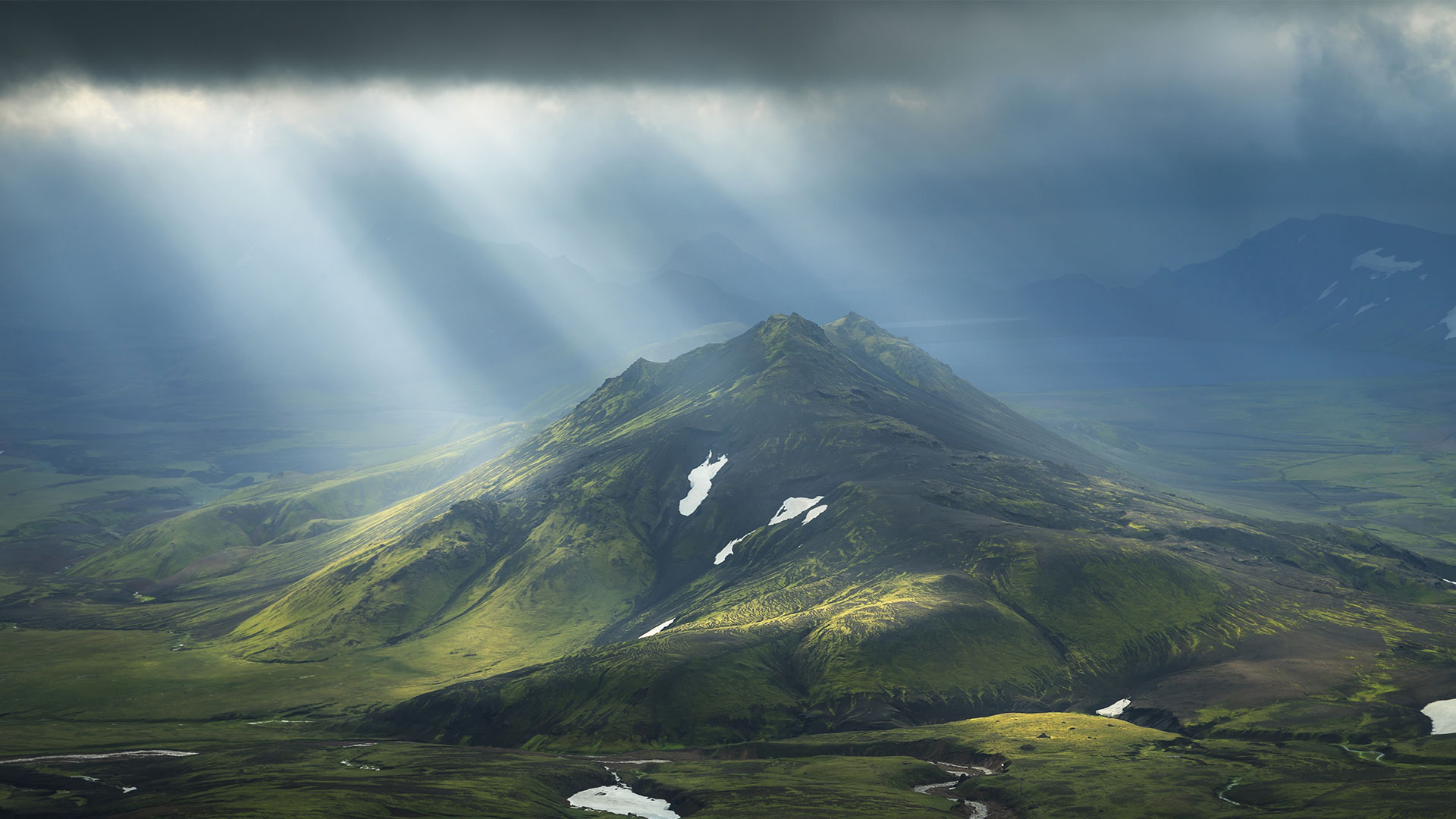
The shoulder months of May and September are also ideal for those who prefer a quieter holiday, as they usually attract less crowds. The weather is usually still mild, although a bit more unpredictable.
- Visit Iceland in May or September to enjoy the advantages of the shoulder months
Of course, maybe the perfect weather for you is a crisp and snowy day. Then the winter months will be the time when you want to come and enjoy the best that Iceland has to offer.
The months between October and April define the winter season and shoulder season. You may also enjoy visiting in late December to join in the Icelandic New Year’s festivities.
You can find out more about the weather in Iceland in our handy climate and weather conditions guide .
What is the best month to visit Iceland?
While the weather may be a big draw for some, you may want to come to Iceland for a particular month or season, whether that’s when you have holiday or when you want to enjoy a certain activity.
Summer in Iceland is from June until August. The shoulder months May and September are very popular among travellers as well.
The summer is by far the most popular with visitors. This is because, at that time of year, the temperature is generally milder, there is more daylight to take advantage of when sightseeing, and there are more activities available.
There is a lot of festivals and events as well, you can read more about that below.
You’re also more likely to enjoy a road trip in the summer as you’ll have more daylight hours to drive. If you only have a week, you can still drive the Ring Road but it will involve longer daily driving distances.
The roads are also less likely to be shut due to the weather conditions at this time.
The one downside some people may find is that, as summer attracts the most visitors, it means more crowds at popular attractions. If you prefer a quieter time, you could also visit during the shoulder season, the months of May and September .
For the most beautiful colours in nature, but also a quieter time for tourism in Iceland, I would recommend September. The fall colours are amazing and that is my favourite time to explore the country. - Helga Guðmundsdóttir, Travel consultant for Iceland
- Take a look at our summer tours in Iceland
Winter is slowly attracting more and more visitors. Quieter months such as October and November are a great time to visit Iceland. This is especially true if you want to experience the long nights and darkness of the northern parallels.
The enchanting natural phenomena that are the aurora borealis deserve attention too. As do the wintry landscapes of the higher altitudes and North Iceland.
While Iceland is a year-round destination, there are fewer activities available at that time of year, with less daylight to take advantage of them. For a road trip, we would recommend staying around the west and southern coast of Iceland. There is plenty to see here, including the Golden Circle.
You could also fly up to the capital of the north Akureyri. Experience this beautiful region and see a true winter landscape.
- Visit Iceland October and April to enjoy the Icelandic winter
- By coming in December you could join in the Christmas and New Year's Eve celebrations
.jpg)
During many months of the winter, it’s also possible to tour the famous Ring Road if that’s what you’re looking for. However, be aware that the weather can often make the roads and driving conditions unpredictable and difficult.
Driving during the winter months in Iceland is not for everyone.
This is why we do not recommend a long road trip in the winter if you have never driven on snow and ice.
If you are going to embark on a winter driving tour in Iceland, you should be comfortable driving in what can be challenging conditions. This includes snowstorms, icy roads and little daylight.
- To tour the island at your own pace, browse our winter self-drive tours of Iceland
- Don't fancy driving in winter? Choose a small group tour and let an experienced driver take you to Iceland's star attractions
If you do want to come in the winter, make sure to dress for the Icelandic weather. We have a handy packing guide here to help you with that.
When is best time of year to visit Iceland depending on your needs?
As we’ve mentioned many times again, there is no bad time to visit Iceland, there is something beautiful to see and something interesting to do all year long.
Below we’ve highlighted the most requested interests and activities and when is the best time to go to Iceland for them. Look up the one you’d love to experience while in Iceland:
Best time to visit Reykjavík, Iceland
Reykjavík is a colourful, cultural, and buzzing city throughout the seasons. From year-round festivals, to New Year’s Eve celebrations, and world-renown attractions, visiting Iceland’s capital is always fun.
The best time may depend on what you want to do during your visit. Most museums, such as Perlan the top attraction in town, open their doors throughout the year. The swimming pools, heated by geothermal power, are also visited by locals and visitors all year long.
To attend specific events, you may want to visit at a particular time. Attend Iceland Airwaves in November, the Culture Night in August, or the Secret Solstice in June. Summer has the largest concentration of festivals if you want to feel the lively atmosphere.
December is a great time to visit to get in the festive spirit. There are fireworks, bonfires and more to celebrate Christmas and mark the start of a new year.
- Enjoy a city break in Reykjavík to take part in the lively culture
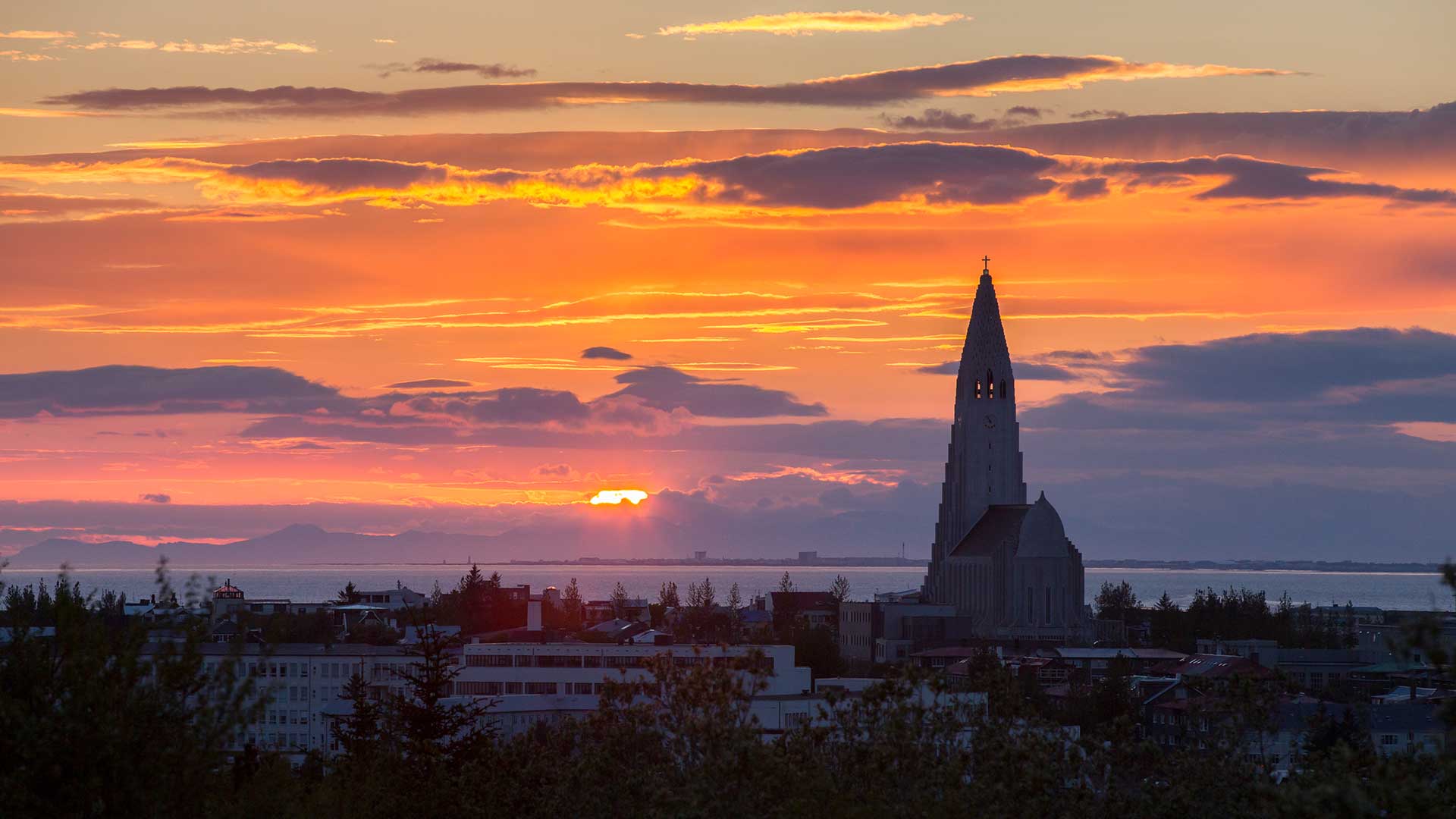
Best time to visit for birdwatchers
If you love birds and birdwatching, you will be spoiled in Iceland!
While it is possible to birdwatch all year round, many of the bird species are migratory and thus only spend a portion of the year in Iceland. This means some periods of the year are indeed better for birdwatching, or for spotting certain kinds of birds.
Generally speaking, the best time for birdwatching is considered to be between mid- April and the end of June . This is the time of the year that sees the most bird species in Iceland, and long daylight hours gives visitors ample time to admire them.
There are five species that people often seek out and we’ve made a wee guide for you:
There are 8 to 10 million puffins that spend their summer in Iceland every year! That makes up nearly 60% of the world’s Atlantic puffin population. These adorable birds can be spotted from late April, with the best period to see them being between May and early August .
Harlequin duck
Since Iceland is the only country in Europe where this colourful duck species can be found, it is an exciting sighting!
There are around 2000 to 3000 pairs that breed around the country. While they stay in the sea around the island during the winter, in the spring they travel up rivers for their nesting season. They can, for example, be found in Ölfusá river.
Barrow‘s goldeneye
90% of the Barrow’s goldeneye around Lake Mývatn and stay there year-round. Around 150 birds can also be spotted on the south coast during the winter, but they head for Lake Mývatn for breeding season around mid- March .
It’s important to note that the Gyrfalcon is a fully protected species and so, no specific location can be given about their breeding location.
While it is not commonly sighted, when it is spotted, it is usually around Lake Mývatn due to the abundance of prey, and around Reykjavík and the Reykjanes Peninsula in the winter.
If you are lucky enough to spot one, please be aware that approaching nesting sites is not permitted. Neither is sharing information about their breeding sites.
Brünnich’s guillemot (also known as thick-billed murre)
In the winter, you can spot this species in the north and east coast of Iceland. But if you happen to be here in the spring or summer, you may be able to observe a Brünnich’s guillemot around the various seabird cliffs around the country.
They are commonly spotted between the end of March and the end of July . As of where to go, we recommend:
- Lake Mývatn area, which is one of the most popular for birdwatching. That’s because it is well-known for its diverse birdlife, especially duck species (there are 14!).
- Látrabjarg bird cliff, located in the West fjords of Iceland, is the largest bird cliff in Europe at 14 kilometres long and up to 441 metres high. There you can get a closer look at millions of nesting sea birds, such as puffins, razorbills and guillemots.
- Hafnarhólmi in Borgarfjörður eystra offers visitors the perfect opportunity to see puffins.
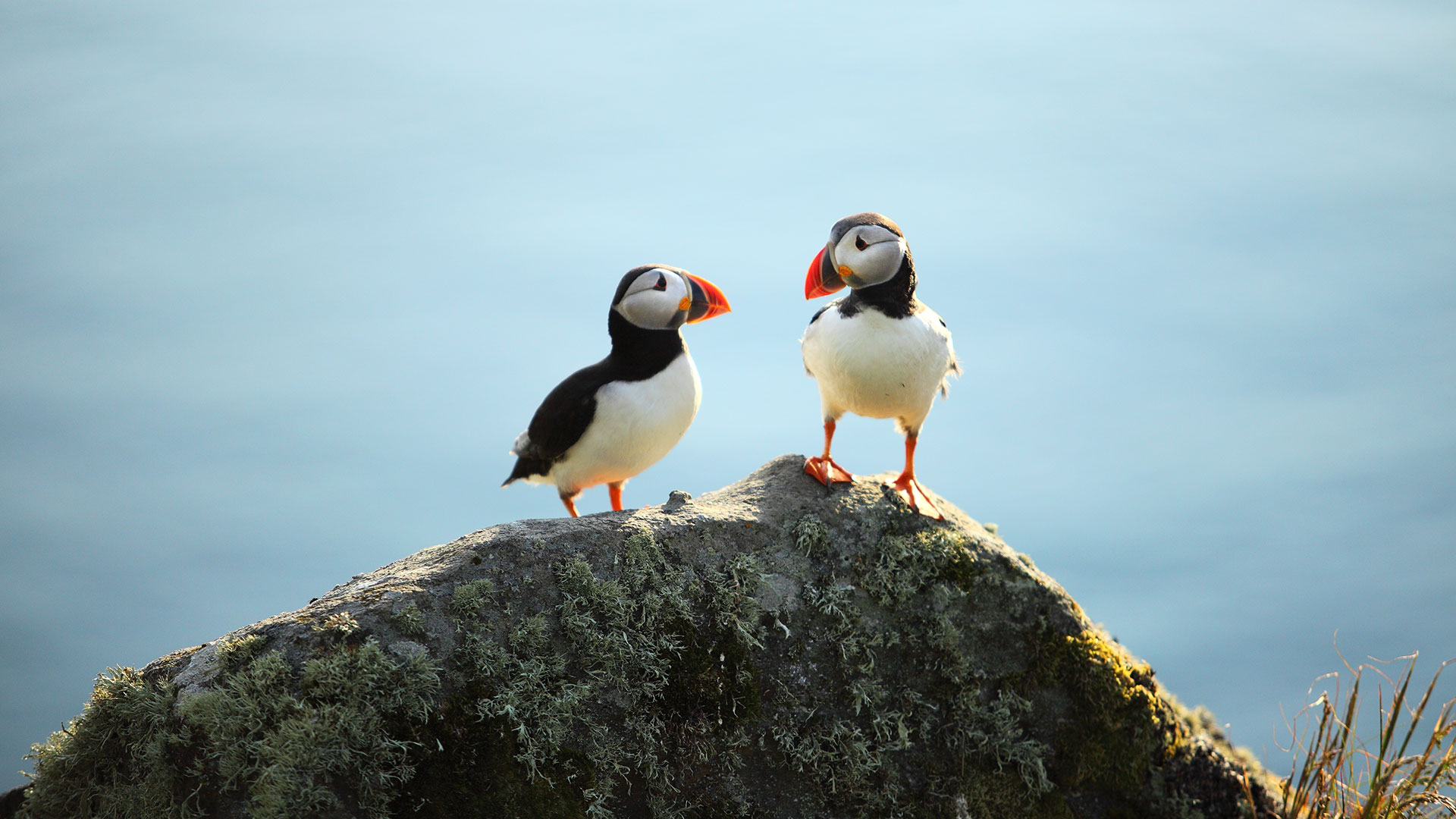
Best time to visit Iceland's Golden Circle
We would recommend visiting during the shoulder season to have the best experience of the Golden Circle and its attractions.
Even though, it is worth mentioning that the Golden Circle is beautiful at all times of the year. In the winter, the landscape will be enchanting, dusted in snow and frost. In the summer, you can enjoy longer walks in the landscape and spend more time at each site.
However, at the peak of summer, you may find that you’re not alone at Þingvellir, Strokkur, or Gullfoss.
Indeed, as they are the closest sights to Reykjavík, they are easy to visit on a city break. It means these locations are usually more crowded than others, especially so at the height of summer.
For a bit of peace and quiet, visit on either side of the summer, in April, May, September or October.
- To travel along the Golden Circle and other iconic sights, look up these classic holidays to Iceland
Best time to visit Iceland for hiking
Hiking in Iceland will be an unforgettable experience as the mountains aren’t just beautiful, but also full of stunning trails. It is also extremely dependent on weather due to the accessibility of those hiking trails.
The best time to visit Iceland for hikers will be between May and September. It is during these summer months that the trails are accessible and when there is the most daylight to take full advantage of the trails and Iceland’s natural beauty.
Hiking in the highlands of Iceland is often limited by the opening of the road leading into the highlands after winter. This is all dependent on weather conditions and location, but will normally open from mid-June.
This also means that some hiking trails high up the mountains may still have snow in May. It is not recommended, as an example, to hike to Stórurð in May because it is usually covered in snow at that time.
Please always be careful as a hiker to not put yourself in danger and always be ready for the weather conditions.
My favourite time to hike in Iceland is in midsummer when everything is green and lush. It can be even better if it’s raining, then the fragrance of nature is so fresh. During this time of year, the highlands turn into a fairy tale and the options are endless. Hills, lava fields, river banks... It doesn’t matter, it’s simply gorgeous! –Perla Magnúsdóttir, Travel consultant for Iceland
- To take on hiking or other adventurous endeavours in Iceland, check out our active tours
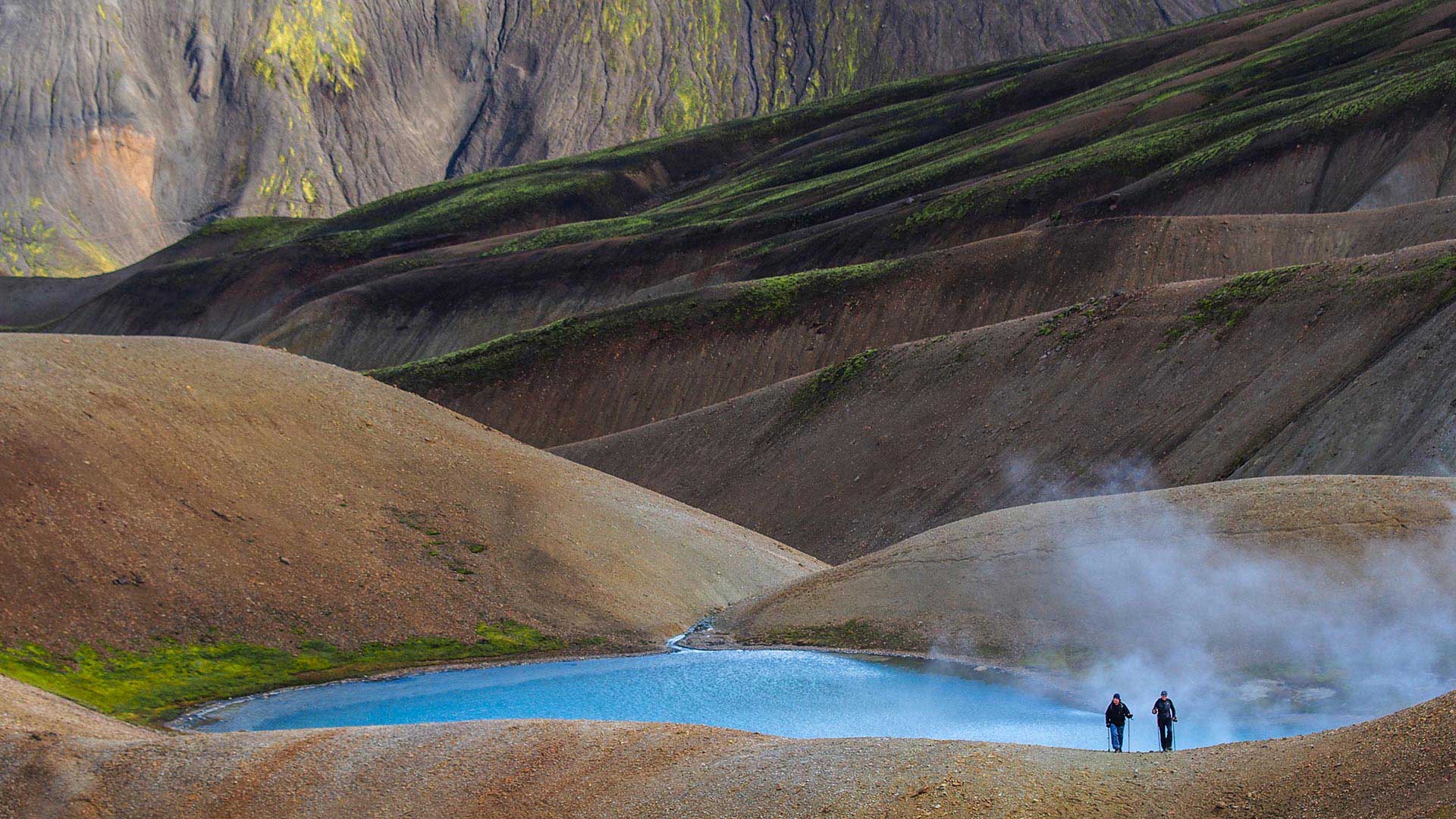
Best time to visit ice caves in Iceland
To explore and experience the surreal atmosphere of an ice cave, come in winter. Between mid-November and early March, you can book an adventure inside the Katla ice cave, located inside the Kötlujökull glacier. You could also walk through parts of the largest glacier in Iceland, Vatnajökull .
Visit the second largest glacier on the island, Langjökull, with the Into The Glacier experience. This is a man-made tunnel taking you into the depths of the glacier.
Or, if you’re coming in summer and still want to experience an ice cave, pop by the Perlan in Reykjavík. This must-see attraction offers you the chance to walk through an artificial ice cave, made as a replica of a real glacier.
Best time to visit Iceland for northern lights
Aurora borealis are one of the most wonderful natural phenomenon to witness and many visitors come to Iceland just for this!
If this has always been on your bucket list, the season to see them is from mid-September until the middle of April, when darkness makes it more likely. But as these are naturally occurring, it means no one can guarantee you will see them.
Sighting depends both on northern lights activity and weather conditions, because it requires both dark and clear skies. You can read more about the northern lights and how best to capture it on our dedicated travel guide .
- Browse our northern lights tours in Iceland
- Related : explore these northern lights tour packages for other Nordic countries
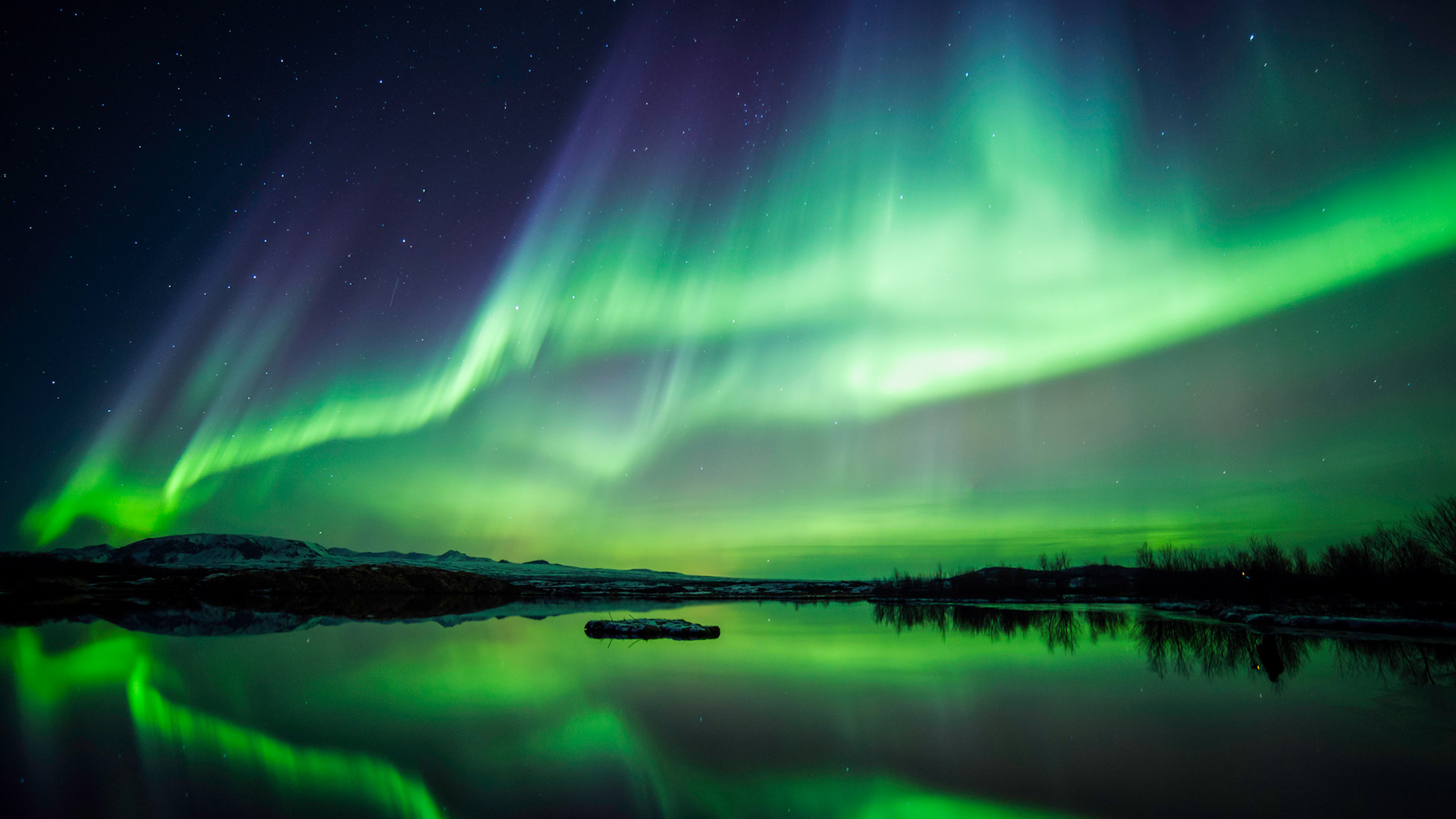
Best time to visit for the midnight sun
To experience the midnight sun, you must visit Iceland during the height of the summer, between May and July. The longest day of the year is at the summer solstice on the 21 June, which means this is when midnight sun peaks in Iceland.
Although you may want to bring an eye-mask to sleep!
- To experience this phenomenon, check out our midnight sun tours in Iceland
Best time to visit Iceland for photography
Photographers will love Iceland regardless of the time of the year, month, or location. The Icelandic landscapes are breathtaking and extremely photogenic, if we can say so ourselves!
Moreover, when the weather is on your side, the light in Iceland is great for photographers!
During the winter months, photographers who look for wintry landscapes and snowy mountain tops will have plenty to enjoy. There is also one added bonus to winter photography in Iceland: blue and golden hour being during the day!
Yes, due to its location in the north, in the winter the sun doesn’t rise very high in the sky. This creates a golden hour that lasts for the duration of daylight (all dependent on the exact date).
Location wise, if you want to take some photos in the east and north of the country, you may want to visit during the summer and shoulder season, when the roads are more accessible and reliable.
And fear not, photographers will also be spoiled for golden and blue hour during the summer! At the peak of the summer months, they both can last for hours!
- Travel with a private, local guide at the wheel to see highlights of Iceland and take stunning photos on the way
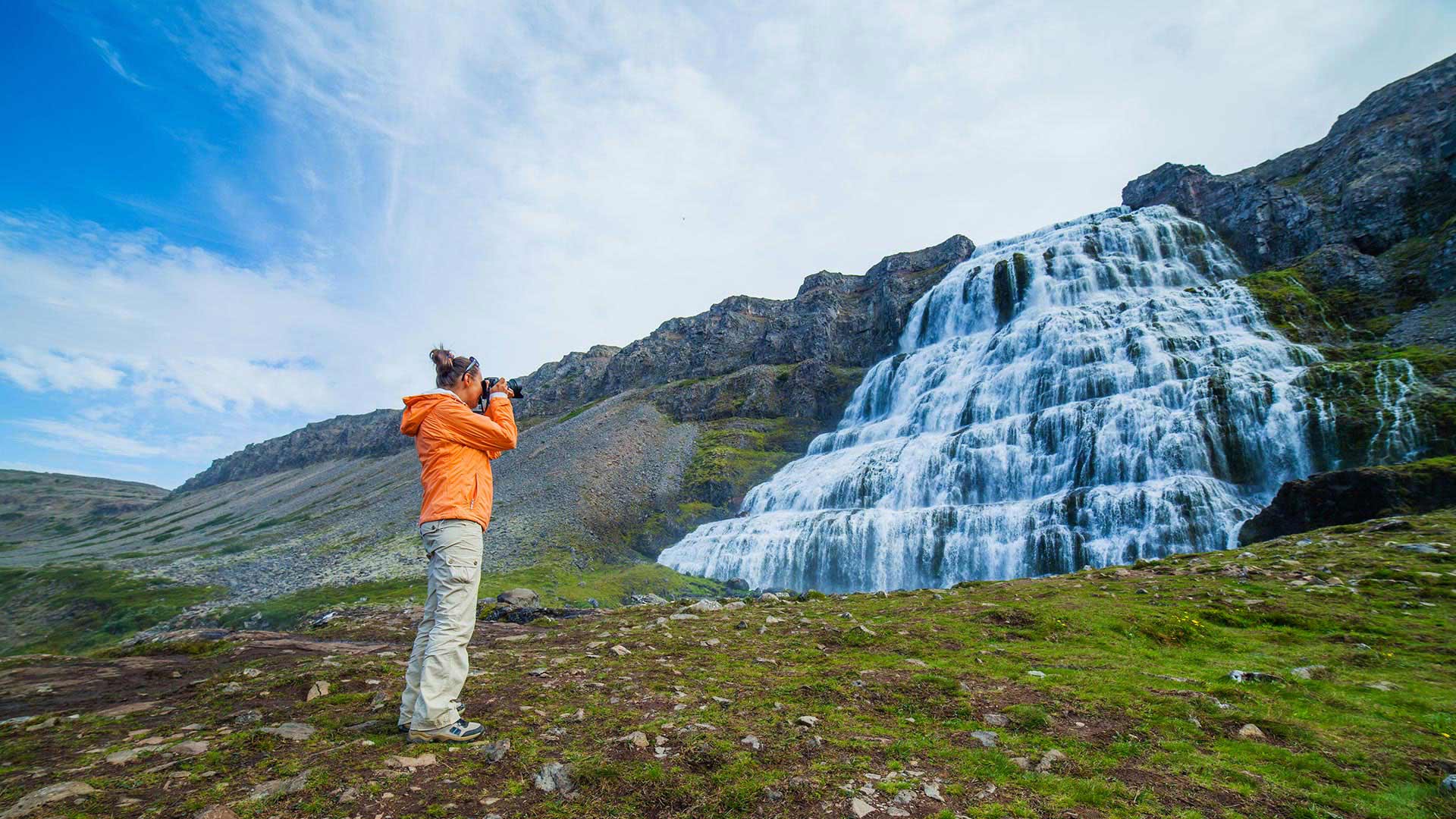
Best time to visit Iceland for families
Coming to Iceland with your family may depend on school or work holidays, or what you’re looking for as an experience. Do you want to see the northern lights or experience the midnight sun? Look up our above categories to get a better idea.
What we do recommend is coming in the summer as there are more kid-friendly activities available at that time.
This includes whale-watching (it is also available in winter, but the seas are rougher at that time), hay cart puffin tours, and boat tours on Jökulsárlón Glacier Lagoon . Something to interest all young adventurers!
Usually, I recommend travelling in the summer time with children, because the long daylight hours give families flexibility to stop frequently and for a longer time. - Kristín Halldóra Halldórsdóttir, Travel consultant for Iceland
We also recommend generally slower-paced tours where you can spend more than one night in one location. This is especially true in winter as you may have to change your plans last minute if the roads are closed due to the weather conditions.
- Discover amazing ways to see Iceland with your children with our family friendly tours
Best time to visit Iceland for honeymoon
Honeymoons all depend on you! What are you planning for? Straight after your wedding or a bit later, when you’ve had time to save and prepare for your dream trip?
If you’ve always dreamed of a honeymoon in Iceland, the best time to come, may depend on what you want out of it.
- Do you want to go hike up one of the iconic Icelandic mountains? Summer.
- Do you want to visit the remote Westfjords ? Summer.
- Do you want to cosy up together and admire the northern lights? Winter.
We believe that travelling in the wintertime can be very romantic! There are fewer people in Iceland at that time of year. This means there are less visitors at each highlight, like the Golden Circle, giving you more time together in a more relaxed atmosphere.
Finally, our travel consultants would recommend spending at least more than one night in the locations you’re visiting, to give you the chance of a leisurely stay with your partner.
- See our romantic and honeymoon trips around Iceland
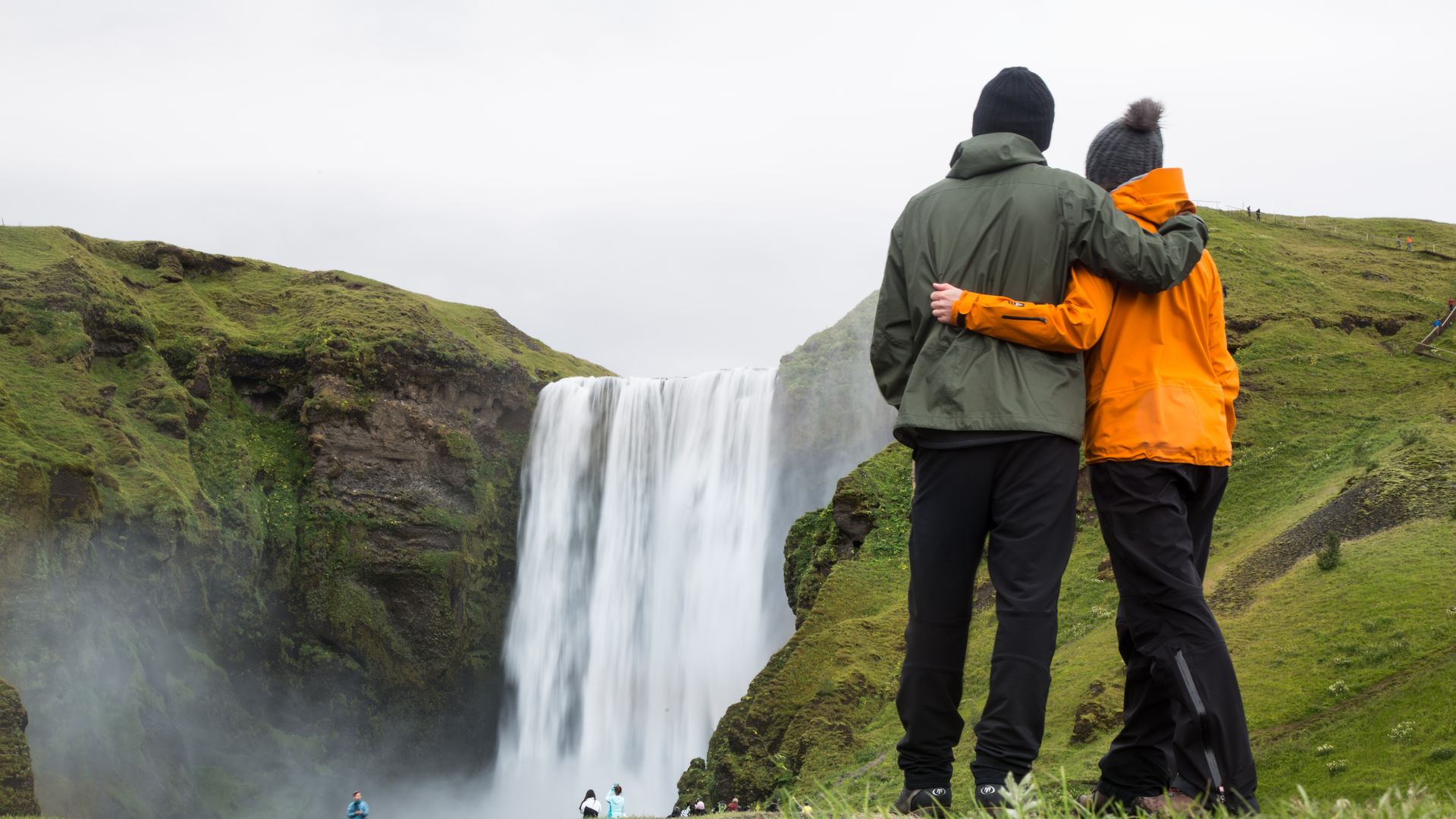
Best time of year to visit the Blue Lagoon, Iceland, & other spas
One way to take advantage of Iceland’s geothermal energy as a tourist (except for the wonderful sight of volcanoes of course!) is to go for a dip into one of the many geothermal pools.
The Blue Lagoon , Iceland’s most famous spa, is a must stop for many visitors. It is open all year round, but those won’t don’t like the cold may prefer to go in the summer.
However, it isn’t the only geothermal pool you can experience on your trip. There are many around the country, including natural hot springs and geothermally-heated public pools in the city of Reykjavík. Most are open all year long.
The winter dips won’t be for the faint hearted as you’ll have to shuffle in your bathing suit from the changing rooms into the water in the cold wind. But it's ultimately worth it!
- To take some time to enjoy the spas, look up these relaxation tours in Iceland
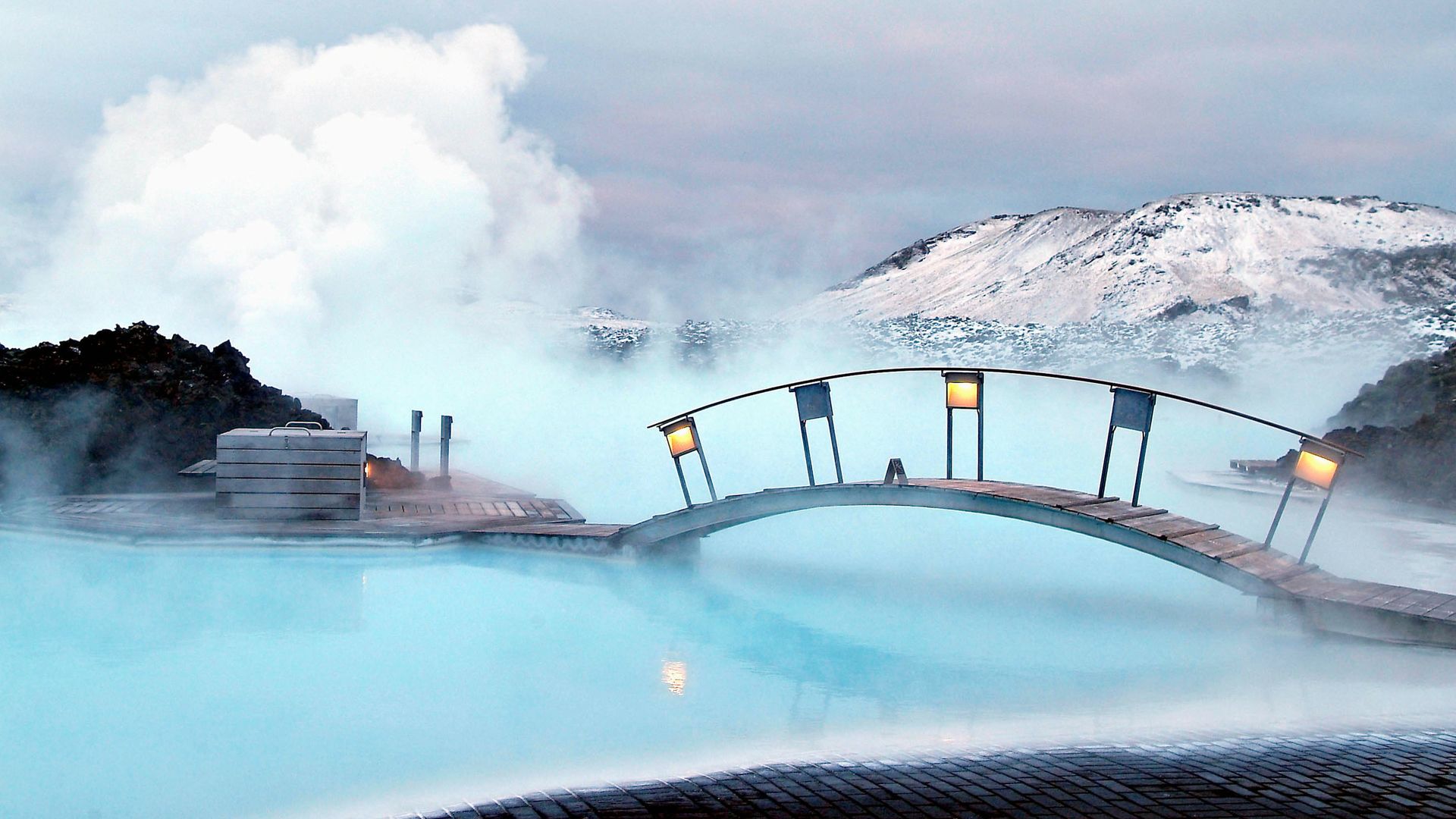
Best time to visit Iceland for hot springs
The beauty of hot springs is that they are warm all year long. That means you could visit at any time of the year and enjoy bathing in the warm, relaxing waters.
Summer is the best time to go hiking to remote areas where you’ll have hot springs to yourself. You may also find it easier to get into your swimming suit and walk in and out of the water during the summer.
The winter isn’t without its advantages though. You could warm up after a day of snowy excursions. Enjoy the difference between the cold air and hot water and admire the snow drop from your cosy spot.
- Take in the sights and dip in all the hot springs you want with an Icelandic road trip
Best time to visit Iceland to see whales
The summertime is the best time to come to Iceland if you want to whale watch. Taking usually a few hours, the excursion is a great addition to any trip around Iceland, especially for those who love to see wildlife. The best location is Húsavík in the north of Iceland.
The northern peninsula Snæfellsnes is also home to orcas if you would like to go orca watching.
Best time to visit for fun events and festivals
There are interesting festivals and events all year long in Iceland. But the summer sees most of the events of the year, as the good weather brings about a festive spirit!
There are also many festivals being held in smaller towns. Verslunarmannahelgin is the most popular weekend of the summer when there are celebrations in many towns around Iceland.
In June there are two big celebrations. The Iceland National Day marks Iceland’s independence from Denmark on the 17th June 1944. It is celebrated on the 17th June and is one of the most popular events of the summer.
The second is an outdoor music festival to celebrate the summer solstice. Held in Laugardalur in Reykjavík, the Secret Solstice Festival sees Icelandic and foreign bans perform under the midnight sun.
One festival we recommend is also Bræðslan, held in July every year in Borgarfjörður eystra in the east fjords of Iceland. It is a music festival where Icelandic and foreign bands perform.
Bakkagerði (the town in Borgarfjörður eystra) is one of the most remote villages in Iceland. It is located amongst a beautiful fjord with colourful mountains towering over the small town.
- Pair a stay in the city with some day tours in the gorgeous countryside with one of these multi-day tours in Iceland
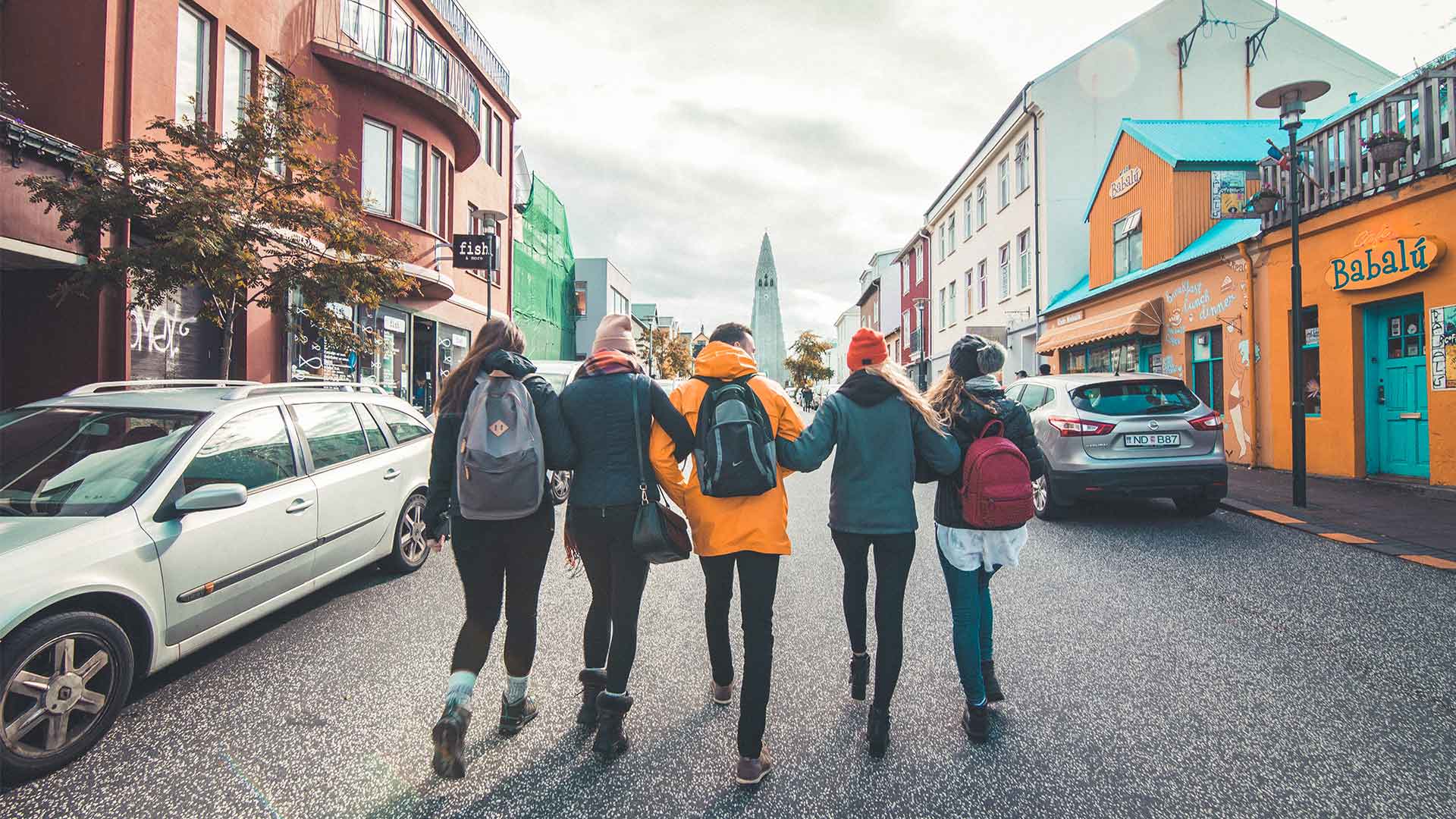
August brings a good mix of interesting events in the capital, with the Reykjavík Pride, the Reykjavík Marathon and the Reykjavík Culture Night.
The latter is especially exciting as it celebrates Iceland’s diverse cultural scene. There are countless free events through the evening, including outdoor concerts, film screenings, art and photography exhibitions, street performances and a firework display by the harbour to close the night.
There are also two major festivals in the autumn that we need to mention. The first is Reykjavík International Film Festival (or RIFF) which features films from both Iceland and abroad (the winner takes home a Golden Puffin!). It is held every year between mid-September and mid-October.
The second is one of the biggest music festivals in the country, Iceland Airwaves. It is held every year in early November and if you love discovering new bands, this is for you!
And last but not least, you could always join us in December for New Year’s Eve celebrations !
For more information about events in Iceland, look at our annual events guide .
Best time to visit Iceland and Greenland
The best time to combine a tour to both these glorious Nordic islands is to travel in summer. Although you could visit at any time of the year, flights to Greenland from Iceland can be affected by severe winter weather.
For that reason, book your Greenland and Iceland trip between June and August. At this time, you’ll also enjoy nicer weather and longer daylight hours for more sightseeing.
You can bask in the glow of the midnight sun while admiring glaciers, icebergs, and more.
- Have a true Nordic experience by pairing Iceland and Greenland in one exciting trip
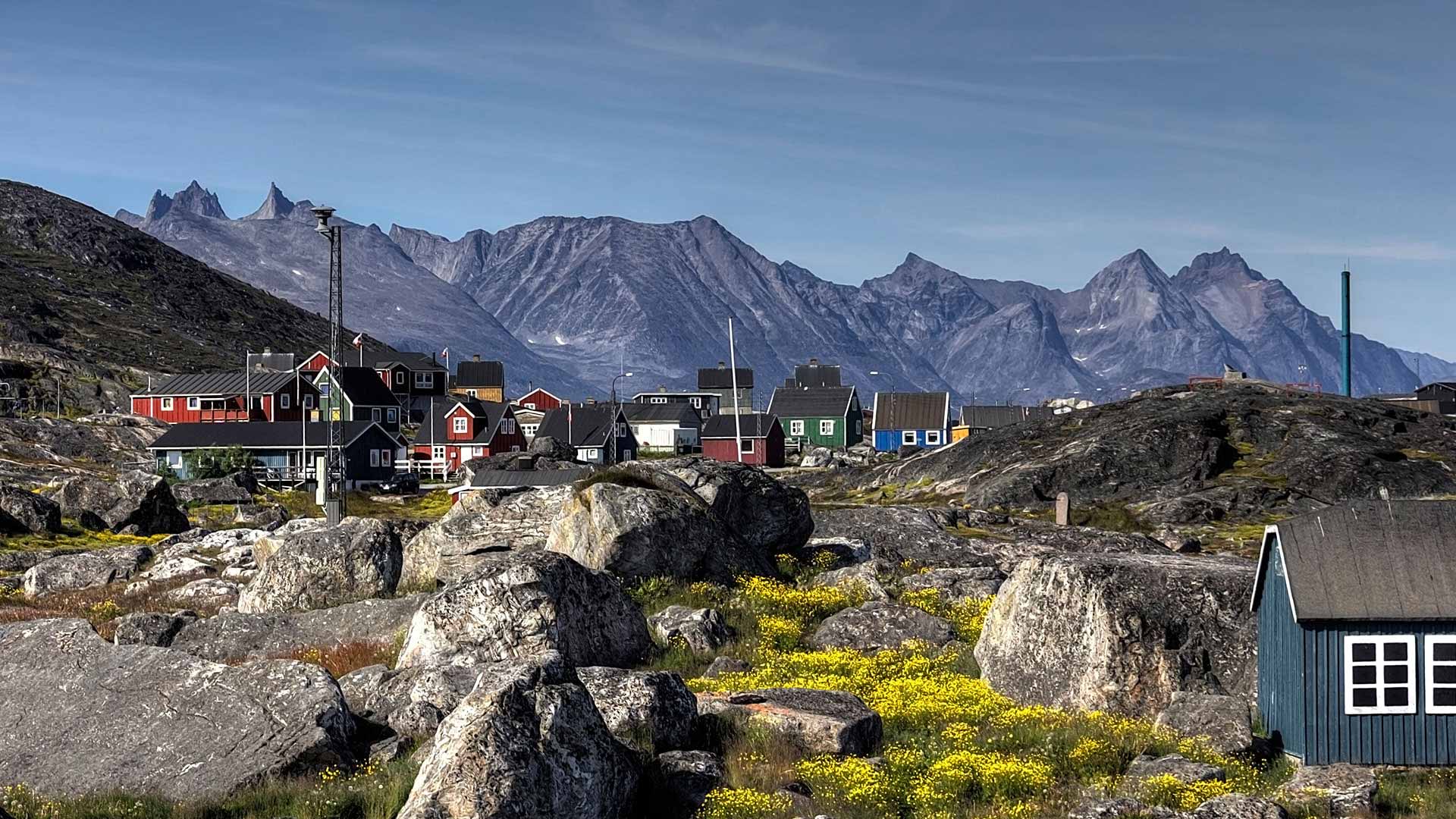
Did you find the perfect time for you to book your Iceland adventure? Or maybe you’re still not sure? Either way, get in touch with our Icelandic travel consultants . Based in Reykjavík, they’ll use their local knowledge to help you figure it all out.
All our itineraries can be tailored to you as well, so don’t hesitate to ask if you want to do something special. You can stay in a location longer, add excursions, day tours, or even spa days to your stay.
Our goal is to make sure you have a great time in Iceland!

Camila grew up between the French Canadian and Chilean cultures, before moving to Scotland in 2012. When she’s not travelling or writing about travels, Camila loves to read, run, and puzzle. Her favourite destinations have been Reykjavík, Copenhagen, Estonia and Cape Town.
Find Camila on LinkedIn .
Getting there
We'd love to give you the same amazing travel experiences as you read about in our blog! To visit the destinations and attractions mentioned in this post - and to discover a few new highlights along the way - check out these recommended Nordic Visitor tours.
ICELAND COMPLETE CLASSIC
- USD ($)
- CAD ($)
- AUD ($)
ICELAND RING ROAD EXPRESS
Best of south iceland, related posts, iceland travel: everything you need to know.
Blogs , Activity , Iceland , Guides , Things to Do
5 Best Road Trips in Iceland: A Local Expert's View
4 best ways to spend a week in iceland, 8 ways to experience glaciers in iceland.
Best Time to Visit Iceland: Seasons, Tips & More
- Last Updated: December 9, 2022
- Norbert Zohó
If you’re thinking about Iceland for your next vacation destination, you will probably also be considering when is the best time to visit Iceland. With amazing attractions and activities all throughout the year, Iceland is an awesome destination at any time. Naturally, your preferences will almost certainly play a huge part in when you visit the Land of Fire and Ice.
Iceland’s summer months see lush verdant landscapes and long, sunny days because of the famous midnight sun. In wintertime, the stunning Northern Lights dance across the dark skies. Do you prefer to see cascading waterfalls or icy landscapes?
We’ll take you through the pros and cons of visiting Iceland at different times of the year, helping you decide on the best time for your vacation. Keep readings for expert tips related to seasonal activities and experiences, and find out when is the best time for you to plan your trip to the magnificent Nordic treasure.
The Off Seasons: Spring and Autumn
The summer in iceland, the winter in iceland, the best time to visit iceland in good weather, the best time to see the midnight sun, the best times to witness the northern lights, the best time for hiking and camping, the best time for traveling around the ring road, the best time to visit iceland’s must-see places: the golden circle and the south coast, the best season for whale watching, the best time for puffin and bird watching, the best time for glacier adventures, the best time to visit iceland’s natural ice caves, the best time for a family vacation, the best time to visit iceland for honeymoon, how long should your icelandic vacation be.

The Travel Seasons in Iceland
There are three main travel seasons in Iceland: peak season, secondary peak season, and low season. The peak season is in the summer months (June, July, and August), and the second peak season is during the winter (November to March ). Spring and autumn make up the low season, also referred to as the shoulder season.
While Iceland offers plenty of wonders all year round, every season has unique characteristics and diverse events and activities. There are advantages and disadvantages of each season in Iceland.
Spring and autumn are the two shortest seasons in Iceland, each lasting for just two months. Spring is the months of April and May, while September and October are the autumn months. These four months comprise the low season in Iceland.
Flights to Iceland are cheaper than at other times of the year, and visitors can also score lower prices and terrific deals on accommodations and car rentals too. The cheaper prices make the low season an ideal time for budget travelers to discover Iceland.
The low season naturally sees fewer visitors than the high season. If you prefer to dodge the tourist crowds and have a quieter vacation, visiting Iceland in the low season could be for you.
April and October have nicer weather than in winter, though it isn’t as pleasant as during the summer. Expect fairly chilly temperatures, rain, and darker days. The shoulder months of May and September can be suitable for camping and hiking, although the changeable conditions mean that nothing is guaranteed. Typically, however, May and September experience relatively mild temperatures and lots of sunny days.
Over the low season, May usually sees the best weather, with the least amount of rainfall and wind. On the flip side, if you were set on seeing the Northern Lights , it won’t happen in May—the nights just aren’t dark enough. There are greater chances of seeing the marvelous Aurora Borealis in September or October, thanks to the darker night skies.
Puffins return to Icelandaround late April, so you’ll be able to spot the cute seabirds in May. You won’t see them, however, in the later off-season months of September and October. You will, though, be able to see whales during autumn.
The main disadvantage of Iceland in the low season is the unpredictable and quickly changing weather conditions. You can experience sunny days and mild temperatures, but rain, snow, and storms are common too. The road conditions aren’t as safe as during the summer months; while usually fairly safe in April, roads can still have snow and ice.
In essence, visiting Iceland in the low season is great if your main priority is saving money and spending less on your vacation, though the tradeoffs will be poorer weather. You will also need to be more flexible with your plans.
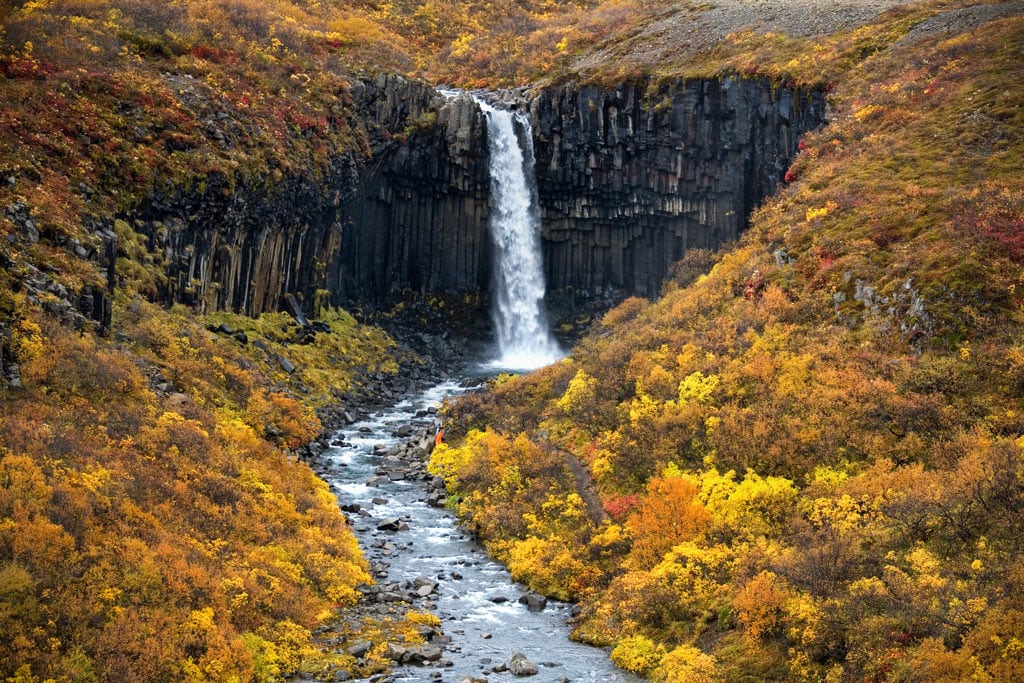
The summer months of June, July, and August make up Iceland’s peak travel season; this is the country’s busiest time for tourism.
The weather is the most pleasant in the summer, with the highest temperatures, mostly sunny and bright days, and the least chance of wind, rain, and storms.
There are more hours of daylight over the summer. In fact, it never fully goes dark, thanks to the famous Midnight Sun. The skies take on gorgeous shades of red, orange, purple, yellow, and pink at nighttime, and there’s enough light to be able to travel and even hike. Summer is the only period when visitors can sleep under canvas in tents, and it’s also the most appropriate time to travel around Iceland in a motorhome or camper van.
Summer offers the best driving conditions in Iceland. It is possible to reach the nation’s most remote corners by car, although some mountainous roads and destinations do still require the use of robust four-wheel-drive vehicles. Regular paved roads, including the Ring Road, are accessible by small cars and bicycles.
The summer is the prime time for hiking through Iceland’s amazing landscapes. The hiking trails are fully accessible, there’s lots of wildlife to spot, and the Highlands burst into bloom after the long, cold winter. You’ll spot creatures like reindeer, sheep, Icelandic horses, and Arctic foxes roaming around Iceland’s terrain, while whales and puffins are easy to spot near the coast.
Awesome summer activities include regular and glacier hiking, caving, and trying various water sports. There are plenty of sightseeing excursions too, along with a wealth of cultural events and music festivals.
The downsides of visiting Iceland in the summer are the prices, traffic, and crowds. Accommodations can be booked up far in advance and campsites can be crammed with tents and campervans, particularly places close to popular destinations and attractions. Well-known attractions can be incredibly busy, especially at peak times. There is little chance for spontaneity, as you must plan your trip in advance.
Summer is the most expensive time for an Iceland trip, with higher costs for accommodations, plane fares, and vehicle rentals.
Another disadvantage of a summer vacation in Iceland is that you cannot see the magnificent Northern Lights; the nights just aren’t dark enough. Additionally, almost all glacial ice caves are closed to visitors in the summer.

Iceland has a second peak season over winter—November to March . Lots of people visit Iceland to see stunning winter landscapes, spectacular ice caves, and frozen waterfalls in addition to the famous Northern Lights. There are terrific winter activities, like snowmobiling, to try too.
The long, dark nights are ideal for spotting the Northern Lights in all their glory. In fact, there are some 19 to 21 hours of darkness each day to watch for one of nature’s finest spectacles.
Iceland is full of festive cheer in December, and winter sees exciting firework displays and bonfires in the capital of Reykjavik.
Christmas and New Year aside, winter prices are usually lower than in the summer. It’s easier to find bargain flights, and you may also find cheaper accommodation. You won’t, however, be able to enjoy the cheapest accommodation option of camping, and touring by motorhome or campervan is also strongly discouraged.
Although popular, winter does see fewer visitors than in the summer, meaning that you don’t need to plan your vacation quite so far in advance, and you won’t get swallowed up in huge tourist crowds when visiting Iceland’s diverse attractions.
You may spot reindeer and horses outside over the winter, but you are unlikely to see much other wildlife. Whales and many bird species head south for the winter, and sheep are protected inside farm buildings.
A major drawback of winter is the weather. Winter is the coldest time of year, with strong winds and rain as well as many storms. There may be snow and ice too. Iceland’s roads can be difficult to drive in the winter, sometimes perilous, and there are lots of areas that are inaccessible with a regular car. The shorter hours of daylight also limit the amount of time people can realistically travel. December has the darkest days, gradually getting lighter, with March having more daylight than the depths of winter .

The Best Time to Visit Iceland
Iceland is a world of wonder at any time of the year, with terrific activities and fascinating sights all year round. That said, depending on your preferred experiences there may be a better time for you to visit. We’ve put together the most popular places, attractions, and activities and provided details of the best times to visit Iceland for each. This helps you plan your trip according to your wishes.
Summer experiences the best weather in Iceland. Between June and August is the perfect period for people who don’t like cold conditions and love warm, sunny days with little wind. July and August are the warmer months, but August does generally have more rain (usually in the second half of the month) than July. Conversely, June is the driest month but also the coldest.
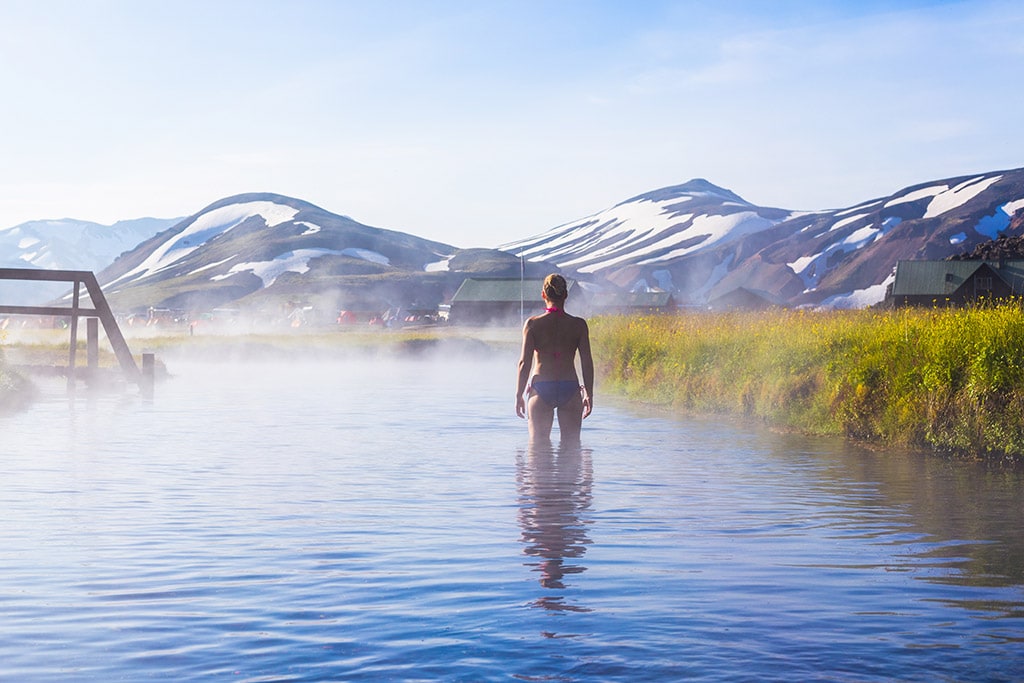
While there are light, bright nights between late April and mid-August, the height of the famous midnight sun is from May to July. The peak is on June 21st—the summer solstice, or the longest day.
Over summer the sun doesn’t dip down below the horizon enough for darkness to fully fall, meaning that it’s light (to a degree) all through the night. In good weather conditions the stunning hues of sunset and sunrise color the skies for many hours throughout the night. There couldn’t be a better time to enjoy the start and end of each day and to take beautiful photographs.
In the south and around Reykjavik the sun sets just enough for you to experience sunset, before quickly rising again with glorious sunrise tones. In the north of the island, however, there is no true sunset.

Many people visit Iceland with the primary intention of witnessing the awe-inspiring phenomenon that is the Northern Lights. Visible from late August to early April in Iceland, better weather conditions increase your chances of spotting the aurora. Regarding temperature, September and October are the mildest months. Of these two months, September is better when it comes to cloud cover and rain.
Even though the temperatures are colder, November and February are also good months for seeing the Northern Lights. The longer hours of darkness give more time to get out and try to spot the magical lights.
November and February usually have clearer skies than December and January due to the fact that they are drier with less precipitation. (September is, however, still the driest month during the Aurora-spotting season .)

There are many spectacular hiking trails through Iceland’s gorgeous mountains. Accessing these trails, however, really depends on the weather. As the weather is better in summer, with higher temperatures, drier conditions, and less wind, it follows that this is when you will find better trail conditions; the summer is, therefore, the best time to hike in Iceland. Furthermore, most of the country’s well-known hiking areas can only be accessed over the summer, particularly those in Highland areas.
Mountain hiking trails are typically at their best between late June and late August. You might be able to enjoy coastal hiking trails, however, between May and September. Hiking is strongly discouraged during the winter, for safety reasons. Only strongly experienced hikers should attempt to hike in Iceland over the winter, and crampons should always be used.
The most popular and most comfortable time for camping in Iceland is during the summer. Temperatures don’t fall below 0°C (32°F) over nighttimes. Wild camping isn’t legal in Iceland, but there are more than 200 official campsites spread across the island. Most are open from the middle of May until the end of September. Winter conditions are not suitable for camping in tents.
The road conditions are at their safest and best from May to October, making this the best time to explore Iceland by campervan or motorhome. Some campsites remain open all throughout the year to cater to people who need a place to park their vehicles and sleep during the winter. Traveling on Iceland’s roads during the winter can be tough for all vehicles, particularly larger vehicles like motorhomes and campervans; strong winds, snow, and ice can make winter driving in Iceland exceptionally hazardous and challenging.

Exploring Iceland is magical at any time of year, though the limited hours of daylight in the winter are an important consideration when planning your trip.
If you are planning to take a self-driving vacation, keep in mind that the best driving conditions are generally from May to October. Driving in Iceland in the winter is usually difficult, especially if you have no prior experience of handling a vehicle in wintery conditions.
Guided tours are available at all times of the year, and can access places that you may not be able to reach independently. You can travel safely and conveniently to beautiful destinations under the care of an experienced local guide. Sometimes, groups travel in vehicles that have been adapted for the terrain and the conditions.
When considering the best time to travel around Iceland’s famous Ring Road, think about the key things you wish to experience along your route. For example, are you keen to hike through nature and admire verdant landscapes and vibrant meadows filled with wild blooms, or are dazzling ice caves and frozen cascades more your thing? Midnight Sun or Northern Lights? Are you mainly interested in discovering the local heritage and culture? Perhaps you dream of relaxing in the warmth of charming guesthouses while you watch the snow falling and blanketing the ground outside? Your preferences will help you to decide the best time for you to travel around Iceland’s Ring Road.
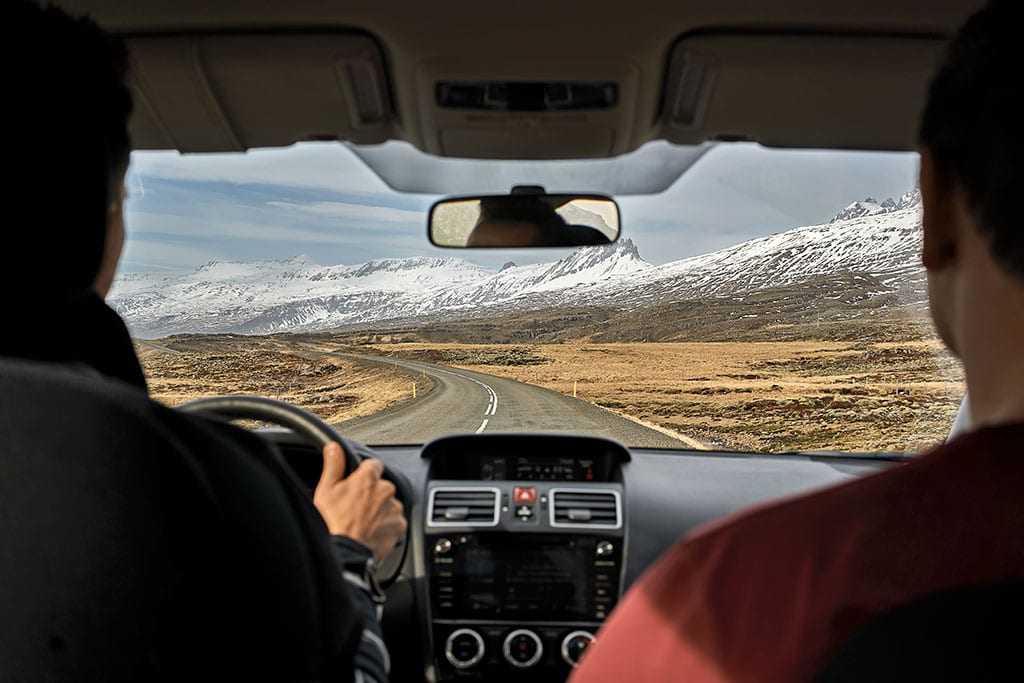
Although you can access Iceland’s most famous natural sites all throughout the year, the majority of visitors opt to experience them in the warmer summer months. This is when you’ll find the best weather and road conditions, but this also means that the roads have the most congestion and the attractions have the biggest crowds. If you prefer a quieter vibe with fewer people around, visit in the shoulder months of May or September.
If your time is limited in Iceland and you just have a few days’ vacation, the South Coast and Golden Circle are likely to be high on your travel wishlist. It’s possible to drive to these destinations at any time of year, though the weather means you’ll need to plan your trip(s) that bit more. The natural sites are stunning in the winter, although do keep in mind that they look different to in the summer.

It’s possible to spot whales all year round in the waters off Iceland’s coast. The best time to spot these magnificent sea creatures is over the summer. Migratory whales return to Iceland around the beginning of April. Although migratory whales depart again at the end of autumn, some whales, those who aren’t breeding, remain through the winter months too.
Female whales reach maturity in around five to seven years. When mature, whales breed once in every two to three years, and spend more than a year nursing their young. When not breeding, whales don’t need to make the long migratory journey and so remain in Icelandic waters.
Orcas (also known as killer whales), however, breed all throughout the year. Their migratory patterns depend on food supply. Since there are many fish, such as herring and capelin, in the cold winter waters, the distinctive black and white orcas are drawn to Icelandic waters to feed.
Especially great for nature lovers, you can watch beautiful sea creatures on a whale-watching trip . Head out to sea for a few hours to observe whales in nature. Northern Iceland’s Húsavík is a top spot for seeing whales in the wild, and Snæfellsnes (on Iceland’s northern peninsula) is a great place to see orcas.
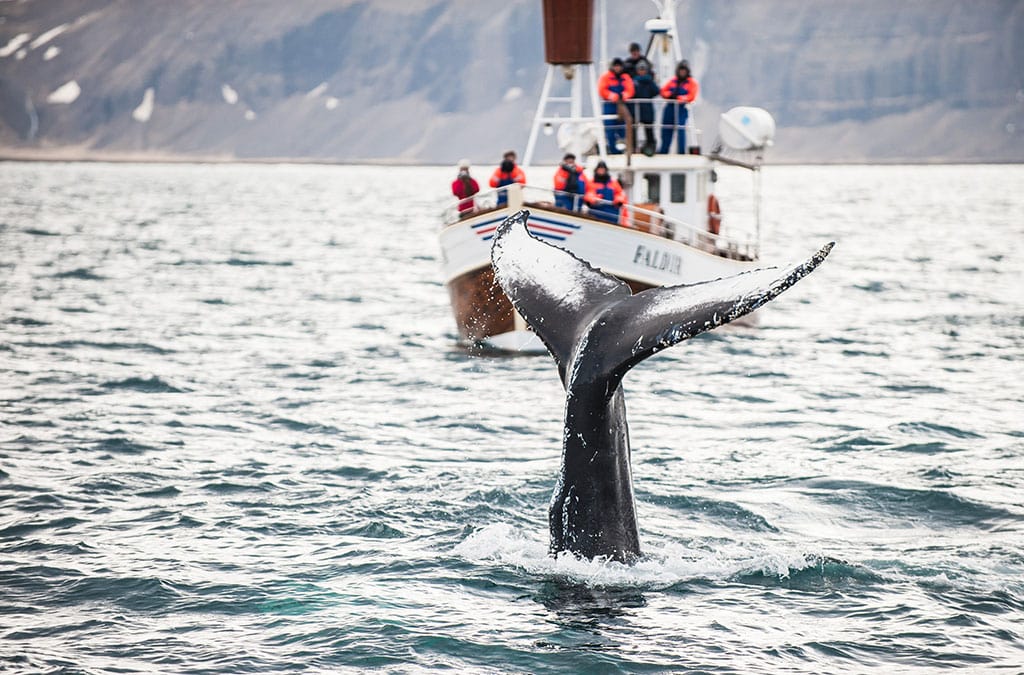
You can spot various bird species in Iceland throughout the year, including blackbirds, ducks, swans, oystercatchers, and gyrfalcons.
Many avian species are migratory, though, meaning they are only present in Iceland at certain times of the year. This naturally results in some months being better than others for birdwatching. Plus, if there are particular bird species that you’re keen to see you should plan your trip around when they are at their largest numbers in Iceland.
Migratory birds generally start to return to Iceland in April. If you wait until May, however, the numbers are greater and thus the chances of fruitful bird-watching experiences are higher. The numbers of migrating birds are highest from May until the middle of August. That said, the best time for birdwatching in Iceland is considered by enthusiasts and experts to be from the latter half of May and the first three weeks in June.
After the winter, the first bird to come back to Iceland’s shores is the golden plover. It makes its arrival towards the end of March, signaling the eagerly awaited arrival of spring. Known as the lóa in the native language, the golden plover is the county’s most celebrated type of bird. After the golden plover returns, other birds too start making their comeback, eventually, their warbling, tweeting, whistling, and chattering creating the enchanting natural summertime soundtrack. Most Icelanders know a catchy poem-cum-folk song about the birds’ return, which includes the message: “The golden plover has arrived to banish the snow, to banish the boredom, that it can do. … It has told me to wake up and work, and full of hope welcome the summer.”
Lots of visitors wish to see the famous Atlantic puffins around the coast of Iceland. The puffins return in April and are abundant through the summer. With around 8 to 10 million puffins calling Iceland home in the summer months, it’s little wonder that Iceland is sometimes referred to as the puffin capital of the world! Puffins leave Iceland in September, following most other species who depart around mid-August.

Iceland offers an exciting array of glacier activities, such as ice climbing, glacier hiking , and snowmobiling . As Iceland’s magnificent glaciers are accessible in all their beauty all year round, visitors can therefore enjoy incredible glacier adventures at all times. You will need to consider the weather, however, to make sure you dress appropriately for the conditions.
For hiking on glaciers and ice climbing, it is particularly important to ensure you dress for the conditions. You’ll be provided with all the necessary safety equipment, but you’ll wear your own clothes underneath. If you don’t have appropriate clothes though you can normally rent them from the tour companies. For snowmobiling adventures, you’ll be given gloves, a balaclava, and a helmet for both safety and warmth, as well as a protective overall to keep you warm and shield you from the wind and rain.
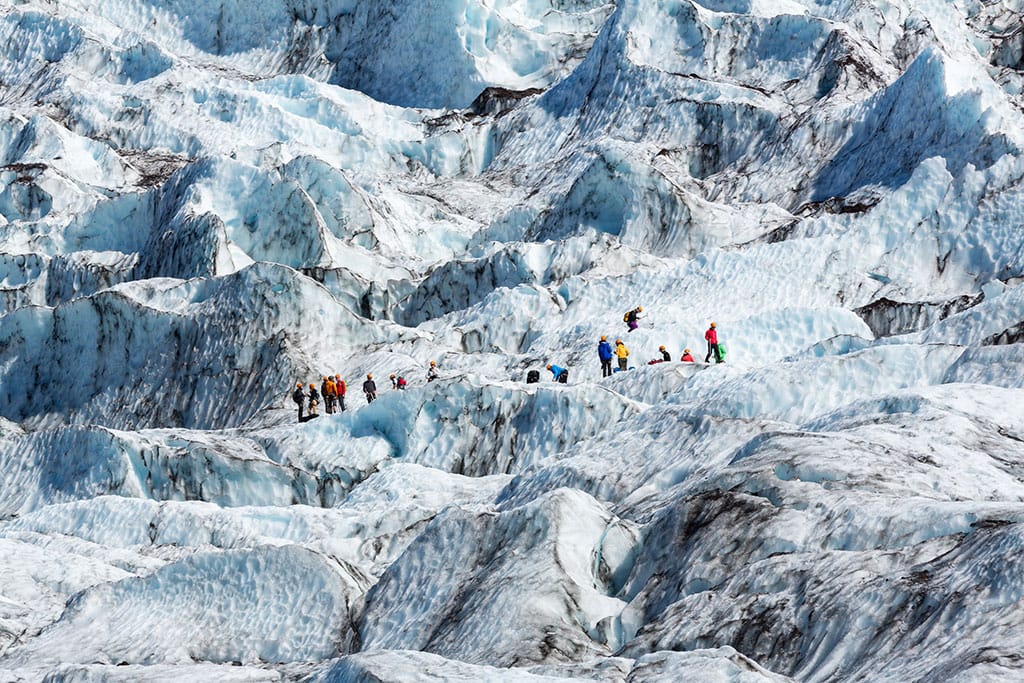
Winter is the best time to explore spectacular ice caves in all their ethereal beauty. Every October, tour companies go on scouting missions to find new caves, with tours starting up in early November. Iceland’s ice cave season runs from November until late March / early April (weather dependent). This is when it is safe to visit the country’s ice caves.
Throughout the five or so months of the ice cave season, some periods are better than others for adventures. Fewer tours are available in December and January, largely because of the limited hours of daylight.
As the days become lighter in February and March , more ice-caving tours operate. There are more hours of daylight to explore the ice caves and it’s a great time to get the best photographs of your adventures.
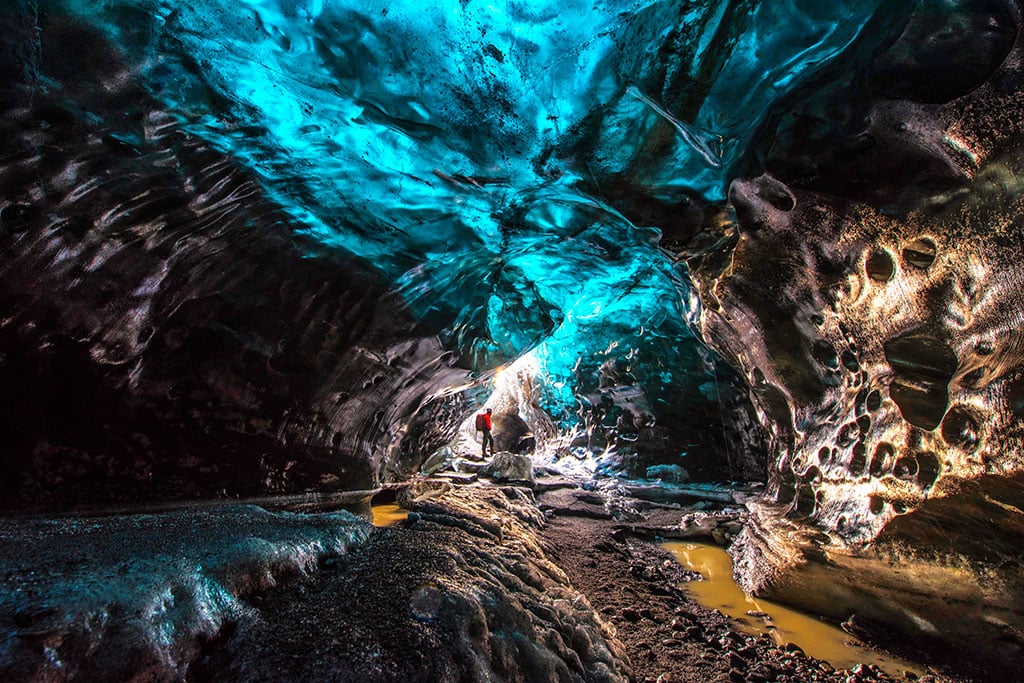
A family trip to Iceland will probably depend on existing time availability, such as holidays from work or school. There will probably be certain experiences that you’re keen to enjoy—you can look above for inspiration and ideas. For example, would your family prefer to experience the Northern lights or the midnight sun? Are you an active family that wants to spend time outdoors and spotting nature, or are you captivated by wintery landscapes?
Many families choose to visit Iceland in the summer, as this is when you will find the most child-friendly activities and things for people of all ages. The range of activities help to enhance any family vacation, providing educational and cultural understanding and education to complement and richen sightseeing around Iceland.
Driving around the island is one of the most convenient ways for families to fully make the most of their time in Iceland. Rent a car or book a self-driving package and discover Iceland at your leisure. You can choose which places to add to your itinerary, how long to spend at each place, where to stop to eat, when to take bathroom breaks, and so on. You’re completely in control of your holiday. Travelling at a slower pace is recommended for families, especially in the winter months when you’ll need to have some flexibility and may need to make last-minute changes to plans if roads are closed etc.

Iceland is the perfect romantic destination for a honeymoon. Lovebirds can explore the nation’s gorgeous landscapes, discover the creative culture, and enjoy a diverse selection of tours and activities.
While you might already have set your honeymoon dates if you are able to choose when to take your honeymoon we really recommend a visit in the low season. Prices are lower and there are much fewer crowds to interrupt your newly wedded bliss.
The best time for an Icelandic honeymoon, however, does largely depend on what you are expected to see and do.
Summer is lovely, with plenty of lush greenery and endless sunny days. On the flip side, it’s the busiest tourism time, with the highest prices and biggest crowds. Autumn is brilliant, with smaller crowds and lower prices, not to mention the possibility of witnessing the Northern Lights and attending cool music festivals.
Visiting Iceland in the winter can be really romantic, with the chance to make many magical memories of your first vacation as a married couple. Many major attractions are still accessible, but without the large crowds, and the snowy landscapes are enchanting. You can still spot the Northern Lights and then return to a cozy accommodation to relax and snuggle up.

In a nutshell, the more time you can spend in Iceland, the better! You can scratch the surface of Iceland’s famous attraction in a shorter trip of a few days, but you’ll truly get the most out of your holiday if you can stay for at least a week. With a week’s vacation, you can tick off the most popular places, enjoy typical activities like snowmobiling and hiking on a glacier, and take a relaxing dip in an enticing geothermal pool. And all at an unhurried pace.
With ten days or more you can travel more extensively around the island and visit some off-the-beaten-track gems and remote countryside treasures. This is a great way to get away from the masses and enjoy relative peace and quiet.
If you want to understand Iceland more like a local, plan to stay for at least two weeks … longer if possible. As well as headline attractions you can spend long days hiking in picturesque nature, stroll around lesser-visited seaside communities, marvel at remote fjords, and escape the tried-and-trodden path in places like the Eastfjords, Westfjords, and the north. There will be more opportunities to relish local cuisine, interact with locals, and learn more about the unique Icelandic culture.
Have you decided on the best time for your trip to Iceland? Or perhaps you’re still looking for a bit more guidance? In any case, contact our expert Iceland travel consultants to start the ball rolling in planning your amazing vacation.
- Share on Facebook
- Send in Messenger
Related Posts

Iceland’s Hidden Gems: Explore the Unseen
While Iceland’s famous glaciers, volcanoes, and waterfalls draw millions of tourists annually, the real magic lies in its hidden corners. Private tours offer discerning travelers the luxury of exploring these secluded spots, revealing the breathtaking beauty and tranquility that only a few get to experience.
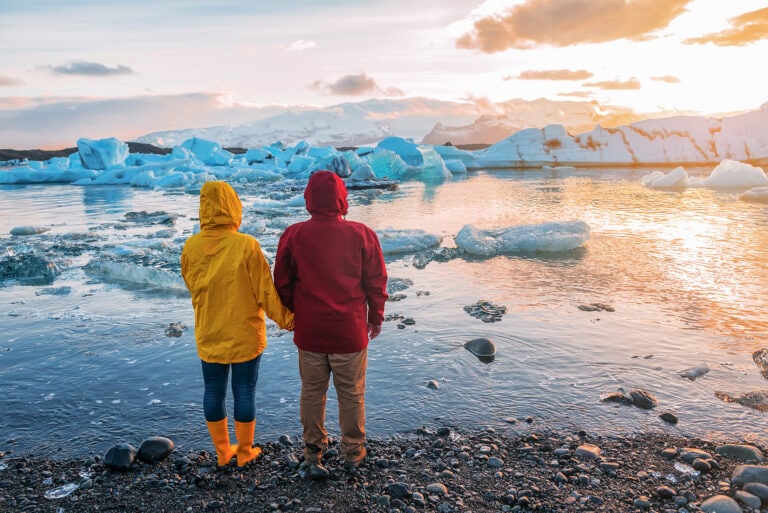
Private Tours vs. Custom Vacation Package in Iceland: Which Is Right for You?
Our comprehensive guide helps you determine which option best suits your travel style, budget, and preferences, ensuring an unforgettable journey through Iceland’s unique offerings.
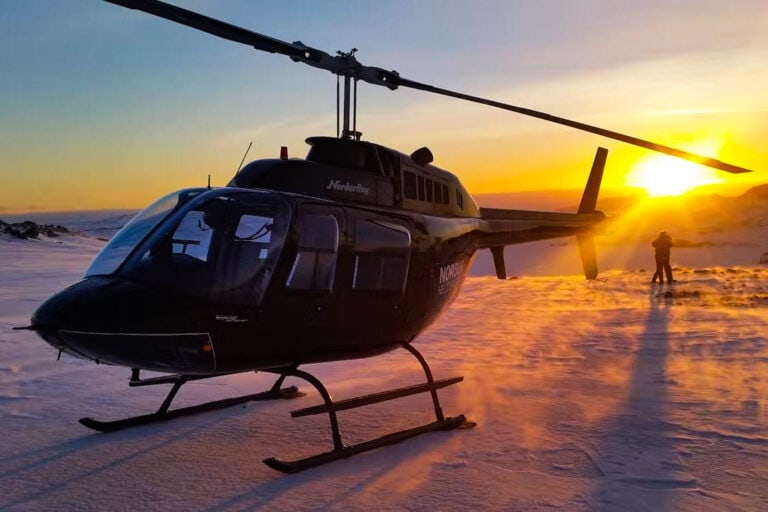
Iceland as a Luxury Travel Destination
Luxury travel in Iceland offers solitude and privacy, offering the wealthy a chance to immerse in untouched landscapes and exclusive experiences tailored for tranquility and disconnection from the everyday.
Recent Blogs
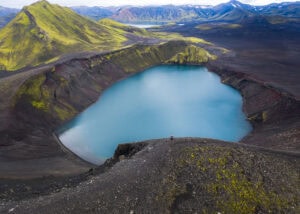
Personalized Adventures: The Benefits of Custom Tours in Iceland
Featured vacation packages, adventure-packed carbon neutral premium self-drive iceland tour – 8 day, sustainable iceland family adventure – 8-day co2 neutral self-drive tour, activity-filled co2 neutral self-drive tour – 5 days, action-filled luxury summer adventure, activity iceland by icelandia.
Authorized Tour Operator and Travel Agency certified by the Icelandic Tourist Board, a proud member of the Icelandia family . Tours offered on this website are sold under the license of Ferðaskrifstofa Kynnisferða.
- Private Tours
- Vacation Packages
- Golden Circle Tours
- Exclusive Offfers
- Our Car Fleet
- Luxury Travel Blog
- Privacy Policy
- Terms & Conditions
- Environmental Policy
- US/Canada: 1 (888) 642-8669
- International: (+354) 533 6003
- Klettagarðar 12. 104 Reykjavík
- [email protected]
- Contact form
© All rights reserved
Special offer
For a limited time on selected super jeep tours.
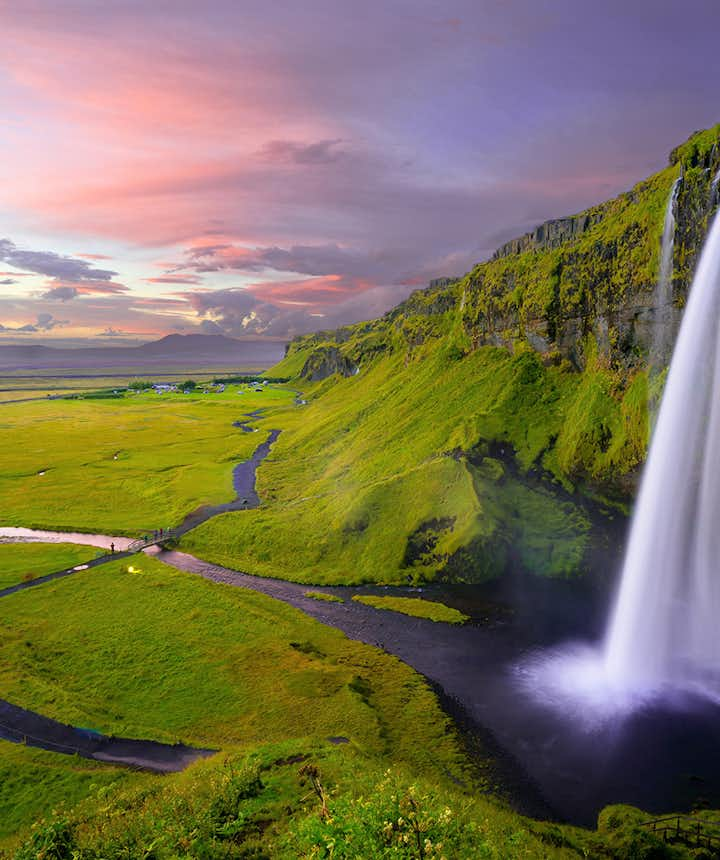
When Is the Best Time to Visit Iceland? - A Comprehensive Guide for Every Month & Season

What Is the Best Time of Year to Visit Iceland?
Iceland in spring, iceland in summer, iceland in fall, iceland in winter, when to visit iceland for seasonal activities, best time to see the northern lights in iceland, best time to see the midnight sun in iceland, best time to go whale watching in iceland, best time to go ice caving in iceland, best time to take a road trip in iceland, best time to visit the blue lagoon, best time to go camping in iceland, best time to visit hot springs in iceland, best time to go river rafting in iceland, best time to go birdwatching in iceland, the travel seasons in iceland, peak season in iceland, shoulder season in iceland, low season in iceland, weather & daylight hours in iceland, spring weather & daylight hours in iceland, summer weather & daylight hours in iceland, autumn weather & daylight hours in iceland, winter weather & daylight hours in iceland, the best month to visit iceland, iceland in january, iceland in february, iceland in march, iceland in april, iceland in may, iceland in june, iceland in july, iceland in august, iceland in september, iceland in october, iceland in november, iceland in december, faqs about the best time to go to iceland, can i visit iceland in winter, are the northern lights visible during the summer in iceland, is it possible to visit the golden circle year-round, what should i wear when visiting iceland in winter, what should i wear when visiting iceland in summer, can i rent a car and drive in iceland any time of the year.

By understanding how each season offers distinct experiences, you'll be better equipped to plan your ideal Icelandic adventure that's tailored to your preferences and priorities. As Iceland is located in the far northern hemisphere, right at the edge of the Arctic Circle , the differences between seasons are quite dramatic.
The best time of year to visit Iceland, therefore, depends on what you most want to do. Whether you're looking to go whale watching , head to a glacier to explore an ice cave or visit the Westfjords , the time of year is key when it comes to planning your trip.
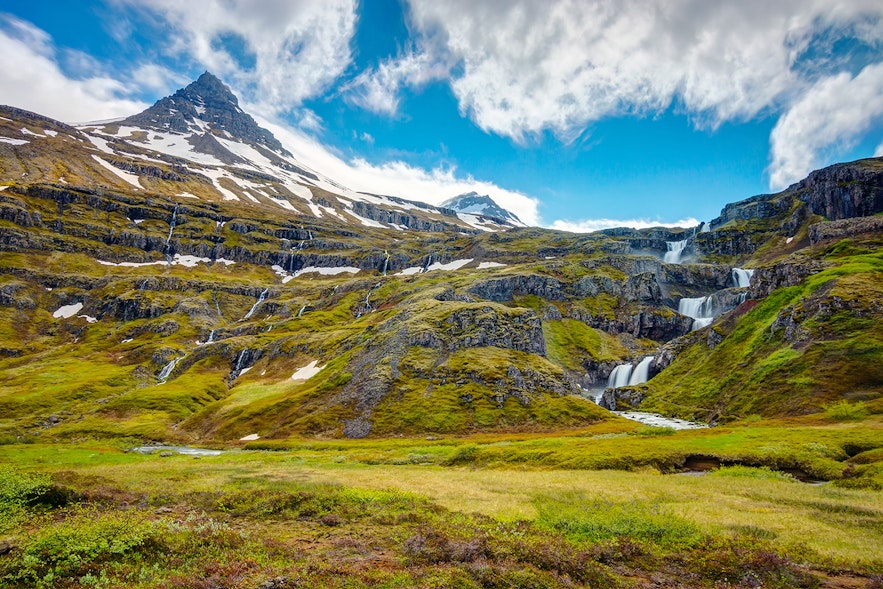
When wondering about the best time to travel to Iceland, first, you need to make a decision on what season works best for you. Iceland's four seasons differ in not only the weather but also the number of daylight hours. Each season has its characteristics and different things to do that may not be available in other seasons.

Additionally, spring is an ideal time for birdwatching enthusiasts, as migratory birds, including the charming puffin, return to nest along the rugged cliffs. It's also the last chance to see the northern lights before it gets too bright. Overall, spring provides a serene and picturesque setting for exploring Iceland.
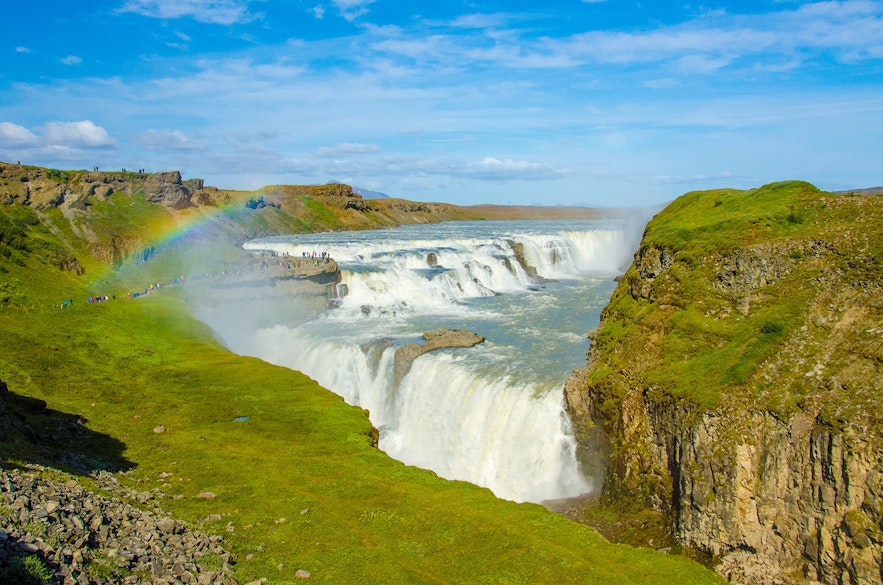
The warmer temperatures also make it a perfect season for outdoor activities such as horseback riding and going on hiking tours . Summer is the peak season for the number of travelers, so expect more crowds at popular attractions. However, the opportunity to go on tours of the Highlands and indulge in various festivals celebrating Iceland's culture and history makes it a truly memorable time to visit.
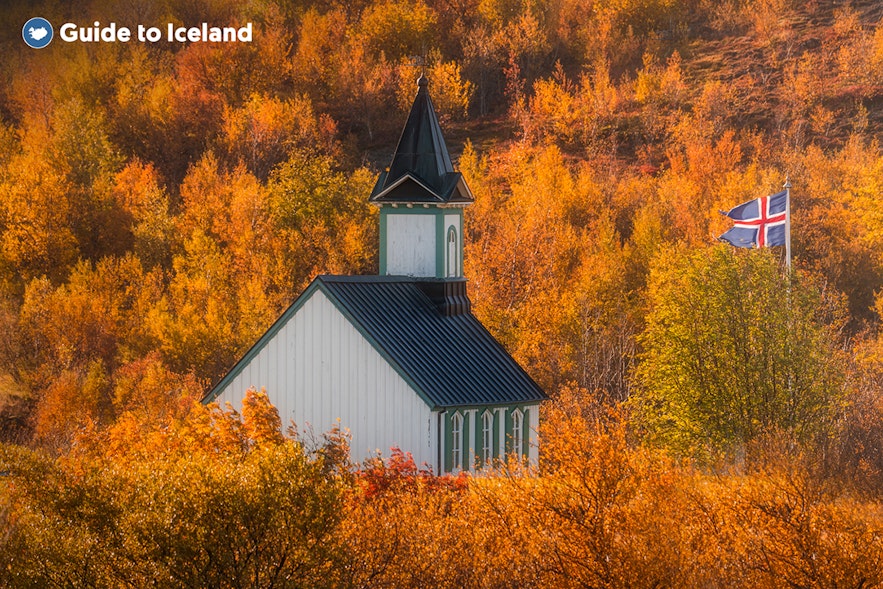
With cooler temperatures setting in, visitors can still enjoy outdoor pursuits such as hiking and exploring geothermal hot springs without the summer crowds. Fall also brings the return of darker skies, so the chance of seeing the elusive aurora borealis returns. Visiting Iceland in the fall promises a unique blend of natural beauty, space to roam, and opportunities for unforgettable experiences.
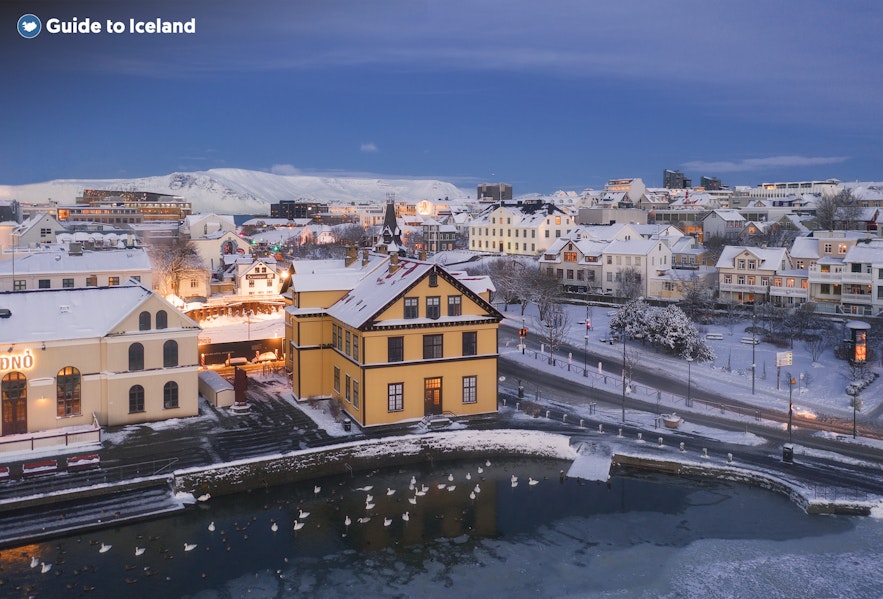
The long nights provide ample opportunity to chase the magical northern lights or even go on a northern lights cruise , while the festive atmosphere in towns around the country allows visitors to enjoy the local Christmas celebrations and the bombastic New Year's Eve. Although the weather can be unpredictable, visiting Iceland in winter offers a unique experience that highlights the country's enchanting allure.
- Learn more: New Year's Eve in Iceland
Because of the wide range of different activities and things to do in Iceland, it can be helpful to break down what activities are possible dependent on the time of year. Of course, there are plenty of things you can do any time of year, such as engaging in delicious food tours in the city or exploring the many waterfalls around the country (just wear layers in the winter!), but below are a few of the seasonal-dependent activities that might make or break when you'd want to visit Iceland.
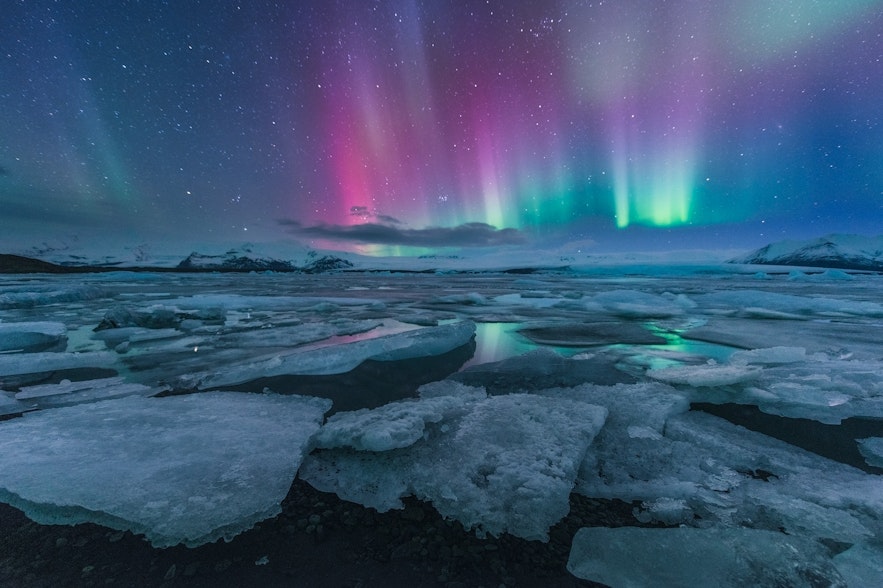
Keep in mind that while this mesmerizing phenomenon is largely dependent on solar activity and clear skies, it is also important to venture away from city lights to areas with less light pollution for the best viewing experience. Then cross your fingers and enjoy the show!
Top Northern Lights Tours & Holidays
2 day ice cave tour with south coast waterfalls & jokulsarlon glacier lagoon, 3-day northern lights tour of iceland’s golden circle & south coast with ice caving & glacier hiking, 8-day guided northern lights winter tour of the complete ring road of iceland.
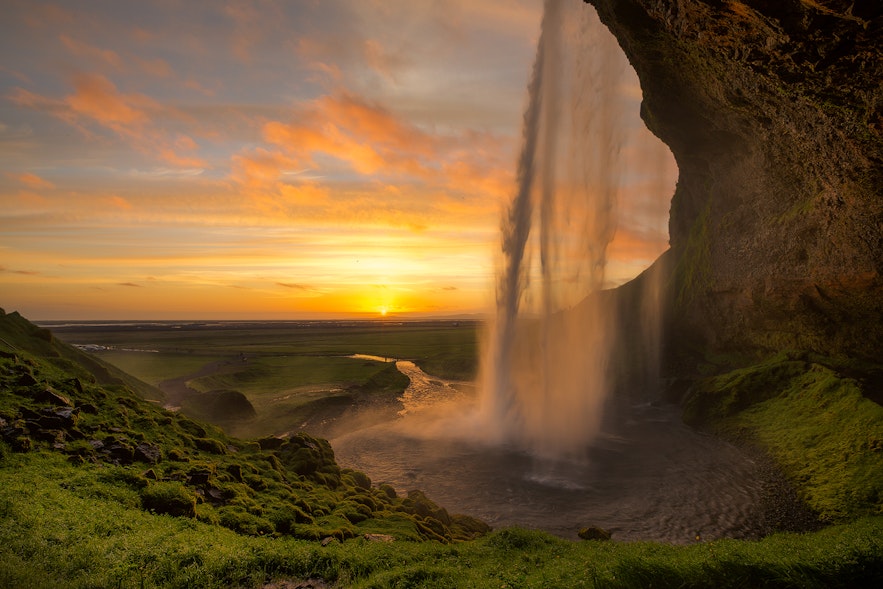
During this time, the sun barely dips below the horizon, and daylight extends into the night as the sky turns pink and purple during a long-lasting twilight period. This provides plenty of opportunities for late-night sightseeing, photography, and exciting midnight sun tours .
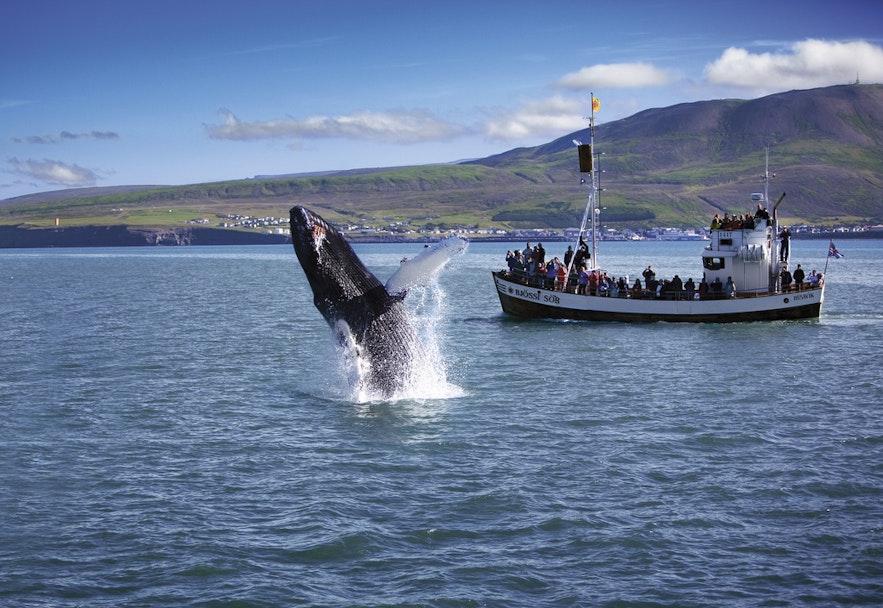
Photo from Original 3-Hour Whale Watching Adventure in Oak Boats
The best time to go whale watching in Iceland typically falls between April and October, with peak season occurring in the summer months of June, July, and August. During this period, the seas around Iceland become a feeding ground for multiple species of whales, resulting in a higher probability of sightings. Minke whales, humpback whales, and white-beaked dolphins are commonly sighted during these months.
However, orcas and dolphins are most commonly spotted during the winter months, specifically from February to March, when Breidafjordur bay becomes a feeding ground full of herring, which can be spotted on this Snaefellsnes whale-watching tour . You can also keep in mind that whale-watching tours are less crowded during the winter, which is another advantage.
- Learn more: The Best Guide to Whale Watching in Iceland
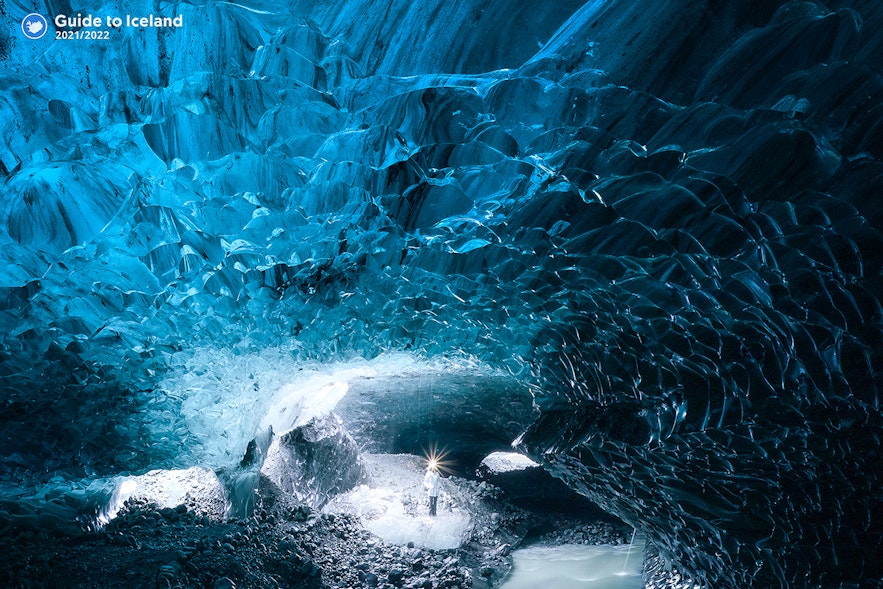
Photo from Best Ice Cave Tour in Vatnajokull Glacier
The optimal time for ice caving in Iceland is during the colder months, typically from November to March. During this period, the temperatures drop sufficiently to freeze the glacial ice caves, making them safe and stable to explore. That's when they're at their most spectacular, with the clear blue ice illuminated by the refracturing sunlight. It's important to note that ice caving should always be undertaken with a guide on professional ice cave tours .
During the summer, most ice caves become too unstable to be visited safely, with two exceptions! You can still visit the ice cave at Katla , near the town of Vik on Iceland's south coast. Additionally, you can visit the ice cave tunnel in Langjokull , which was carved into the glacier itself.
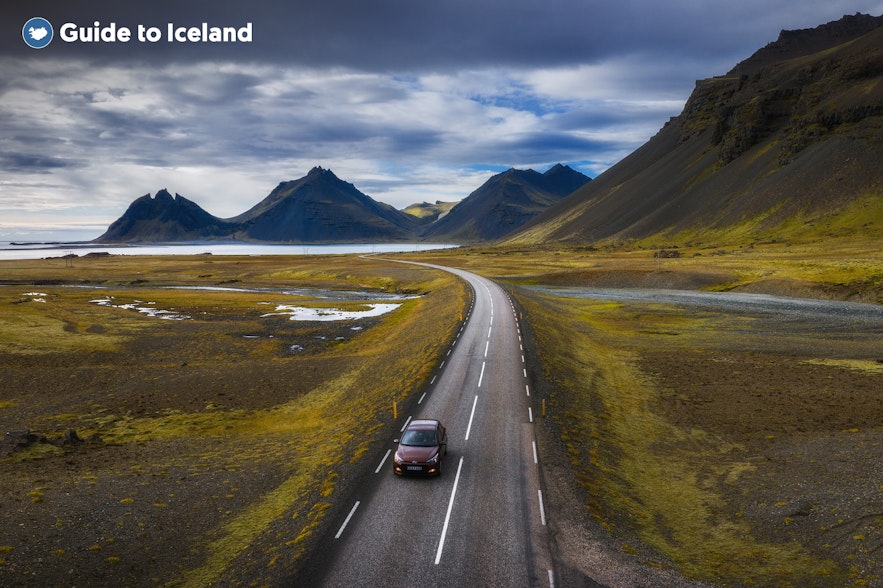
However, if viewing the northern lights is on your bucket list, consider a road trip between September and March when they are visible after sunset. Be mindful that winter driving can be challenging due to unpredictable weather and shorter days, and renting a 4x4 car is crucial to stay safe. Check out the many winter self-drive tours available, which are fully customized with extensive itineraries and pre-booked accommodations around the country.
Top Self Drive Tours in Iceland
10-day self-drive tour of the complete ring road of iceland with top attractions & snaefellsnes, best 1-week summer self-drive tour of the ring road of iceland & golden circle, best 7-day northern lights self drive tour through south iceland to jokulsarlon ice cave.
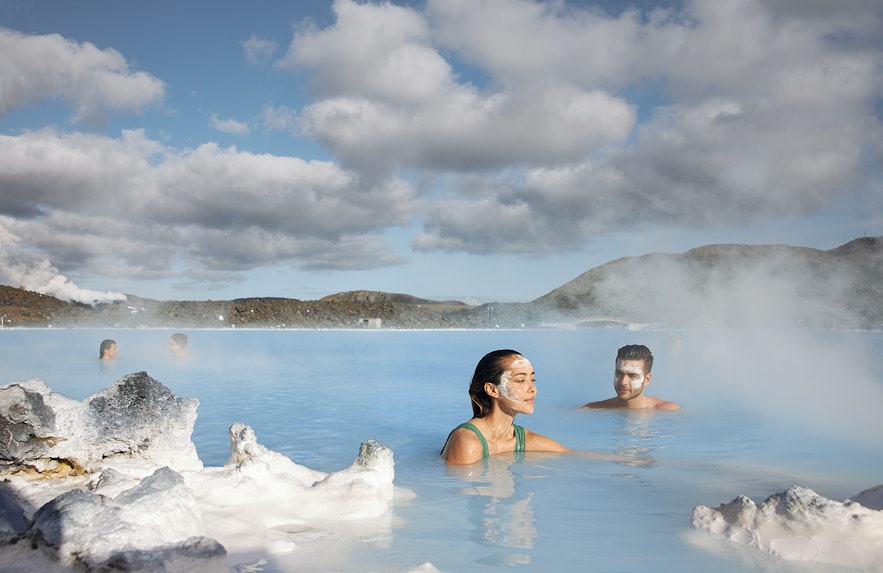
However, for those seeking to view the northern lights while relaxing in the warm waters, the best time to visit is during the winter months (September to March), although keep in mind that daylight is significantly shorter during this time. Regardless of the season, this warm lagoon often gets busy, so it's advisable to book your tickets to the Blue Lagoon well in advance and try to go early in the morning or later in the evening when it's less crowded. There's also a wide variety of Blue Lagoon tours that incorporate other activities with a visit to the famous geothermal spa.
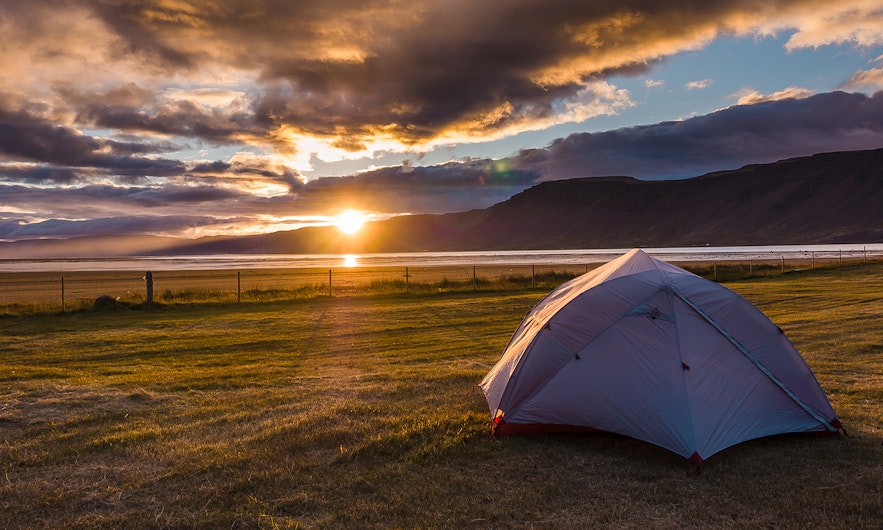
While camping in other seasons is possible, winter camping can be particularly challenging due to harsh weather conditions, limited daylight, and the closure of many campsites. Keep in mind that no matter the season, camping outside of designated camping sites is illegal, including parking rental campervans overnight.

Photo from Admission to Hvammsvik Hot Springs near Reykjavik
Hot springs in Iceland can be enjoyed throughout the year, each season offering its unique charm. During the summer months, from June to August, the milder weather and extended daylight hours allow for more flexible planning. Visiting during the midnight sun can add an extra layer of enchantment to your hot springs experience.
However, many people find the contrast of Iceland's chilly winter temperatures and the warm geothermal waters irresistible. There's also a chance to see the northern lights while you soak, creating a truly unique experience. Just remember that access to some remote hot springs can be more difficult in winter due to harsh conditions, so make sure to always check road conditions and weather before heading out.
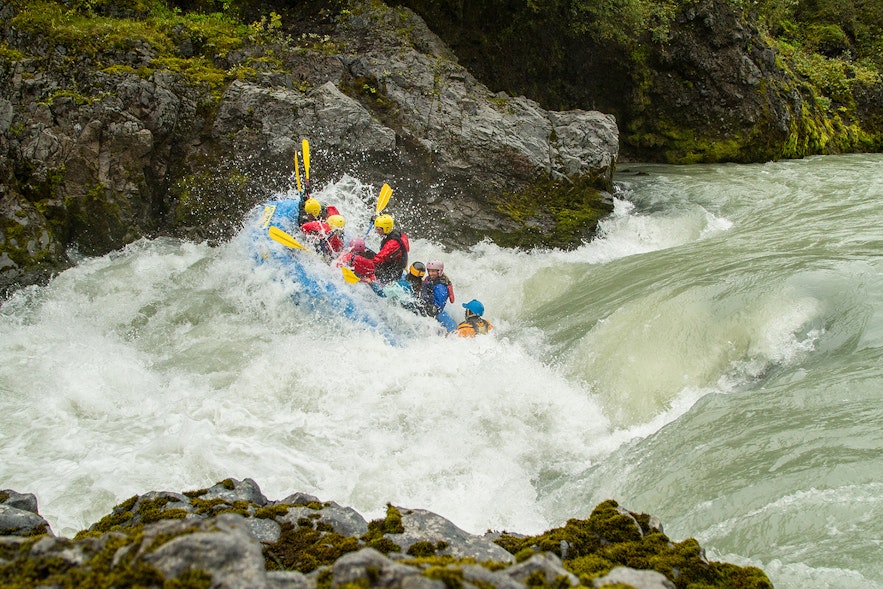
Photo from Whitewater Action in North Iceland
The ideal time for river rafting in Iceland typically falls within the summer months, from June to early September. That's when the weather is warmer and the snowmelt from the mountains feeds the rivers, creating thrilling white-water conditions ideal for rafting. If you're traveling with children, you could even embark on this 3-hour family-friendly river rafting tour in North Iceland .
Although the summer months are best, the season can start as early as May and extend into September, depending on weather conditions.
Top Rafting Tours
Family-friendly 3 hour whitewater river rafting tour in north iceland, whitewater action in north iceland, river rafting tour in north-iceland | west glacial river.
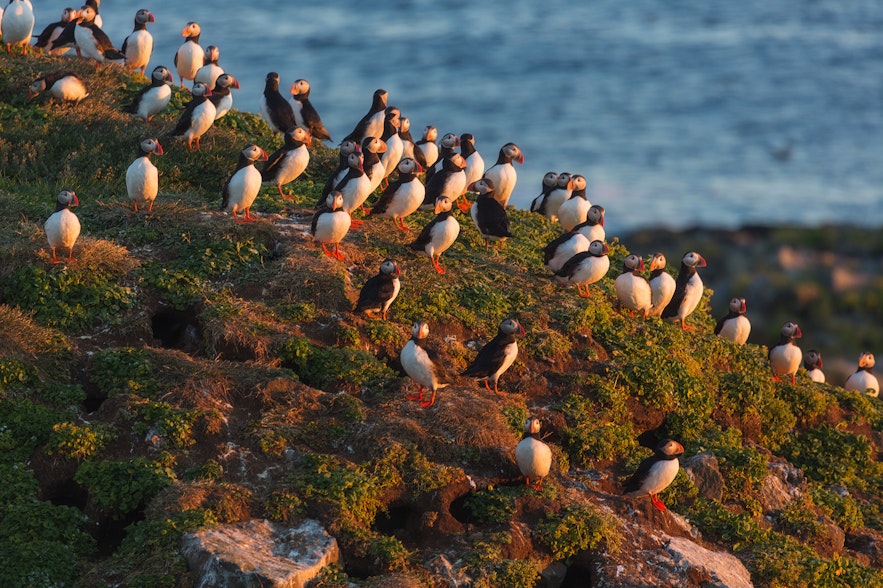
Also, with the summer's extended daylight hours, you have plenty of time to observe these feathered creatures in their natural habitat. Locations like the Latrabjarg cliffs in the Westfjords , Lake Myvatn in the north, and the Westman Islands are prime spots for birdwatching during this period. However, remember to respect the birds' nesting areas and observe from a safe distance to avoid causing any disturbance.
- Learn more: Birds in Iceland
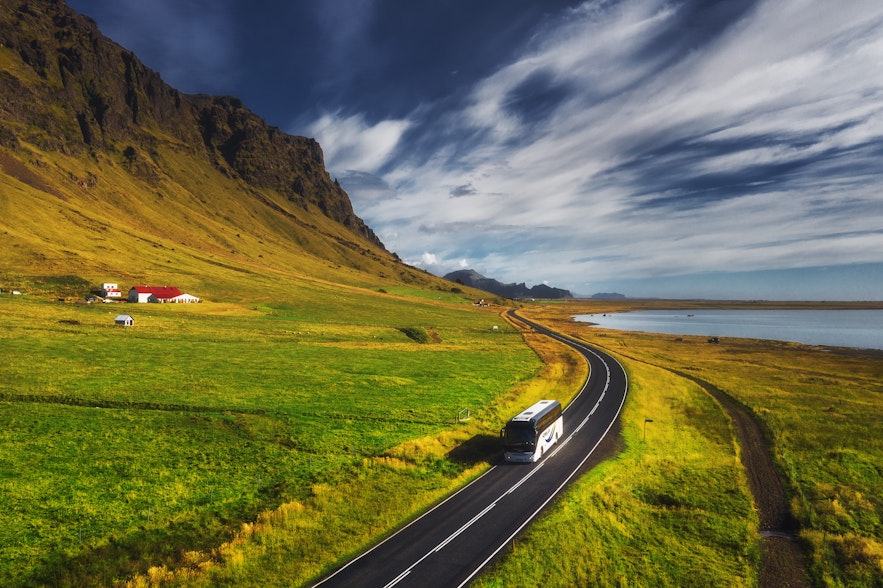
The peak season is during the summer months from June to August. This is because of the long hours of daylight, warmer weather, and the opportunity to engage in sightseeing around the country, and going on road trips on the Ring Road . The peak season shortly returns around the time of Christmas and New Year's during the last half of December into early January, as people visit to experience the festive atmosphere in Iceland during this period of the year.
The shoulder season splits in two, the first being in spring (April-May) and the second during autumn (September-October). During those periods, it's still relatively warm compared to the cold winter, and visitors can comfortably travel between attractions without much worry about snow. The days are certainly shorter than during the bright summer but still give plenty of time for sightseeing. You could even see the northern lights if conditions are right during April or October, even though it's not the prime season for aurora hunting.
Lastly, the off-peak season from November to March (minus the Christmas season!) presents the coldest weather conditions but also the greatest opportunities to see the northern lights, go glacier hiking , dog-sledding , or skiing. Note that daylight is very limited in the winter months, and certain areas may be inaccessible due to weather conditions, such as the Westfjords and the Highlands.
- Read more: 18 Things to Do & Places to Visit in Iceland
Iceland's weather varies significantly throughout the year due to its location close to the Arctic Circle. The country experiences relatively mild but unpredictable weather. Because of its proximity to the Arctic, daylight hours swing dramatically during the year. This can be good to know when deciding when to go to Iceland.
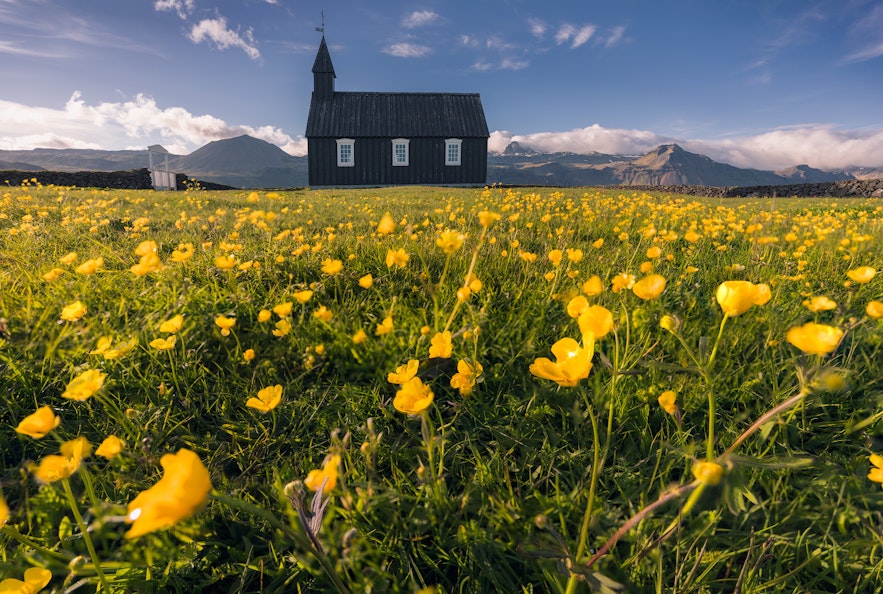
Concurrently, the daylight hours rapidly increase due to Iceland's position near the Arctic Circle. In the early spring, there can be approximately 13 to 14 hours of daylight, with the sun rising around 6 AM and setting around 8 PM in April. However, by late May, daylight can extend up to 20 to 21 hours a day. This significant increase in daylight hours, coupled with the country's blossoming landscapes, marks a vibrant and exciting time to experience Iceland's unique natural beauty.
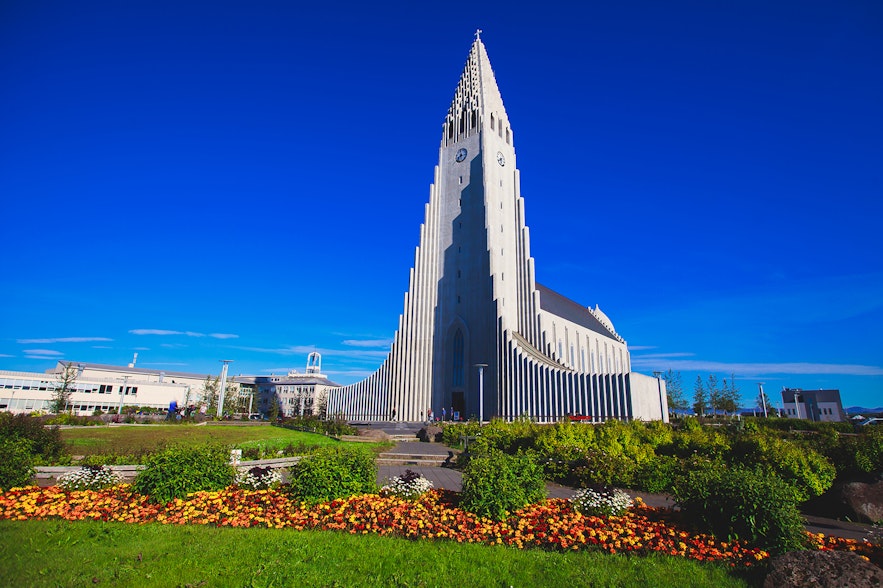
During this season, the daylight hours in summer reach their peak due to Iceland's position. In the early summer months, daylight extends remarkably, offering nearly 24 hours of daylight, peaking around the summer solstice in late June. The sun barely dips below the horizon before rising again, giving birth to the mesmerizing phenomenon known as the Midnight Sun. This astonishing period of prolonged daylight paints the landscapes in a continuous golden hue and offers extended hours for exploration.
Top Summer Tours & Packages
4-day reykjavik city break with optional activities.
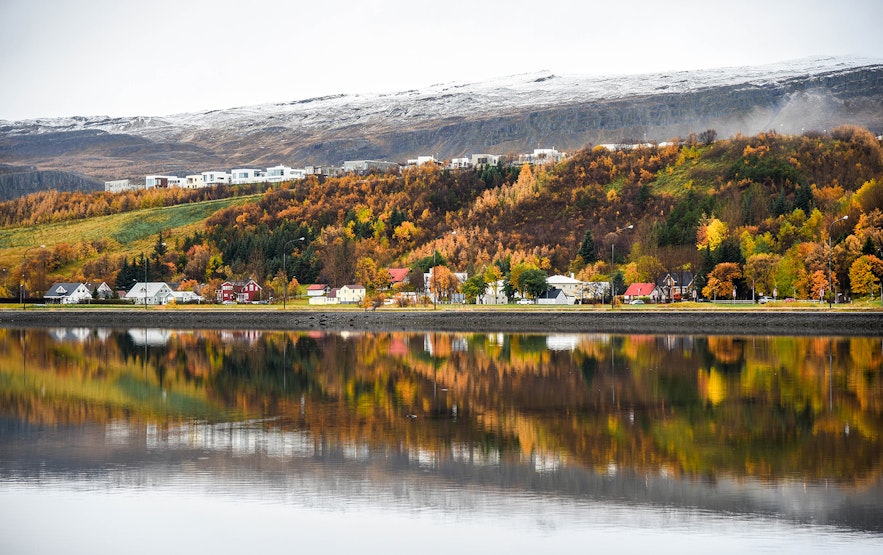
Daylight hours begin to recede during the autumn months. At the onset of autumn in September, the length of daylight begins to align more closely with the length of night, providing approximately 12 to 13 hours of daylight, with the sun rising around 6:30 AM and setting around 7:30 PM. However, by late October, daylight hours diminish to approximately 8 to 9 hours per day, with the sun rising closer to 9 AM and setting around 5 PM. This creates an opportunity to view the northern lights when the skies are dark.

In terms of daylight, winter marks the period of the shortest days in Iceland due to its proximity to the Arctic Circle. By December, daylight hours can be as short as 4 to 5 hours a day, with the sun rising around 11:30 AM and setting around 3:30 PM. However, this lack of daylight also creates the best time of year to see Iceland's most iconic natural phenomenon - the aurora borealis, which lights up the winter sky with its enchanting and colorful display.
- Learn more: Iceland's Weather, Climate and Temperature Year-Round
If you're not sure when to visit, or if you've already booked your flight and want to know what's going on when you arrive, here is a short overview for each month of the year in Iceland and what you can expect. Clicking on each of the headlines will take you to a much more detailed guide with everything you need to know about that particular month in Iceland.

Photo from Thrilling 2-Hour ATV Ride on South Coast to the DC Plane Wreck
August is the last month of pure summer bliss in Iceland, making it a great time of year for fun outdoor activities such as feeling the serenity of the water on kayaking tours , getting a rush of adrenaline while zooming across black sand beaches on ATV and buggy tours or braving the rapids of glacial rivers on epic rafting tours . If you'd prefer to take things slow and just enjoy the beauty and peacefulness of nature, go sightseeing and enjoy the many natural wonders around the country. The first weekend of August is a 3-day weekend for Icelanders, with many festivals being held around the country, the biggest one being in the Westman Islands. The festivities in August continue, with Menningarnott (Reykjavik Cultural Night) being celebrated the following weekend and Reykjavik Pride Festival the weekend after that. If you're not sure about things to do, check out our extensive selection of August tours which you can book online.
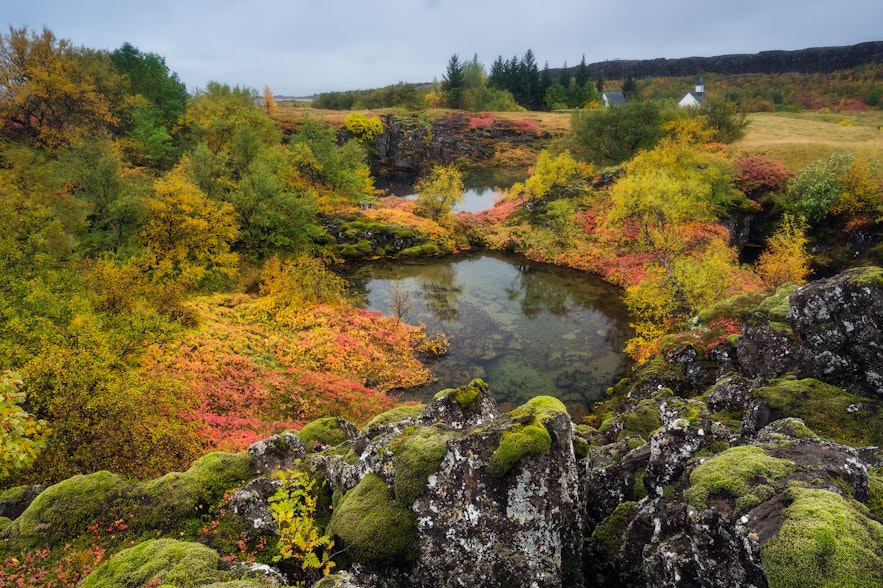
Yes, Iceland can be visited in winter. This is the best time to see the northern lights. However, keep in mind that the weather can be unpredictable and daylight hours are reduced. There is a wide range of winter tours and packages in Iceland that you can explore.
The northern lights are not visible in summer due to the long daylight hours. The best time to see them is during clear, dark nights from late September to early April. For the best chance to see these elusive lights, there are a lot of northern lights tours to choose from during the winter.
Yes, the Golden Circle is open any time of the year and is conveniently located close to Reykjavik. If you're driving yourself, it's a good idea to rent a 4x4 vehicle if you're going there during the winter in case the roads are snowy. If you don't want to drive, there is a wide variety of Golden Circle tours to choose from.
During winter in Iceland, it's important to dress in layers to stay warm and comfortable. Start with thermal underwear and add layers such as a fleece jacket or wool sweater. Over this, wear a windproof and waterproof outer layer. Don't forget to wear insulated waterproof boots with good grip, as streets can become icy. Warm socks, gloves, hats, and scarves are also essential to protect against the cold.
Even in summer, weather in Iceland can be unpredictable. Pack layers, including a warm jacket, waterproof outer layer, hat, gloves, sturdy footwear, and warm socks. Don't forget your swimsuit for geothermal lagoon visits! You can read our Ultimate Guide on What to Wear in Iceland for tips about dressing appropriately any time of year.
Yes, renting a car in Iceland is a popular way to explore the country. Do note that weather conditions can make driving challenging, especially in winter. Always check road conditions and weather forecasts before setting out.
When would you most like to visit Iceland? If you have been to Iceland, what time of year did you visit? Let us know in the comments below!
Popular articles

Guide to Iceland | The Story of the Leading Travel Agency of Iceland

The Complete Guide to the Midnight Sun in Iceland

Top 20 Most Beautiful Waterfalls in Iceland

22 Photos of the Aurora in Iceland

Mountains in Iceland
Other interesting articles.
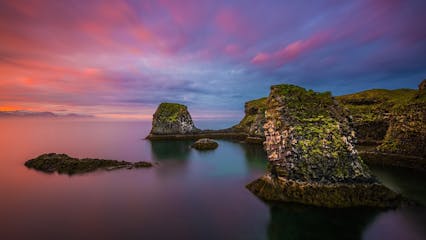
Top 16 Things to Do on the Snaefellsnes Peninsula
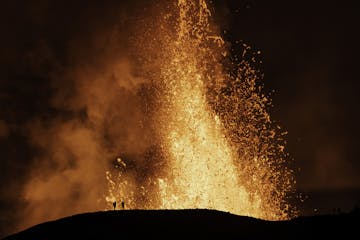
Volcanic Eruptions on the Reykjanes Peninsula in Iceland - A Complete Timeline (2021-2024)
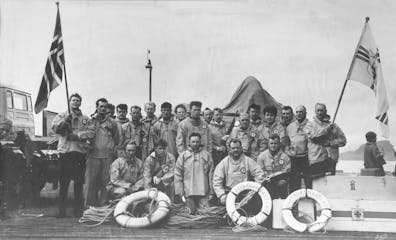
The History of 66°North: Keeping Iceland Warm for a Century

Download Iceland’s biggest travel marketplace to your phone to manage your entire trip in one place
Scan this QR code with your phone camera and press the link that appears to add Iceland’s biggest travel marketplace into your pocket. Enter your phone number or email address to receive an SMS or email with the download link.
Top things to do in Iceland
Book your complete trip with the best companies only

Visit a Live Volcano

Visit the Blue Lagoon

Go on a Road Trip

Do the Golden Circle

See the Glacier Lagoon

South Coast Tours

Find the Northern Lights

Explore an Ice Cave
The Best Time to Visit Iceland
Iceland is a thrilling destination to visit in any season. Winter dazzles with snow-dusted landscapes and the shimmering northern lights illuminating the night sky. Meanwhile, summer promises outdoor adventures beneath the midnight sun, whale watching, and much more.
Spring and fall may be “shoulder seasons” – periods with fewer visitors – but they offer their own wonders. Spring brings Iceland’s driest months, when the snows melt and the country welcomes its summer wildlife. And fall drapes the island’s landscapes in rich autumnal colors.
In this guide, you’ll discover the best time to visit Iceland for the exclusive activities on offer. But first, explore with us the unique charm of each season in the Land of Fire and Ice.
- Experience Iceland on a deluxe self-drive or privately guided tour .
A guide to seasons in Iceland
Each time of year has something special to offer in Iceland. Here’s what you can expect throughout the seasons.
Summer in Iceland
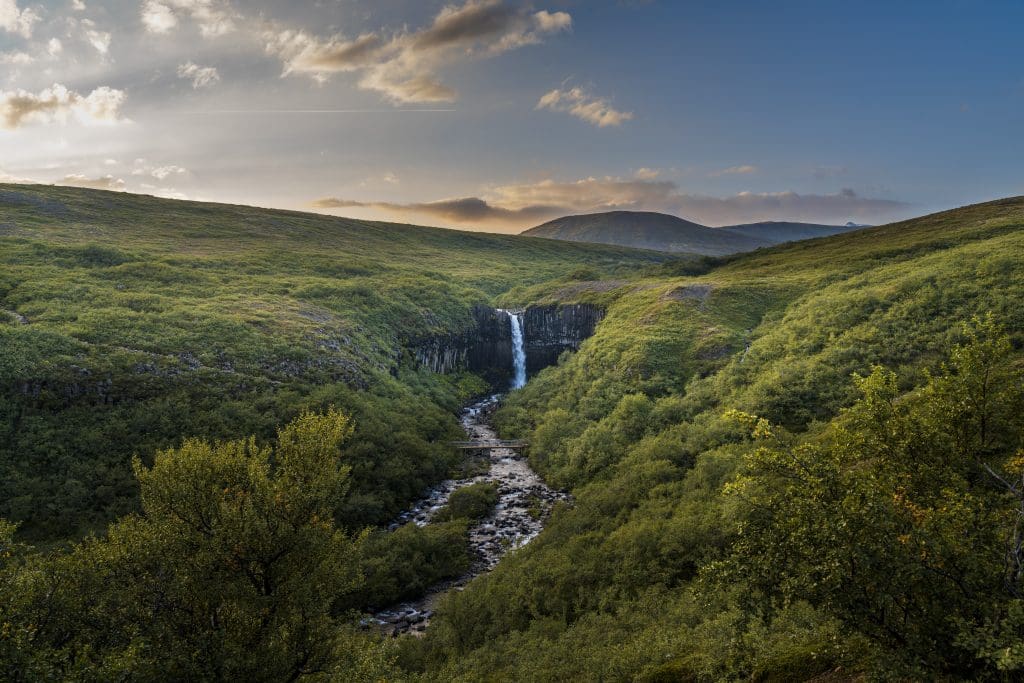
Stretching from June to August, summer is the most popular time to visit Iceland. With longer days and warmer weather, it’s a period when locals and visitors want to be outdoors basking in the endless daylight.
This is the season for off-the-beaten-track adventures in the mountains and highlands, parts of the country that are less accessible at other times of year. Alternatively, it’s an ideal time for road trips around the Ring Road, to see steaming hot springs, plunging waterfalls, towering glaciers, and more unforgettable sights.
In June and July, the sun never sets below the horizon. Travelers have longer days to enjoy exclusive experiences, such as whale watching expeditions or private picnics among the rhyolite mountains of Landmannalaugar.
Iceland sits just below the Arctic Circle, so warm layers will be necessary even in summer. During this season, average temperatures in Reykjavík range from 10°C (50°F) to 13°C (55°F).
Winter in Iceland
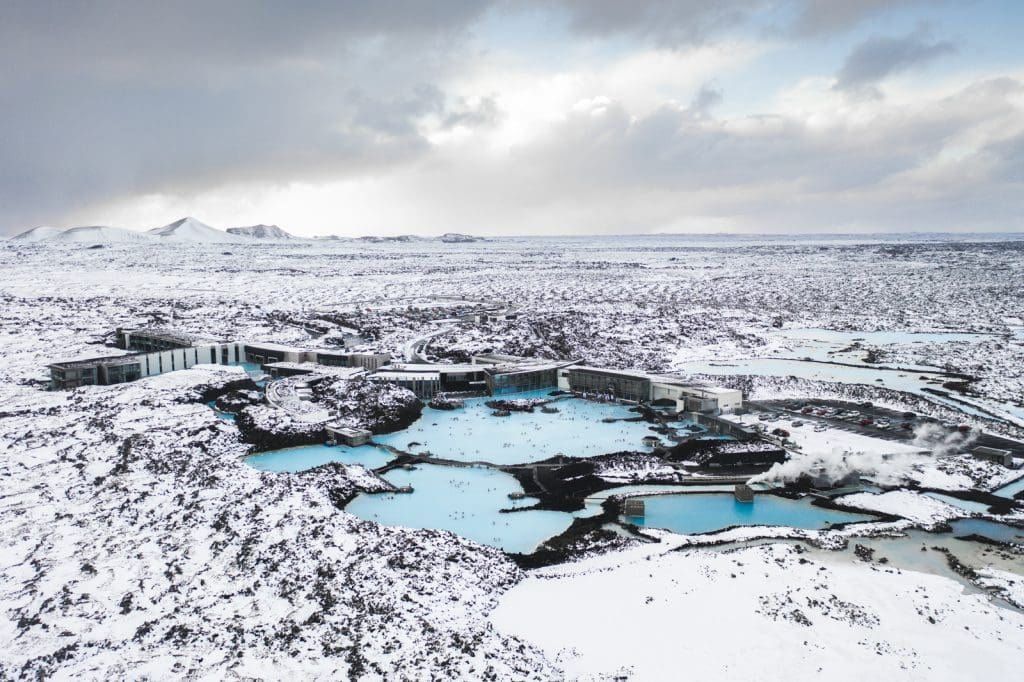
With longer nights and snowy landscapes, Iceland’s winter months have a different appeal. Around Christmas and New Year’s Eve, the towns are adorned with festive lights. But the real stars of the show are the northern lights, the magnetic waves of color in the Arctic sky.
Outside, the weather can sometimes be unpredictable. But it’s often dry enough to escape the city and see the countryside in its winter coat. For instance, travelers can take a private snowmobile tour across Eyjafjallajökull, an ice-capped volcano on Iceland’s south coast.
As the evening draws in, it’s the perfect opportunity to indulge in an Icelandic spa ritual. The Blue Lagoon, for example, offers luxurious wellness treatments and Michelin-starred dining.
Thanks to its location away from the city lights, the Blue Lagoon is an excellent vantage point to glimpse the hypnotic northern lights. Guests of the Retreat Hotel or the Silica Hotel, can request a wake-up call to ensure they won’t miss the aurora, even if it makes an overnight appearance.
Of course, Iceland’s winter is cold, but not as cold as many people expect. Average temperatures in Reykjavík, for example, range from 0°C (32°F) to 3°C (37°F).
- Learn what to pack on a summer or winter trip to Iceland.
Spring in Iceland
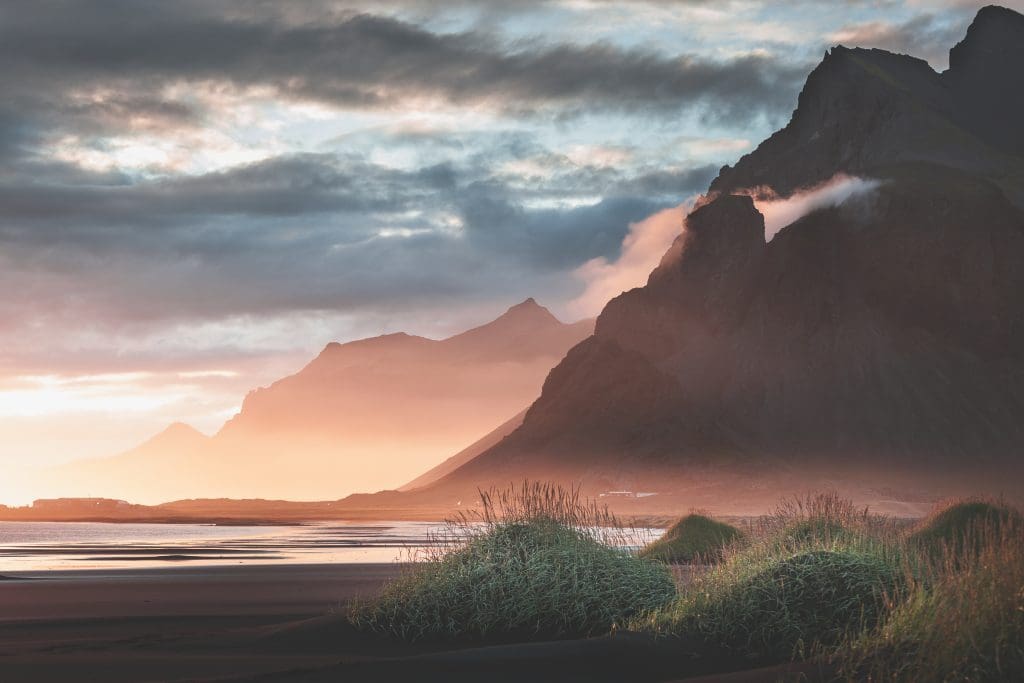
Traditionally, the start of spring is marked by the arrival of the golden plover, a bird that makes Iceland its summer home. This usually occurs around March, as temperatures rise and the nights get gradually shorter.
The golden plover is a symbol of the return of nature after winter. And it’s exactly this that visitors can experience during the months of May and June. Puffins return to Iceland’s shores in spring and a variety of whales can be seen later in the season.
The beauty of Icelandic spring is that the best of winter isn't over yet. Visitors can still glimpse the northern lights and venture into glacial ice caves, even as the country prepares for summer.
Average temperatures in Reykjavík are 2°C (36°F) to 6°C (43°F). Early in the season, nights can still be quite frosty, but it quickly warms up during the day.
Fall in Iceland
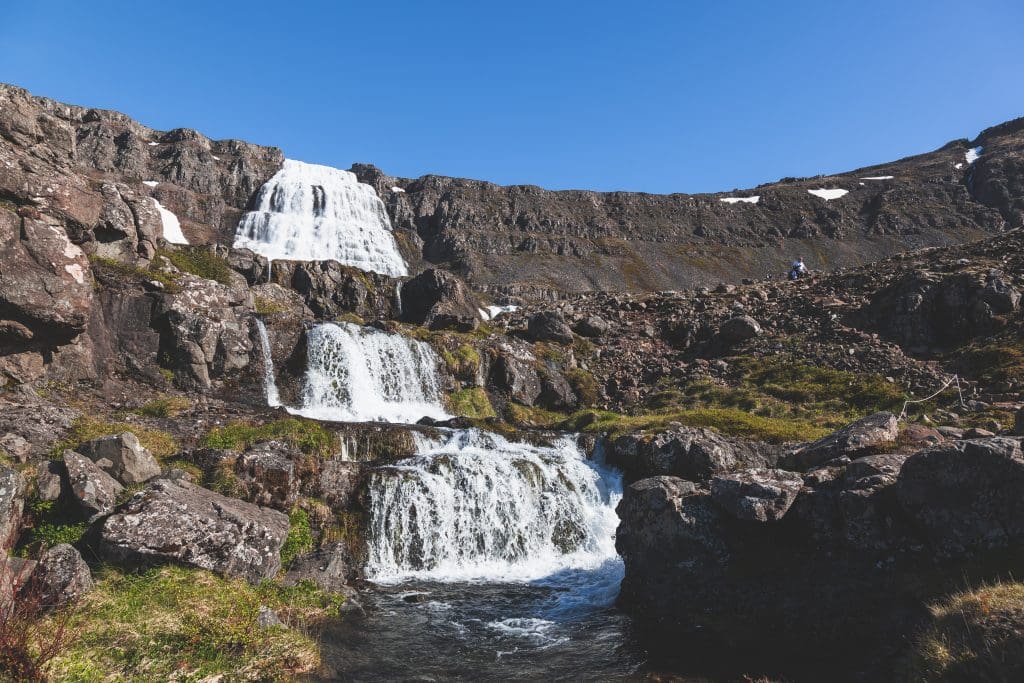
Fall is the season of vibrant natural colors, when trees turn to fiery gold and the first snows dust the hills. Temperatures are dropping, but nature is as beautiful as ever.
During this time, Iceland’s most famous sights can be enjoyed with fewer visitors around. For instance, visiting the Golden Circle’s powerful geysers and breathtaking waterfalls will be a more tranquil experience.
Throughout September, travelers still have time to witness Iceland’s exceptional wildlife. Whales and migratory birds are still here, but they’ll soon fly south for the winter. Arctic foxes, Iceland’s only native land mammals, are here year-round, but in autumn they change their brown coats to winter white.
Average temperatures in Reykjavík range from 3°C (38°F) to 8°C (46°F). Early in the season, it can feel like summer, but later it will be much cooler.
Best times to visit Iceland for…
Different seasons are better suited to particular activities. Read on to explore the best time of year to visit Iceland for exclusive experiences and tours.
- Discover unique things to do in Iceland in any season.
1. Whale watching
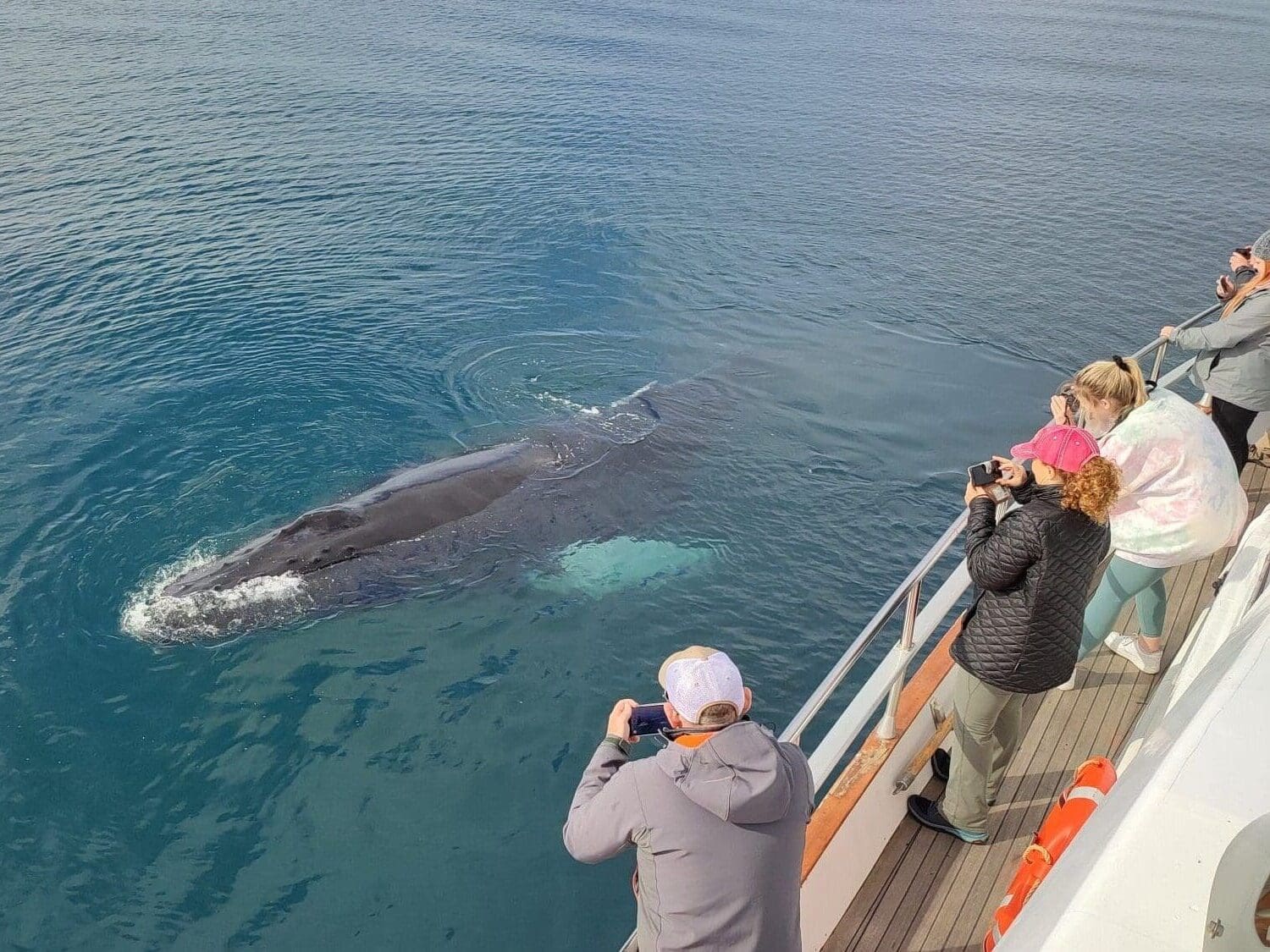
Best season: Late spring to early fal l
The best time to travel to Iceland for whale watching is summer. These magnificent creatures tend to be migratory , swimming thousands of miles across the ocean. They arrive in Icelandic waters during spring, then leave once more in fall.
In summer, as many as 12 different species can be seen in Icelandic waters, including humpbacks, minke whales, sei whales, fin whales, and even blue whales. For an intimate encounter with these gentle giants, visitors can sail out to sea on a private luxury yacht.
While it might be the best season, summer is not the only time for sea life watching. Orcas can be spotted throughout the winter, as well as seals, porpoises, and dolphins.
2. Northern lights
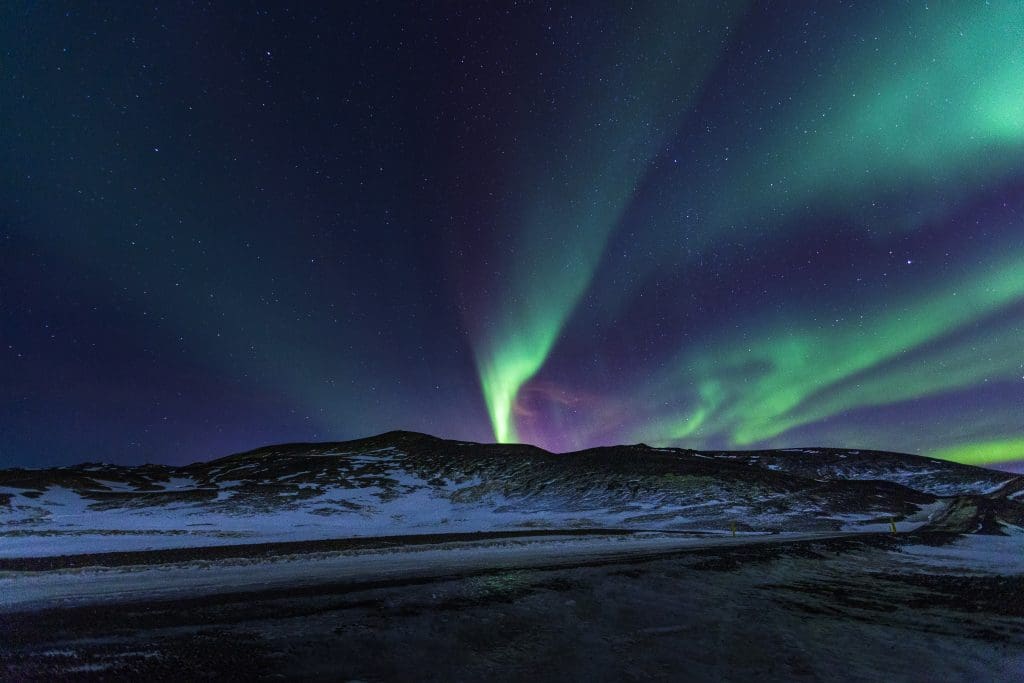
Best season: Mid-fall to mid-spring
Catching a glimpse of the captivating aurora borealis is an unforgettable experience. Thanks to its northern location and sparsely inhabited landscape, Iceland is the perfect place to see it.
The winter months are considered the best time to witness the northern lights. Fewer daylight hours means there’s ample opportunity to see this celestial light show. In winter afternoons, visitors can unwind in a geothermal spa such as the Blue Lagoon or Sky Lagoon, and catch the aurora dance above them.
While winter may be peak northern lights viewing season, they can also be seen in late fall and early spring. And, as the weather can be a little less unpredictable then, these seasons do have their perks.
- Discover an intimate setting to view the Northern Lights in this expert guide to Iceland's Deplar Farm .
3. The midnight sun
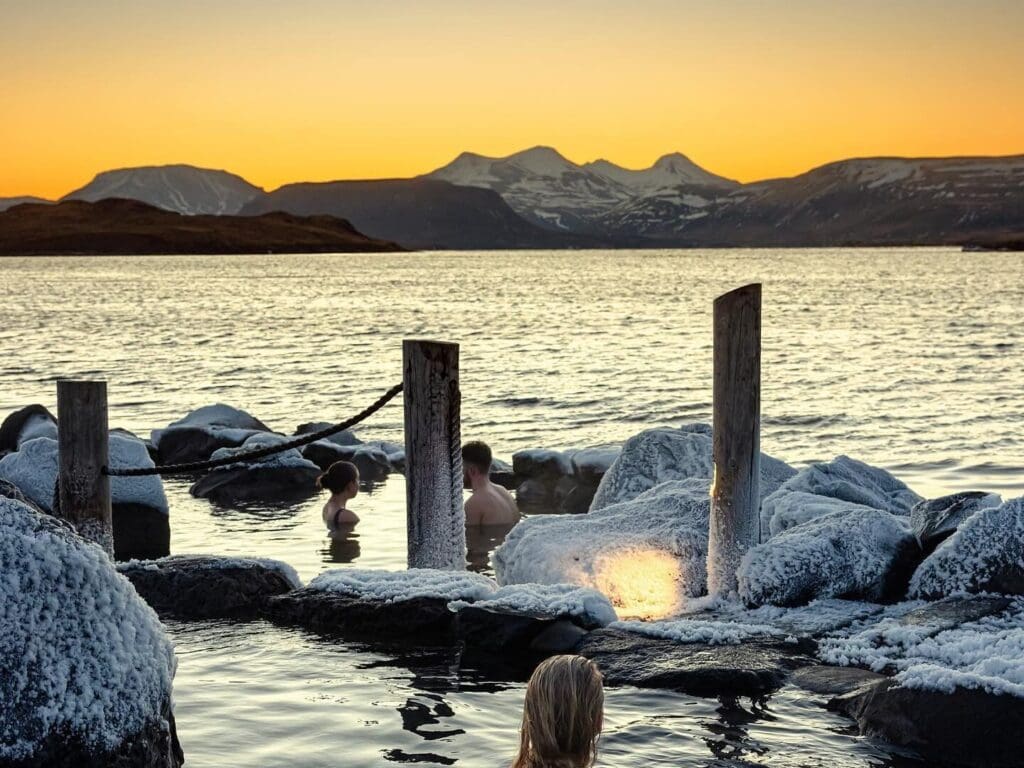
Best season: Summer
The midnight sun is a natural phenomenon when the sun never drops below the horizon, providing light throughout the night. It’s a beautiful time to be outdoors exploring the highlands on a private super jeep or watching puffin colonies nesting on seaside cliffs.
Sunlit nights only occur during the summer months. To experience them, May, June and July are when to visit Iceland.
4. Outdoor adventures
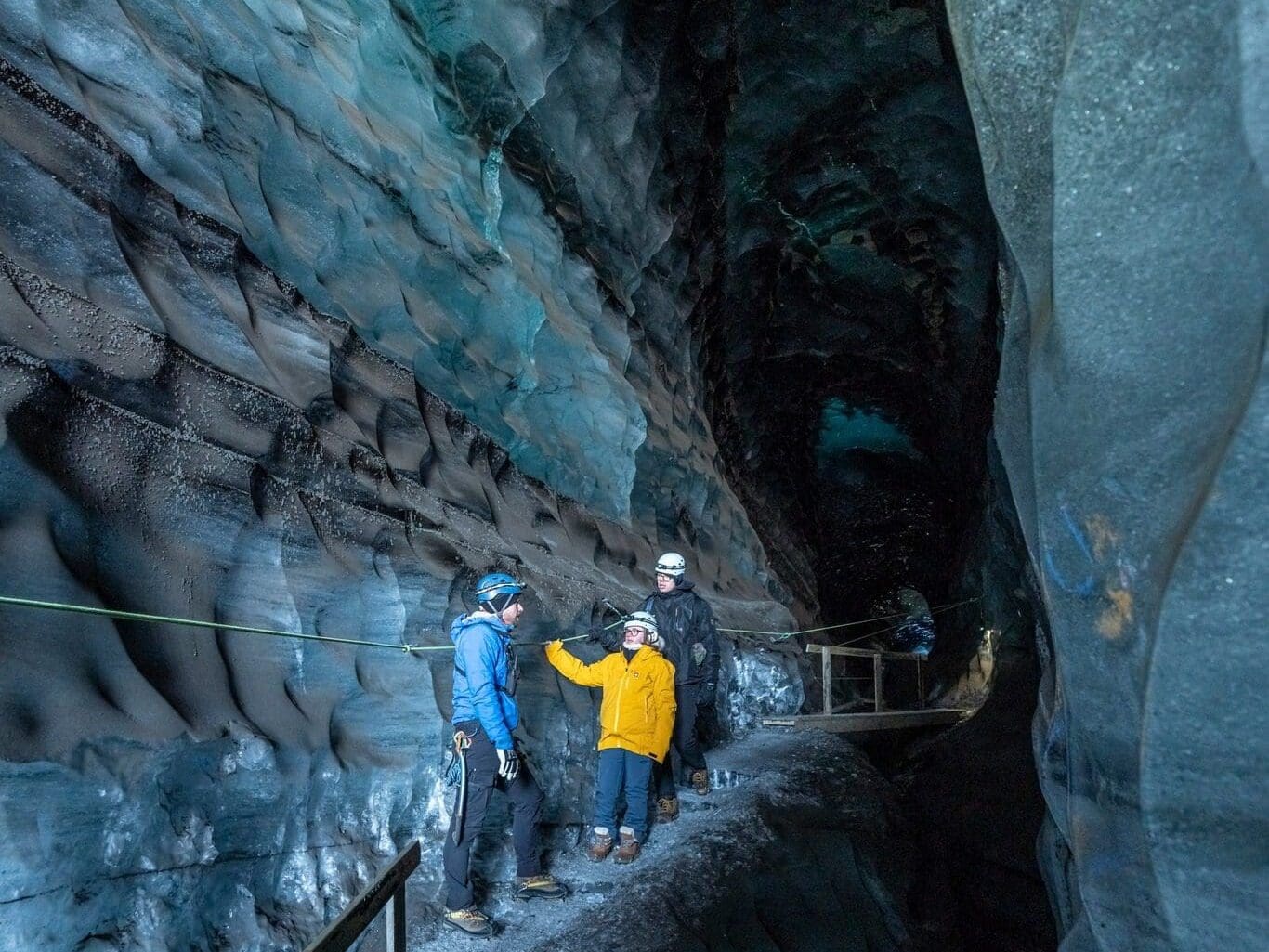
Best season: All year round
Iceland is most famous for its breathtaking natural beauty. In few other places on the planet do glaciers stretch from the peaks of volcanoes down to the sea. And with eruptions every year or two, it’s a country that’s still being formed.
To explore these dramatic landscapes, there are no “best” months to visit Iceland. Instead, every season offers something special. In winter, visitors can venture into crystal-blue ice caves, shaped by the movement of glaciers. Meanwhile, travelers who visit Iceland in the summer can uncover hidden gems, like secluded hot springs.
Thrill seekers will find Iceland has adventures for every season. For example, private horseback riding, helicopter tours, or all-terrain vehicle expeditions are offered throughout the year.
5. Culture and festivals
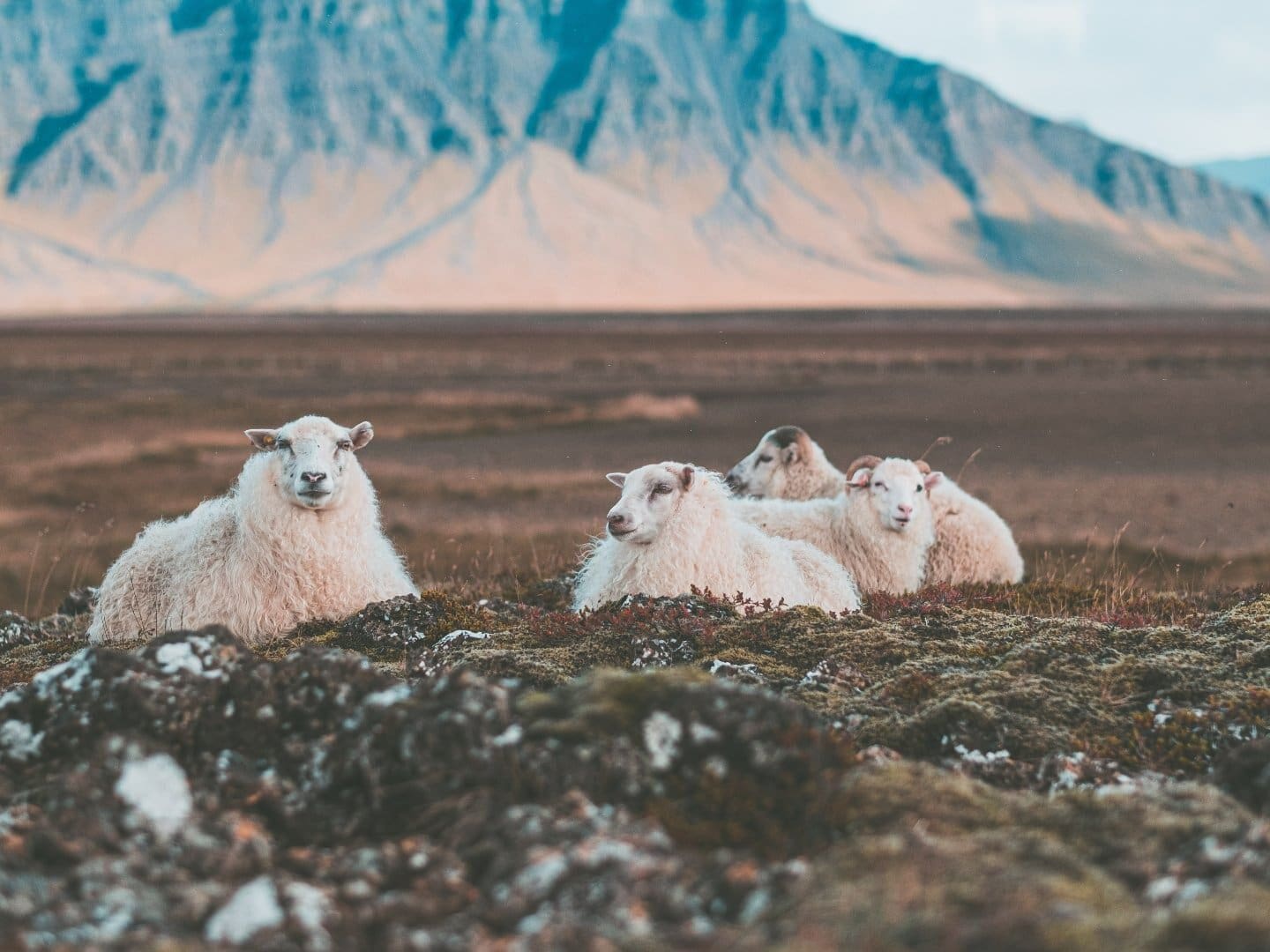
Best season: Fall
Iceland’s extraordinary culture can be experienced at all times of year. But if there’s one season when it’s at its best, it might be fall.
Reykjavík, for instance, comes alive with a series of festivals. Iceland Airwaves, in early November, is probably the most famous, when venues across the capital host international and local musical acts. Before that, September boasts the renowned Reykjavík Jazz Festival, and October brings the Reykjavík International Film Festival.
Many festivals can also be found outside the city. In the countryside, visitors can experience Réttir, the annual rounding up of sheep. It’s an authentic insight into Iceland’s rural culture.
- Learn about Reykjavík's Pride festival in this LGBTQ+ guide to Iceland .
Discover the best of Iceland with Nine Worlds
Iceland is an extraordinary destination in any season. To plan an unforgettable trip, choose the time of year that suits your desired itinerary.
No matter when you time your visit, Nine Worlds can help. As a luxury destination management company with Icelandic roots, we are experts in crafting authentic, experience-driven tours to the Land of Fire and Ice. Every journey we create is completely tailored to our guests’ travel goals and unique preferences.
Contact us to find out more about the experiences we offer, and we will help you plan the perfect trip.
Contact our luxury travel designers
Call us, email us, or complete our enquiry form to start planning the perfect trip.
Icelandic roots
Authentic trips designed by local destination experts
Tailor-made tours
Bespoke itineraries, uniquely tailored for our clients
Commitment to excellence
Hand-picked local guides & first-class accommodation
Trusted & reliable
Personalized service, concierge assistance & 24/7 helpline
Discover what’s new before everyone else:
Get our free on-the-go Nordic hotspot map!
The Nordic Nomad
Regions & islands
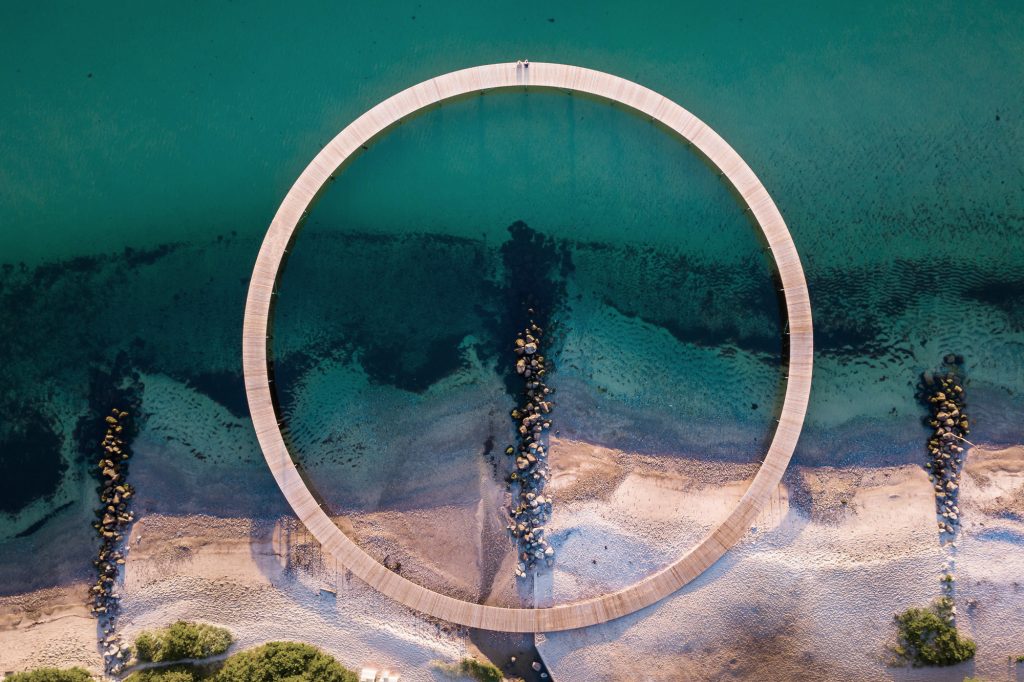
Cities & towns
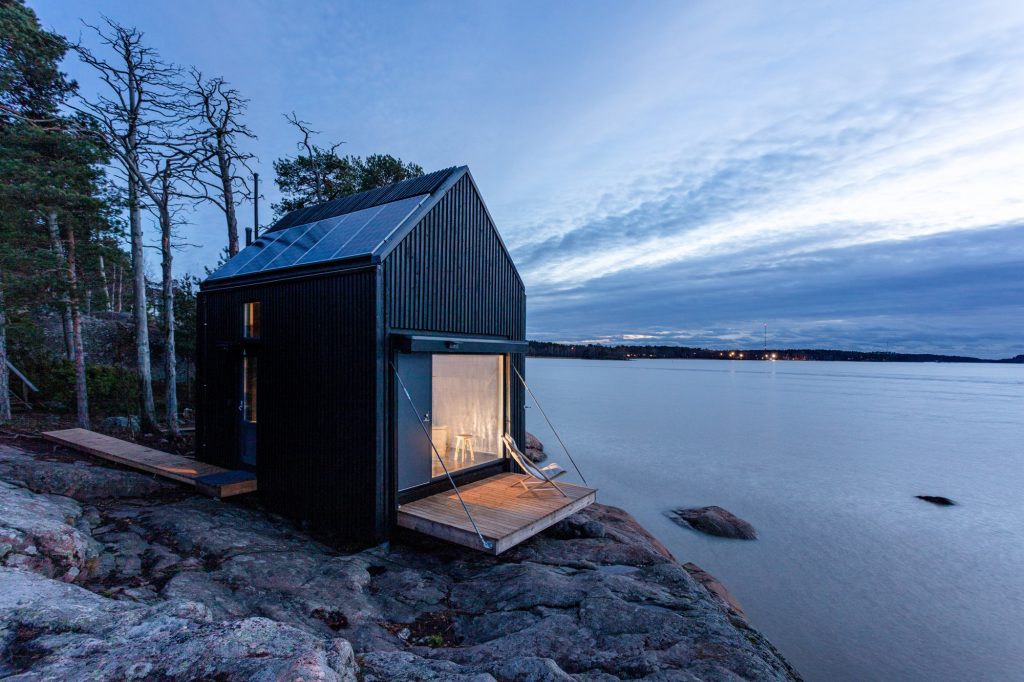
The in-depth guide to choosing the best time to visit Iceland
The Nordics • Nordic lifestyle • The in-depth guide to choosing the best time to visit Iceland
How to determine the best time to visit Iceland

What is the best time to visit Iceland?
Wondering when’s the ideal time to explore Iceland? From our adventures and the tales we’ve gathered, there’s no one-size-fits-all answer. Iceland is enchanting year-round, but your perfect season depends on what experiences you’re chasing.
Summer brings those endless days we’ve all heard about, with the sun barely setting. It’s a dream for explorers; we have trekked through the Highlands bathed in 24-hour daylight, feeling like the day just doesn’t end. It’s prime time for hiking, wildlife watching and soaking in the vibrant life of Icelandic towns and countryside.
However, autumn and spring offer their own charm. We have witnessed Iceland draped in the golden hues of autumn and spring’s fresh bloom – both are breathtaking. These seasons boast fewer visitors, making it easier to enjoy Iceland’s stunning landscapes at a more relaxed pace. The temperate weather is perfect for those who prefer milder adventures.
Winter, on the other hand, transforms the island into a snowy paradise, ideal for those magical Northern Lights we have all dreamt of seeing. Though the days are short, they’re incredibly sweet, with snow-covered landscapes and cosy nights. We’ve marvelled at the Northern Lights – the aurora borealis – dancing across the sky, a truly unforgettable experience. Make this a must-experience on your bucket list.
So, when’s the best time to visit Iceland? It hinges on your preferences. Let’s explore the options be delving into what each season has to offer.

What can I expect from Iceland in spring?
When you think about visiting Iceland in spring, you’re essentially signing up for a front-row seat to nature’s grand reopening act. This period, stretching from April to June is a whole experience filled with burgeoning life and longer days, tempered by the lingering kiss of winter’s chill.
Weather and temperatures
The spring season introduces a milder climate, with our thermometers often reading between 0°C to 10°C (32°F to 50°F). Although the tail end of winter might surprise us with a snow shower in April, by the time June arrives, we’re greeted with longer, sunnier days. This unpredictable weather underscores the importance of packing layers, a tip we always share with fellow travellers.
Exploring the regions
Our ventures into the Golden Circle during spring reveal a quieter, yet equally majestic side of Þingvellir National Park, Geysir Geothermal Area and Gullfoss Waterfall. The reduced crowds afford us more space to fully immerse in the beauty and grandeur of these sites. The South Coast, too, becomes a beacon for us nature lovers, with accessible attractions like the striking black sand beaches of Vik and the serene Jökulsárlón Glacier Lagoon, where the sight of drifting icebergs is simply mesmerising.
In spring, we also find the trails beckoning us for more adventures. The paths in Þórsmörk, accessible a bit later in the season, offer breathtaking views that we can’t help but recommend to anyone seeking to connect with Iceland’s wild side. Additionally, the return of puffins to the cliffs is a spectacle we eagerly anticipate each year. These charming birds add a vibrant touch to the cliffs, making spring an ideal season for bird watching.
Seasonal highlights
The power of Iceland’s waterfalls in spring cannot be overstated. Fed by the melting snow, waterfalls like Seljalandsfoss and Skógafoss swell, their roar and might a testament to nature’s force. Our journeys here are always humbling, reminding us of the raw beauty Iceland holds. For those of us keen on ornithology, spring’s the season when bird life flourishes, offering unique opportunities to observe Iceland’s avian residents up close.
Spring in Iceland not only invites exploration through its transitioning landscapes but also offers a variety of activities that make the most of the unique climate and natural beauty of this season. Beyond the hikes and wildlife watching, spring is the perfect time for road trips around the island, where the roads are less burdened by winter’s snow, allowing for smoother travel to distant attractions. It’s an opportunity to dive into the geothermal pools scattered across the country, which seem even more inviting against the cooler air.
Iceland spring pros and cons

What can I expect from Iceland in summer?
Summer in Iceland, spanning from June to August, is a chapter of endless daylight and nature in full bloom, offering an unparalleled experience for those who venture to this island nation. Based on our adventures and the shared experiences within our community, here’s what summer in Iceland has in store.
The summer months welcome warmer temperatures, typically ranging from 10°C to 15°C (50°F to 59°F), occasionally reaching up to 20°C (68°F) or more on the warmest days. This season bathes the island in nearly 24 hours of daylight, especially around the summer solstice in June, creating the extraordinary phenomenon of the Midnight Sun. This extended daylight allows us, and indeed all visitors, to maximise our explorations and adventures across the island.
Summer is the prime time to delve into all corners of Iceland, with every region accessible to explore. We often recommend the Westfjords for those seeking untouched wilderness; here, the dramatic landscapes and bird cliffs, such as Látrabjarg, are in their most glorious state. The Highlands also become reachable, offering hiking trails through otherworldly landscapes that are inaccessible at other times of the year.
Our journeys have taken us along the Ring Road encircling the island, where each stop presents a new marvel, from cascading waterfalls and geothermal springs to picturesque villages. The long days mean you can wander through the lava fields of Landmannalaugar or the serene beauty of the Eastfjords well into the evening.
One of the most magical aspects of summer in Iceland is the opportunity to experience its vibrant wildlife. Whale watching becomes particularly rewarding, with tours departing from Husavik or Reykjavik offering chances to see these majestic creatures in their natural habitat. The puffins, too, are a sight to behold, particularly in the Westman Islands, where they nest in large colonies.
Festivals and cultural events pepper the summer calendar, from the Secret Solstice music festival in Reykjavik to traditional celebrations in small towns and villages. These events offer a glimpse into the rich tapestry of Icelandic culture, something we always encourage visitors to immerse themselves in.
The endless daylight of summer encourages all forms of outdoor activities. Whether it’s hiking, kayaking, glacier tours, or simply enjoying the natural hot springs scattered across the country, the opportunities are as endless as the daylight. For us, one of the greatest pleasures of summer in Iceland is the chance to connect with nature on such an intimate level, from the quiet of early morning walks to the stillness of nightless nights.
Read the full article on summers in Iceland .
Iceland summer pros and cons

What can I expect from Iceland in autumn?
Autumn in Iceland, from September to November, is a season of transformation, where the landscape bursts into spectacular shades of red, orange and yellow. Our collective experiences have shown us that this period offers a quieter, yet equally captivating, alternative to the bustling summer months.
As autumn progresses, the temperature starts to cool, ranging from about 5°C to 10°C (41°F to 50°F) in September and dropping to around 0°C to 5°C (32°F to 41°F) by November. This season sees a mix of crisp, clear days and the return of darker evenings, setting the stage for the Northern Lights’ return. We always remind travellers to dress in layers, as the weather can shift quickly, and to be prepared for both rain and the occasional snowfall as winter approaches.
Autumn is an excellent time for us to explore the less-trodden paths. The countryside, adorned in autumnal hues, offers breathtaking scenery, making it a perfect time for photographers and nature enthusiasts. The Ring Road remains a popular route, with fewer tourists and more opportunities to enjoy the sights at a leisurely pace.
The Snæfellsnes Peninsula, with its dramatic coastline and the iconic Snæfellsjökull glacier, becomes a place of stark beauty under the autumn sky. Meanwhile, the Eastfjords, less visited than other parts of the country, offer tranquillity alongside spectacular fjord landscapes.
Autumn marks the beginning of the Northern Lights season, a phenomenon we eagerly anticipate each year. The darker nights provide a canvas for this celestial dance, with viewing opportunities increasing as the season deepens.
This season is also rich in cultural experiences, with various harvest festivals and events that allow us to delve deeper into Icelandic traditions. It’s a time when the country celebrates its bounty, and we often join in the festivities, from apple picking in the North to enjoying the new season’s first catch in coastal towns.
Hiking remains a popular activity in early autumn, with trails in the national parks offering stunning vistas of the changing foliage. It’s also an ideal time for hot spring visits; soaking in a geothermal pool surrounded by autumn’s palette is an experience unlike any other.
Whale watching continues into the early part of the season, and sea kayaking among the fjords offers a unique perspective on the country’s rugged coastline. For those of us drawn to the night sky, chasing the Northern Lights becomes a captivating pursuit, with various tours and spots around the country known for their optimal viewing conditions.
Iceland autumn pros and cons

What can I expect from Iceland in winter?
Winter in Iceland, spanning from December to February, immerses the island in a magical stillness and offers a distinct kind of beauty that draws adventurers and dreamers alike. Through our travels, we’ve uncovered the serene allure and vibrant culture that define Icelandic winters.
Winter brings colder days with temperatures often hovering between -5°C to 3°C (23°F to 37°F). While it’s the darkest season, with short days and long nights, this creates the perfect backdrop for one of Iceland’s most magnificent natural phenomena – the Northern Lights. Packing warm and waterproof clothing is essential, as the weather can be unpredictable, ranging from clear, crisp days to snowy conditions.
The allure of Iceland’s winter landscape is undeniable. Reykjavik becomes a cosy haven, its streets lined with twinkling lights, offering warmth and cheer. Outside the city, the snow-covered landscapes, frozen waterfalls and ice caves offer a surreal beauty that is uniquely accessible during these colder months.
The South Coast’s waterfalls, like Skógafoss and Seljalandsfoss, take on a mystical appearance, partially frozen and framed by snow. Venturing into the ice caves beneath Vatnajökull, Europe’s largest glacier, becomes a highlight, offering a glimpse into a mesmerizing world of blue ice.
The Northern Lights are, without a doubt, one of the main draws of Icelandic winters. The extended hours of darkness provide ample opportunity to witness the auroras’ dance across the sky, a sight that continues to captivate us year after year.
Winter festivals and cultural events, such as Þorrablót, the mid-winter feast, allow us to engage with Icelandic traditions and cuisine, offering insight into the country’s heritage. New Year’s Eve in Reykjavik, known for its impressive fireworks display, is a celebration we always look forward to, embodying the community spirit and festivity of the Icelandic people.
Winter activities in Iceland are plentiful, from snowmobiling on glaciers to soaking in geothermal hot springs amidst the snow. Dog sledding and horseback riding through the winter landscape offer unique ways to explore the countryside, while skiing and snowboarding are available for those seeking a more adrenaline-fueled experience.
Iceland winter pros and cons

When are the peak and off-peak tourist seasons, and how will they affect my travel experiences?
Navigating through Iceland’s tourist seasons is akin to choosing the perfect moment for an unforgettable adventure. We’ve seen how the island transforms with the ebb and flow of visitors, shaping not just the landscape but our experiences within it.
Peak season
Summer, stretching from June to August, is when Iceland truly comes alive. It’s when we’ve basked in the glory of the Midnight Sun, marvelling at how the landscapes unfold in endless daylight. This is the season of abundance, not just in natural wonders but in the buzz of fellow travellers sharing the trails, the warmth of the locals hosting numerous festivals, and the vibrancy of Icelandic culture in full swing. While we’ve revelled in the energy of crowded sites and the lively atmosphere, we’ve also navigated the challenges of higher prices and the need to book our adventures well in advance.
Off-Peak season
The charm of visiting Iceland in the shoulder seasons – spring (April to May) and autumn (September to October) – lies in the more intimate experience of its majesty. We’ve found these months to bring a quieter beauty, with fewer tourists and more moments of serenity amidst the shifting landscapes. It’s a time when we connect more deeply with the locals and enjoy the natural beauty at a more leisurely pace, often benefiting from lower travel costs.
Winter, from November to March, holds a special place in our hearts. It’s a season that cloaks the island in a quieter, reflective mood, perfect for those of us chasing the ethereal Northern Lights or simply looking to immerse in Iceland’s winter wonderland. The shorter days and cooler nights bring their own kind of magic, one that we have embraced with warm layers and open hearts, finding joy in the festive lights and the snow-draped tranquillity.
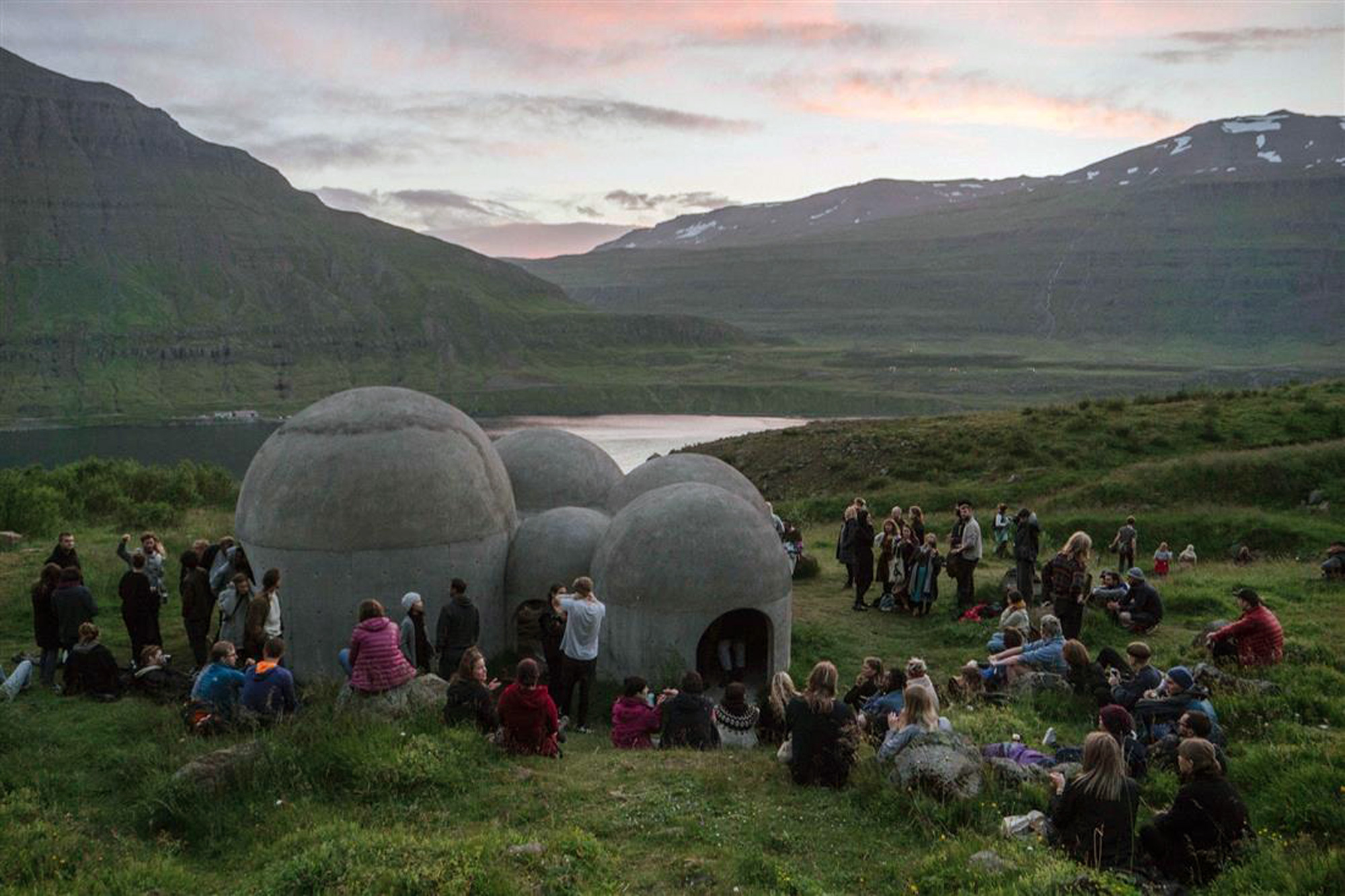
What are the best times for specific activities and festivities?
Diving into Iceland’s calendar year, we’ve discovered that each season brings its own set of activities and festivities. Whether you’re an adrenaline junkie, a nature lover or a culture enthusiast, knowing when to catch these experiences at their peak can elevate your Icelandic adventure.
In the spring, we’ve eagerly joined the locals in welcoming the return of longer days at the First Day of Summer celebration in April, a tradition rooted deep in Old Norse culture, marking the beginning of the brighter half of the year. This period is also prime for whale watching as migratory paths bring these majestic creatures closer to Iceland’s shores, particularly around the Snæfellsnes Peninsula and the North.
Summer in Iceland is synonymous with festivals that celebrate the sun that never sets. We’ve danced under the sky at the Secret Solstice Festival, an unforgettable experience that aligns with the summer solstice. The National Day on June 17th, commemorating Iceland’s independence, fills the streets with parades, concerts and family activities, showcasing a proud nation in full festive spirit.
As autumn paints the island in vibrant colours, we’ve found ourselves amidst the magic of the Reykjavík International Film Festival. It’s a time when the art scene flourishes, inviting cinephiles and creators into intimate venues for screenings of international and local films. The onset of the darker nights also marks the beginning of the Northern Lights season, turning the sky into a canvas of ethereal beauty best observed from late September onwards.
Winter brings its own charm with Christmas markets popping up in towns and cities, enveloping the cold air with the warmth of holiday spirit, twinkling lights and the scent of traditional treats. But it’s the New Year’s Eve celebrations that truly capture the essence of Icelandic winter. With community bonfires creating beacons of light and fellowship across the island and a fireworks display that rivals any around the world, it’s a welcoming of the new year that stays with you forever.

What are the recommendations if I seek to avoid crowds while still enjoying Iceland’s beauty?
Seeking the serene beauty of Iceland without the hustle of crowds is an art we’ve honed over our travels. Here are some recommendations that have allowed us to enjoy the tranquillity of this majestic land, away from the busier paths.
Exploring the less-travelled Westfjords offers a retreat into some of Iceland’s most remote and stunning landscapes. Here, the cliffs, waterfalls and fjords stand in quiet majesty, often with no other soul in sight. The roads are more challenging, but the rewards are unparalleled in peace and beauty.
Early morning or late evening excursions to popular sites like the Golden Circle can also bypass the peak visitor times, allowing for a more personal experience with these wonders. The soft light of these hours adds a magical touch to the already breathtaking scenery.
Visiting during the shoulder seasons of late spring and early autumn presents a sweet spot. The rush of summer tourists has either not yet arrived or has left and many of Iceland’s attractions retain their allure with the added bonus of quieter surroundings.
Seeking out hidden gems that are off the usual tourist radar can lead to some of the most rewarding experiences. Places like the Hvalfjörður fjord, the Berserkjahraun lava fields or the charming town of Seyðisfjörður offer beauty and solitude in equal measure.
Finally, engaging with local guides and tours that specialize in off-the-beaten-path adventures can uncover secret spots unknown to most visitors. These experiences not only support local businesses but also offer insights into Iceland’s culture and nature that can’t be found in guidebooks.

What are the best months for specific wildlife sightings?
For wildlife enthusiasts, Iceland presents an array of opportunities to observe unique species in their natural habitats, each peaking in visibility at different times of the year.
Whale watching
The summer months from May to September are prime for whale watching, especially in Husavik, often dubbed the whale watching capital of Iceland. During this period, the calmer waters and warmer weather enhance the likelihood of spotting various whale species, including the humpback, minke and even the massive blue whales. Whale sightings are more frequent in June, July and August, aligning with their migration patterns to feed in the nutrient-rich Icelandic waters.
These charming birds are a must-see, with their breeding season spanning from April to August. Notable locations for puffin spotting include the Westman Islands, home to Europe’s largest puffin colony and Látrabjarg cliffs in West Iceland. These areas allow for relatively close observation of puffins in their natural setting, especially during June to August when they are most active on land.
The Vatnsnes Peninsula in North Iceland is notable for seal watching, with the best chances of seeing grey and harbour seals along the coast. Summer offers the most reliable opportunities for seal sightings, complemented by informative exhibits at the Icelandic Seal Center, which provides insights into their habits and the best spots for observation.
For those interested in observing Iceland’s only native land mammal, the reindeer, East Iceland is the place to be. These majestic creatures are more commonly sighted around Snæfell and the East Fjords, where they migrate seasonally. While they roam the highlands during summer, they move to the warmer lowlands in winter, making them a unique sight against Iceland’s diverse landscapes.
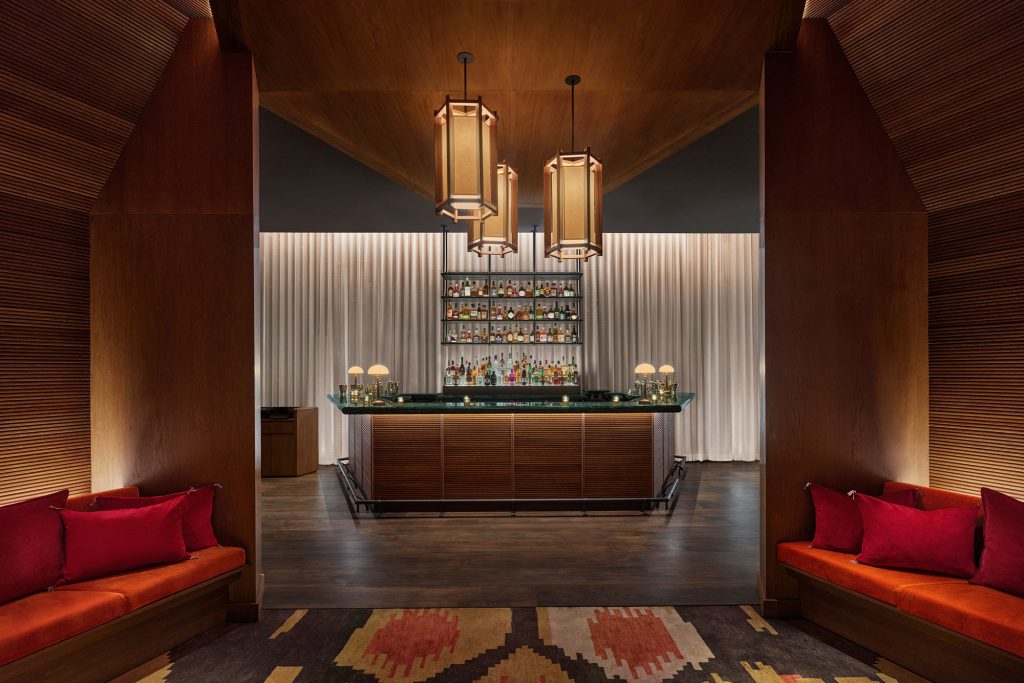
The 10 best boutique and luxury hotels in Reykjavík, Iceland

Suðurland’s stays: the 8 best hotels along Iceland’s south coast

- New openings , Stay
The 2023 hot list: the 10 best new hotels in Scandinavia and the Nordics

Highland Base in Selfoss, Iceland
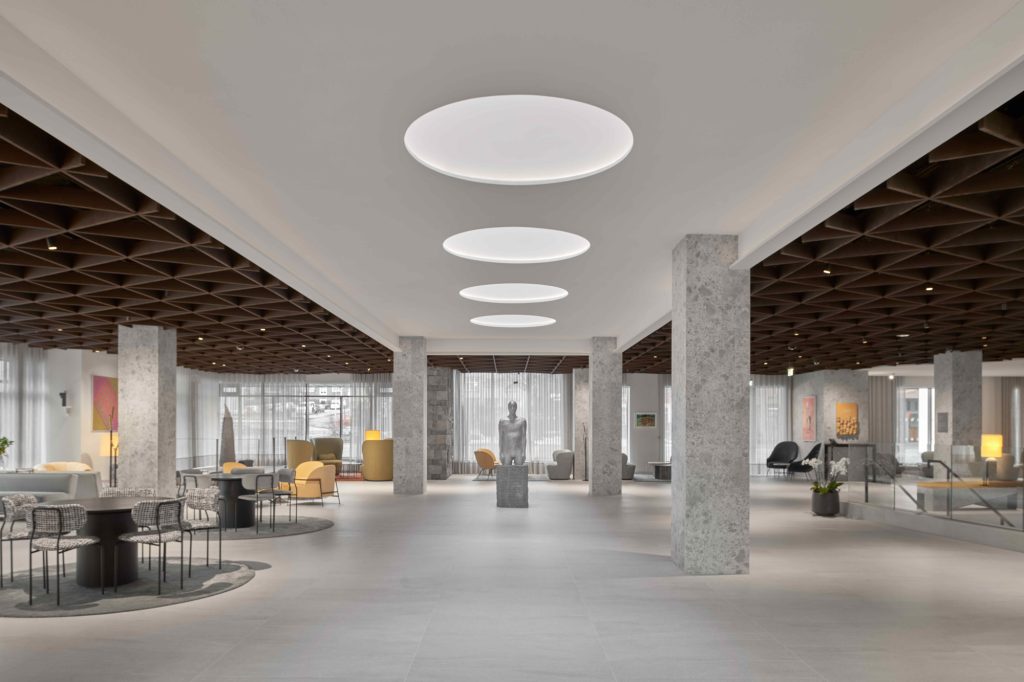
Iceland Parliament Hotel in Reykjavík, Iceland

Iceland’s most remarkable off-grid stays in nature

The Retreat at Blue Lagoon in Grindavík, Iceland

Ion City Hotel in Reykjavík, Iceland

The Reykjavík Edition in Reykjavík, Iceland

101 Hotel in Reykjavík, Iceland
Stay in the know.
Sign up for the latest hotspot news from the Nordics.
The Gatehouse at Kåseholms Slott in Tomelilla, Sweden
Before you rent: the must-read car rental guide for the nordics.

Cabincore: the top 14 remote cottages and cabins in Norway

The 5 best boutique and luxury hotels in Gothenburg, Sweden

Café Svenskt Tenn in Stockholm, Sweden

Riche Fenix in Stockholm, Sweden

All the Michelin star restaurants in Stockholm – 2021 edition
48 hours in malmö, sweden, 48 hours in copenhagen, denmark, 48 hours in stockholm, sweden, stay in the know: sign up for the latest hotspot news from the nordics.

Privacy policy
Privacy overview, get our free on-the-go nordic hotspot map.
Weather & Climate
Top Places to Visit in Iceland
Keflavik International Airport Guide
Driving in Iceland
Tipping in Iceland
Staying Safe in Iceland
Helpful Words and Phrases
Best Tours in Iceland
Top Northern Lights Tours
Seven-Day Iceland Itinerary
48 Hours in Reykjavik
Day Trips From Reykjavik
Top Things to Do in Iceland
Best Beaches in Iceland
Hiking in Iceland
How to See the Northern Lights
Best Icelandic Hot Springs
Skiing in Iceland
Top Things to Do in Reykjavik
Free Things to Do in Reykjavik
Reykjavik's Best Museums
Shopping in Reykjavik
Guide to the Blue Lagoon
Food to Try in Iceland
Best Restaurants in Reykjavik
Top Reykjavik Bars
Craft Beer in Iceland
Best Time to Visit
The Best Time to Visit Iceland
While there are many unique travel opportunities , various adventures, and great events year-round in Iceland, the best time to visit Iceland is in June when the weather starts to warm up and the country experiences 24 hours of sunlight.
However, if you're planning your first trip to Iceland , the best time of year to explore this Nordic island nation really depends on what you're looking for—whether you prefer warmer weather and outdoor events or you don't mind a little bit of cold for a great nightlife scene. When it comes to deciding what time is right for your trip, you should consider when to expect the biggest and smallest crowds, warmest or coldest weather, and highest or lowest costs for airfare and accommodations.
Peak Season in Iceland
Undoubtedly, July through the early August is the busiest time of year for Iceland's tourism industry, but crowd sizes and travel prices start going up in May and June and don't really start going down until September. If you're looking to avoid lots of tourists and to save money on your trip while still being able to access popular attractions, you might consider visiting in the shoulder season, which happens from early April to mid-June and mid-September to early November each year.
The dead of winter, which runs from early December through mid-March, is the official off-season for Iceland, but a boom in year-round tourism since 2008 has resulted in prices for airfare and accommodations stabilizing over the years as more travelers have discovered the joys of this Nordic country's coldest season. However, you can still find great prices on last-minute airfare and even some special travel deals from the United States this time of year.
Weather in Iceland
Don't let the name Iceland fool you: The winters here aren't particularly bad; temperatures average 32 degrees Fahrenheit in the lowlands and 14 degrees Fahrenheit in the highlands for most of the season. However, temperatures can dip down to 22 degrees below zero in the northern part of the country, so you'll want to avoid that area if you visit during the winter. June is the country's driest month of the year, while July is the warmest month of summer, with an average temperature of a pleasant 60 degrees Fahrenheit, and the weather in Iceland usually stays mild until late August.
When to See Natural Phenomena in Iceland
Known as a country of mystical landscapes and breathtaking vistas, one of the main reasons people visit Iceland is to enjoy its natural phenomena, including the Aurora Borealis (Northern Lights), the Midnight Sun, and the Polar Nights.
While nearby Norway may be home to the best places to see the Northern Lights , there are plenty of great spots in northern Iceland to catch a glimpse if you visit from mid-October through March, a period known as the Polar Nights when the country experiences up to 19 hours of darkness a day. However, if you're a creature of the sun, you may prefer to travel in the summer instead when the Midnight Sun results in over 20 hours of daylight from June through August.
While some attractions might not yet be open in March or April, which is the best time to see the snow giving way to lush greenery and wildlife, you're sure to find plenty worthy of exploring. Spring is particularly great for visiting unique destinations like the many remote hot springs spread across the country as their access roads are buried under snow all winter.
Events to Check Out
- Puffins arrive on the island each year in April.
- National Beer Day is held each year on March 1, celebrating the end of Iceland's prohibition. There are several craft beers now available. Pubs and restaurants throughout the country celebrate.
Summer in Iceland is one of the best times to visit because the weather is pleasant and the sun barely sets. If you'd prefer longer days to explore the outdoors and hike the defrosted fjords, you'll love that there are about 20 hours of daylight (on average) each month of this season. Along with seasonal events—including outdoor concerts and festivals celebrating art, culture, and music—Iceland provides ample opportunity during the summer to explore the highlands and thawed fjords, swim in crystal-clear mountain lakes, and hike around the gorgeous island landscape.
The drawback to summer, though, is that prices are generally higher across the board—on food, accommodations, attractions, rentals, and airfare. Additionally, lines are longer, hotels fill up, and restaurants run out of room on their reservation lists as tourists flock to the most popular spots during the long daylight hours of Iceland's summer.
- The Viking Festival takes place in June in Hafnarfjörður. It's the oldest festival of its kind in the country.
- June 17 is Icelandic National Day, a celebration of the young country's independence.
If you visit in September through mid-October, you'll have an even better opportunity to enjoy the hot springs since there will be fewer crowds and you won't have to rely on snow melting to access these remote destinations. Additionally, some of the best opportunities to see the Northern Lights are on clear autumn nights in late October through early December, before winter weather settles in and blocks the view with thick clouds.
- The annual Iceland Airwaves music festival takes place in Reykjavik in November and showcases new music from around the world.
- One of Iceland's oldest traditions is réttir, an annual island-wide sheep round-up that take place during September.
Summer has the benefit of long days but come winter, daylight shrinks to about five hours in a period called the Polar Nights . If you can endure little sunlight, the question of when to visit Iceland suddenly becomes much harder because Iceland also has many bolder things to offer in winter: never-ending nightlife in Reykjavik , infinite chances to view the Northern Lights , and plenty of outdoor snow activities such as skiing, snowboarding, and snowmobiling.
The colder part of the year is also when flight prices to Iceland fall drastically and local hotels suddenly cut prices by more than half. Budget travelers wondering when to go to Iceland should aim for February or March because those months have more daylight than the earlier winter months but still the smallest crowds and the lowest prices.
- Winter means Christmas markets, which are abundant throughout Iceland. One of the best is Heiðmörk Christmas Market, about a 20-minute drive from Reykjavík.
The best time to visit Iceland depends on what you're looking for, but June is one of the best months for visiting. It's before the peak tourist season begins and the midnight sun phenomenon is incredible to experience.
The off-season is the cold winter months, especially from November to April. Prices go up in the weeks around the holidays, but outside of those dates it's the cheapest time to visit Iceland.
The peak season in Iceland is July and August when the days are at their warmest. Prices start going up in May and June, but you'll still find cheaper rates than you will in the late summer.
Guide to Iceland. "Weather in Iceland & Best Time To Visit." Retrieved February 10, 2021.
Weather in Iceland: Climate, Seasons, and Average Monthly Temperature
Scandinavia and the Nordic Region: Planning Your Trip
January in Iceland: Weather, What to Pack, and What to See
April in Iceland: Weather, What to Pack, and What to See
The Best Free Things in Reykjavik, Iceland
March in Iceland: Weather, What to Pack, and What to See
The 10 Best Things to Do in Iceland During the Winter
The Best Time to Cruise Alaska
The Best Time to Visit the Bahamas
The Best Time to Visit the Dominican Republic
February in Iceland: Weather, What to Pack, and What to See
The Best Time to Visit Boston
Your Trip to Iceland: The Complete Guide
The Best Time to Visit Morocco
The Best Time to Visit Spain
The Arctic Circle
- Best time to visit Iceland
Book your individual trip , stress-free with local travel experts
Select Month
- roughguides.com
- Travel guide
- Itineraries
- Local Experts
- Travel Advice
- Accommodation
Plan your tailor-made trip with a local expert
Book securely with money-back guarantee
Travel stress-free with local assistance and 24/7 support
Carson (United States)
I must tell you that my tour with you is probably THE best tour I've ever taken (and I've taken a lot). My guide Rico set a bar so high that I don’t know i...
Whilst Iceland has no trouble giving travellers a reason to visit all year round, the seasons vary hugely, due to how north the country sits. Iceland's geographical position not only affects the weather but also the hours of daylight you can expect to have. These, alongside the best times to see the Aurora Borealis, or Northern Lights , are crucial factors in deciding the best time to visit Iceland.
What is the best time to visit Iceland?
What are the travel seasons in iceland, best time to visit iceland month by month, best time to see the northern light in iceland, planning for your iceland road trip, best time to visit iceland: events and festivals, travel ideas for iceland, created by local experts.

Iceland's Highlights from East to West
Take a flight to the East where you get to enjoy the enchanting Eastfjords before you drive south. If you are looking to focus on a few regions with a mix of the most popular sights and something off the beaten path; and to avoid backtracking with a one-way domestic flight, this is the perfect trip.

Discover North Iceland and Snaefellses
Discover the best of North Iceland and Snaefellsnes! The area around the volcanic Lake Myvatn is surrounded by impressive geological sights, stunning waterfalls and mighty canyons! The Snaefellsnes peninsula is known as “miniature Iceland” for the diversity of landscape it offers.

Best of the West
Take the road less travelled around the Westfjords and Snaefellsnes peninsulas. Visit places unspoiled by humans and see the wonders and creativity of nature at their very best! The wild Westfjords feature a stunning landscape of towering mountains, deep blue fjords, and thundering waterfalls.

East to West with the Westmand Islands
Drive around the Lake Lagarfljot and visit Hengifoss waterfall and the Hallormsstadur forest. Continue to the South Coast with its beautiful waterfalls, glacier lagoons and black sand beaches. Take a detour to spend a day in the stunning Westman Islands and end your trip with the Golden Circle.

All of Iceland in 13 days
In just under 2 weeks, explore the highlights Iceland has to offer. From the popular Golden Circle, follow the Ring Road and explore waterfalls and lagoons on your way around the island. This itinerary leads you all the way to the North and the Westfjords of Iceland.

Incredible Iceland in 12 days
This driving trip trip will take you to some of Iceland’s most incredible sights and natural wonders. Drive through glacial valleys and across towering mountains as you gaze over stark landscapes of shining silver steaks and marble lava fields patched with emerald green moss...
The best time to visit Iceland varies greatly depending on the activities and experiences you are seeking. For outdoor recreation, the months of June to September are ideal, offering mild weather and extended daylight hours, perfect for exploring Iceland's unique landscapes. For those eager to witness the mesmerizing Northern Lights, the darkest months of December to January are the most suitable. For snow sports enthusiasts, February to March is the prime time, with Iceland's winter landscapes providing perfect conditions for skiing and snowboarding. Lastly, if you prefer off-peak travel to avoid crowds and potentially lower costs, April to May is an excellent choice, offering a quieter yet equally beautiful experience of Iceland.
Want more tips? Read our content manager's personal experience travelling in Iceland and find out the important aspects you're likely to encounter on your trip.
Best times to visit Iceland for good weather
The ideal time for favorable weather in Iceland is the summer season, extending from late June to September. Temperatures during this time range from 12°C-20°C, and the sunny setting in Reykjavik is a delight to experience. The vibrant purple lupines flourish over the meadows, making it an ideal time for hiking and exploring the natural beauty of Iceland.
Best times to visit Iceland with fewer crowds
Planning a trip to Iceland during the shoulder seasons of March, April, May, and September can help you avoid the tourist rush. During these transitional months between the peak and off-peak seasons, you can enjoy relatively good weather with fewer crowds. The sights and sounds of the glaciers, hot springs, and northern lights can be thoroughly enjoyed without the hordes of tourists.
Worst months to visit Iceland
The worst time to visit Iceland in terms of the weather and outdoor activities predominantly corresponds to the winter months, notably November, December, and January. During this period, the country faces extreme weather conditions featuring heavy snowfall and chilly temperatures. These elements, in conjunction with shorter daylight hours, make outdoor exploration quite challenging for all but the most adventure-loving visitors.
Aiming to beat the crowd? Then it's worth noting that June to August, despite being the best time for outdoor activities, are the months where the popular tourist spots like the Golden Circle, Blue Lagoon , and Jökulsárlón Glacier Lagoon see significant crowd inflow.

Mountain Stapafell in the background at Arnarstapi Village in summer sunny day in Iceland ©Shutterstock
The best time visit Iceland doesn't always depend on the weather, but could be season related too. Let's dive deeper into Iceland seasons.
Iceland peak season
The peak travel season in Iceland spans from June to August. During these months, the country experiences the mildest weather, longest daylight hours, and offers the most activities. The radiant midnight sun is a spectacular sight in June and July. This period sees the highest tourist influx, making it the most vibrant but also the most crowded.
Considered the best time for outdoor activities like hiking and kayaking, it's also perfect for reveling in the rich wildlife of the country. It is particularly great for spotting whales and birds. However, the high footfall of tourists also means spiked prices and crowded destinations. It’s recommended to book accommodations , transportation and trips in advance if you plan to visit during the peak season.
Iceland shoulder season
Shoulder season in Iceland, consisting of May, September, and early October, offers a balanced mix of good weather, reasonable prices, and lesser crowds.
In May, the snow has begun to melt, the nights are filled with stunning sunset hues, and the low-season hotel rates can prove a steal. Attractions, however, are less crowded, and many museums and sites that close during the winter are now reopening. The weather can still be unpredictable, with a breeze and potential snow in the country's interior.
September and early October are glorious months for landscape photographers and aurora borealis chasers. It's an excellent time to witness the extended pink dawns and dusks that paint the Icelandic landscapes, and partake in daytime hiking with nighttime vigils for the Northern Lights. The weather is relatively pleasant for longer periods, making it an engaging time for stargazing.
Iceland low season
Iceland's low season stretches from mid-October to the end of April. The most prevailing challenge during this time is the extreme cold weather, with temperatures often plummeting to -30 degrees Celsius. Add to this the wind chill, and it can feel even colder. Daylight, too, becomes scarce, with December offering only about four hours of light each day.
But winter in Iceland also has its own charm and advantages. One major highlight during the low season is the breathtaking ice caves and glaciers that come into their prime, providing an arresting sight for nature lovers. Additionally, fewer tourists lead to less crowding at popular attractions and in towns.
On the downside, it's difficult to get off the beaten track due to road closures. Many outdoor activities and attractions close down during this period except for those catered to experienced winter adventurers. Despite these limitations, it's worth noting that low season is synonymous with lower travel costs and offers an entirely different perspective on Icelandic landscapes.
Tip from Rough Guides: also learn about the best ways to get to Iceland .

If you're into nature, Iceland is a great destination!
If you don't know what month will be best for you, read on about the best time to visit Iceland month by month.
Visiting Iceland in January
For those seeking tranquility and a magical winter wonderland, January is a fabulous time to visit Iceland. It is one of the quietest times, meaning key attractions are significantly less crowded. The days are short, with the sun rising around 11 am and setting around 4 pm. Even though these short dark days can mean reduced sightseeing time, they also increase your chances of witnessing the mesmerizing Aurora Borealis, or Northern Lights.
The January landscape is covered in crisp white snow, providing a breathtakingly beautiful backdrop for winter activities such as snowmobiling, and ice cave exploration. Furthermore, thermal baths and hot springs offer a respite to the sub-zero temperatures, which can range between -10°C and 0 °C.
Visiting Iceland in February
Visiting Iceland in February allows you to experience the beauty of the country in its winter glory. Temperatures range between -10°C and 8 °C and the days provide more daylight hours than in January, though sunlight continues to hang low, giving Iceland a golden tinge, making for some fantastic photo opportunities.
One of the biggest attractions in February is the high probability of catching the Aurora Borealis, creating vivid displays in the Icelandic night sky. The sight is so captivating that it draws numerous tourists from around the world. Also, weather permitting, you can venture on iceberg, waterfall, or glacier tours outside the city.
Visiting Iceland in March
Visiting Iceland in March offers a unique blend of winter's beauty and the emerging signs of spring. This time of year is ideal for experiencing a mix of snow-covered landscapes and longer daylight hours, allowing for extended sightseeing. It's a fantastic period for winter activities like snowmobiling, glacier tours, and especially for viewing the Northern Lights, as the nights are still dark enough for their vivid display.
March in Iceland also marks the beginning of the whale watching season, providing an opportunity to witness these magnificent creatures in their natural habitat.

Iceland northern lights © Shutterstock
Visiting Iceland in April
April is the harbinger of spring in Iceland and serves as an attractive time to visit. Days grow longer, with approximately 14 hours of sunlight, and the icy landscapes slowly start to thaw. The temperatures can range from 3-6°C, offering a relatively pleasant climate for outdoor activities.
While winter activities are winding down, there still might be some opportunities for snowmobiling or ice cave adventures, especially in the earlier part of the month. You can partake in brisk hiking excursions, taking in the crisp air and magnificent views as the country blossoms into spring. Southern Iceland regions around Skogafoss, Vik, and Jökulsárlón Glacier Lagoon are particularly picturesque during these months.
Looking for more options for your holiday in April? Find the perfect holiday destination with our top suggestions .
Visiting Iceland in May
May is a fabulous time to visit Iceland, marking the transition from the shoulder season to the beginning of summer, with daily daylight hours surpassing fourteen. Temperatures range from 9°C to 12°C, providing an agreeable climate for various activities.
The onset of spring, coupled with lengthening days and the midnight sun, paints the country in vibrant colors. Landscapes become lush, and the blooming wildflowers add a special charm to the scenery.
Wildlife is another highlight of visiting Iceland in May. From whale watching tours to puffin-spotting excursions, wildlife enthusiasts are sure to enjoy their stay. The adorable puffin bird returns to the shores of Iceland starting in mid-April, so sightings are strongly probable in May.
Visiting Iceland in June
June marks the beginning of a spectacular summer season in Iceland when the country experiences the delightful phenomena of the midnight sun, with almost 24 hours of daylight and ample opportunities to explore the great outdoors.
Temperatures typically range from 9°C to 15°C, but the weather remains unpredictable, with bright sunny days often swiftly turning to heavy cloud cover or misty rain, so light layers and waterproof clothing come in handy.
The midnight sun is a sight to behold, it is when the sun is still visible even at midnight, creating a perpetual twilight. This phenomenon leads to some unforgettable memories and excellent photography opportunities.

Skogafoss waterfall, Iceland © Shutterstock
Visiting Iceland in July
July embarks on the height of summer, marking it as one of the warmest and busiest months in Iceland. It punches in 24 hours of daylight, kicking off the enchanting 'Midnight Sun' period. Average temperatures rest between 10°C to 15°C, leading to pleasant, sunny days that make outdoor exploration inviting.
The month is noted for its long, lazy days that stretch till almost midnight, followed by the sun rising again around 4 am. Trails for hiking, including the famous Laugavegur trail and those of the usually inaccessible Highlands, pop open and the eerie late-night light is irresistible especially for photographers.
Whale watching tours are in full swing in Iceland in July, which teams beautifully with snow-free roads for drives and hikes around the country. The 'Midnight Sun' also simplifies long drives along the iconic Route 1 or 'Ring Road,' which wraps around the island with plenty of must-see locations along the way.
Visiting Iceland in August
August is a veritable feast of summer in Iceland, making it a highly recommended time to visit. This month witnesses the country in full swing, with long daylight hours and temperatures generally ranging between 11°C and 15°C, slightly cooler than July but still warm relative to local standards.
Despite the summer rush, Iceland retains its freshness and appeal in August. The lush landscapes, blooming florals, and a voluminous burst of colors paint the most picturesque image of this Nordic land. Icelandic forests take on a remarkably green hue, lakes shimmer under the mild sun, and cascading waterfalls spring to life.
Visiting Iceland in September
September kicks off the autumn season in Iceland and serves up enchanting landscapes awash with oceans of red, brown, and gold—the best time to witness the country's fall foliage. The temperatures range between a comfortable 5°C (41°F) to 9°C (48°F). As the crowd thins out post the peak season rush, tranquil serenity sets in, and the country's beautiful destinations become less crowded.
One of the prime advantages of visiting Iceland in September is the opportunity to catch the Northern Lights. As daylight hours start to reduce, the equinox in mid-to-late September increases solar activity, making the conditions ideal for viewing this natural spectacle.

Hiking the Laugavegur trail is one of the best experiences in Iceland © Shutterstock
Visiting Iceland in October
October can be a magical time to visit Iceland, where the season shift from autumn to winter can be strongly felt. The weather becomes more unpredictable, with temperatures varying between 2°C (35°F) and 7°C (45°F), and the first snowflakes of the season might start to fall, dusting the already vibrant landscapes with a touch of winter's wonder.
While the days start to shrink significantly, the amazing spectacle of the Northern Lights becomes more prominent. This is one of the best times to chase the aurora borealis, with solar activity being high and less light pollution due to shorter days.
Natural wonders become a serene spectacle with pops of falling leaves colored in hues of red, orange, yellow, and brown. October is the last month when you can tour the highlands before the roads close for winter. Therefore, it's a great time to visit Landmannalaugar, Thórsmörk, or other highland attractions.
Looking for more options for an autumn holiday? Also check out our list of the best destinations for an unforgettable holiday in October .
Visiting Iceland in November
Visiting Iceland in November means embracing winter's arrival as temperatures dip between -2°C to 3°C, becoming colder as the month progresses. The days also get significantly shorter, with roughly 6-8 hours of daylight, providing a whole different range of experiences to explore under darker skies.
Arguably the star attraction during this time is the mesmerizing Northern Lights, which make their appearance more reliably as nights get longer. A late-night sweep to chase these mystical lights can turn out to be a highlight of your trip.
Although the weather is chilly, the snowy landscapes and the waterfalls clad in winter dress present another level of beauty. November offers the opportunity for some unique winter activities like glacier hiking and exploring newly formed ice caves. Adventurers can also go snowmobiling on glaciers or try their hand at winter sports.
Visiting Iceland in December
Stepping into Iceland in December is like striding into a fairytale-like winter wonderland. With average temperatures ranging from -1°C to -5°C, this month delivers the country's most intense winter experiences, complete with snowfall, nearly round-the-clock darkness, and an enchanting Christmas atmosphere.
Look beyond the short daylight hours, and you'll find a capital city that's a slice of holiday magic. Reykjavík comes alive in December with Christmas lights illuminating the city, streets adorned with decorations, and 13 jovial Santa Clauses, the Yule Lads, bringing holiday cheer.
Furthermore, New Year's Eve in Iceland is a sight to behold. Locals and tourists alike gather to build bonfires and set off fireworks, making for a memorable experience and a spectacular welcome to the coming year.
For the most accurate live weather updates, you can check Accuweather .

Winder Wonderland at the Reykjadalur Steam Valley © Shutterstock
To witness the Northern Lights at their peak, aim for the winter months between September and April. This period, characterized by long, dark nights, contrasts sharply with the bright summer nights in Iceland, offering optimal conditions for observing this natural phenomenon.
Make sure to read our article about the best places to see the Northern Light in Iceland.
Between September and April
The ideal time to spot the mesmerizing Aurora Borealis or the Northern Lights in Iceland ranges from September to April. The period perfectly coincides with Iceland's darker months, providing ample nighttime hours for this natural light spectacle to shine through.
As sunlight begins to recede in October, the duration of darkness gradually lengthens, bringing increased opportunities to see the Northern Lights. The display grows more pronounced from November to January, albeit with shorter daylight hours and extreme cold weather. However, clear skies during these months contribute to better visibility.
It's important to be aware that Northern Lights sightings are naturally unpredictable, relying on solar activity and sky clarity. Create a flexible itinerary to adapt to cloud cover or solar activity changes.
Tracking weather and solar activity through reliable online resources like the Icelandic Meteorological Office or websites providing Aurora Forecasts can help you gauge the most suitable nights for viewing the lights.
Best places to see the Northern Lights
The magical Northern Lights can be seen across Iceland during winter months, but there are some places that offer particularly stunning views due to minimal light pollution:
- Thingvellir National Park: Being a UNESCO World Heritage site and away from the city lights, this park offers a darker sky, providing an optimal setting for viewing the Northern Lights.
- Jokulsarlon Glacier Lagoon : The floating icebergs on the lagoon add an otherworldly charm to the backdrop of the Northern Lights, resulting in visually stunning scenes.
- Vik : Located south of Reykjavik, the town of Vik, with its black sand beaches, offers a serene and somewhat surreal location to view the Northern Lights, with the dancing lights reflecting off the ocean waves.
- Snaefellsnes Peninsula : Enhanced by its remote location, the peninsula offers an excellent platform for Northern Lights viewing, with the added feature of the famous Kirkjufell mountain as a gorgeous backdrop.
- Grotta Lighthouse, Reykjavik: If you're based in Reykjavik and don't want to venture too far, the area around the Grotta Lighthouse offers one of the best viewpoints in the city. It's still crucial to have a clear and dark night for the best viewing experience.
Remember that viewing the Northern Lights is heavily dependent on the right weather conditions and solar activity. Therefore, keep a close eye on the forecast and be prepared to change your plans accordingly. It's always recommended to join a Northern Lights tour, wherein expert guides can take you to the best locations based on real-time forecasts and conditions.

Northern lights reflected in Jökulsárlón glacier lagoon © Krissanapong Wongsawarng/Shutterstock
Embarking on an Iceland road trip? Our guide helps you navigate this breathtaking landscape, ensuring a memorable journey through Iceland's natural wonders, from volcanic terrains to icy vistas. Let's get your adventure on the road!
Iceland's Ring Road – when you have time
Iceland's Ring Road, also known as Route 1, encircles the entire country, providing the chance to see the best of Iceland's breathtaking landscapes. Spanning 1,322 kilometers or 821 miles, it's an exceptional drive that can be completed year-round, but the best months for travel are between April and October when the weather is generally calmer.
The least duration advised to drive the scenic stretch is one week, but 10-14 days are recommended to immerse fully in the Icelandic landscapes and diverse attractions. This extended travel period provides enough leeway to explore major attractions such as Geysir, Thingvellir National Park, Vatnajökull National Park, Skaftafell National Park , the black sand beaches of Vik, the charming town of Akureyri , Myvatn , and much more.
You can drive in a clockwise or counterclockwise direction, with accommodation options varying from hotels to guesthouses and camping sites along the way.
Pack plenty of food, water, and supplies for your journey, check road and weather conditions regularly, and ensure to fuel up wherever possible, as gas stations can be at a considerable distance apart.
Make sure to check Safetravel.is for the most recent updates.
Short road trips in Iceland
If time-constrained or preferring shorter trips, you'll be glad to know that Iceland boasts several shorter yet utterly mesmerizing road trips. Here a few recommendations:
- The Golden Circle: One of the most popular routes, the Golden Circle, is an easy day trip from Reykjavik. This 300 km loop covers notable sights like Thingvellir National Park, Geysir Geothermal Area, and Gullfoss Waterfall.
- The Blue Diamond Road: This route circles the Reykjanes Peninsula, located near Reykjavik and Keflavík International Airport, making it an easy day trip. This region is home to the famous Blue Lagoon as well as an array of lava fields, geothermal areas, bird cliffs, and beautiful coastline.
- South Coast Drive: A drive along the South Coast up to Jökulsárlón Glacier Lagoon and Diamond Beach offers hulking glaciers, pristine beaches, beautiful waterfalls, and other natural wonders, all within 370 km from Reykjavik.
- The Arctic Coast Way and the Diamond Circle: Both situated in North Iceland, each route presents awe-inspiring landscapes, with the Arctic Coast Way encompassing 900 km of northern coastline, and the Diamond Circle featuring notable attractions like Dettifoss Waterfall and Myvatn Nature Baths in just 260 km.

Strokkur geyser along the Golden Circle © Shutterstock
Iceland's holiday calendar blends Christian and secular traditions, with some festivals dating back to pagan times. Familiar celebrations like Christmas, Easter Monday, and New Year are observed similarly to other Western nations.
The midwinter celebration Þorrablót, rooted in the Viking era, honors the weather god Þorri. Held throughout February, it features parties centered around traditional Icelandic foods like svið and hákarl.
Sjomannadagur (Seamen’s Day) on June 4 is a significant holiday, marked by community events such as mock sea-rescue demonstrations and swimming races. Independence Day on June 17 commemorates Iceland's separation from Denmark in 1944.
Jónsmessa, on June 24, while not an official holiday, is steeped in folklore, believed to be a time when elves and magical creatures are active. Celebrations often include bonfires and, according to tradition, running around naked for good health.
Verslunnarmannahelgi, akin to a Labour Day Weekend, occurs on the first weekend of August. Icelanders traditionally camp in the countryside, engaging in extensive celebrations. Concurrently, Heimaey in the Westman Islands hosts Þjódhátið, featuring live music and bonfires, marking Iceland’s partial political autonomy achieved in 1874.
An event of note is the annual stock round-up, or rettir, in September. During this time, horses and sheep are herded from summer pastures by riders on horseback, with some farms allowing guests to observe or participate in the sorting process.
The Rough Guides to Iceland and related travel guides
In-depth, easy-to-use travel guides filled with expert advice.

Travel advice for Iceland
From travel safety to visa requirements, discover the best tips for traveling to Iceland
- How to get to Iceland
- Sports and Outdoor activities in Iceland
- Eating and drinking in Iceland
- Getting around Iceland: Transportation Tips
- Travel Tips Iceland for planning and on the go
Find even more inspiration here

- Travel Tips
written by Rough Guides Editors
updated 13.06.2024
Ready to travel and discover Iceland?
Get support from our local experts for stress-free planning & worry-free travels.
- Where to stay
- Travel advice
Mini-Guide to Puffins now available BUY IT HERE
Meandering Wild
When to visit Iceland – The best time of year
Iceland is a country of extreme weather and when planning a trip to this remote island plan B and C are always needed. The weather can change in an instant and even in the summer months, it can be cold and blustery with Atlantic storms blowing through. Despite the extreme conditions, Iceland can be rewarding for both photography and general travel throughout the year.

This article contains links to products and services that I think you will find useful. I may earn a commission on any purchases you make at no cost to you. As an Amazon Associate, I earn from qualifying purchases. Read more HERE
Deciding When to Visit Iceland
Iceland is a large country with varied landscapes and this brings variations in weather conditions. Many of the places in the southwest close to Reykjavík are generally accessible year-round. This includes places on the Golden Circle, Skógafoss and Jökulsárlón, although some winter storms can see even these areas become inaccessible.
Other destinations which are more remote or need an F-road for access such as Askja in the highlands or some of the East Fjord and Westfjord regions are only accessible during the warmer summer months when the snow has cleared from the roads.
If you only have a short period of time to visit Iceland or it is your first time then the summer months around the summer solstice in June is best. The weather is settled, most roads are open and the long days give more than enough time to visit sites and photograph this amazing landscape.
Best time of year to visit Iceland for photography
Iceland is the perfect location to visit for photography year-round. In the winter months days are short but there is a chance to photograph the northern lights and the landscape covered in a dusting of snow.
In contrast, the summer months have long days and the midnight sun dances along the horizon in June with a never-ending twilight. Migratory birds return for the breeding season and wildflowers can be seen in all the meadows and hillsides.
The best time of year for photography is only determined by what you want to see and photograph.
Visiting Iceland in the Spring (April-June)

Spring in Iceland sees the country emerging from the long dark nights that haunt the winter months. While the northern lights are still visible by late May the endless days take over and the Midnight Sun replaces the greens of the Aurora borealis.
As the winter snow and ice melt the rivers are in full flood and the waterfalls increase in intensity, tumbling over the cliffs with full force. The melting of the ice also means that the higher F-roads slowly reopen giving access to some of the more remote regions.
The green of fresh foliage appears alongside the emergence of the moss across the lava fields . By June the landscape is coated in purple as the wild lupins flower in every space possible.
June sees the return of the migrant birds who return to their colonies on the rugged cliffs and grassy headlands. This includes the puffins , gannets terns, and eider ducks that nest around Iceland. Some areas will be closed during the nesting season including Grótta Island Lighthouse just outside Reykjavík and Dyrhólaey Nature Reserve near Vík.
Iceland in Summer (July and August)

The summer is short in Iceland and by August the nights are already drawing in but this is when most tourists visit the country. At lower elevations, the temperature in the south of the country is generally fairly warm and most of the snow has cleared making most F-roads accessible.
This doesn’t mean that you can be complacent and regular checks of road conditions are still needed. To see snow and ice you will need to venture into the highlands region , explore Jökulsárlón or take a tour out onto the glaciers.
Wildflowers and wildlife are in abundance at this time although by mid-August the puffins and their new offspring will have left and the bird cliffs will have a strange calm hush.
Autumn in Iceland (September and October)

From the end of August the winter chill can be felt in the air in Iceland and by mid-September autumn is in full swing. While there are not many trees in Iceland the shrubs that are found all over the landscape start to turn a deep red, yellow, or orange, and berries are in abundance.
During September the nights become dark enough for the Aurora Borealis to become visible again (it has been there all along but the sky has been too bright) and more planning is needed to make the most of the shorter days.
Snow will begin to fall in the more remote areas, especially at higher elevations and rain starts to become a more fixed feature along the coast.
Visiting Iceland in Winter (November to March)

Iceland in winter is an unpredictable place. The weather can change quickly, sometimes within hours. Keeping a close eye on the forecast and road conditions is essential. Most of the interior roads are closed as well as those further north and east.
Outside of the area around Reykjavík and along the coast to Vík the roads may close intermittently because of snow. The roads that remain open may have a covering of compacted snow and ice making driving interesting if you aren’t used to the conditions.
Iceland is also prone to winds that are persistent and intense. You always need to consider where you are parked in relation to the wind to ensure you can safely open the car door and get out. These harsh conditions are however worth overcoming for the stunning landscapes. Waterfalls surrounded by snow and ice and mountain peaks dusted in snow with beautiful golden light cannot be beaten.

Weather in Iceland
Iceland is a hotspot for weather and can change in a short period of time making it ideal for photography. If the light isn’t perfect, wait a while and it will change to hopefully something better.
Given its name and latitude, many visitors expect Iceland to be cold. However, during the late spring and summer, the sun can be intense and days can be incredibly warm. In the southwest corner of Reykjavík, the sun and lack of wind can make for pleasant days of exploring. In contrast, during the winter months, the wind can make the temperature feel much colder than it actually is. The wind is intense and persistent and can chill you quicker than the air temperature.

The Icelandic Met Office has a really useful website at https://en.vendur.is/ that shows general weather as well as much more localised forecasts. These forecasts include any rain or snowfall expected, cloud cover and aurora predictions as well as earthquake records.
From experience, these forecasts are very accurate and provide a good basis for planning our route and photography stops each day. When travelling in Iceland , make sure you check the weather a few times each day as a minimum.
Seasonal Considerations when Planning a Trip to Iceland
As can be seen, Iceland has a range of conditions that can be extreme and complicated for many visitors. When planning any trip for travel or photography depending on the season you will have other things that will need to be considered for your own safety.
Rivers and Waterfalls
The flow of water through the rivers and waterfalls in Iceland can change through the seasons. In spring many rivers will be in full flood and flowing quickly making them hazardous places to be. As many are fed by glaciers they will be cold year-round however inviting they may appear.
Waterfalls in Iceland can be at their best during the spring and summer when they are flowing and there is fresh green foliage emerging on the cliff faces surrounding them. Spray can be a problem so taking note of the wind and spray direction before setting up for a photograph can protect your camera and make the whole experience more pleasant.
In winter some of the smaller waterfalls freeze up completely or disappear and some may become clogged with ‘dirty’ snow. This is not the best time to photograph waterfalls unless there has been a fresh fall of snow. If waterfalls are your thing then a spring or summer visit is best.
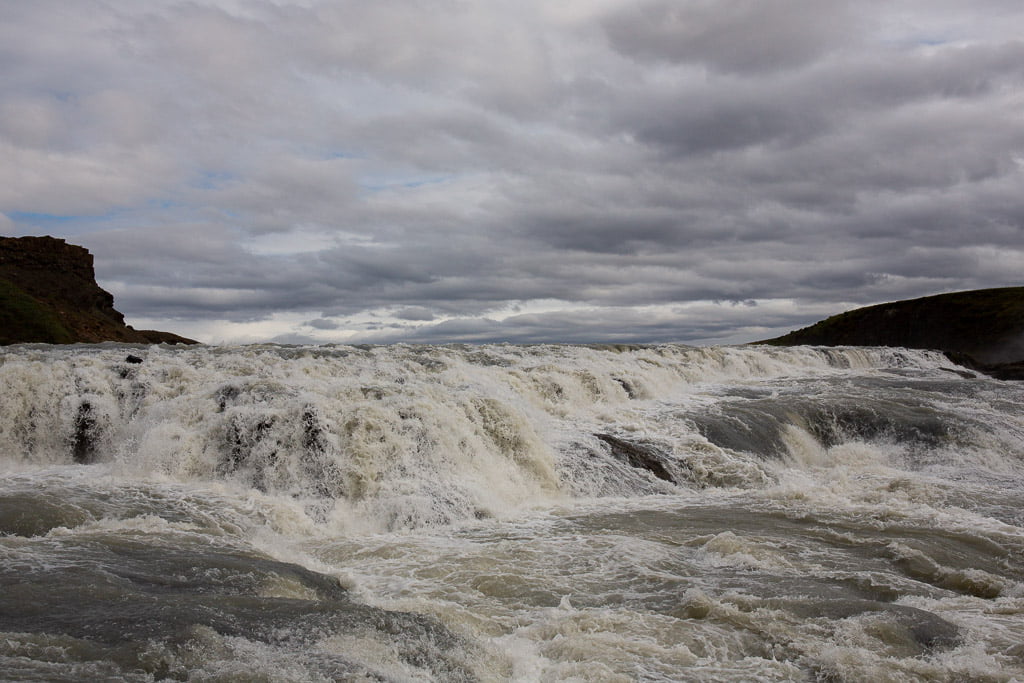
Puffins and other nesting birds
Puffins and other nesting birds can be seen in Iceland from mid-April until early August. Depending on when their young leave the nest and fledge they may depart sooner or later than this. If wildlife is your priority on a trip to Iceland then visiting in June will see the most activity and young.
Want to know more about puffins in Iceland?
Mini-guide to Puffins in Iceland
This ebook includes information about the puffin colonies, where to find them and how to visit responsibly. With 20 pages of information, maps and beautiful photographs, it will help you see the puffins on your next summer adventure in Iceland.
best time to go Whale Watching in Iceland
Whale watching is available year-round in Iceland. However, in the winter months, sightings become less frequent and in the north, it is often difficult to reach some of the more remote pick-up points for the boats.
If you are visiting Iceland to go whale-watching then the summer months are best. Long days make sunset trips possible, the seas are calmer, the weather is warmer and the whales and dolphins are closer to shore.
In the winter months after storms, the whales take time to return to the shallower feeding grounds around Reykjavík and there may be numerous days where there are no sightings. If you have time, book whale-watching early in your trip so you can use the free return that charters offer for ‘no sightings’.

Icelandic Coast Through the Year
The coast of Iceland is a wild and remote place. The winter brings large storms and strong currents that result in large waves breaking onto the beaches. It is essential that you are aware of the waves at all times and take time to watch what is happening when you arrive at any beach.
The ice at Diamond Beach and Jökulsárlón can vary through the year with more ice being present during the winter months. After a storm or high winds, the number of icebergs on Diamond Beach can change dramatically from one tide to the next.
Some parts of Ring Road 1 may be closed in the winter months because of high winds, waves and snow and it is essential to check the weather and road reports throughout the day. Road conditions can be seen at https://road.is .

Plants and Moss
Through the years, the landscape changes. In spring and summer, the landscape is awash with colours. Purple lupins, blue forget-me-nots, and harebells as well as the green of moss are everywhere. In autumn the leaves of many plants change to orange and red and this can give a different feel to familiar places.

Best time to see the northern lights in Iceland
The northern lights can be seen on clear nights between October and April. The sky needs to be clear of clouds (often making the night cooler) and there needs to be darkness. In the summer months, the sky never gets dark enough for the lights to be visible.

New Year in Iceland
While Iceland is perfect for natural spectacles, New Year’s Eve is an experience not to be missed. This is the only time of the year that fireworks and available to purchase and the sky is filled with fireworks and smoke. Across the city, bonfires are lit and families celebrate in style with late-night parties. This isn’t just in Reykjavík, some of the smaller towns celebrate as much if not more than the capital.

Planning a road trip to Iceland? Read all my Iceland Travel Guides
I'm Suzanne the traveller and photographer behind Meandering Wild. With over 30 years of experience travelling to different corners of the world in search of wildlife and remote locations nearly all of the advice on this website is from my own exploring.
These are the best times to visit Iceland

Part of Iceland 's immense charm is its weather — the spontaneous force that controls all activity for people living on (and visiting) the island nation. A matter of a few minutes can turn your sunny-day adventure into an afternoon spent waiting on the side of the road for a blizzard to pass. And while some may view that as a total vacation bummer, I prefer to think of it as an opportunity to fully experience the Land of Ice and Fire.
As someone who has a serious interest in Iceland and visits multiple times every year, I've quickly learned to appreciate Iceland during all its seasons and wild weather patterns — and figured out the best itineraries for all situations.
Ahead, you'll find the best times to visit Iceland based on a number of factors: budget, high and low tourist season, weather and more.

The cheapest times to visit Iceland
If you don't really care about weather-specific activities, my advice is to take advantage of the shoulder seasons in spring and fall when crowds are thin and accommodations are cheaper (think: March, April, September and October). There are often cheaper flights during these time periods as well.
TPG is constantly scouring flight deals and we've recently seen prices under $300 for round-trip flights between Boston and Reykjavik on low-cost Icelandic airline Play .
Related: Great fall, winter and early spring deals on flights to Iceland
Naturally, flights to Iceland during the winter are going to be the cheapest, aside from the main holidays like Christmas and New Year's (ticket prices skyrocket during those weeks), but in terms of value, consider visiting in the spring. Even if you pay a bit more, you may get more value given the more mild weather and longer daylight hours.

When to visit Iceland to avoid crowds
If you're looking to take in the sights without hundreds of other strangers, look again to the off months of March, April, September and October. Since the weather is a bit more erratic than it is during the summer, fewer travelers take the risk.
If good weather is not on your list of things you care about, head to Iceland in the dead of winter (December, January or February). It's going to be colder, but that and the extremely short days keep the crowds at bay.
When to visit Iceland for events
Music festivals in iceland.
There are a number of festivals to keep in mind while planning your trip to Iceland. For the musically inclined, check out Iceland Airwaves in November, the Reykjavík Jazz Festival in August, Aldrei fór ég Suður in April, Secret Solstice in June or the four-day rock and metal festival, Eistnaflug , in July.

Art, film and culture festivals in Iceland
For arts and culture, there's the Reykjavík International Film Festival in September and October and the LungA Art Festival in July.
If you've done your research on the Icelandic sagas, plan a trip over the first Friday after Jan. 19 to partake in the Thorrablot celebrations. This mid-winter festival brings locals and travelers together to dine on the unusual foods of Iceland's past like fermented shark, boiled sheep's head and congealed sheep's blood wrapped in a ram's stomach.
Icelanders also celebrate the summer solstice, which occurs over June 21. With nearly 24 hours of sunlight, the bonfire celebrations go late into the night.
Related: 9 common mistakes you don't want to make in Iceland
The best times for whale watching in Iceland
During the winter, it can be hard to spot any kind of wildlife in Iceland, given the harsh climate. If you're looking to spot migrating whales passing by, plan a trip between April and October — otherwise known as prime time for whale spotting. You can catch sight of minke, humpback, sperm, and fin whales, along with orcas, and there are plenty of tours on the Reykjavík Harbor that will take you to the best locations.

The best times to see puffins in Iceland
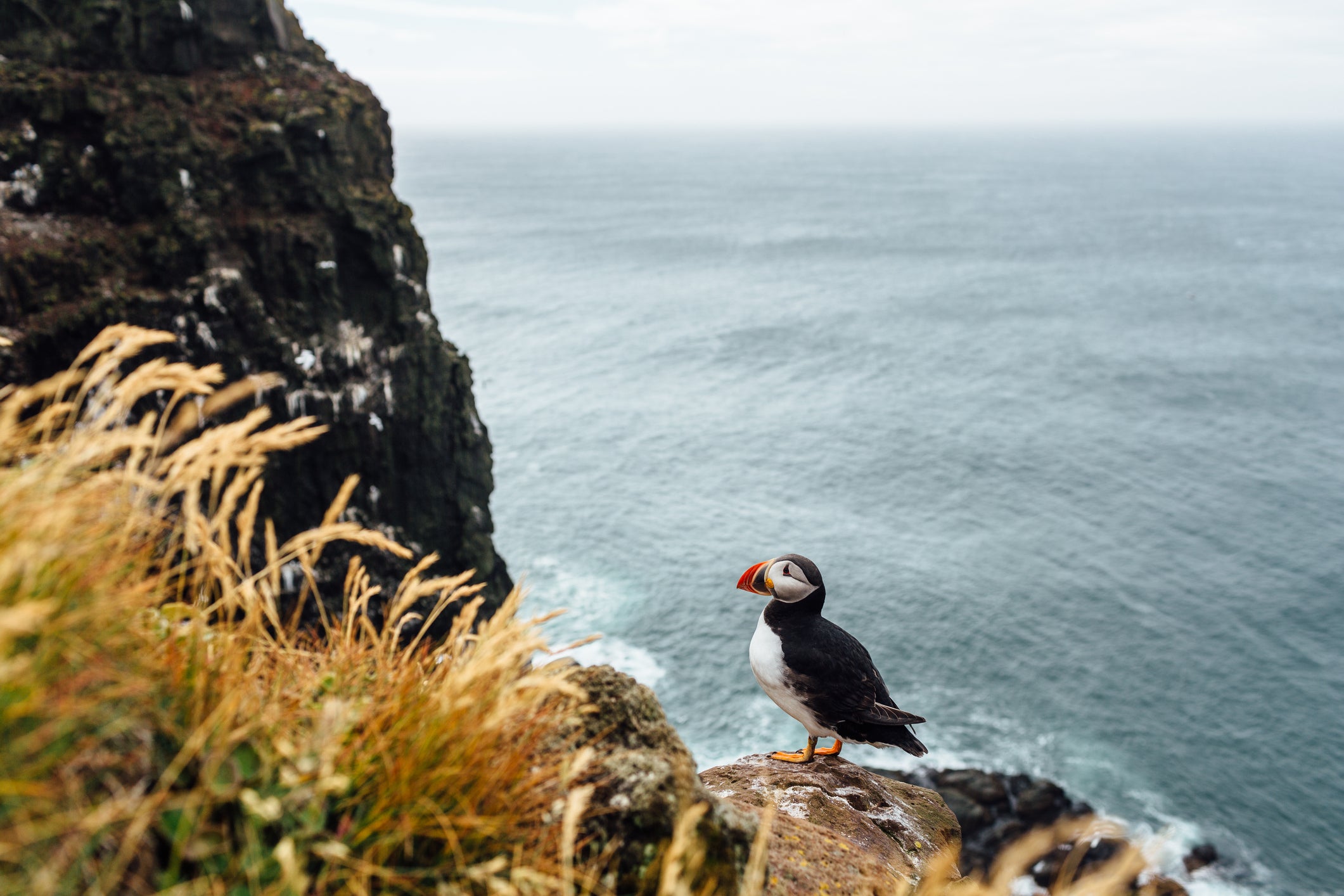
There are a few excellent spots to see Iceland's most adorable bird in its natural habitat, but no matter where you plan to go puffin-spotting, the best time to do it is between April and August.
You'll find the largest puffin colony in the world on the Westman Islands, known as Vestmannaeyjar in Icelandic. You can even arrange a minibus tour where a local guide will share the history of the islands and take you to some of the local puffin hot spots.
Related: 7 things to do on your next trip to Iceland
The Látrabjarg cliffs in the Westfjords provide a picturesque locale for seeing puffins and, along with them, millions of other birds who call the cliffs home, including razorbills and northern gannets.
Two animals you will see no matter when you visit: sheep and horses, and lots of them. Wool textiles are a huge part of the country's retail market and exports, while Icelandic horses have become a key player in the area's tourism industry — horse rides across the countryside have become a popular bucket list item for the animal's distinct "fifth gait."

The best times to hike in Iceland
Summertime is easily the best time to go hiking in Iceland, but it will also mean busier trails. To really get away from the crowds, you can hire a private guide who will bring you to some lesser-known hikes in the highlands, but this region is only accessible during snow-free months.
There are hiking trails open during the wintertime, but they will be less challenging (despite the blowing winds and heavy precipitation, of course). You can find hiking just about anywhere during any time of the year if you do the research. There are plenty of opportunities to take a stroll around almost all of the major attractions, from Pingvellir National Park and the waterfalls along Route 1 in the south to Reykjanes Peninsula and the famous Búðakirkja: a lone black church that sits on a lava field.

Consider your priorities: Do you want to hike through the Highlands or into some of the trickier areas of the north? Plan your travel for June, July or August. Are you more interested in snowshoeing or glacier walking? Find a tour company to take you to some of the prettiest spots during December, January or February. All other months offer great hikes, it just depends on the weather forecast for the day.
The best times to cycle in Iceland
Cycling the Ring Road is ambitious, but the views make it all worthwhile. Plan your trip during the summertime — preferably late June — for the most daylight. The sun stays up practically around the clock during this season, making it easy to bike long into the night without worrying about visibility. But don't forget your eye mask if you actually want to sleep.

The best times to drive around Iceland
Let's settle one thing: You can drive around Iceland during any time of the year, you're just going to have different types of weather to worry about. You must choose if you want a leisurely, sunny road trip or if you are just looking to get from Point A to Point B. If you anticipate any snow during your trip, make sure your car has four-wheel drive. You will thank yourself over and over again.

It may seem obvious, but if you want a true road trip, go during the summertime when sunlight is abundant. Book your road trip around Iceland for July and you'll never regret it.
If you aren't afraid of driving through some true "winter weather" — hail, snow, blizzards, torrential downpours and a blip of sunlight all in the span of a few hours — you can drive in Iceland any month of the year. But the country will shut down the roads if they're impassable, so keep that in mind. For example, you won't be able to visit the highland region during the winter, or take some mountain road shortcuts.
The best weather for special activities
There are some things that can only be done during specific seasons in Iceland, which is part of what makes the destination so special. But if you're looking for hot springs, never fear: relaxing in a hot spring is a year-round activity.

You will definitely get the most out of your hikes if you plan a summer trip. Not only will the weather be better, but you can get access to the multi-colored landscapes of Laugavegur and the so-called Volcanic Trails in the Highlands.

In the colder months, you have the opportunity to get close to Iceland's famous, electric-blue glaciers. Glacier hikes, ice caves and iceberg spotting are all popular — and encouraged — activities during the winter.
The ice caves, especially, are a huge must if you're visiting during the winter, as they are completely inaccessible during the summertime. To visit them, you'll need a trained guide familiar with the region. Do not try and visit these on your own as the melting pattern can be unpredictable and extremely dangerous.
Another strictly wintertime activity is northern lights spotting. The aurora borealis will only appear under extremely dark, clear conditions between September and April; when the nights are long you have a better window of time each day when you can view them.

Bottom line
There are some things in Iceland that can only be experienced during a certain season, meaning there truly is no bad time to visit the country. With that in mind, you should make a list of your vacation priorities. Looking to see the ice caves? You'll need to visit during the winter. Want to hike in the highlands? Again, that whittles down your travel options.
No matter when you choose to visit Iceland, though, you'll be treated to the country's unparalleled beauty, exciting outdoor activities and majestic wildlife.
Best time to visit Iceland

The best time to visit Iceland is between September and March to see the northern lights, or between June and August for summer activities. While travel to Iceland may depend on your desired itinerary, generally, the best time to visit is during the summer. During this time, you’ll experience warmer temperatures and long days of sunlight, known as the spectacular midnight sun. While the summer boasts green countryside and animal spotting, the winter is the best time for the Northern lights and the country’s famous geothermal spas when they may not be as busy!
However, if you’re planning a trip to see something specific, such as the puffin or whale migrations, you’ll need to visit during a specific time of year. We've broken down some main factors to consider before choosing when to travel to Iceland.
The phenomenal cosmic light show, known as the aurora borealis or the Northern Lights, is a natural event that occurs from late September to late March. The long and dark winter nights make it an ideal time to visit, however, because it is a sporadic event, a definite sighting can't always be guaranteed. You may be more likely to see the lights during the equinoxes that occur around the 21st/22nd of March and September.
Learn more about the Northern Lights
Iceland’s famous Blue Lagoon is a year-round natural geothermal pool that is said to have healing properties and is situated among a scenic Icelandic landscape. This mineral-rich seawater contains a mix of silica, algae and other bioactive elements that can be particularly beneficial for certain skin conditions.
While the lagoon is open all year, if you’re hoping to visit with slightly warmer weather, you may want to visit in the summer months (May to August). That said, many travelers love to visit the springs in the winter months to be surrounded by the beautiful snowy hills of the region while they relax in the outdoor lagoon.
The Icelandic coastline is famous for its whale activity due to the cold waters and favored feeding grounds of the local marine life. Between April to September is the best time to visit Iceland for whale watching as this is when the whales migrate north for the summer months. Keep a look out for humpback, minke, fin, sperm or even blue whales! You might even see other marine species such as orcas, dolphins, seals or harbor porpoises.
Best for: Þorrablót Mid-winter Festival and ice caves
While mid-winter weather and short days may deter some travelers, the colder months are also perfect for ice cave exploration and catching a glimpse of the Northern Lights. However, if you’d like to stay out of the weather, why not partake in the honoring of the Icelandic ancestors during the Thorrablot festival? While visiting in January, join locals on a historical Icelandic food tour that includes foods such as hangikjot (flavored smoked lamb) or brennivin (a local distilled beverage).
Best for: Winter Lights Festival and Northern Lights
February is one of the best times to visit Iceland for some exciting food and cultural events. The two festivals, Winter Lights and Food & Fun are hosted annually by the capital Reykjavik and can add spark some joy in the coldest and wettest months of the year! But keep a watchful eye out for the Northern Lights.
Best for: Northern Lights, winter sports, Iceland Winter Games and the Annual Beer Festival
The longer and brighter winter days of March make it an advantageous time for winter sports. If you’re looking to downhill or cross-country ski, snowboard, snowshoe or hike the terrain, the nearest mountain is only a 20-minute drive away from Reykjavik.
Best for: puffins and golden plover migration, The Golden Circle and smaller crowds
April marks the start of the spring season in Iceland and the breathtaking return of several local bird species, including the world-renowned puffins and golden plovers. While the locals celebrate the first day of summer shortly after April 18th, this month is a perfect time to visit for lower off-season prices and fewer tourists. Remember that there may still be an assortment of rain, snow, hail or shine, so pack accordingly.
Best for: whale watching, nature adventures and long days
May in Iceland sees the end of the cold winter months, however, temperatures still sit between 32-50,°F although there is less chance of snow. Towards the end of May, there can be up to 20 daylight hours which makes it a great time to do some fun outdoor adventures. Why not take a tour through the lava caves, hike your way across a glacier, snorkel or scuba dive in Icelan's pristine waters or even horseback ride along the countryside?
Best for: midnight sun, Hafnarfjörður Viking Festival, National Holiday of Iceland, Fisherman’s Day and the opening of some highland roads
Summer has arrived! With summer comes longer days and the peak travel season so prices are higher and attractions are busier. June is one of the best times to explore the natural wonders of the Icelandic countryside. However, with a great array of cultural, music and environmental festivals, there’s something for every interest. The end of May to the start of June is also the best time to see the famed midnight sun phenomenon in Iceland so make sure you bring a good sleeping mask!
Best for: Braðslan, nature photography and long days
July is the busiest tourist month of the year for Iceland. With sunshine, greenery and longer days, it’s a perfect time to engage in the bustling city life or explore the vibrant natural scenery. If you’re looking for a slightly less crowded time, try to book in for the start of the month before the local schools are on break.
Best for: Reykjavik Pride, Reykjavik Culture Night, National Festival, Verslunarmannahelgi, Þjóðhátíð and wilderness exploration
Visiting Iceland in August usually ensures full access to the country’s wilderness as inaccessible areas in winter are now fully open. As one of the hottest months, the weather in August - while still unpredictable at times – is best for exploring the rugged and idyllic terrain of the glaciers, volcanoes, hot springs and waterfalls of the Icelandic wild. If nature isn’t your thing, the local scene has plenty of events and attractions to fill your itinerary.
Best for: fewer crowds and mild weather
September marks the end of the busy summer months but temperatures can still fall between 40-50°F. With the bulk of tourists on their way home, you’ll find lower prices and smaller lines for attractions. This is a great time to go if you’re looking to surround yourself with great music or film. Note that some highland roads will be closed by the end of the month for winter.
Best for: Northern Lights and berry picking
See the vibrant autumnal colors that blanket Iceland during October as the temperatures lower and leaves drop. As the colder months set in, plan for the Northern Lights as they can easily be seen at this time of year, especially when away from city areas without cloud cover.
Best for: hot springs, ice caves and Northern Lights
November brings winter into full steam with a drop in temperatures and daylight hours. Winter is often the most scenic time to visit one of Iceland’s many hot springs and relax in the white-blanketed scenery. With the drop in temperatures comes the reformation of the ice caves making November a perfect time to transverse the chilly blue caves and stunning glaciers.
Best for: New Year’s Eve, frozen waterfalls, glacier exploration, Christmas villages and festive lights
Looking to party into the new year? Iceland’s eclectic music scene and picture-perfect Christmas villages can provide you with day-to-night entertainment. While December is known as one of the coldest and windiest months, the Northern Lights are often viewable during this time. Just note that some hotels, services and attractions are closed during the winter.
Let's create an exclusive trip for your group.
Chill out: Beat the summer heat with these cool escapes
Why 2024 is the best year to see the northern lights
How the Icelandic hot dog became an international icon
Iceland’s Folklore: 4 mythical creatures that make the scenery come alive
Top 12 things to do in Iceland
6 of the best hikes in Iceland
10 ways to get closer to nature with Intrepid
In sickness and in health: How I ended up getting married on an Intrepid Iceland trip
Best Time to Take an Iceland Cruise

Iceland Climate

Iceland in June: Weather and Wildlife

Iceland in July: Activities and Adventure
Iceland in august: the last days of the midnight sun.

Iceland in September: Start of Northern Lights Season
Best time of year for northern lights in iceland, take a soak in the blue lagoon waters best time to visit blue lagoon, want to go, top iceland travel destinations.
- Flatey Island
Iceland Trips by Departure Date
- 2024 Iceland trips (83)
- 2025 Iceland trips (52)
- 2026 Iceland trips (9)
- June 2024 (14)
- July 2024 (39)
- August 2024 (49)
- September 2024 (31)
- October 2024 (18)
- November 2024 (16)
- December 2024 (16)
- July 2025 (13)
- August 2025 (18)
Top Experiences in Iceland
- Iceland Cruises (99)
- Iceland Wildlife & Safari Exploration (35)
- Iceland Cultural (24)
- Iceland Luxury (22)
- Iceland Land Tours (10)
- Iceland Trekking (9)
- Iceland Active (6)
- Iceland Scheduled Group Tour (5)
- Iceland Beaches (3)
Iceland Trips by Duration
- 5 day trips (5)
- 8 day trips (7)
- 9 day trips (5)
- 10 day trips (11)
- 11 day trips (10)
- 12 day trips (10)
- 13 day trips (8)
- 14 day trips (13)
- 15 day trips (12)
- 16 day trips (7)
- 17 day trips (3)
- 18 day trips (3)
- 19 day trips (3)
Iceland Trips by Activity
- Iceland wildlife viewing (85)
- Iceland small ship cruises (78)
- Iceland whale watching (55)
- Iceland hiking (46)
- Iceland village visits (34)
- Iceland kayaking (29)
- Iceland adventure options (10)
- Iceland archaeological site visits (8)
- Iceland northern lights (7)
- Iceland land & sea exploration (5)
- Iceland photography seminars (3)
Why Travel With Adventure Life
Recognized by.

Why winter is magical in the Westfjords (and other great times to come)
Dec 6, 2021 • 9 min read

The Westfjords is the wild, untamed Iceland you've always imagined © Hana Masovic / Eyeem / Getty Images
If you’re looking for Iceland at its rawest, wildest and emptiest, the Westfjords is most definitely where you’ll find it.
This off-the-radar peninsula in northwest Iceland is only 200km (124 miles) from Reykjavik – less than a day’s drive – yet fewer than 10% of visitors take the time to explore it, deterred by its remoteness, its sparse habitation, and its notorious unpaved roads.
Those who do visit return with tales to make other travelers green with envy. This is a land of craggy cliffs cloaked with seabirds, thunderous waterfalls, vast glaciers, epic valleys – and perhaps most compelling of all – hardly any other visitors to share these wonders with.
If you’re one of the hardy few who make it to the Westfjords, bear in mind that the weather can be wild, whatever time of year you visit. The short Icelandic summer from June to August brings the most settled conditions and the longest days (in midsummer the sun never sets at all) but in winter, it’s the polar opposite: just a few hours of daylight a day, with heavy snowfall and ice aplenty.
Visitor numbers drop off sharply in spring and fall, so these are good times to explore the region’s amazing hiking trails in solitude. Winter is reserved for hardy explorers, but there's skiing at Isafjördur and you have a decent chance of spotting the Northern Lights.
For fans of scenery and solitude, here are the top times to come to the Westfjords.
Low Season (October–April) is the best time to see the Northern Lights
Perhaps unsurprisingly, winter is the most challenging time to visit the Westfjords. Snow, ice and blocked roads are common. Some of the more isolated communities of the Westfjords are cut off entirely for much of winter. But it’s also a spectacularly beautiful time of year – especially if you want to experience winter skiing or snowshoeing in an empty landscape or have front-row seats for the Northern Lights.
The aurora is actually present for most of the year, but it requires clear, dark skies to become visible. You might get enough darkness in September and May, but visiting from October to April optimizes your chances. Note that winter driving in Iceland – especially in the Westfjords – can be challenging; snow tires and/or snow chains are essential. Better still, rent a 4WD.
Shoulder Season (May and September) is the best time for quiet trails
Spring and fall whizz by so fast in Iceland that you could blink and miss them – especially in the Westfjords, where there are few trees to mark the transition (locals are more likely to discern the arrival of spring and fall by the amount of snow on the ground). Nevertheless, these are great times for walking along empty trails.
The Westfjords are noticeably quieter in spring and fall. There are fewer hikers on the trails and hotel rooms are easier to come by (and often a bit cheaper). Larger roads and passes are likely to be open, making this a good time for a road trip, but some seasonal shops, attractions and restaurants are likely to be closed.

High Season (June–August) is the best time for outdoor activities
In line with the rest of Iceland, the summer months are when the Westfjords opens up for outdoor pursuits: hiking, mountain biking, sea kayaking, wildlife spotting and more. All the major mountain passes and cross-fjord ferry routes linking the valleys of the Westfjords are open at the height of summer, making travel relatively straightforward.
Summer is also the time when the Westfjords are at their most crowded – relatively speaking – so you'll need to book ahead at hotels, especially in popular areas such as the main city of Ísafjörður . There’s also plenty of daylight – 24 non-stop hours in June, with only a couple hours less in July and August – maximizing your time for exploring.
Being weather-ready in the Westfjords
Whenever you come, you'll need to be prepared for all weathers in the Westfjords. Wintry conditions can strike without warning, even in midsummer. Wind and rainproof gear, a pair of decent boots and some warm layers will definitely come in handy, and it’s worth packing a spare tire and an extra can of gas just in case (petrol stations in the Westfjords are few and far between). A road map and ferry timetables are also very useful: don’t rely on being able to get a decent cell signal out in the Westfjords.
Just three hours of daylight and average temperatures that barely scrape above freezing make January a demanding month to visit – but if you hit the jackpot and get some clear weather days, it’s a brilliant time to get in some winter wildlife watching. The Westfjords is one of the few areas where you have a good chance of spotting Arctic foxes in the wild. January is also peak time for aurora-watching – as long as you’re prepared to hang around for those elusive cloud-free skies, of course. Key events: Þorrablót

The days get noticeably longer in February – you can expect around five solid hours of daylight, especially toward the latter part of the month. Snow still cloaks the landscape, and aurora activity remains strong – but day after day of grey skies can obscure the show. Key events: Bolludagur (Cream Bun Day), Sprengidagur (Bursting Day), Öskudagur (Icelandic Halloween)
With twice as much daylight as February – up to ten hours daily – March is the height of the ski season in the Westfjords. Cross-country skiing, downhill and snowboarding are all on offer at the main ski resort in Ísafjörður, while more experienced skiers can head off into the backcountry (hire an experienced local guide for safety). Key Events: Fossavatn Ski Marathon (late March or early April)
April is a transition month in the Westfjords. Winter still holds much of the landscape in its icy grip, and many areas are still blanketed in thick snow, but more sheltered areas show the first signs of spring: a flush of greenery, perhaps, or even a few wildflowers. Ski season continues at Ísafjörður. Key Events: Ísafjörður Ski Week; Sumardagurinn fyrsti (first day of summer)
The first serious thaws of the year usually happen in May, opening up parts of the Westfjords that have been off-limits for much of winter. Wildflowers begin to bloom in earnest, and it’s a great time of year for birdwatching. Seasonal seabirds – from guillemots, razorbills and cormorants to kittiwakes and puffins – take up roost on the region’s craggy cliffs, including at Látrabjarg , Iceland's westernmost point. The snowmelt also means this is generally a good time to view mighty Dynjandi and other Westfjords waterfalls in full flow. Key Events: Peak season for birdwatching
The month of the midnight sun hits. The Westfjords basks under 24 hours of perpetual daylight, allowing maximum time for exploring. It’s also a brilliant time of year for photography, with a golden hour that seems to last forever, though temperatures rarely climb above 10˚C (50˚F). Mountain roads and hiking trails start to open up in June and the endless daylight means you can pack in some serious trail time. Remember to pack an eye mask if you plan on getting any sleep at all. Key Events: Sjómannadagurinn (Sailor’s Day); National Day of Iceland; Summer Solstice

The start of summer in the Westfjords, with plentiful wildflowers, activities galore and even the chance of sunburn. Though temperatures hover around 10–12˚C (50–54˚F), the summer sun in Iceland can be very strong, so pack sunblock. It’s an excellent time of year for wildlife: humpbacks, gray whales and orcas can be seen off the coast, and playful puffins waddle around the Westfjord’s cliffs. It’s also the best time of year to explore the amazing wilderness area of Hornstrandir and take a day trip to the island of Vigur . Key Events: Swamp Soccer in Bolungarvík
Another great month for hiking, biking and outdoor pursuits, with lots of daylight (16 to 17 hours) and the year’s warmest temperatures, peaking at 14–16˚C (57–61˚F). Seabirds (including puffins) begin to migrate south for the winter, so this is your last chance to see them, and whale sightings also become less common. Trails are at their busiest, however, and the most popular hotels and campsites can be booked out. And while it might not quite be sunbathing weather, August is a fine month for exploring the Westfjord’s beaches, including Breiðavík and Rauðasandur . Towards the end of the month, the first bite of winter can be felt once darkness falls. Key Events: Verslunarmannahelgi; Blueberry Days in Sudavik
If fall’s going to put in an appearance, September is when you’ll see it – although with hardly any trees in the Westfjords, don’t expect much in the way of leaf-peeping. With fewer visitors, it’s an excellent time for tours: kayaking, photography and guided hikes are all popular. Key Events: Icelandic Blues Festival in Patreksfjörður
Temperatures drop sharply and the first winter snowfall can be expected in October. Temperatures drop close to freezing overnight, and 10-12 days of snow is not unusual across the month. October is also when the Northern Lights begin to show up reliably in the Westfjords, so it’s an excellent time to book an aurora tour. Key Events: Start of the Northern Lights season
The sun is gone by 4pm in November, so Icelanders head inside in search of food, drink and entertainment. This is a great time to visit the region’s biggest town – bustling Ísafjörður – to hunker down in its cozy cafes and pubs, visit heritage museums and dine out in seafood bistros. Don’t miss the informative Westfjords Heritage Museum and the quirky Museum of Everyday Life . Key Events: Christmas tree lighting across the Westfjords
Like many Nordic nations, Iceland puts on a grand show for Christmas. Every house is decorated with colorful lights, and the calendar is packed with festive events – from winter beer tastings to reindeer rides and Christmas markets. Fireworks light up the sky on New Year’s Eve – but they’re often overshadowed by the aurora. Key Events: New Year’s Eve
Safety recommendations and restrictions during a pandemic can change rapidly. Lonely Planet recommends that travelers always check with local authorities for up-to-date guidance before traveling during Covid-19 .
You may also like: The 15 places you don't want to miss in Iceland Why the Westfjords are the place to escape the crowds in Iceland 8 Iceland activities for adventure seekers
Explore related stories

Destination Practicalities
Jun 14, 2024 • 9 min read
Iceland's capital offers stunning natural beauty, arty culture, geothermal wonders and the chance to see the Northern Lights. Here's all you need to know.

Jun 12, 2024 • 12 min read

Mar 31, 2024 • 12 min read

Mar 31, 2024 • 6 min read
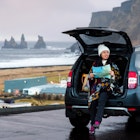
Mar 6, 2024 • 9 min read

Mar 4, 2024 • 10 min read

Feb 28, 2024 • 8 min read

Feb 19, 2024 • 7 min read

Feb 6, 2024 • 7 min read

Dec 26, 2023 • 6 min read

When's the Best Time of Year to Visit Iceland?
K nown as the land of fire and ice, Iceland beckons to adventure-seekers year-round. The best time of year to visit Iceland depends on your traveling style and the type of adventures you enjoy. For those in search of the northern lights, schedule your travel between September through April to maximize your chances of spotting this bucket list experience.
Although the coldest time of the year, winter months are ideal for exploring ice caves, warming your hands by bonfires, cultural and music festivals in Reykjavik and celebrating the magic of Christmas and New Year’s Eve.
As spring arrives, migratory birds return including the always adorable puffins. Spring is also the perfect time for whale-watching tours. Of course, the summer months bring the midnight sun, summer solstice and sightseeing tourists from around the world. And the brief but beautiful autumn season yields a blanket of color and fewer tourists traveling the Golden Circle . Truthfully, the best time to travel to one of Europe’s most unusual destinations is really anytime!
Year-Round Iceland Experiences
As with many destinations, Iceland features several year-round experiences. Awe-inspiring waterfalls captivate tourists any time of year. Sure they may be partially frozen in winter months, but that’s just another type of beautiful! Hot springs and geothermal pools bubble year-round from the Blue Lagoon to remote hot springs found throughout the Icelandic landscape.
Outdoor activities can be enjoyed in any season. The famed Icelandic horses are available year-round for horse riding adventures. And hikers also have plenty of year-round options. No matter when you visit Iceland, you can count on the Iceland weather to deliver a variety of experiences from sunny days to whipping winds to rain and back to sunny days. It’s unpredictable and packing layers is the key to managing whatever comes your way.
Road trips provide another year-round adventure option. Even in winter weather, driving the Golden Circle is possible. The Ring Road through the south coast of Iceland is also an option. But for those hoping to road trip through the entire country on the Ring Road, winter months can present some challenges due to potential road closures on mountain roads in Iceland’s more arctic regions. So if traveling the full distance of the Ring Road is on your bucket list, save that for the shoulder season or an Icelandic summer.
Iceland’s Peak Season
There’s no question that the months of June through August are Iceland’s peak season. During this popular time, you’ll be bumper-to-bumper with other tourists on road trips along the Golden Circle and other popular destinations. Of course, the summer months typically bring more sunny days. And, the midnight sun arrives for the summer solstice in June.
The advantages of traveling to Iceland during the peak tourist season include more hours of daylight which means more time for hikers to hit the trails along with more time for horse riding. In Iceland’s westfjords, you can enjoy all the benefits of traveling to Iceland in the summer months with fewer tourists as most focus their travel time on the Golden Circle and the south coast.
Also, as mentioned previously, summer months are best for a full road trip along the Ring Road as mountain roads are open and ready for exploration.
Visiting Iceland in the Winter Months
Despite its arctic reputation, Iceland’s winters are relatively mild. Temperatures average around 32 degrees. Of course, weather conditions in Iceland change continuously and the same is true for winter months. Winds can be strong and winter storms with snow and ice are possible. Hours of daylight shrink in the winter months to as low as four hours per day. But once winter solstice comes, daylight extends by a few minutes each day.
One big advantage of visiting in the winter months is the possibility of seeing the aurora borealis. Although the northern lights can be seen from September through April, the darker days of winter provide more opportunities for you to experience this natural phenomenon.
The winter months also bring cultural events – especially in Reykjavik. Here you’ll have the opportunity to participate in the Reykjavik International Games and the Dark Music Days Music Festival. Also, during the old Norse month of Þorri, which runs from mid-January to mid-February, Icelanders toast to the old gods with a mid-winter feast known as Þorrablót.
If an ice cave tour falls on your list of adventure priorities, the winter months might be the best time to visit Iceland. However, as long as the ice caves haven’t melted, you can still squeeze this in through April.
Frozen waterfalls, magical Christmas villages and New Year’s Eve bonfires add to the lure of a winter visit to Iceland.
Shoulder Season in Iceland
There’s something to be said for visiting Iceland in shoulder season. Fewer tourists, lower costs and those year-round adventures noted previously all add to the appeal of an off-season trip. And, as luck would have it, Iceland has two shoulder seasons – spring and autumn.
As winter fades away, those choosing to visit Iceland in April are treated to the last days of the northern lights season. From April to May, migratory birds make their way to Iceland for nesting season. If seeing puffins ranks high on your list, this may be the best time to visit Iceland. Spring also kicks off whale-watching season as humpback, minke, orcas and even blue whales migrate north for the summer months. Book a whale-watching tour and take in this wildlife wonder.
A visit to the Snæfellsnes Peninsula during the off-season means outdoor activities with fewer tourists. Glacier hiking is also possible in the shoulder season.
For that second shoulder season from September through October, the fall colors blanket the mossy landscape. Hikers can add berry picking to their experiences and the northern lights begin to dance across the skies again!
There’s so much wonder to Iceland with its fire and ice landscape and stunning natural beauty that no matter when you choose to visit Iceland, it’s a trip you’ll never forget. Of course, you can always return to check out another season. The Icelandic treasures will be waiting for you!
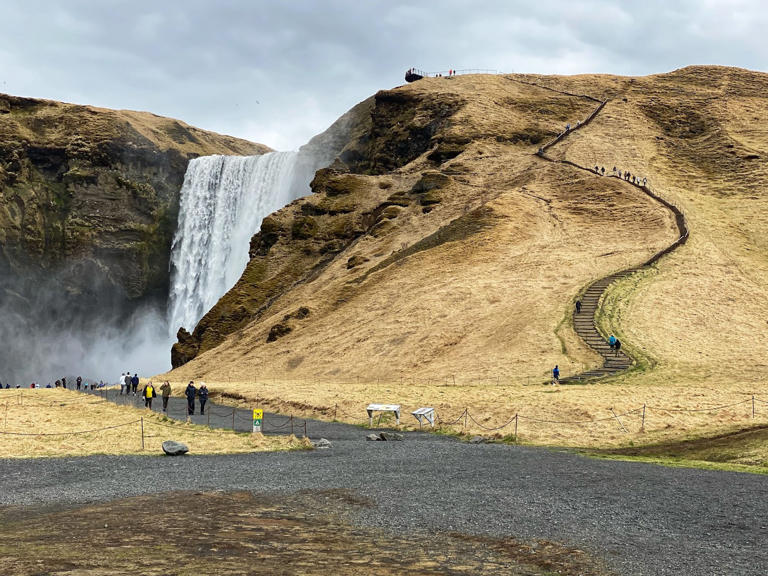
- Food & Drink
- What to pack
- City Guides
- Travel Hacks
- New Zealand
- North America
- Latin America
Copied to clipboard!
Travel Tips
When is the best time to visit Iceland?
By Charlie Fabre
Writer and editor for Contiki, Charlie is French-American, obsessed with travel, art, food, and reading in the New Hampshire forests.
Published on Jun 18, 2024 | 11 min
Table of Contents
The weather in iceland, iceland in spring, iceland in summer, iceland in autumn, iceland in winter, icelandic events and festivals, when is the best time to go to the blue lagoon, when is the best time to see the northern lights, when is the best time to go whale watching.
Beautiful land of mysteries, and the most probable place on earth to still host giants and unicorns (in my opinion anyway), Iceland is a popular tourist destination for travellers across the globe who are after something different. With cities few and far between, the real wonder of the Land of Ice and Fire is the landscapes that are as varied as they are mind-blowing. Geysers, black sand beaches, waterfalls, fjords, and so much more, travelling here is a must for everyone, but the best time to visit Iceland depends on what specifically you’re looking for.
Iceland Fire and Ice
Being so far north on the globe, Iceland’s climate is classed as a subpolar oceanic climate. This means that the country is prone to long, but relatively mild, winters, and cool and short summers. The weather isn’t actually that drastic when you take into account Iceland’s geographical location, but you’ll want to be prepared for rain and snowfall anyway.
As Iceland is also an island surrounded by vast swaths of sea, you’ll want to pack a good jacket for wind, especially if you’re planning on sticking to the coasts or port cities like Reykjavik. That being said, whether it’s heavy snow drifts or bright sun, the weather in Iceland always lends the land a beautiful glow.
So, in short, the best time to visit Iceland is going to depend on what weather you’d personally prefer to experience.
Image source: Balazs Busznyak / unsplash
April – May
Even though the Northern Hemisphere’s spring technically starts at the end of March, you’ll want to wait until April for the weather to catch up in Iceland. Traditionally, the start of an Icelandic spring is marked by the arrival of the golden plover, a bird that makes this island its home for over the summer. In fact, with spring coming, you’ll notice that Iceland is filled with all sorts of wildlife! You can book wildlife watching tours where you may be lucky enough to catch glimpses of whales, puffins, and fluffy arctic foxes.
The spring weather is mild, with the sun starting to warm up the land, and plenty of lush landscapes waking up and wildflowers blooming. Iceland is distinctly green this time of year, so pack a camera to capture all this beauty. Seeing as the weather is only just starting to warm, the tourist season in Iceland hasn’t hit its peak yet, so spring is an ideal time to visit Iceland if you want to travel with smaller crowds.
Be sure to hit up the iconic Ring Road while traffic is low – this will take you around the entire country and thoroughly awe you at the same time.
Iceland’s Aldeyjarfoss Waterfall is the hidden gem you need to see
June – August
Summer is probably the best time to visit Iceland in general as the hours of daylight are much longer than in the winter, allowing you to take full advantage of the country and pack as many adventures in your days as possible. The weather is also lovely, characterised by sunny days that are warm enough to allow you to wear a t-shirt, but cool enough that you won’t sweat through it.
Iceland in summer tends to be on the busier side, but you shouldn’t let that stop you from whizzing around the famous Golden Circle. This is the ideal time to explore the highlands, which are inaccessible in winter, and you may get the chance to spot some fjord ponies grazing in the grass! You could also spend a relaxing day oooing and ahhing at the Sky Lagoon, which is basically a natural infinity pool overlooking the Atlantic Sea – there’s honestly nothing like it.
Hitting up the Gullfoss waterfall, the must-see geothermal geyser, and Þingvellir National Park are all musts as well. While you’re touring the Golden Circle, why not stop for a delicious farm-to-table lunch at Efstidalur ? We highly recommend it!
If you can’t be bothered driving through traffic and just want to relax, then touring Iceland in the summer with Contiki is an easy way to do so, so you can focus on the views and the fun while we take care of the rest.
Image source: Jonny Auh / unsplash
September – November
Autumn in Iceland is when things start to cool down again, and the days start getting shorter and shorter. The weather will get a little windy and rainy, so make sure to bundle yourself up in some cosy jumpers and jackets. But other than that, it’s a charming time of year to visit as the landscapes turn orange and vermillion, lit up frequently like molten gold by the setting sun. It’s idyllic, honestly, and chances are you’ll have the whole country to yourself as tourism numbers drop.
This is the time of year when the Northern Lights start making their appearance, so if viewing the dancing colours has always been on your bucket list this is the best time to visit Iceland. In addition to the usual autumnal colours, Iceland will also treat you to some natural pinks, purples, and magentas, courtesy of the lupins that grow in the moors.
If you thought that was the end of the rainbow, you’d be wrong: the famous Blue Lagoon never fails to surprise because of its incredibly vivid turquoise colour. With fewer people and chillier weather, take a dip in this geothermal spa for total relaxation. There’s so much to do and see in Iceland during this season, so take advantage of it.
When is the best time to see the Northern Lights in Iceland?
December – March
The Icelandic winter is synonymous with three things: midnight sun, frozen waterfalls, and aurora borealis. It’s also unique and stunning, a true winter wonderland, but mighty cold so pack accordingly – you really don’t want to be caught freezing here. Most tourists stay away from travelling to Iceland in winter on account of the weather and the very short days – Reykjavik generally only sees five hours of daylight at this time – but for the brave it can be an amazing experience.
Winter is when Iceland’s natural beauty truly shines, and it does literally shine. There’s plenty of snow during these months, and when it catches the short amount of sunlight it really glitters. The frozen waterfalls, stopped in time as if by magic, are also enchanting sights. If you ever wanted to feel like you were travelling to a different world, Iceland in winter will give you that impression and more! This is the ideal time to take advantage of the many geothermal pools as well so you can warm your bones and admire the views through the mist.
Ice caves and glaciers are exciting exploration destinations as well, however you should remain cautious! Driving in winter isn’t generally advised for tourists in Iceland, so you may want to skip the Ring Road and Golden Circle at this time, but this will give you ample opportunity to really get to know the cities and engage with the locals.
Image source: Contiki
The time you decide to travel to Iceland may be dictated by the various events and festivals held throughout the year that you may be hoping to attend. Here’s a list of some of the most notable Icelandic festivals and when they take place so you can plan ahead:
1. Iceland Airwaves Music Festival
Iceland Airwaves is a multi-genre, multi-day music festival open to all! The festival is held across a multitude of venues across the country’s capital cities, and it’s a truly immersive experience of bright neon lights, dancing people everywhere, and music you can feel hum in your bloodstream. You’ll get a fun mix of big names and up-and-coming artists so you can enjoy the familiar tunes and add some new ones to your playlists.
Iceland Airwaves takes place in November, right at the end of Autumn.
View this post on Instagram A post shared by Visit Reykjavík (@visitreykjavik)
2. Food & Fun
The Food & Fun festival is an institution in Iceland, and a long awaited event all year round. Taking place in Reykjavik, you’ll want to bring an empty belly as you’ll be filling up on delicious local food all day! Chefs from around the world gather here to create some delicious plates that bring people together. Food & Fun takes place every year in March, just before Spring, marking this season as the best time to visit Iceland.
3. Reykjavik Jazz Festival
Lovers of jazz unite because you’ll be having a blast in Iceland. Follow the sound of smooth beats to Reykjavik to experience one of the most prestigious festivals ever. As the title suggests, this festival is all about celebrating Jazz, as an international scene of artists and performers gather to give you a funky show.
Get your tickets for the Reykjavik Jazz Festival in August, a great way to send the summer off.
View this post on Instagram A post shared by Reykjavik Jazz Festival (@rvkjazz)
LungA is a festival that celebrates the arts. Filled with workshops, lectures, exhibitions and plenty of activities, you’ll be able to have a really stimulating few days admiring other creative works. Each year the festival has a different theme, and artists are invited to create something specifically for that, so you’ll always have a different experience even if you go every year! LungA is all about visual artwork like sculpture, installation, and painting, but also tattoos and live music performances.
This festival takes place in the peak of Iceland’s summer in July.
5. Reykjavik International Film Festival
Iceland’s reputation for film is growing, both in the films they produce and the use of Iceland as a backdrop for many new releases (like True Detective and Game of Thrones ). The Reykjavik International Film Festival (RIFF) is a great chance to catch a range of new films, both from established writers and directors as well as new talent in the industry. From dramas to non-fiction documentaries, RIFF offers a huge range of films from Iceland and the rest of the world.
You can catch this film festival between late September and early October in the autumn.
View this post on Instagram A post shared by RIFF (@reykjavikfilmfestival)
6. The Great Fish Day
The Great Fish Day is an annual festival held in the small fishing town of Dalvik – a fitting venue. It celebrates the town’s fishing heritage and the local community that keep this tradition going, and you’ll be able to of course try some delicious fish-based meals all weekend long.
The Great Fish Day is held on the second Saturday of August every year in the summer.
7. Sildaraevintyrid
Taking place in the northern part of Iceland, Sildaraevintyrid is also called The Herring Adventure and it’s all about the humble herring which is synonymous with the nordic countries. More than that, though, the festival is a chance for locals and tourists to visit Siglufjordur and get to know the town and its history. You can visit the Herring Era Museum and get chatting to the locals for a charming time away.
This festival takes place in March, at the end of winter.
View this post on Instagram A post shared by Iceland is Awesome (@icelandisawesome)
The Blue Lagoon’s gorgeous geothermal pools are open year round, so there’s no limit on how often you can soak in the aquamarine water per year. That being said, they’re a very famous tourist attraction, so if you’re visiting in the summer months expect the lagoon to be busy.
Because of this, the best time to go to the Blue Lagoon will be in the shoulder seasons, either in early spring or autumn, that way you can enjoy the warm relaxing spa with less people crowding around you. And, it won’t be as cold when you eventually drag yourself out! To avoid crowds even more, visit in the morning and evening are preferred.
The best time to see the Northern Lights in Iceland is either in the months of September or March, though the autumn and winter seasons in general are a good bet. The summer and winter equinox dates are good as well, as this is when there is the most solar activity.
As long as the sky is dark, though, you’ve got some really good chances of spotting the mesmerising show of colour. The further away from the cities you can get the better, as you’ll be heading away from any obstructing light pollution (not that there’s that much in Iceland anyway).
Whale watching is one of the best things to do in Iceland, and you’ll have ample opportunity to spot the gentle giants cresting the waves for what’s sure to be an unforgettable experience. The best time to do this is between April and September: these spring and summer months are the peak whale watching times as several species make their way around these oceans.
There are several tour operators around the country that can take you into the sea to spot the whales, but make sure to pick an ethical company that’ll keep a respectful distance so as not to infringe upon their natural habitat. Responsible wildlife sighting is key.
22 best things to do in Iceland
How to spend a week in iceland: the ultimate itinerary, stop dreaming and make sh*t happen.
Norway Fjords and Northern Lights
Our website uses cookies to ensure you have the best experience, showing content and offers that are most relevant to you. To learn more about this, see our Cookie Policy.
The 2024 Audubon Photo Awards: The Top 100
Each year of the Audubon Photography Awards is exciting, but this one is especially celebratory: 2024 marks the 125th anniversary of Audubon magazine—and the 15th installment of our annual photo competition. Around 2,300 entrants from across the United States and Canada submitted more than 8,500 photographs and videos of birds feeding, fighting, mating, and making their way in the world. After anonymous review, our expert judges selected just 14 fabulous winners and honorable mentions .
But as always, we couldn't stop there. Here are 100 more of our favorite photos from this year’s submissions. Displayed in no particular order, these stunning images from professional, amateur, and youth photographers depict birds on nearly every continent, a dazzling tour of the avian world. Scroll through and enjoy, and learn more about the featured species, as well as the techniques and approaches of the photographers, in the “Behind the Shot” stories for each picture.
If this gallery inspires you to seek your own avian photo-ops, our photography section is a good place to get started. There you'll find articles covering tips and how-to’s , Audubon’ s ethical guidelines for wildlife photography, and gear recommendations . Consider entering next year’s photo contest—we can't wait to see your work!
1. American Avocet by Michelle Mackenzie
Category: Amateur Location: Davis County, Utah Camera: Canon EOS R5 with a Canon EF 400mm f/2.8L IS III USM lens; 1/2000 second at f/2.8; ISO 100 Behind the Shot: One mid-September morning, a few companions and I donned waterproof waders and crept out to Great Salt Lake. We gingerly lowered ourselves onto the oozing, sticky mudflats and turned our collective gaze toward the horizon. The sun inched up, illuminating thousands of shorebirds supported by the lake. Slowly, the American Avocets who congregate here in fall became comfortable with our silent presence. The shorebirds gracefully swept back and forth as they gleaned aquatic invertebrates from the water. The rising sun sparkled on some disturbed mud, creating a bokeh pattern of blurred dots of light. As one bird moved closer, I quietly raised my camera and shot this photo, capturing the bokeh, water dripping from the bird’s bill, and the burgeoning sunlight through the tail feathers.
2. Ruby-throated Hummingbird by Julia Willmann
Category: Professional Location: Troy, Missouri Camera: Sony a7 III with a Sony FE 90mm F/2.8 Macro G OSS lens; 1/3200 second at f/2.8; ISO 200 Behind the Shot: There is a certain time when the sun shines through the trees and hits the little spot of flowers in my yard, making it feel like a magical fairy tale. As I ran out to take pictures, I noticed two hummingbirds zipping in and out of the sun’s rays. I went up slowly and captured this picture of them flying in the beams of light, their beautiful rainbow wings glistening. It is now one of my favorite pictures because I feel like it truly captured that short moment of magic in nature. I watched them and took pictures until the sun went down behind another tree branch, shading the flowers.
3. Burrowing Owl by Maria Khvan
Category: Amateur Location: Lee County, Florida Camera: Sony Alpha 7R III with a Sony FE 600mm F/4 GM OSS lens; 1/1000 second at f/4; ISO 1250 Behind the Shot: I came to a community park before sunrise to photograph Burrowing Owls—I knew they’d be there because I had visited the night before to check. After I laid on the ground and waited for a few minutes, suddenly one owl emerged and started digging in the sand around its burrow. I slowly shifted myself to get the early sun behind the bird and capture the sand it was tossing in the air. This event lasted for less than a minute.
4. American Avocet by Nikunj Patel
Category: Amateur Location: Great Salt Lake, Utah Camera: Nikon Z9 with a Nikon AF-S NIKKOR 600mm f/4G ED VR lens; 1/1250 second at f/9; ISO 500 Behind the Shot: In the spring, I dedicated several days to capturing the migration of shorebirds around Great Salt Lake. One chilly morning as the sun rose, I donned my waders and positioned myself at the water's edge where a serene assembly of avocets adorned the shoreline. With their slender frames and immaculate white feathers, they formed a captivating tableau against the shimmering water. Each avocet exuded grace, their delicate necks elegantly curved as they nestled their bills beneath their wings. The backdrop of snow-capped mountains added to the scene's majesty, their peaks catching the first light of dawn. One avocet stood with its head held high against the backdrop of nature's grandeur, a testament to the enduring allure of the natural world.
5. Red-crowned Crane by Michele McCormick
Category: Amateur Location: Hokkaido, Japan Camera: Sony Alpha 1 with a Sony FE 200-600mm f/5.6-6.3 G OSS lens; 1/2000 second at f/7.1; ISO 200 Behind the Shot: I was at the Tsurui-Ito Crane Sanctuary with high hopes of photographing cranes in the snow. Making wonderful images of these Red-crowned Cranes in the dead of winter meant standing outside for hours to catch an interesting moment. Alas, my California winter gear didn’t cut the mustard in temperatures below zero. On the first day, I had to retreat. Fortunately, I was able to rent gear and maintain my vigil in relative comfort the next day. These amazing birds gather in clusters, and while it was fascinating to watch them, making an image in which any individual bird or pair was isolated required constant attention and lightning reflexes.
6. Great Frigatebird by Liron Gertsman
Category: Professional Location: Galápagos, Ecuador Camera: Canon EOS R5 with a Canon RF 100-500mm f/4.5-7.1 L IS USM lens; 1/250 second at f/10; ISO 250 Behind the Shot: Photographing Great Frigatebirds was a highlight of my visit to Genovesa Island. One of their most impressive features is the large, inflatable throat sac sported by the males and used during their courtship displays. While observing them, I noticed that the intricacies of the blood vessels and feather structure on the gular pouch were particularly visible when the sac was backlit by the sun. Spotting a displaying bird, I positioned myself with the sun behind the bird, allowing the backlight to reveal hidden vascular details.
7. Arctic Tern and Ivory Gull by Sue Dougherty
Category: Professional Location: Svalbard, Norway Camera: Canon EOS R5 with a Canon RF 100-500mm f/4.5-7.1 L IS USM lens; 1/2500 second at f/7.1; ISO 320 Behind the Shot: Exploring the Svalbard archipelago is like being in another world. The brilliant blue of the icebergs and the purple-gray of the skies are stunning on their own. Pair that with the fauna that is highly adapted to the Arctic, and it’s even more amazing. An Arctic Tern, nearing time to migrate, flew over a vigilant Ivory Gull perched on an iceberg, almost as a farewell for the season. This made an amazing juxtaposition of two birds: one that migrates 25,000 miles from the Arctic to Antarctica and back annually, and one that lives its entire life, with rare exception, on and above the Arctic circle.
8. Louisiana Waterthrush by Alexander Eisengart
Category: Youth Location: Loudonville, Ohio Camera: Sony Alpha 6400 with a Tamron 150-500mm f/5-6.7 Di III VC VXD lens; 1/320 second at f/6.7; ISO 1600 Behind the Shot: Mohican State Park is known in Ohio as a breeding birds’ paradise. The Mohican River carves out the landscape, creating a gorge 1,000 feet wide and 300 feet deep. Massive hardwoods tower overhead and support a large numbers of species. And yet my favorite subject to photograph in these woods is a bird that appreciates the heart of it all: the river itself. Louisiana Waterthrush zip up and down streams, call loudly, and sing with no end. Sometimes, I wonder how such tiny birds can have so much breath. This particular bird foraged silently for bugs. I slowly, quietly, and carefully lowered myself onto a shale deposit, rested my camera down on the rock, and fired as many photos as I could.
9. Yellow-headed Blackbird by Gavin Regan
Category: Youth Location: McNeal, Arizona Camera: Nikon D780 with a Nikon AF-S NIKKOR 600mm f/4G ED VR lens; 1/640 second at f/8; ISO 2000 Behind the Shot: On his day off, George Andrejko, a generous Arizona nature and wildlife photographer, took me to the Whitewater Draw Wildlife Area, where tens of thousands of Sandhill Cranes come during migration. There was also an abundance of geese, sora, ducks, towhees, and—one of the most breathtaking of all—Yellow-headed Blackbirds. The blackbirds would flock by the hundreds and take off all together, making an otherworldly sound. I walked a ways down the path to get the flocks backlit against the desert sunset. The result was this image of the blackbirds coming in for a landing in the marsh, their wings aglow as if on fire. Never have I seen such staggering spectacles of the natural world as I saw that day.
10. Least Tern by Martin Culpepper
Category: Amateur Location: Ipswich, Massachusetts Camera: Nikon Z9 with a Nikon AF-S NIKKOR 500mm f/5.6E PF ED VR lens; 1/400 second at f/5.6; ISO 1250 Behind the Shot: Over the summer, I was out photographing shorebirds at Sandy Point State Reservation with a few of my friends. We had our cameras trained on some terns and other species that were roosting on the beach in front of us. However, when I heard calls from directly behind me, I turned to see two Least Terns had just landed. I slowly repositioned myself in the soft sand to point my camera at the pair. They started mating, which is when I got this photo. Given the precarious situation that many shorebird species are facing due to habitat loss, it feels very special to be able to spend time with these animals and view their behaviors.
11. Anna's Hummingbird by Soo Baus
Category: Amateur Location: Port Townsend, Washington Camera: Sony Alpha 1 with a Sony FE 200-600mm f/5.6-6.3 G OSS lens; 1/3200 second at f/6.3; ISO 1250 Behind the Shot: In a friend’s backyard, I wanted to photograph the hummingbirds at a water fountain during golden hour, hoping to capture them with a high shutter speed that showed the birds drinking the spray. There were two Anna’s Hummingbirds and one Rufous Hummingbird visiting the fountain, and I finally captured many beautiful action photos. While photographing, I could only see the birds’ movements in and out of the water fountain, so I was surprised when I later saw this image of the hummingbird drinking a droplet.
12. Great Black-backed Gull by Eaton Ekarintaragun
Category: Youth Location: Chesapeake Beach, Maryland Camera: Sony NEX-7 with a Sony DT 55-300mm f/4.5-5.6 SAM lens; 1/640 second at f/5.6; ISO 200 Behind the Shot: Early fall is an exciting time. I often spend these unpredictable weeks by the shore, looking for migrants and enjoying the last bit of warm weather. At this particular location, many gulls and terns can be found roosting, preparing to leave for warmer waters. One evening, I headed out with my camera. I found a Great Black-backed Gull sitting calmly on the boardwalk, away from the more popular roosting spots closer to the water. The gull snoozed as I slowly lowered my perspective. After about an hour of trying different compositions, angles, and exposures, I captured an intimate moment highlighted by the setting sun.
13. Barred Owl by Kelley Luikey
Category: Professional Location: Port Royal, South Carolina Camera: Canon EOS R5 with a Canon EF 300mm f/2.8: IS II USM lens; 1/640 second at f/2.8; ISO 6400 Behind the Shot: I had been hearing and seeing a pair of Barred Owls in a swampy area near my home for a couple of weeks. I usually did not have my camera with me, and if I did, the owls were perched in spots that weren’t great for photos. Determined to photograph one of them, I went back and sat in the woods for a couple of afternoons. One would fly in just before sunset each evening and then fly off. On this night, the owl flew to a stunning live oak tree filled with Spanish moss, just a few feet from where I sat. I slowly walked farther back until the tree filled most of the frame. Shortly after I took this shot, the owl flew off.
14. European Bee-eater by Conrad Peloquin
Category: Amateur Location: Ljubljana, Slovenia Camera: Nikon Z9 with a Nikon NIKKOR Z 100-400mm f/4.5-5.6 VR S lens; 1/2500 second at f/5.0; ISO 1100 Behind the Shot: On a recent trip to Slovenia, my wife and I stayed at a winery for a few nights. Next to the winery was a vineyard, which turned out to be a fabulous backdrop not only for landscape images, but also for bee-eater activity. While we ate a lovely breakfast outdoors, I noticed the birds zipping around catching insects. They would bring a bee to a branch, toss it in the air, and smack it to get the stinger and venom out. Then they would either eat the insect or present it to their intended mate. This behavior became predictable enough that I was able to get this shot while my wife chose her wine for dinner.
15. Osprey and Brown Pelican by Phil Seu
Category: Amateur Location: Sebastian, Florida Camera: Nikon Z9 with a Nikon NIKKOR Z 400mm f/2.8 TC VR S lens; 1/2500 second at f/4; ISO 4000 Behind the Shot: I was at Sebastian Inlet State Park when I witnessed four Brown Pelicans converge on a fishing Osprey. The first pelican to reach the raptor partially engulfed it in its gular pouch and dunked the Osprey into the water. Fortunately for the Osprey, its head and wings remained free, and it was able to escape before the other pelicans arrived. I hope my image of this rare event inspires the viewer to appreciate the existential struggles that wildlife face.
16. Black-legged Kittiwake by Jen Waicukauski
Category: Amateur Location: Svalbard, Norway Camera: Nikon Z9 with a Nikon NIKKOR Z 400mm f/2.8 TC VR S lens; 1/1600 second at f/5; ISO 800 Behind the Shot: The midnight sun had just begun setting after nearly six months of daylight. We caught a glimpse of Arctic foxes playing near the beach below the Ossian Sars bird cliffs and hoped to spot them again, though it was late and the light was dimming. Black-legged Kittiwakes use the cliffs to try to evade predators like the foxes, and it is mesmerizing to watch the hunters navigate the ledges, which tower hundreds of feet above the sea. Bird flu and climate change have taken a significant toll on both the kittiwakes and the foxes in recent years. To see predator and prey, aware of each other and coexisting, makes it clear how intertwined all life is within this fragile ecosystem.
17. Pileated Woodpecker by Jan Nickols
Category: Amateur Location: Dunedin, Florida Camera: Sony Alpha 7R IV with a Sony FE 200-600mm f/5.6-6.3 G OSS lens; 1/1250 second at f/6.3; ISO 1250 Behind the Shot: Pileated Woodpeckers are elusive in the densely populated area where I live, but I spotted this nest in a dead sabal palm at the entrance to Hammock Park. First, I noticed the parents disappearing into a hole in the tree, then three young faces popped out. The chicks’ raucous calls for food varied from short to long, and I found myself rooting for the youngest. By mid-morning, the Florida light is harsh, so I learned to get there early for some amazing behavior shots between the chicks and their parents—and to be careful where I stood, since I had to constantly dodge bikers and cars from a dog park. When the young fledged, I was sorry to see them go.
18. Brown Creeper by Aranya Karighattam
Category: Youth Location: Concord, Massachusetts Camera: Canon EOS 5D Mark IV with a Sigma 150-600mm f/5-6.3 DG OS HSM Contemporary lens; 1/400 second at f/7.1; ISO 1000 Behind the Shot: As I walked through the Great Meadows National Wildlife Refuge, I heard a few sweet, high-pitched tsee notes nearby. I scanned the surrounding trees to locate the songbird. With some effort, I found this beautiful Brown Creeper climbing a large deciduous tree, its mottled brown and white feather patterns blending in perfectly with the hues and ridges of the tree trunk. As I peered through my viewfinder and began clicking, I was delighted to see “a piece of bark come to life,” as field guide author Kenn Kaufman befittingly described the little bird. Brown Creepers and other birds depend on mature forests and woodlands, so it is crucial that we protect their habitats to help them thrive.
19. Red Knot by Kyle Maitland
Category: Amateur Location: McLaughlin Bay, Ontario, Canada Camera: Canon EOS R5 with a Canon 500mm f/4L IS II USM lens and a Canon Extender EF 1.4x III; 1/2000 second at f/5.6; ISO 2000 Behind the Shot: After work on a nice September day, I headed to a beach where I often have good luck with shorebirds. I encountered a mixed flock that included a Baird’s Sandpiper, a Stilt Sandpiper, and this Red Knot in fresh juvenile plumage, with neat scalloping on the upperparts. I set up at a good distance to watch and wait, hoping they would wander in my direction. After some time, as the sun began to set, the plants at the top of the slope caught wonderful shadows. It was windy enough for waves and spray, and the mix of warm sunset lighting and shadows produced a rich tapestry of bokeh balls and color, creating a surreal atmosphere.
20. Brown Pelican by Jean Hall
Category: Amateur Location: Marco Island, Florida Camera: Canon EOS 5D Mark III with a Canon S II USM 24-105mm f/4 lens; 1/2000 second at f/7.1; ISO 800 Behind the Shot: I was lucky enough to accompany a state biologist by kayak as she surveyed this rookery in the ABC Islands Critical Wildlife Area. The boat was pretty bouncy, so focusing the camera was a challenge. It was also a very bright day with harsh shadows, and only one side of the island presented any possibility of a decent shot. As we paddled, we had to be careful not to spook the birds. Nesting season is a fragile time because the young can fall out of the nest into the water. But the Brown Pelicans were relaxed as they preened at this dilapidated nesting platform, which they had repurposed from a wooden blind erected decades ago. The mangroves where they nest are vegetative jewels in Florida and the Caribbean, protecting shorelines, harboring fish, and providing habitat for several bird species.
21. Boat-tailed Grackle by Stacy Alger
Category: Professional Location: Amelia Island, Florida Camera: Nikon Z 7II with a Nikon NIKKOR Z 400mm f/4.5 VR S lens; 1/1000 second at f/10; ISO 1000 Behind the Shot: I had been photographing birds of the East Coast but had yet to reach Florida, so I traveled to Amelia Island. I had been shooting since daybreak and noticed fishermen along a bridge and plenty of small birds hanging out near them. I made my way there and saw that the birds were not shy and didn’t seem to care that I was nearby. This particular Boat-tailed Grackle, its iridescent blue feathers resembling motor oil, was on a mission to consume the sea creature in its grasp. I gradually moved closer, slowly, so as not to startle my subject. This grackle focused on eating. I kept shooting.
22. Osprey by Holly Fasching
Category: Amateur Location: Cora, Wyoming Camera: Sony Alpha 7 IV with a Tamron 150-500mm f/5-6.7, Di III VC VXD lens; 1/800 second at f/5.6; ISO 160 Behind the Shot: I woke up in a cool and dark bunkhouse and pulled on my boots. The sun was just rising over the Wind River Range foothills as I headed out to watch a cattle drive with my fellow Lehigh University students. I had never left the East Coast before, and I had no idea how the trip would change my life. During lunch near a small lake, my professor and I took our cameras to the water’s edge. He spotted two Bald Eagles and movement on the ridgeline behind them caught my eye. In a flurry of activity, I snapped two shots. I had not seen the bird in enough detail to identify it and wasn’t even sure the images were in focus. That night, I went through my photos: cattle, scenic views, eagles—and an Osprey. The image is more than just a lucky shot. It symbolizes my first adventure away from home, taking flight, and finding my wings.
23. Peregrine Falcon by Karen Bilgrai Cohen
Category: Amateur Location: San Pedro, California Camera: SONY Alpha 1 with a Sony FE 600mm f/4 GM OSS lens; 1/3200 second at f/4.5; ISO 250 Behind the Shot: For many years, I have observed these falcons, which nest in a cliff above the Pacific Ocean at Point Fermin. To photograph them, I clamber over a cement barrier with my gear and stand on a windy cliff edge, waiting for the falcons to come together and perform their aerial ballet. This male snatches birds from the air at high speeds to offer to his partner during the breeding months, strengthening their bond and ensuring that the female is well-fed while she incubates eggs. Right before this shot, a piercing call broke the silence, and the male falcon appeared with prey in his beak. He dropped it, and in a heartbeat, the female falcon caught her gift. Witnessing the midair exchange fills me with hope that the next generation of peregrines will survive and thrive.
24. King Penguin by Steffen Foerster
Category: Amateur Location: Volunteer Point, Falkland Islands Camera: Canon EOS R5 with a Canon RF 70-200mm F/2.8 L IS USM lens; 1/1000 second at f/2.8; ISO 4000 Behind the Shot: I photographed a group of King Penguins emerging from the ocean on a cloudy summer morning. I laid flat on the shore to capture the dramatic sky and the reflections in the wet sand. Sea lions regularly patrol the near-shore waters, so it was possible that the large predators could crash through the waves and attempt a kill. As I watched the penguins gather in front of me, one pointed its head toward the clouds and trumpeted. It felt like the penguin was celebrating safely reaching the shores for another day. I was fully content with the beautiful and peaceful scene.
25. House Wren by Kevin Ni
Category: Amateur Location: Newton, Massachusetts Camera: Nikon Z7 with a Nikon AF-S NIKKOR 200-500mm f/5.6E ED VR lens and Nikon FTZ Mount Adaptor; 1/640 second at f/5.6; ISO 2500 Behind the Shot: On a summer evening in Washington Park Historic District, my wife and I took a stroll, enjoying the breeze. During the walk, I captured a moment that now resonates deeply: a vigilant House Wren delicately balanced on a weathered wooden fence, clutching an insect in its beak. The bird momentarily paused amid a backdrop of lush hibiscus foliage. The gentle verdant hues, blurred to perfection, beckon me into a world where the wren's seamless integration with its environment is evident.
26. Burrowing Owl by Paulette Donnellon
Category: Amateur Location: Calipatria, California Camera: Sony Alpha 1 with a Sony FE 200-600mm f/5.6-6.3 G OSS lens and a UV filter; 1/400 second f/6.3; ISO 125 Behind the Shot: In late June, I found myself in the scorching dry heat of early morning, the temperature soaring over 90 degrees Fahrenheit in the desert farmlands of Southern California’s Imperial County. I parked my car along a dusty dirt road at the Sonny Bono Salton Sea National Wildlife Refuge and sat with the windows rolled down in a futile attempt to invite a breeze. The air around me shimmered, and flies intruded upon the sanctuary of my vehicle, incessantly buzzing. Amid this arid landscape, a captivating scene unfolded before me: three juvenile Burrowing Owls peeked out from their burrow, their curious eyes eagerly scanning their surroundings. Imperial County proudly claims to host 70 percent of the state's Burrowing Owl population, highlighting its vital role as a sanctuary for these remarkable creatures.
27. California Condor by Andrew Orr
Category: Amateur Location: Vermilion Cliffs, Arizona Camera: Nikon D800E remotely triggered using PocketWizard remote triggers with a Nikon 16-35mm f/4G ED VR lens; 1/320 second at f/10; ISO 200 Behind the Shot: Standing majestically on the rugged cliff’s edge, California Condor #731 poses against the backdrop of northern Arizona’s Vermilion Cliffs. This wild condor is part of the California Condor reintroduction program aimed at restoring populations to their historic range. Previously, condor #731 received treatment for lead poisoning—an ongoing issue for condors that ingest lead ammunition fragments in the carrion they eat. To get this shot, I used a remote camera setup and positioned myself 100 feet from the bird so I wouldn’t disturb her. Using a wide-angle lens with preset focus and a high aperture to increase depth of field, I made sure the bird would be in focus and manually triggered the shutter.
28. Eastern Screech-Owl by Kelley Luikey
Category: Professional Location: Green Pond, South Carolina Camera: Canon EOS R5 with a Canon EF 600 f/4L IS III USM lens; 1/500 second at f/4; ISO 4000 Behind the Shot: I found a tree cavity a few years ago while searching for owls. Occasionally, on a cold day, an Eastern Screech-Owl could be found sleeping in it while soaking up the sun’s warmth. As I drove by to check one morning, I found a red morph in the cavity. The owls usually duck down as soon as they see you, so I remained in my car in the hopes that the owl would stay put and I would be able to take my time photographing it. I played with the early morning light filling the forest around the tree by slowly rolling my car back and forth, shooting different compositions. This was my favorite: I love how it highlights how tiny the Eastern Screech-Owl is.
29. Gulls by Subha Joshi
Category: Amateur Location: San Mateo County, California Camera: Canon EOS R5 with a Canon RF 100-500mm f/4.5-7.1 L IS USM lens; 1/400 second at f/4.5; ISO 2000 Behind the Shot: I usually neglect gulls when I’m out taking photos. While photographing the sunset at Martin’s Beach, infamous for high tides and killer waves, I didn’t have my wildlife lens on my camera. But, as they say, the best lens is whatever you have on. I am always on the lookout for things that define scale or tell a story, and that evening the crashing waves against this huge rock held all my attention. But something was missing, despite some color in the sky. That's when I noticed two gulls taking refuge, or perhaps admiring the view, up on the rock. I found what I was looking for. The pair tied the picture together well for me.
30. Canada Goose by Jedidiah Gray
Category: Youth Location: Barton, Vermont Camera: Nikon D850 with a Nikon AF-S NIKKOR 180-400mm f/4E TC1.4 FL ED VR lens; 1/320 second at f/5.6; ISO 1250 Behind the Shot: Spring is often cold and wet in my home state of Vermont, and Canada Geese become a common sight as they migrate north. They don’t usually stop on our land, but I noticed two in our backyard feeding on grass. Much to my surprise, they were there for a few days, so I couldn’t help but take my camera out. Despite being such a common bird, I found this Canada Goose to be beautiful and striking against the backdrop of spring rain and the brilliant green grass.
31. Common Goldeneye by Teresa Cheng
Category: Amateur Location: Mountain View, California Camera: Nikon Z9 with a Nikon NIKKOR Z 800mm f/6.3 VR S lens; 1/2000 second at f/9; ISO 1250 Behind the Shot: I went to Shoreline Lake to observe the courting behaviors of the Common Goldeneyes. The males’ iridescent heads and contrasting yellow eyes make them wonderful subjects, especially when they perform courtship displays. As I watched, I noticed both males and females “rush” across the water toward other goldeneyes, running and flapping their wings, and then gliding to a stop. This overcast morning, all the colors were muted shades of gray. Once in a while, the goldeneyes would go underwater and then glide up to the surface. This was my favorite image of the day because it captured an unexpected moment.
32. Western Gull by Robert Gloeckner
Category: Amateur Location: San Diego, California Camera: Canon EOS R5 with a Canon RF400 F2.8 L IS USM lens; 1/2000 second at f/2.8; ISO 160 Behind the Shot: When hiking the steep and rough terrain of La Jolla in the early morning, I spotted a Western Gull flying in and out from the cliffs. I knew they prefer nesting on the ground, particularly where short plants or rocky terrain provide cover and isolation from predators like foxes and coyotes. I climbed to get a little closer, being careful not to slip off the rocks, and the gull was posing perfectly. The light illuminated the cliffs behind it, giving a nice contrast. This is a special photo to me because it captures the bird perfectly in its environment, not to mention the danger in climbing around to get into position.
33. Variable Oystercatcher by Steffen Foerster
Category: Amateur Location: Rodney, New Zealand Camera: Canon EOS R5 with a Canon RF 100-500mm F/4.5-7.1 L IS USM lens; 1/1000 second at f/7.1; ISO 3200 Behind the Shot: Oystercatchers are widely known as birds of the ocean shores, where they use their long, strong bills to extract mollusks and crustaceans hiding in the sand. After photographing a family of oystercatchers at a nearby beach at Tawharanui Regional Park, I packed up my gear and walked back to the parking lot. But as I passed a field of flowering bunny tail grass, I saw a black head pop up: an oystercatcher! I quickly unpacked my gear hoping the bird would hang around. It cooperated just long enough for me to capture a few frames. This brief, unexpected encounter was one of the most memorable images of my month-long trip through New Zealand.
34. Common Tern by Maria Khvan
Category: Amateur Location: Nassau County, New York Camera: Sony a9 II with a Sony FE 600mm F/4 GM OSS lens; 1/2500 second at f/5.6; ISO 1250 Behind the Shot: At sunset, I went to a beach known for its shorebird colonies, hoping to photograph the birds in flight with the sun behind them. I noticed one Common Tern chasing another. I came up with this image after quickly adjusting the settings to get both birds in focus and capture their backlit feathers. It was somewhat difficult with the terns flying so fast, but I got the shot I wanted.
35. Wilson's Snipe by Jedidiah Gray
Category: Youth Location: Barton, Vermont Camera: Nikon D850 with a Nikon AF-S NIKKOR 180-400mm f/4E TC1.4 FL ED VR lens; 1/640 second at f/4; ISO 800 Behind the Shot: At our home in Vermont, I had been hearing a snipe calling out for several days. I was excited because snipes are rarely sighted here, and only in the spring. But I could not find it. One day, I was photographing a robin when I noticed a shorebird in the background. I realized it was the snipe. The bird was very curious and kept coming closer. Snipes are usually shy, so I was ecstatic when I got a close-up photo that perfectly captures mud season in Vermont, with the bird’s reflection in a puddle amid the muddy grass and falling snow.
36. Mourning Dove by James Tornetta
Category: Youth Location: Gladwyne, Pennsylvania Camera: Canon EOS R5 with a RF 100-500mm F/4.5-7.1 L IS USM lens; 1/3200 second at f/6.3; ISO 4000 Behind the Shot: One especially cold and snowy January morning, I looked out the window and noticed a small flock of Mourning Doves huddled close together for warmth in a tree in my front yard. I had scattered some sunflower seeds the night before, and I knew that the doves would soon descend from the tree, craving extra energy on this chilly day. In my mind, I pictured the beauty of a dove in flight, gracefully descending through the falling snow. I headed out front, intent on capturing the vision. While I spent many hours photographing various species of birds that morning, my favorite image of the day surpassed even my greatest expectations.
37. Peregrine Falcon by Trish Oster
Category: Amateur Location: San Pedro, California Camera: Canon EOS R6 with a Canon RF 100-500mm F/4.5-7.1 L IS USM lens; 1/3200 second at f/7.1; ISO 2000 Behind the Shot: This past year, this Peregrine Falcon couple welcomed four eyases. The busy parents worked hard to keep the youngsters fed. The female in my photo was feeding one of the smaller eyases, which caused the two larger siblings, who had already had their share of the meal, to become agitated. One loudly begged, and the other sibling looked down with what seemed like an annoyed expression. I was handholding my camera, and the birds were moving quite erratically, so I used a higher shutter speed to obtain a sharp focus. The subtle colors of the ground cover, along with the muted background, gave the image a softer look and made the falcons stand out.
38. Neotropic Cormorant by Turgay Uzer
Category: Amateur Location: Mato Grosso, Brazil Camera: Sony Alpha 1 with a Sony 600mm f/4 GM OSS lens; 1/2500 second at f/6.3; ISO 3200 Behind the Shot: Wherever there are fish, there are cormorants—the branches of the Rio Cuiaba in Brazil's Encontro das Águas State Park in the Pantanal teem with the birds. They dive for long periods and bring their catch to the surface to swallow. Gulping a big catch calls for acrobatics: This bird tossed the fish in the air for over an hour to put it on the right trajectory. I handheld my heavy zoom lens for maximum flexibility and did not rest my sore arm even for a moment. Finally, the fish went down its gullet, and I successfully caught the lightning-fast moment thanks to my camera’s high frame rate.
39. American Dipper by Asher Lee
Category: Youth Location: Zion National Park, Utah Camera: Canon EOS R8 with a Canon RF 100-500mm f/4.5-7.1 L IS USM lens; 1/8 second at f/8; ISO 100 Behind the Shot: I headed to the Virgin River with the photograph I wanted in mind: an American Dipper in rushing, motion-blurred water. I climbed into my waders, attached a monopod to my camera, and started up the river in search of this small, bobbing bird. After a half-mile hike, I found my target. I slowly and carefully crept into the river and waited for the right moment. I lowered my shutter speed to blur the water while keeping the bird in focus. After about three seconds of shooting, the bird hopped to another perch downstream and my chance was over. Once I made my way out of the river, I was thrilled to find that I had captured just the photo I envisioned.
40. Grasshopper Sparrow by Matthew Bode
Category: Amateur Location: Highgate, Vermont Camera: Nikon D500 with a Nikon AF-S NIKKOR 200-500mm f/5.6E ED VR lens; 1/320 second at f/5.6; ISO 160 Behind the Shot: Grasshopper Sparrows are in steep decline, primarily because of habitat loss. In Vermont, there are few known places where they breed. One location is a municipal airport, where they use habitat surrounding the runways. With low-lying grass and few natural perches, many of the sparrows take to sitting on the security fence to survey the area and sing their buzzy songs. After many outings spent waiting for these birds to choose a natural perch, I finally decided to accept the fact that their chosen habitat includes a human element. This image embraces that urban impact.
41. Mandarin Duck by Jedidiah Gray
Category: Youth Location: Datong Township, Yilan County, Taiwan Camera: NIKON Z7 II with a Nikon NIKKOR Z 400mm f/4.5 VR S lens and Nikon Z Teleconverter TC-1.4x; 1/640 second at f/6.3; ISO 500 Behind the Shot: While visiting the Mingchi National Forest in Taiwan with my grandmother, we encountered a lot of rain. One morning, the rain finally paused. After we emerged from a walk in the fog-shrouded forest, I came across a family of Mandarin Ducks playing in the lake. The ducklings quickly swam back and forth while the mother duck calmly watched. I immediately wanted to capture this duckling’s playfulness, as watching ducks play is an activity that always brings me joy.
42. Least Tern by Jedidiah Gray
Category: Youth Location: Newbury, Massachusetts Camera: Nikon D850 with a Nikon AF-S NIKKOR 180-400mm f/4E TC1.4 FL ED VR lens; 1/2000 second at f/5.6; ISO 640 Behind the Shot: Parker River National Wildlife Refuge is a mecca for New England birders, so I convinced my mom to take me there. With my younger siblings in tow, we drove four hours to the site. There was only one problem: The weather forecast predicted thunderstorms. I got in a few hours of photographing before the sky grew dark and the rain began. We waited by a salt pond near the refuge gate for the sun to come out. When it did, I rolled down the car window to photograph a hunting Least Tern. While mosquitoes filled the car and my mom and siblings complained, I got my shot: a tern hovering in the sky before it dove into the water to catch a fish. Soon after, the clouds covered the sun again, and the beautiful light disappeared.
43. American Robin by Ann Merritt
Category: Amateur Location: Roseville, Minnesota Camera: Canon EOS R6 with a Canon RF 100-500mm f/4.5-7.1 L IS USM lens and a Canon Extender RF 1.4x; 1/2000 second at f/11; ISO 2000 Behind the Shot: Finding birds to photograph can be a challenge, so I often stop by my local park that has crabapple trees to see what birds might be snacking on the fruit. I most often find Cedar Waxwings and American Robins. On this day, the trees were loaded with fruit and packed with birds. It was a joy to watch this robin for a long time on a very cold day eating its fill.
44. Ruby-throated Hummingbird by Jedidiah Gray
Category: Youth Location: Barton, Vermont Camera: Nikon D850 with a Nikon AF-S NIKKOR 180-400mm f/4E TC1.4 FL ED VR lens; 1/1250 second at f/5.6; ISO 500 Behind the Shot: For several weeks, I had been photographing hummingbirds in flight around my feeder in Vermont. I wanted to capture them doing something different, so I set up a perch nearby. On the first day, many hummingbirds visited the feeder, but they didn't use the perch. On the second day, not many hummingbirds arrived, but I kept waiting. Finally, one came. After feeding for a few minutes, it perched on the branch and began preening, allowing me to capture many photos of it—including this one of the bird with its foot in its bill, showcasing its delicate parts.
45. Red-tailed Hawk by Ewa Golebiowska
Category: Amateur Location: Milford, Michigan Camera: Sony Alpha 1 with a Sony FE 200-600mm f/5.6-6.3 G OSS lens; 1/2000 second at f/8; ISO 1250 Behind the Shot: I noticed a Red-tailed Hawk perching right above my trail when I was at Kensington Metropark early one morning. I continued walking and stopped a good distance away to take some photos. Just as I was about to move on, this hawk flew across the trail, grabbed an American red squirrel from the edge of the marsh, and brought it back to a tree. I tried not to feel bad for the squirrel because I know birds of prey are an important part of the ecosystem and few survive to adulthood. I even felt happy the hawk caught breakfast—until I got home and downloaded the images. The squirrel looks like it is making a last-ditch effort to survive, begging the hawk to let it live.
46. Great Blue Heron by Hector Cordero
Category: Professional Location: Harrison County, Texas Camera: Canon EOS R5 with a Canon RF 100-500mm f/4.5-7.1 L IS USM lens; 1/25 second at f/7.1; ISO 250 Behind the Shot: I consider it essential to reflect the environment where birds live when I photograph—sometimes the environment is even more evocative than the bird itself. I visited an area in East Texas with the aim of documenting birds that live in swamps. The day before, I found a Great Blue Heron. Early the next morning, I returned, and the heron was still flying and fishing. It perched on the side of a lake where the bald cypresses seemed to envelop it, giving the image an almost magical atmosphere. I was able to take only two photographs before it flew off.
47. Great Gray Owl by Protik Mohammad Hossain
Category: Amateur Location: Logan Lake, British Columbia, Canada Camera: Sony Alpha 1 with a Sony 600mm f/4 GM OSS lens; 1/3200 second at f/4; ISO 640 Behind the Shot: It was late afternoon and sunlight streamed through tall trees, casting dramatic light and shadows across the forest. After hours of observing this masterfully skilled Great Gray Owl, I was able to anticipate its flight path and position myself to capture this magnificent scene of the bird clutching a gopher for one of its five hungry owlets. To manage the challenging lighting conditions, I adjusted my camera settings to fully utilize the dual-gain sensor's dynamic range, ensuring a stunning image whether the owl flew through sun or shade.
48. Osprey by Alan Wilder
Category: Amateur Location: Bethany Beach, Delaware Camera: Nikon Z9 with a Nikon NIKKOR AF-S 600mm f/4E FL ED VR lens and Nikon TC-17E II Teleconverter; 1/1600 second at f/8; ISO 800 Behind the Shot: Another photographer tipped me off to an Osprey nest with nestlings, and I attempted to capture the scene from the boardwalk trail at the Bethany Beach Nature Center, located a few hundred meters away from the marsh. I visited in the early morning before the heat from the July sun could create thermal distortions in the atmosphere. It proved to be the perfect time to catch an Osprey feeding fresh fish to its young. After setting up, I shot in continuous burst mode to catch an image where the key elements were properly focused and in the same plane.
49. Great Horned Owl by Kshanti Greene
Category: Amateur Location: West Gardiner, Maine Camera: Nikon D750 with a Tamron 100-400mm F/4.5-6.3 Di VC USD lens; 1/10 second at f/6.3; ISO 9000 Behind the Shot: Along the stream that separates our property from the neighbor's, there is a dead elm tree that we call “The Commons” because of all the different birds that visit it. A Great Horned Owl sometimes perches there at dusk for just a moment before going out to hunt. We see it often enough to warrant giving it a name: Hornby. On this summer evening, a storm had just blown through. The setting sun was casting its last rays of light on the storm clouds to the east. I grabbed my tripod and set up in the shadow of our house. I was lucky that the owl didn't move for the long exposure, and that the fading light was collecting in its glowing eyes. A nor’easter has since blown down Hornby’s favorite perch, but the owl still visits a different branch a couple times a month.
50. Great Blue Heron by Kort Duce
Category: Professional Location: Longmont, Colorado Camera: Nikon D3S with a Nikon AF-S NIKKOR 24-70mm f/2.8E ED VR lens; 1/250 second at f/2.8; ISO 400 Behind the Shot: Old gravel pits turned into ponds and wetlands provide essential habitat for Great Blue Herons making their home on the Front Range of Colorado. With heron rookeries surrounding Longmont to the east, south, and west of town, many birds fly to these ponds to fish, including this one in the Izaak Walton Nature Area. On this day, I watched this heron catch three fish: one in daylight, one at sunset, and one in the dark. The heron was oblivious to me photographing its hunt. Pretty amazing to watch.
51. Southern Rockhopper Penguin by Jacqueline Burke
Category: Amateur Location: Saunders Island, Falkland Islands Camera: Olympus OM-1 with an OM SYSTEM M. Zuiko 150-400mm f/4.5 TC 1.25 IS PRO lens; 1/2500 second at f/7.1; ISO 1600 Behind the Shot: At the site called “The Rookery,” fresh water flows down from a spring high in the cliffs and cascades over a ledge. In the afternoon, Rockhopper Penguins returning from a day of fishing like to rinse the salt water from their bodies at the “rockhopper shower” before making the arduous uphill climb to their nests. The rockhopper colony at this site is very large, and the shower was often crowded with penguins who would fight for a chance to stand under it. I was beginning to think that I would not obtain any useable photos when at last, a single penguin approached the shower at an angle where I could take a nice photo.
52. Snowy Egret by Nick Stroh
Category: Amateur Location: Eastern Shore, Maryland Camera: Sony Alpha 1 with a Sony FE 600mm f/4 GM OSS lens; 1/1600 second at f/4; ISO 1600 Behind the Shot: After hours lying in the mud in the marshes of Maryland’s Eastern Shore, just at the end of sunrise’s golden hour, a Snowy Egret flew in close to me to hunt. The morning sun turned the background to gold and cast a nice, even light on the subject. I watched the bird hunt, hoping to capture some action before these perfect conditions changed. Luckily, I caught this frame right at the moment the bird flipped its prey in the air, repositioning the fish to swallow it. The image also shows how Snowy Egrets scare their prey by casting shadows with their wings, causing small fish to jump. I was happy to capture two aspects of this species' distinct hunting behavior in a single image.
53. Greater and Lesser Prairie-Chicken by Mike Timmons
Category: Amateur Location: Hays, Kansas Camera: Canon EOS R5 with a Canon EF 600mm f/4 IS III USM lens with Canon Mount Adapter EF-EOS R; 1/3200 second at f/4; ISO 1250 Behind the Shot: It was our last morning of shooting at a lek. We made the pre-dawn trip and set up blinds with an hour to spare before sunrise. Before the sun peeked above the horizon, we heard the wobbly booms and staccato pops of Greater and Lesser Prairie-Chickens. As the light spread, the cacophony of cries, cackles, booms, and stomping grew. Directly in front of us, the Lesser Prairie-Chickens competed for center stage. Off to our right stood a lone male Greater Prairie-Chicken. Whatever invisible boundaries marked these two species’ areas apparently overlapped. This pair—one Lesser, one Greater—held ground next to each other and battled throughout the morning. It would be easy to assume that this contest favored the larger bird, but the Lesser Prairie-Chicken sometimes came out on top.
54. Hooded Merganser by Kenneth Lui
Category: Amateur Location: San Francisco, California Camera: Canon EOS R5 with a Canon RF 600mm f/4 L IS USM and a Canon Extender RF1.4x; 1/1600 second at f/5.6; ISO 4000 Behind the Shot: I love Hooded Mergansers for their beauty and outstanding hunting skill. On a gloomy morning, I visited Mallard Lake in Golden Gate Park and found them there, as expected. I sat low and stayed quiet, waiting for them to come close, but for hours they remained far away. To make matters worse, it began to rain, and although I brought a protective cover for my camera gear, I forgot my raincoat. I was about to quit when I saw a male start to hunt. Before I knew it, he’d caught a huge crawfish and moved close to me. Mergansers can swallow a small crawfish in a few seconds, but this supersized one took him almost a minute, which allowed me to take a few hundred pictures. Though I ended up dripping in water, I knew I got some nice shots.
55. Great Horned Owl by Christy Grinton
Category: Amateur Location: Victoria, British Columbia, Canada Camera: Canon EOS R5 with a RF 100-500mm f/4.5-7.1 L IS USM lens; 1/500 second at f/7.1; ISO 2000 Behind the Shot: Beacon Hill Park is a very busy park in Victoria. Along one of the main roads at the park’s edge, this hollow snag harbored a secret: a nest of beautiful Great Horned Owls. After hearing about it from a friend, I found the tree and saw two little owlets poking out of a hole about 40 feet up, the adult fast asleep behind them. I occasionally continued to stop by to see how the family was doing, sitting on a bench on the sidewalk waiting to see what would happen. I took this photo from the sidewalk about 50 feet away to get a head-on angle—most passersby ignored me or assumed I was photographing the wildflowers in bloom. Seeing the mom's bright eye watching me from above was unforgettable.
56. Spotted Sandpiper by Jedidiah Gray
Category: Youth Location: San Francisco, California Camera: Nikon D850 with a Nikon AF-S NIKKOR 200-500mm f/5.6E ED VR lens; 1/800 second at f/5.6; ISO 640 Behind the Shot: While visiting family in San Francisco, I convinced my great-uncle to drive me to Heron’s Head Park. I found out on eBird that there was a rare Rock Sandpiper returning there every year to overwinter. We arrived half an hour before sunset, so I didn’t have much time. I searched for the bird on the rocks along the water but was not able to find it. Just as the sun was setting, I found an equally interesting subject: a Spotted Sandpiper foraging. I was impressed that this little bird could skillfully move on the rocks despite the big crashing waves. When I reviewed my photos, I was pleasantly surprised to find this shot of the sandpiper with the waves just covering the rocks, the bird appearing to walk on water.
57. Canada Goose by James Fatemi
Category: Youth Location: Alexandria, Virginia Camera: Nikon Z8 with a Nikon AF-S NIKKOR 500mm f/4E FL ED VR lens and Nikon FTZ II Adapter; 1/2000 second at f/4; ISO 1600 Behind the Shot: During a morning at Huntley Meadows Park, I noticed a family of Canada Geese foraging along the marsh plants. As I lowered myself to frame the adult and goslings at eye level, I was lucky enough to catch the moment when the two goslings ran back to their parents. The gosling on the left’s slight lead allowed me to focus on the other gosling. The adult in the background led to a composition that highlighted the goslings’ desire to be in the safety of their parent.
58. Gentoo Penguin by Jacqueline Burke
Category: Amateur Location: Bleaker Island, Falkland Islands Camera: OM SYSTEM OM-1 with an OM SYSTEM M. Zuiko 150-400mm f/4.5 TC 1.25 IS PRO lens; 1/13 second at f/5; ISO 320 Behind the Shot: We got up very early to see Gentoo Penguins leave their nests and enter the sea to fish. It was very cold and extremely windy, and I had a hard time changing the settings on my camera with my numb fingers. Before the trip, I envisioned using a slow shutter speed to obtain a photo of a stationary penguin surrounded by soft surf. I tried many times to get the image I wanted, but the penguins dove too quickly into the sea. Finally, this individual stopped before entering the surf, allowing me to capture it standing still while the sea went soft. I used my camera’s live neutral density feature, which allowed me to reduce the exposure by as much as six stops, to get the photo I wanted.
59. Western Grebe by Parham Pourahmad
Category: Youth Location: San Jose, California Camera: Nikon D3500 with a Sigma 150-600mm f/5-6.3 DG OS HSM Contemporary lens; 1/1600 second at f/6.3; ISO 360 Behind the Shot: For a while, I’d been trying to get a photo of Western Grebes rushing—a mating dance where both birds run on water. The birds stretch out their necks and call to each other. Then, they coordinate to burst out of the water at the same time and sprint for a few seconds before plunging back in. On this occasion, I had been at Calero County Park for more than an hour and hadn’t seen a single rush. Finally, I noticed a pair calling very close to me. I knew I was too close to capture the action properly, so I sprinted backwards and laid down on the ground to get a good angle. I watched and photographed as the grebes rushed directly at me.
60. Ring-billed Gull and Herring Gull by Joshua Ward North
Category: Amateur Location: Brooklyn, New York Camera: Canon EOS R5 with a RF 70-200mm F/2.8 L IS lens and Haida 1000x ND Filter; 30 second at f/5.6; ISO 200 Behind the Shot: I was on a photography date with my partner on the East River. I was shooting long exposures of the New York City skyline at sunset using a neutral-density filter, but it was not the spectacular sunset I was hoping for. When not getting images I am thrilled with, I like to turn around and face the other direction. This method proved successful when all the gulls that had been flying overhead began landing on pilings opposite the sunset. I decided to keep my camera settings for the long exposures with my filter to see what interesting results I would get, knowing the water and birds could be blurred. I love the effect I achieved: an otherworldly and almost eerie scene.
61. Geese by Julia Willmann
Category: Professional Location: Troy, Missouri Camera: Sony a7 III with a Sony FE 24-105mm F/4 G OSS lens; 1/2500 second at f/4.0; ISO 400 Behind the Shot: On a gloomy winter day, I sat inside watching my feeder birds eating their seeds through my favorite window when I heard what sounded like a flock of geese. I scanned the sky and saw a blur of birds coming toward me over the tree line. Patterns and shapes emerged within their formation, so I put my camera against the window and snapped away. When I looked at my photographs, I saw what looked like a sketch of a mountainscape. It was one of the coolest things I’ve seen in my birdwatching. I ran out the door and continued to photograph the birds as they changed their patterns, switching out their front fliers and heading off into the distance.
62. Long-tailed Tit by Michele McCormick
Category: Amateur Location: Hokkaido, Japan Camera: Sony Alpha 1 with a Sony FE 200-600mm f/5.6-6.3 G OSS lens; 1/400 second at f/8; ISO 3200 Behind the Shot: I was with a group at Lake Kushiro, and one of our members noticed this Long-tailed Tit frequently returning to lick an icicle hanging from a maple tree. I set up my tripod and maintained focus on the icicle for more than an hour. Catching the right timing, positioning of the bird, and lighting was a challenge. Every visit was just a split second, and the bird came in at a different angle each time. Intervals between visits were inconsistent and unpredictable—plus I was standing on ice and my tripod kept shifting off the key point. At last, I felt I had a good image. I wanted to keep trying to be sure, but the sun warmed the icicle and it fell to the ground. The opportunity was over.
63. Double-crested Cormorant by Dani Davis
Category: Amateur Location: Tallahassee, Florida Camera: Canon EOS 7D with a Tamron SP 150-600mm f/5-6.3 Di VC USD G2 lens; 1/800 second at f/6.3; ISO 250 Behind the Shot: There is a small lake behind a suburban neighborhood near my house. It’s not the kind of place that comes to mind when you think “wild cypress swamp,” but it’s close to home, and the first time I paddled out in my 8-foot kayak, I immediately fell in love. I got to know the resident egrets, when and where the ibis would land, how the moon rose over the trees, and which cypress the cormorants enjoyed the most. On this morning, the wind whipped my kayak around. The Spanish moss draped above and below the cormorants like curtains, the birds themselves seated at the top of this cypress like gargoyles on a cathedral. Their dark silhouettes against the bright morning sky mixed with the reds, oranges, and browns of the trees accentuated the scene’s painting-like aesthetic.
64. Hooded Merganser by Edwin Liu
Category: Youth Location: Etobicoke, Ontario Camera: Sony Alpha 7R IV camera with a Sony 600mm f/4 GM OSS lens; 1/2500 second at f/4; ISO 500 Behind the Shot: Last November, after several days of filming and observing, I photographed a pair of Hooded Mergansers in a pond along Lake Ontario near Toronto at Colonel Samuel Smith Park. With its large crest that resembles a brown hood, the Hooded Merganser is one of the most striking birds in North America. For this shot, I wanted to try out different backlighting techniques. I put the tripod in the water and held the camera above the water so I could take photos at eye level and caught this female flapping her wings after eating a fish in the sun.
65. Purple Martin by Graham Gerdeman
Category: Professional Location: Nashville, Tennessee Camera: Nikon Z9 with a Nikon AF-S NIKKOR 24-70mm f/2.8E ED VR; 1/320 second at f/2.8; ISO 8000 Behind the Shot: Every year, Purple Martins gather in huge nightly roosts before fall migration. For the past several summers, 200,000 birds or more have filled Nashville’s skies, spiraling down to the trees lining streets and plazas. I’ve helped to monitor and document the martins since they first appeared downtown. The area is full of tourists; rock and country music blare from every corner. Why would they choose such an unlikely location? We don’t know. It’s difficult to photograph a massive flock in a way that makes a compelling image, especially in low lighting. Here, I incorporated two Nashville landmarks for a sense of perspective. The statues also provide a dramatic human element. I really got lucky with a frame that captures the spiraling motion of the martins’ descent.
66. Short-eared Owl by Lauren Bettino
Category: Amateur Location: San Rafael, California Camera: Canon EOS 5D Mark IV with a Canon EF 100-400mm f/4.5-5.6L IS II USM lens and a Canon Extender EF 1.4x III; 1/2000 second at f/8; ISO 1000 Behind the Shot: I originally headed to the Las Gallinas Wildlife Ponds hoping to photograph river otters, bitterns, and raptors such as harriers. As I walked along the edge of a large grassland, a low-flying figure caught my eye. I assumed the bird was a Northern Harrier and lifted my camera to shoot, but very quickly realized I was looking at a Short-eared Owl. It gracefully sliced through the air with outspread wings and then abruptly fluttered like a moth. Suddenly otters and harriers sounded mundane. I returned the following night and set up along the trail where I'd have a good chance of a fly-by. Just as the sun had set on most of the field, it soared past me, perfectly illuminated by a few remaining rays.
67. Wood Duck by Scott Suriano
Category: Amateur Location: Baltimore County, Maryland Camera: Canon EOS R5 with a Canon EF 500mm f/4 IS II USM lens and a Canon Extender EF 1.4x III; 1/500 second at f/5.6; ISO 1250 Behind the Shot: One spring morning, I drove to a local pond to photograph Wood Ducks adorned in vibrant breeding plumage. Before dawn, I donned my waders and quietly slipped into the cool water. A homemade float blind allowed me to shoot just inches above the water’s surface and capture this handsome drake. It’s not often that a plan comes together so well in nature photography, so I was thrilled with the results. I underexposed the image to account for the sunlight’s growing intensity. Being familiar with a camera’s dynamic range and low light capabilities, as well as having a good sense of what you can achieve in post-production, is invaluable when photographing in tricky light situations like this one.
68. Forster’s Tern by Jack Zhang
Category: Amateur Location: Huntington Beach, California Camera: Canon R5 with a Canon RF100-500mm F/4.5-7.1 L IS USM lens; 1/2500 second at f/7.1; ISO 640 Behind the Shot: It was a cloudy morning in early April. I visited my beloved spot, Huntington Beach, hoping to photograph some birds. The day unfolded slowly, but just as I was about to call it quits, a remarkable sight unfolded. In a mesmerizing spectacle, two Forster's Terns engaged in an elegant mid-air ballet, fiercely vying for dominance in their fishing territory. Their sleek bodies maneuvered gracefully, with bills interlocked, creating a captivating tableau of avian rivalry. Luckily, my camera seized the moment, freezing the dynamic clash of wings and beaks. It was a fantastic experience, showcasing the beauty and complexity of nature.
69. Wilson's Plover by Cindy Barbanera
Category: Professional Location: Tierra Verde, Florida Camera: Canon EOS-1D X Mark II with a EF 500mm f/4L IS II USM lens and clear filter; 1/1000 second at f/4; ISO 4000 Behind the Shot: On Florida’s Gulf Coast, we are lucky to regularly see a variety of plovers. Their existence is tenuous, so the privilege of sharing their environment is never lost on me. When I first spotted this adult on the beach in front of some tall grasses in Fort De Soto Park, I realized it appeared to have too many legs. I laid down on the sand, using another clump of beach grasses as a blind to make myself appear less threatening. I waited quietly for a few minutes to see if the chick would show itself. When it came out from under the protection of its parent’s feathers, I quickly took this shot. Many people seem to be oblivious to small shorebirds, but seeing these tiny lives is always an emotional experience for me.
70. Black-bellied Plover by Maria Khvan
Category: Amateur Location: Pinellas County, Florida Camera: Sony a9 II with a Sony FE 600mm F/4 GM OSS lens; 1/4000 second at f/7.1; ISO 500 Behind the Shot: While at Fort De Soto beach, I noticed a flock of Common Terns and Black Skimmers sitting on a sandbar, with some bathing in the shallow water. I laid on the wet sand to photograph them. Then a Black-bellied Plover appeared in front of me, foraging for marine invertebrates exposed by the low tide. I had to be patient and wait for the plover to face me while it was pulling worms from the sand. I took many shots until I was able to capture one where the bird looked my way with a worm in its bill.
71. Cormorant by Richard Gin
Category: Professional Location: Channel Islands National Park, California Camera: Canon EOS 5D Mark III with a Tamron SP 150-600mm f/5-6.3 Di VC USD G2 lens; 1/800 second at f/11; ISO 1000 Behind the Shot: While hiking on Santa Cruz Island, we happened upon a little bay full of cormorants flying back and forth from cliffside to cliffside. Cormorants are common enough, but I noticed the swirling shape the kelp made and waited for one of the birds to pass through the middle. The vastness of the seascape contrasts with the delicacy of the bird’s shape and its reflection. I remember thinking that this cove had everything these animals needed to thrive: safe rocks to roost on, a rich ecosystem full of food beneath the waves, and plenty of opportunities to find a mate—judging by how many birds there were, the sound of their calls, and their particular birdy odor.
72. Purplish Jay by Kyle Lloyd Arpke
Category: Amateur Location: Poconé, Mato Grosso, Brazil Camera: Sony Alpha 1 with a Sony FE 200-600mm f/5.6-6.3 G OSS lens; 1/3200 second at f/6.3; ISO 4000 Behind the Shot: I spent the afternoon in a photo blind at a Pantanal waterhole, waiting for large mammals to arrive. The day was quiet and, as the sun began to set, it felt like a bust. As the group debated heading back to the lodge, a Purplish Jay swooped into the area for a drink, followed by a small brocket deer, which cautiously headed past our blind towards the watering hole. Much to our delight, the jay landed on the deer’s antlers and jumped onto its back. The deer didn’t seem bothered as the jay picked a morsel from the deer’s eye and flew off. To see the jay pluck an eye booger was special.
73. Red-shouldered Hawk by Cindy Barbanera
Category: Professional Location: Sarasota, Florida Camera: Canon EOS-1D X Mark II with a EF 500mm f/4L IS II USM lens; 1/640 second at f/4; ISO 4000 Behind the Shot: I took this image in Myakka River State Park, one of the largest parks in Florida and a wonderful place for wildlife photography. My favorite time of day to shoot is in the evenings, when there are fewer people around. Though Florida tends to be very green, one of my tricks to getting more variety of color in my woodland compositions is to look for spots where sunset light is shining on dead, dry brown palm fronds so they appear orange and pink. I arrived at this scene well before the golden hour, but luckily, this hawk was still in the same spot, resting on one foot, when the sunset colors began to light up the scene. I found a composition that framed the bird with the golden patches.
74. Torrent Duck by Nicolas Devos
Category: Amateur Location: Cerro Castillo, Magallanes Region, Chile Camera: Sony Alpha 1 with a Sony 200-600mm F/5.6-6.3 G OSS lens; 1/25 second at f/7.1; ISO 100 Behind the Shot: Torrent Ducks are fascinating birds that live in fast-flowing rivers of the high Andes Mountains. They swim and dive for food in whitewater rivers thanks to their aerodynamic bodies, strong tails, big-webbed feet with claws that can grip stone, and blood adapted to the oxygen-poor, high-altitude air. Even small ducklings manage not to get carried away in the rapids. This female Torrent Duck, photographed during a trip to Torres Del Paine, was unbothered by our presence. She stopped swimming and diving for a few seconds, which allowed me to photograph her with a longer exposure to show the movement of the water. The sun peeked out from behind the clouds, providing a nice reflection of golden light in the river for a brief instant.
75. Yellow Warbler by Patricia Homonylo
Category: Amateur Location: Leamington, Ontario, Canada Camera: Sony a7R IV with a Sony FE 200-600mm f/5.6-6.3 G OSS lens; 1/1600 second at f/6.3; ISO 1600 Behind the Shot: It was my first trip to Point Pelee National Park, a famed spring migration site. It rained every day I was there, so I went out despite the weather. The unexpected result was a portfolio of earthy, moody photographs that are still some of my favorites. While most photographers seem to look up, I often look down to scan for birds, and I’ve always found my favorites foraging low. Still, this Yellow Warbler was a surprise. I am used to spotting these birds in trees and bushes, but this one was hopping from log to log, low in the swamp in search of food.
76. Red-winged Blackbird by James Fatemi
Category: Youth Location: Alexandria, Virginia Camera: Nikon Z9 with a Nikon AF-S NIKKOR 500mm f/4E FL ED VR lens and Nikon AF-S Teleconverter TC-14E III; Nikon FTZ II Adapter; 1/500 second at f/5.6; ISO 500 Behind the Shot: The morning was chilly with no wind, ideal for capturing birds’ breath in the sunrise as they sing or call. There were Red-winged Blackbirds on hibiscus stems all throughout the Huntley Meadows Park marsh. The sunlight filtered through the trees and backlit both the bird and the buds of the plants with a golden glow. To capture this photo, I lowered myself to frame other hibiscus stems in the foreground and background and to achieve a high contrast of the breath against the background.
77. Anhinga by Cami Marculescu
Category: Amateur Location: Charleston, South Carolina Camera: Sony a7R IV with a Sony FE 600mm f/4 GM OSS lens; 1/400 second at f/4; ISO 160 Behind the Shot: The small pond behind my house is full of birds, Anhingas included. On this particular day, a female Anhinga was drying off her feathers after a successful dive and started to preen. Her elegant curves and expression caught my eye. Though it was difficult to find the right position through the metal fencing that surrounds the pond, I managed to take this photo. Anhingas are often overlooked and considered “ugly.” I hope this portrait conveys their beauty.
78. Bald Eagle by Dana Beasley
Category: Amateur Location: Ridgefield, Washington Camera: Nikon D850 with a Nikon AF-S NIKKOR 200-500mm f/5.6E ED VR; 1/2000 second at f/22; ISO 10,000 Behind the Shot: I had never seen so many Bald Eagles soaring overhead as I did on this misty January day at the Ridgefield National Wildlife Refuge. By early afternoon, a dense fog blanketed the wetlands. Condensation created a beautifully diffused scene—flattening a typically dynamic landscape of forests, meadows, and marshes. As I watched from my car, eagles flew in and out of the mist, their high-pitched cries dampened by the moisture. This juvenile cut through the low-lying clouds, its wings silent and swooping. Gray skies aren’t uncommon in the Pacific Northwest, but the way this fog rolled in felt unique in how it softened the scene, delicately framing the vegetation and each creature that ventured through.
79. Gentoo Penguin by Steffen Foerster
Category: Amateur Location: Volunteer Point, Falkland Islands Camera: Canon EOS R5 with a Canon RF 100-500mm F/4.5-7.1 L IS USM lens; 1/1600 second at f/7.1; ISO 1600 Behind the Shot: When I visited a Gentoo Penguin colony on a beautiful summer evening in the Falkland Islands, I noticed it was still cold enough to see the penguins’ breath as they made their mating calls. I had to look from just the right angle and needed a dark background for the vapor to stand out. With only a few minutes before the sun set behind distant hills, I found a position to capture this moment. Besides being an interesting portrait, the image carries additional meaning about the fragility of wildlife at or near the polar regions. Climate change has devastating effects in these parts of the world, warming them beyond recognition. If we don’t act, creatures like these will soon take their last breath.
80. Ruby-throated Hummingbird by Raul Zabala Belenguer
Category: Amateur Location: Pembroke, Virginia Camera: Sony a7R II with a 150-500mm F/5-6.7 Di III VC VXD lens; 1/4000 second at f/6.7; ISO 4000 Behind the Shot: This past summer, we visited the Mountain Lake Lodge resort in Virginia. My partner studies hummingbirds, and this was a place where they are quite abundant. I am Spanish, so I had never seen hummingbirds before, and I was super excited. Soon after we arrived, we started wandering though the gardens. Flowers of all colors were blooming under the late afternoon sun. Then I heard the humming. I thought it was bumblebees, but when I paid closer attention to the beautiful iridescence traveling fast between flowers, the hummingbirds were unmistakable. I got the camera out of my bag, configured it quickly, and took a million snaps. One of them was not a blur ball, and it is this one.
81. American Avocet by Asher Lee
Category: Youth Location: Salem, Utah Camera: Canon EOS 5D Mark III with a Sigma 150-600mm f/5-6.3 DG OS HSM Contemporary lens; 1/2000 second at f/8; ISO 800 Behind the Shot: I took this photo in a unique marshy habitat near my hometown. I loved birding at this beautiful place, but unfortunately, development cares little for bird habitat, and this amazing ecosystem has been reduced to a very small area. One evening I noticed American Avocets feeding in the tiny spot preserved for them. I grabbed my camera and carefully crawled into position. I saw one about to stretch, and I immediately released the shutter. As I watched through my viewfinder, I noticed this avocet’s stretch looked like a very delicate dance. I felt compelled to protect its stage so we can keep watching it gracefully move.
82. Great Horned Owl by Lyndon Norman
Category: Amateur Location: Central Alberta, Canada Camera: Canon EOS 5D Mark IV with a Canon EF 100-400mm f/4.5-5.6L IS II USM lens; 1/400 second at f/5.6; ISO 400 Behind the Shot: I had been looking for owls in the trees for quite a while when I finally noticed this lighter variation of a Great Horned Owl sitting out on a branch, slightly to the side of the birch tree. I positioned myself to line the owl up with the tree trunk, as I wanted to show off just how camouflaged it was—and even lost the owl in my viewfinder a couple of times while setting up the shot. I then left the owl in peace in such a great spot to ambush its prey.
83. Northern Flicker by Shaun Antle
Category: Professional Location: Corunna, Ontario, Canada Camera: Canon EOS R7 with a Canon RF 100-500mm f/4.5-7.1 L IS USM lens; 1/2500 second at f/7.1; ISO 4000 Behind the Shot: As I sat on my back deck testing my new lens, a burst of yellow caught my eye. It was a Northern Flicker, a bird I'd never previously seen in my backyard. It flew over our Adirondack chairs, the bonfire pit, and the vegetable gardens, finally perching on a post on the fence. I belly-crawled to the edge of my deck, lens stuck between the balusters, and captured the bird in all its glory. Reviewing the image later, which captures it preening, filled me with a sense of accomplishment. Seeing this stunning bird in my own backyard reminded me that we don't have to go far to see beauty right in front of us.
84. Sandhill Crane by Joan Robins
Category: Amateur Location: Sacramento National Wildlife Refuge Complex, California Camera: OM SYSTEM OM-1 with an OM SYSTEM M. Zuiko 150-400mm f/4.5 TC 1.25 IS PRO lens at 500mm; 1/1250 second at f/5.6; ISO 6400 Behind the Shot: Sandhill Cranes are magical to me. I greet them every fall as they flock to flooded rice fields at Llano Seco, a wildlife area near Chico, California. As fields start to fill, they often fly out at dawn, so I go before sunrise, set up my tripod, and wait for the strangely majestic forms to become visible. On this day, the clouds turned from pink to orange to yellow as the morning progressed. I held my breath and shot the collection of cranes in front of me. I worried that my ISO was through the roof, but when I reviewed my photos, I knew this was the one. And I, at 86, alone out here in the dawn light, had experienced a moment to remember the rest of my life.
85. Scarlet Macaw by Sunil Gopalan
Category: Amateur Location: Napo, Ecuador Camera: Canon EOS R3 with a Canon EF 600mm f/4L IS II USM lens; 1/6 second at f/16; ISO 640 Behind the Shot: I spent several hours at a clay lick in the Ecuadorian Amazon’s Yasuni National Park. The licks are important resources for parrots and macaws, birds that consume toxic nuts neutralized by the clay’s minerals. It took a long time for the site to quiet down so that these Scarlet Macaws felt comfortable enough to come to the water. And as they tend to, they departed in a hurry. I chose to use a long exposure to capture the departure. Some of the birds stayed still long enough to be identifiable in the image. The rest created this colorful canvas.
86. Sharp-tailed Grouse by Michael Sporer
Category: Amateur Location: Cherry County, Nebraska Camera: Nikon D7500 with a Nikon AF-S NIKKOR 200-500mm f/5.6E ED VR lens; 1/1000 second at f/5.6; ISO 1800 Behind the Shot: After moving to Nebraska, my wife and I were eager to see the unique birds found on the Great Plains. Following some research, we booked time in the Sharp-tailed Grouse blind at Valentine National Wildlife Refuge. We heard the birds rattling their tails and calling well before we could see them. As the sun broke over the horizon, we saw the male grouse engaged in their courtship rituals, dancing on the lek like little airplanes and competing for the females’ attention. The males would square up with each other, like these two who stared at each other intently. We could not stop talking about the Sharp-tailed Grouse for the rest of the day and planned another trip to the blind for the next year.
87. Brown Pelican and Peregrine Falcon by Alphonsus Deodatus
Category: Amateur Location: San Diego, California Camera: Nikon Z9 with a Nikon NIKKOR Z 600mm f/4 TC VR S lens and built-in 1.4x Teleconverter, 1/5000 second at f/8; ISO 1250 Behind the Shot: A pair of Peregrine Falcons made their nest on a cliffside by Torrey Pines State Beach. Whenever an unsuspecting bird flew past, the territorial falcons would chase it off, no matter its size. Many photographers stood on the beach every day so they could capture a photo. During the week I spent there, after dozens of failed attempts to keep both birds in frame, I finally got this shot. The pelican appears panicked, its gular sac filled with air, while a falcon’s talons extend toward the pelican’s body.
88. Western Grebe by Krisztina Scheeff
Category: Professional Location: Escondido, California Camera: Canon EOS 7D Mark II with a Canon EF 400mm f/4 DO IS II USM lens and a Canon 1.4x EF Extender; 1/1600 second at f/8; ISO 500 Behind the Shot: Grebes are amazing parents, as this Western Grebe mom demonstrates, carrying her three chicks who just spotted their dad with a fish. Once grebe chicks are born, they quickly climb onto the back of one of their parents, who will take equal turns carrying them for the next month. The chicks make themselves at home here, sleeping, eating, yawning, sleeping more, and just being very cute. When they spot a fish, the competition is on to see which one can get to it faster. This shot was taken from a boat, where I like to sit quietly and observe the grebes as they go about their daily life, taking care not to bother them.
89. Snow Goose by Yoshiki Nakamura
Category: Amateur Location: Mount Vernon, Washington Camera: Nikon D5 with a Nikon AF-S NIKKOR 600mm F/4E FL ED VR lens; 1/25 second at f/25; ISO 50 Behind the Shot: A huge number of Snow Geese migrate from Siberia to the Skagit Valley area between mid-October and the beginning of April. It is especially spectacular when they take off together, forming dynamic and beautiful patterns, and I always use a slow shutter speed to try to capture the motion. In this case, some parts of the flock were synchronized, while others flew at different speeds and in other directions. The flock looks like it’s melting, which was exactly what I wanted to capture.
90. Short-eared Owl by Rebecca DePorte
Category: Amateur Location: Flemington, New Jersey Camera: Nikon Z9 with a Nikon NIKKOR Z 800mm f/6.3 VR S lens; 1/2000 second at f/8; ISO 4000 Behind the Shot: The highlight of my winter is visiting the Short-eared Owls who come to stay in nearby grasslands. I watch them perch in trees or hunt for voles from atop stalks of dried mullein. When one lands on a mullein stalk with wings outstretched, it looks like an angel. I keep my distance, using a long lens to capture the activity without disrupting the owls. In previous years, I was often alone when I've visited. This year, cars overflowed from the tiny parking lot. Some new photographers pursued the owls, chasing them out of the field. As more people get interested in wildlife photography, I hope they respect animals’ habitats and routines to ensure their behavior does not have an impact.
91. Three-wattled Bellbird by Nancy Elwood
Category: Professional Location: San Ramon, Costa Rica Camera: Nikon Z9 with a Nikon AF-S NIKKOR 500mm f/5.6E PF ED VR lens and Nikon AF-S Teleconverter TC-14E III; 1/3200 second at f/9; ISO 4000 Behind the Shot: My guide took us to a place where his friend saw Three-wattled Bellbirds trying to attract a female. They were on a hill overlooking a valley making their signature call, which is one of the loudest of any bird and has been recorded as high as 125 decibels. I set up my tripod and selected “pre-capture” on my camera to take 30 frames in one second. My guide called out when the male was returning to this perch. I pressed the shutter all the way down, with the camera focused on the perch, and got a few good frames of the action.
92. Snow Goose and Ross’s Goose by Douglas Croft
Category: Amateur Location: Merced, California Camera: Nikon D500 with a T Tamron SP 150-600mm f/5-6.3 Di VC USD G2 lens; 1/1600 second at f/11; ISO 400 Behind the Shot: California’s Central Valley is one of the main wintering stops along the Pacific Flyway. Each year, millions of ducks, geese, and wading birds spend the winter months in the valley’s fields and ponds and at several wildlife refuges created for them. The sheer numbers can be mind-boggling, and when thousands of geese take to the air at once, the sound of thundering wings and honking is as awe-inspiring as the sight! I’m fortunate to live close enough to visit some of the refuges each winter—and they never disappoint. On this day, thousands of Snow Geese and Ross’s Geese settled on Merced National Wildlife Refuge’s many ponds. An eagle flew over the flock, startling most of the geese into the air as I pressed the shutter. The birds nearest to me sat calmly, while the ones in the distance became a thick cloud.
93. Spruce Grouse by John Dickson
Category: Amateur Location: Paradise, Michigan Camera: Canon EOS R5 with a Canon 500mm f/4L IS II USM lens; 1/400 second at f/4; ISO 3200 Behind the Shot: The small village of Paradise, in Michigan’s Upper Peninsula, serves as gateway to Whitefish Point, the state’s number-one bird migration hotspot. Less known is a small population of Spruce Grouse in the nearby forests. After several failed attempts and many hours invested in trying to find these birds, I encountered a single male walking across a forest road as the sun set. I thought I’d lost my chance when he disappeared into the bog, but he then flew into a tree and began walking along a branch, displaying his tail feathers. Since there was no female nearby and it was long after breeding season, perhaps he was trying to impress me. He certainly did.
94. Willow Ptarmigan by April Stampe
Category: Amateur Location: Churchill, Manitoba, Canada Camera: Sony a7R III with a Sony FE 200-600mm f/5.6-6.3 G OSS lens; 1/3200 second and f/6.3; ISO 1250 Behind the Shot: We spent the morning looking for polar bears on the Hudson Bay coast, but the blustery, snowy conditions made spotting anything a struggle. We decided to take a drive deeper into the boreal forest in an area more sheltered from the winds. All of us had our eyes peeled for wildlife. Suddenly, some very welcome white blobs appeared in the middle of the forest road. Ptarmigan! A whole flock of them. They were focused on foraging through the freshly fallen snow, allowing us to exit the car to get into position. As we lay on the ground photographing these wonderful birds, the wind gusts created an amazing snow globe-like effect and helped portray the environment these birds survive in.
95. King Penguin by Syler Peralta-Ramos
Category: Amateur Location: South Georgia Island, British Overseas Territory of South Georgia and the South Sandwich Islands Camera: Canon 5DS R with a Canon EF 24-70 f/2.8 II lens; 1/400 second at f/18; ISO 800 Behind the Shot: Before I set eyes on the South Georgia coast penguin colony, I could hear the roar of more than 500,000 birds echoing across the bay. When we reached land, we hiked to the top of a moraine. Only there could we grasp the colony’s scale. Katabatic wind gusts from the mountains created stunning light as they pushed the clouds. I struggled to stay upright and hold tight to my camera as hurricane-force gales swept the landscape, but the penguins did not even wobble. When two adults came into the frame, I composed the image to tell the colony’s story: penguins watching over thousands of chicks while many adults fished at sea—and scavenging skuas patrolling the colony for chicks whose parents might not return.
96. Cinnamon Teal by Ashrith Kandula
Category: Amateur Location: Lake Titicaca, Puno, Peru Camera: Canon EOS 7D Mark II with a EF100-400mm f/4.5-5.6L IS II USM lens; 1/640 second at f/5.6; ISO 100 Behind the Shot: The bustling city of Puno, Peru, offers ample opportunities for exploration and photography. One morning, I wandered by the lakeshore and discovered a dock full of colorful, swan-shaped pedal boats. All sorts of waterfowl swam around the dock, unbothered by my presence. The boats cast a mesmerizing tapestry of color on the water’s surface, the reds, yellows, and purples transforming it into a silky rainbow. I knew that if one of the brick-red Cinnamon Teal drakes swam by with the boats in the background, I could capture a frame exploding with color. And after an hour waiting for the birds to move to the perfect spot, I created just that. This scene captures the essence of Peru’s allure—a harmonious blend of rich biodiversity and joyful cultural spirit.
97. Western Gull by Kevin Lohman
Category: Professional Location: Santa Cruz, California Camera: Nikon Z9 with a Nikon NIKKOR Z 400mm f/2.8 TC VR S lens and 1.4x teleconverter; 1/2000 second at f/7.1; ISO 500 Behind the Shot: I was visiting Natural Bridges State Beach late one morning when I saw several gulls nesting on a cliff. A handful of chicks were standing around, calling to their parents for food. Suddenly, an adult gull swooped in and attacked a small chick by stepping on its neck. The gulls were high up, so to get this image, I ended up handholding a long lens with a couple of teleconverters. It was a challenge keeping the two birds in the frame, and the late morning sun made it difficult to capture the detail in the white feathers. Soon after, one of the chick’s parents flew in and chased off the aggressive intruder.
98. White-tailed Kite by Parham Pourahmad
Category: Youth Location: Milpitas, California Camera: Nikon D3500 with a Sigma 150-600mm f/5-6.3 DG OS HSM Contemporary lens; 1/1600 second at f/6.3; ISO 560 Behind the Shot: White-tailed Kites perform one of the coolest behaviors I have ever seen. The male hunts, and when he comes back, the female takes the prey from him in a mid-air exchange. On this occasion at Ed R. Levin County Park, I had unfortunately just missed a mating sequence, but then the male went out to hunt. As he returned, I positioned myself among multiple other photographers. With the golden light perfectly illuminating them, the female kite flew up, and I took this shot the moment before the two kites connected mid-air. This is still one of my favorite pictures ever. I hope the scene of the two birds soaring in the sky together conveys a sense of awe.
99. Common Murre by Ian Thomasgard
Category: Amateur Location: Látrabjarg, Iceland Camera: Canon EOS R with a Canon RF 100-500mm F4.5-7.1 L IS USM lens and a PolarPro UV filter; 1/1000 second at f/5; ISO 1000 Behind the Shot: I traveled to Iceland with my best friend for my birthday, intent on finding and photographing puffins. We drove the Ring Road and ended at the farthest northwest point of the country: the cliffs of Látrabjarg. After hiking a couple of miles up the cliff edges, we didn’t find any puffins. But when I looked down, another sight came into view: a group of Common Murres. As this beautiful bird peeked out beneath me, I dangled off the side of the cliff to capture it. The rain, the cold, and the disappointment turned into one of the best moments of my life, looking out at the Atlantic Ocean and the multitude of birds below.
100. Flightless Cormorant by Muhammad Arif
Category: Amateur Location: Galápagos Islands, Ecuador Camera: Canon EOS R5 with a Canon EF 500mm f/4L IS II lens; 1/8000 second at f/4; ISO 320 Behind the Shot: It was late in the day when I boarded an inflatable boat to approach the small rock formations near Isabela Island. With rough waters and low light, photography proved challenging. I noticed this single Flightless Cormorant, its wings outstretched, trying to catch the last rays of sun to dry them. The sun was getting low on the horizon, and I immediately knew the image I wanted to capture. I asked the boat’s helmsman to steer closer to the cormorant. I adjusted the settings, choosing a high shutter speed to freeze the motion of the unsteady camera and took a series of images. This was one of the few that fit what I had imagined.

More than 800 North American birds at your fingertips—all for free.

Please turn on JavaScript in your browser It appears your web browser is not using JavaScript. Without it, some pages won't work properly. Please adjust the settings in your browser to make sure JavaScript is turned on.
9 hotels with out-of-this-world stargazing.

Chase Travel
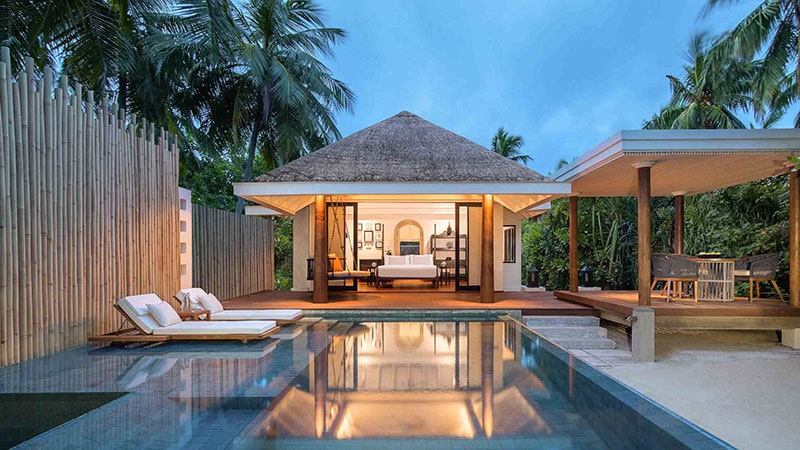
With a rare total solar eclipse and some of the best northern lights viewing in decades, 2024 has been a big year for astrotourism. But even when the calendar isn't stacked with celestial events, trips to experience wonders like dazzling meteor showers and lunar eclipses are on the rise—and hotels are taking notice.
Located far from the reach of harmful light pollution, in deserts, private islands and Dark Sky Reserves (designated spaces that boast exceptional star viewing), the hotels below offer some of the best stargazing experiences in the world. Rounding out their astral offerings, these nine properties also include activities like full moon hikes, aurora wake-up calls, open-air movie nights and other astronomy-related programming to help you explore the skies like never before.
Chase Travel is the first stop for your next adventure. Earn and redeem Ultimate Rewards points with your eligible Chase card when booking a trip through chasetravel.com . Chase Sapphire Reserve cardmembers who book a hotel stay through The Edit by Chase Travel will earn 3 points per dollar and receive special benefits, including daily breakfast for two, a property credit worth $100, plus early check-in, late checkout and a room upgrade, when available.
Zannier Hotels Sonop (Sonop Farm, Namibia)
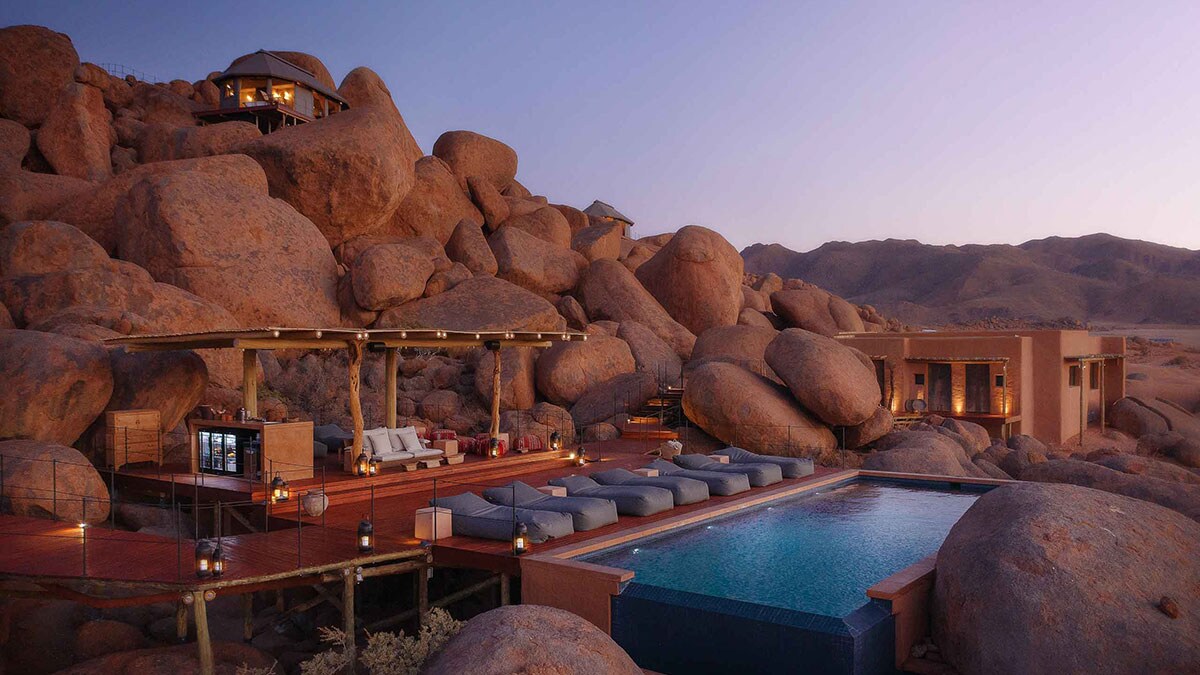
Set in the Namib desert, in the heart of one of the world's 16 International Dark Sky Reserves, Zannier Hotels Sonop should be a bucket-list stay for amateur astronomers. The hotel, which is inspired by the 1920s-era safari, takes advantage of its location by stocking rooms with vintage binoculars, maps and telescopes to aid your stargazing adventures. If those amenities don't push you outdoors to look up at the skies, your room's private terrace and roll-up canvas "windows" will.
As day turns to night, catch classics like "The Lion King" and "Titanic" at the open-air cinema or opt for the Astronomy Discovery experience, during which a guide will teach you to use a telescope and identify stars and planets from the property's main deck.
Hotel Rangá (Hella, Iceland)
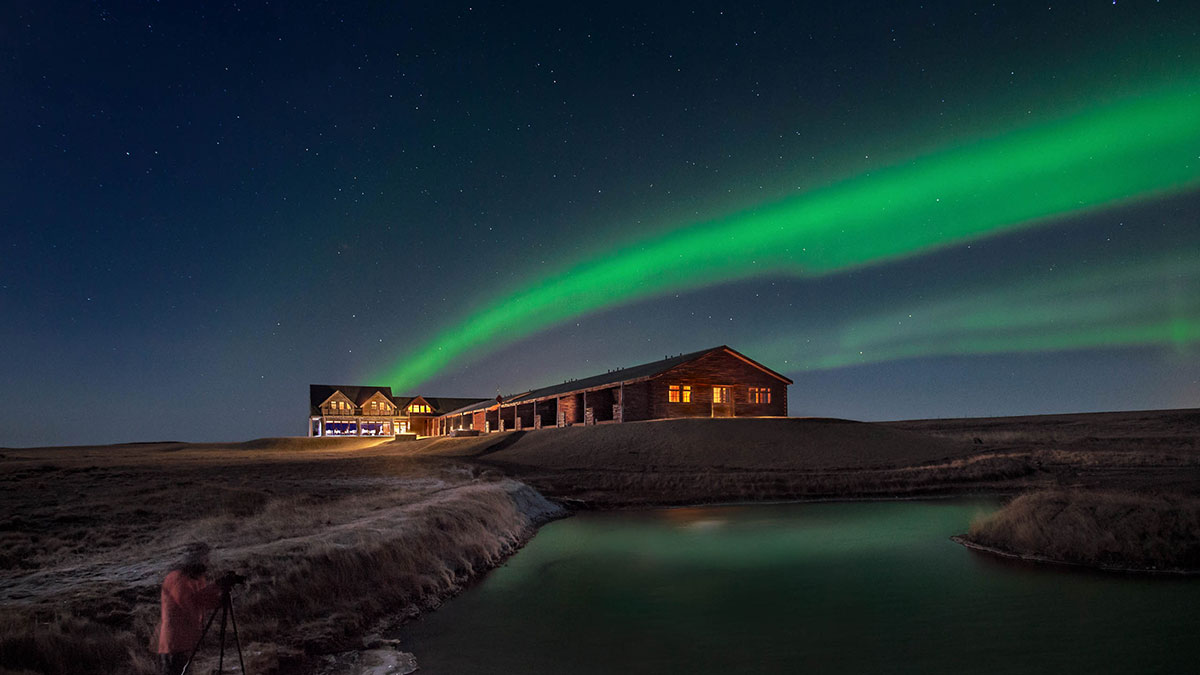
Chase the northern lights in the remote Icelandic countryside at Hotel Rangá, which offers a range of services from September to mid-April to ensure a successful viewing. With the press of a button on your room phone, you can set an aurora wake-up call to signal the hotel's concierge to reach out when the lights are visible. Then, head straight for one of the outdoor lookout benches or three geothermal hot tubs around the property for the best views. You don't even need to worry about packing the right outerwear or heavy photo gear, as the hotel has snowsuits, blankets and tripods for guests to borrow.
Hotel Rangá also has an on-site observatory complete with two high-powered telescopes. On clear nights, a local astronomer provides tours of constellations, galaxies, planets and other celestial bodies not visible to the unaided eye.
Anantara Kihavah Maldives Villas (Baa Atoll, Maldives)
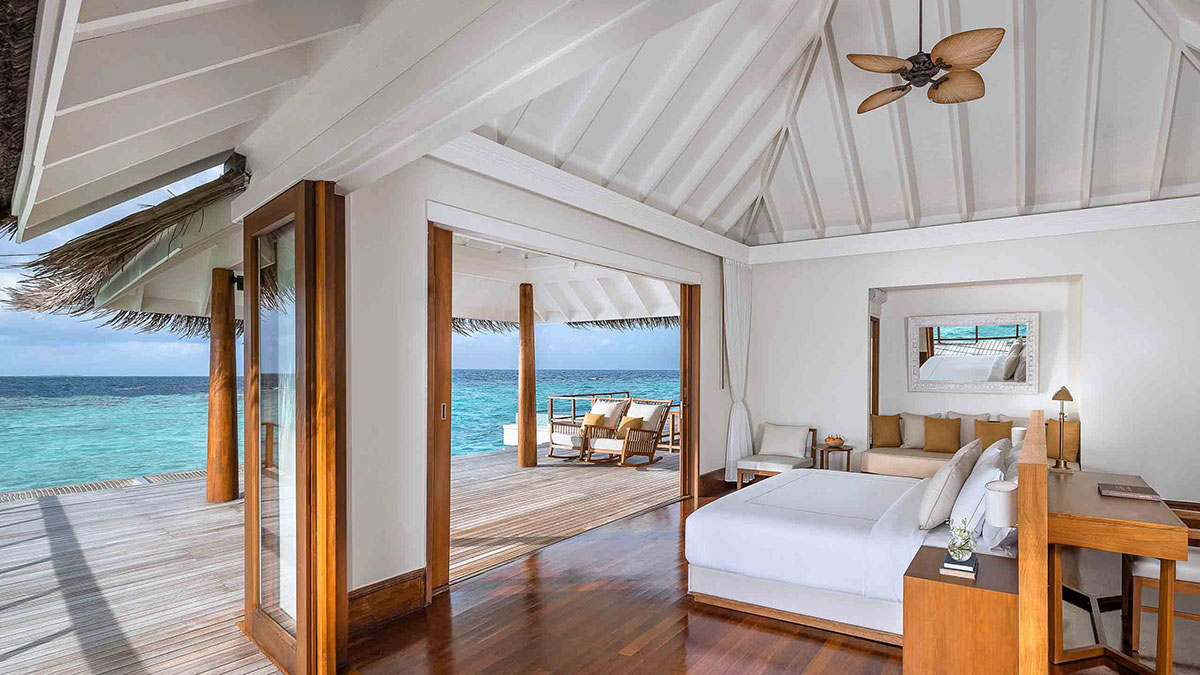
Home to the Maldives' only over-water observatory, Anantara Kihavah puts a luxurious spin on stargazing. The observatory doubles as the rooftop SKY Bar, where you can sip Champagne as the on-staff 'SKY Guru' points out planets and shares stories about the stars. The resort is located on a private island, and most rooms come with pool terraces or direct access to the beach for admiring the stars in total seclusion. If you're open to meeting your neighbors, hit the cinema under the stars for an outdoor movie paired with Champagne, oysters or popcorn.
AutoCamp Joshua Tree (Joshua Tree, California)
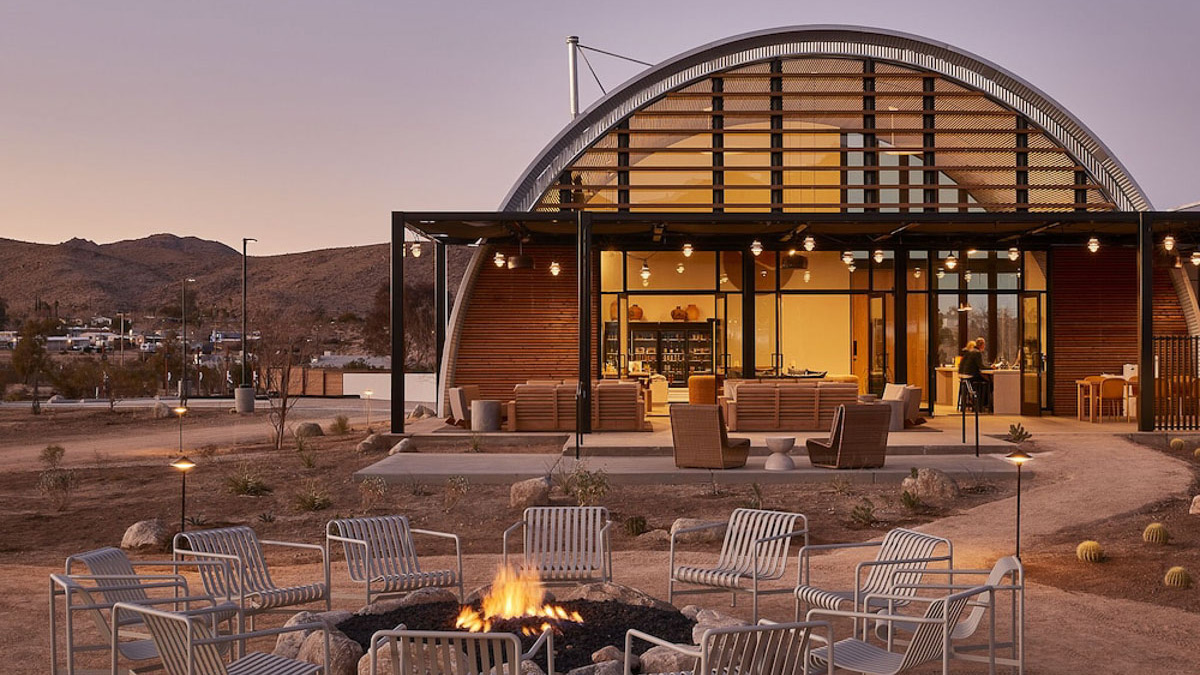
Take your camping trip to the next level in a decked-out airstream at AutoCamp's Joshua Tree location. All accommodation types feature kitchenettes and private bathrooms, so you can focus less on setting up camp and more on getting outside to see the skies.
Book the full moon hike, where a guide will lead you on a mile-long excursion through Joshua Tree National Park under the moonlight. Or, opt for a two-hour open-air sound bath, led by a certified sound practitioner after the sun sets during the new moon (arguably the best time to stargaze, thanks to the extra-dark skies). You can also sit by the campfire and join the hotel's monthly stargazing session, hosted by an astronomer and accompanied by a live DJ set. You'll get to check out the constellations while listening to disco and electronic dance records on vinyl.
Nayara Alto Atacama Desert (Atacama Desert, Chile)
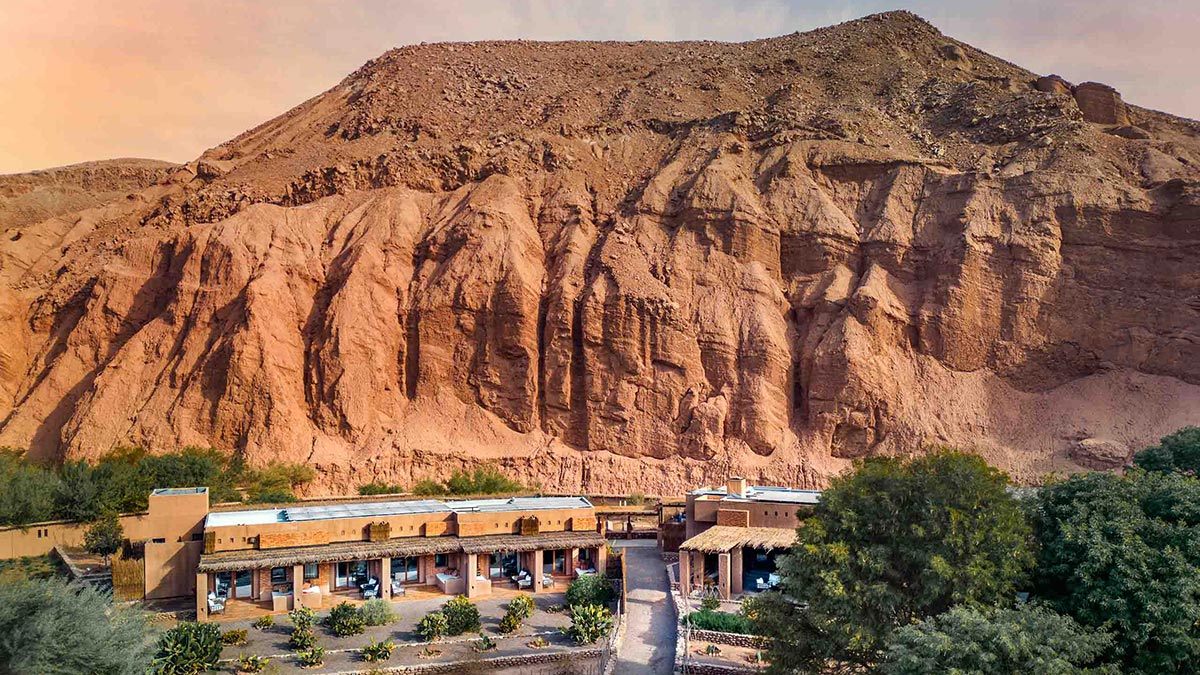
Located in Chile's remote Atacama Desert, Nayara Alto offers some of the world's best stargazing at the only open-air observatory in the region. During the property's guided Andean Astronomy experience, you can climb to the hilltop observatory while an expert walks you through the night sky. In the rooms, outdoor showers and terraces show off the stars and impressive views of the Andes Mountains. For even more breathtaking vistas, plan for a meal in the hotel's outdoor dining room, where you can enjoy traditional South American barbecue under the stars.
Hyatt Regency Maui Resort And Spa (Lahaina, Hawaii)
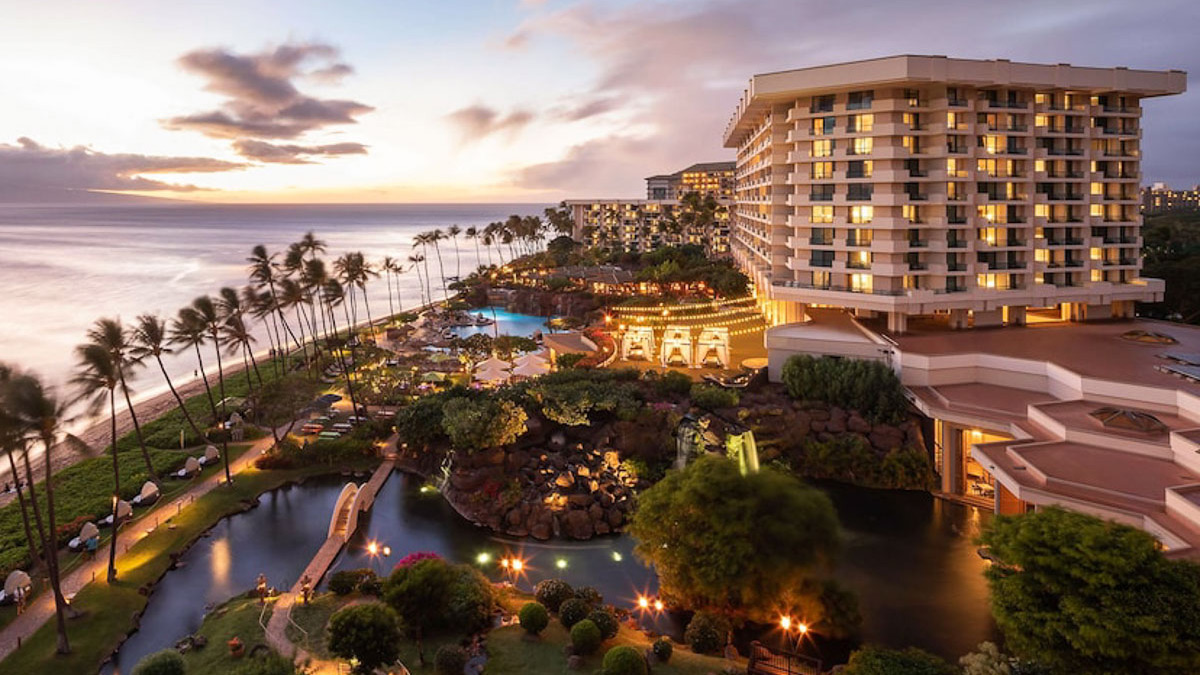
Once the sun sets at this Maui resort, guests can participate in the hotel's NASA ambassador-led astronomy program. The island's Pacific Ocean location offers a rare opportunity to spot an impressive 80 constellations (out of 88 in total), and the resort's rooftop observatory opens for a few hours every night for guided star searching. For travelers who want to hone a new skill, astrophotography workshops are available by request.
Arctic TreeHouse Hotel (Rovaniemi, Finland)
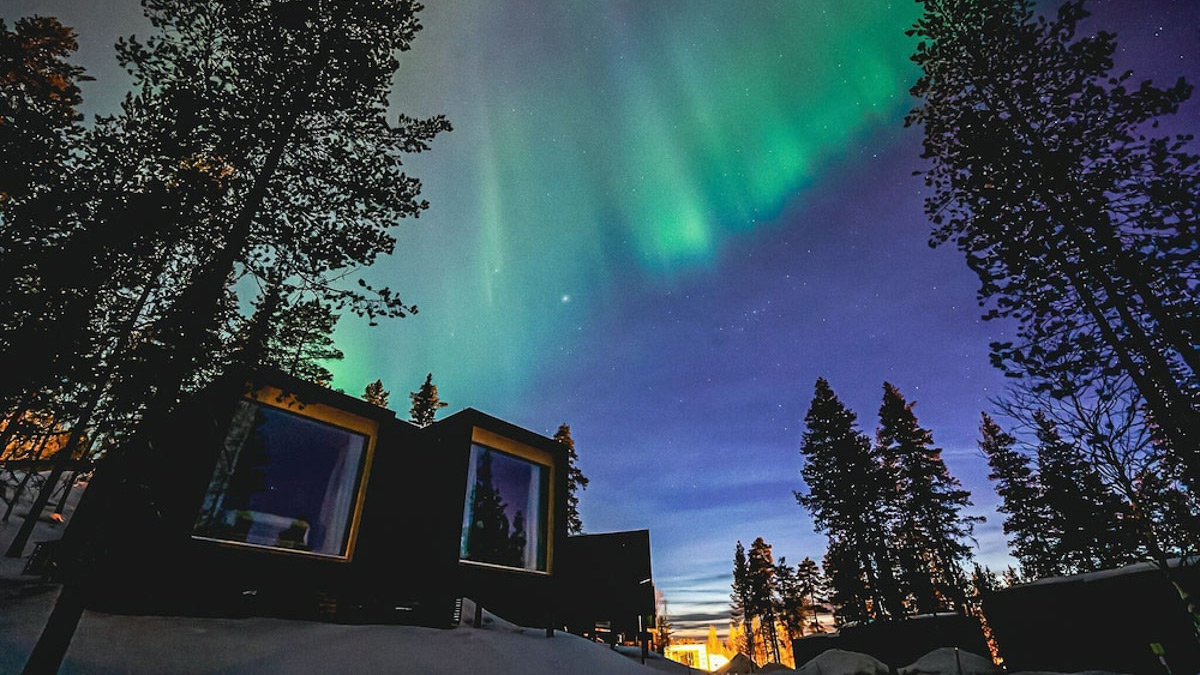
Witness the magic of the northern lights from one of the cabins at the Arctic TreeHouse Hotel, all of which feature large floor-to-ceiling windows. The GlassHouse suites even have fireplaces, kitchenettes and a private in-room sauna. When you're ready to venture outdoors, book the hotel's starry sky experience, which brings you through the snow-filled forest to enjoy a traditional Lappish feast on a heated sledge. Or, opt for a nighttime reindeer tour, where you'll be led to a crackling campfire under the moonlight.
ADERO Scottsdale Resort (Scottsdale, Arizona)
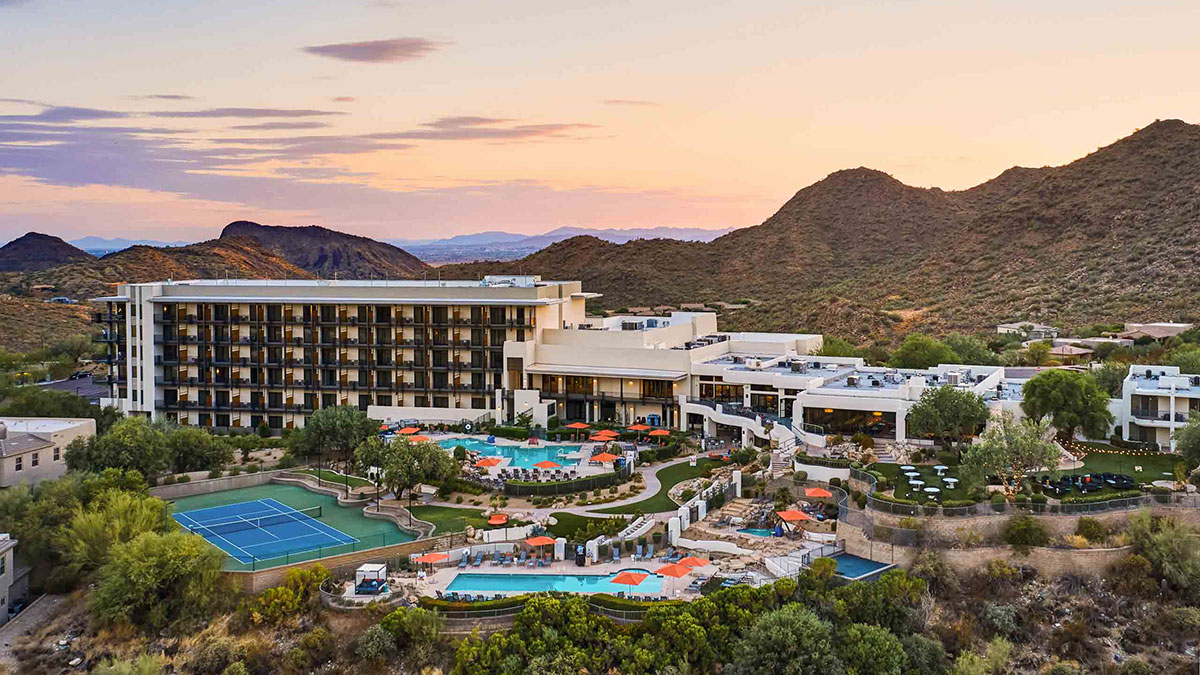
Because of its location in a designated Dark Sky Zone, ADERO has gone to great lengths to make stargazing possible from almost every corner of the property. The hotel serves as the only Dark Sky community resort in the Sonoran Desert, and each room is outfitted with a private balcony, allowing you to take advantage of the remote location during solo star viewing sessions. The hotel's stargazing offerings don't stop there, you'll also have complimentary access to high-definition telescopes and the Star Walk 2 mobile app for self-guided star viewing. Or, on Friday nights, spring for a guided tour with a trained ‘Star Dude.'
Spicers Peak Lodge (Maryvale, Australia)
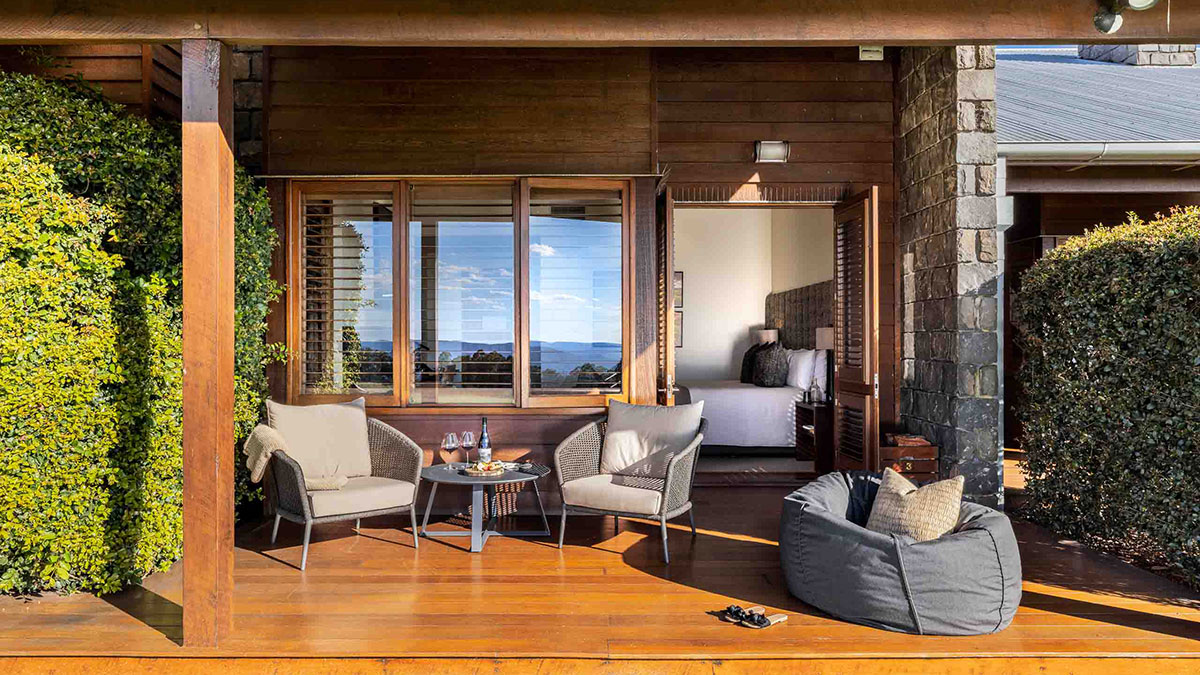
Experience peak outdoor adventure during your stay at this secluded mountain lodge in Queensland, which overlooks the rainforest during the day, and offers unpolluted views of the stars at night. The hotel's popular lodge suites feature a patio that opens up to the mountainside, where meals and drinks can be enjoyed under the stars. Guests can also join the guided campfire constellation experience, where a guide will teach you to navigate using the stars.
Booking with Chase Travel
Visit chasetravel.com for trip recommendations, editor-curated itineraries and access to top hotels, convenient flights, car rentals and must-do local experiences.
- Search Please fill out this field.
- Manage Your Subscription
- Give a Gift Subscription
- Newsletters
- Sweepstakes
- Destinations
The Best Times to Visit Paris for Great Weather, Events, and Fewer Crowds
Not that you can ever go wrong with a trip to the City of Light.
:max_bytes(150000):strip_icc():format(webp)/maya-kachroo-levine-author-pic-1-2000-1209fcfd315444719a7906644a920183.jpg)
Paris is one of the world’s most beautiful cities, stuffed with iconic landmarks, renowned museums, designer boutiques, and acclaimed restaurants.
There are advantages to visiting in every season. Although January through March are the chilliest months, they're also the quietest and the best for wrapping up in a chic coat and experiencing Paris like a local. In the spring, vibrant blooms in the famed jardins are a major draw, while the long summer days create the ideal conditions for sipping cocktails at an outdoor brasserie late into the evening. September and October are arguably the best months to visit, when the air turns brisk, Paris Fashion Week is in full force, and changing leaves accent the city.
To help you decide when to travel to Paris, here are the main tourist seasons:
- High season: June to August and late December
- Shoulder seasons: April to May and September to November
- Low season: Early December and January to April
Ready to book your trip to the City of Light? These are the best times to visit Paris depending on your priorities.
Best Time to Visit Paris to Avoid Crowds
Paris is one of the most popular destinations in the world, with tourism peaking between June and August. There are major downsides to visiting Paris in its high season: Large crowds make exploring popular attractions like the Eiffel Tower and Louvre more time-consuming, and you might need a reservation to dine at trendy restaurants. Hotel prices, too, will inevitably climb in the summer months.
If your main objective is to avoid crowds, visit between October and April — sidestepping the jam-packed holiday season in December. Go at the beginning or end of this window for temperatures still comfortable enough to sit outside at one of the quintessentially Parisian cafe tables.
To see the city's top tourist attractions with fewer people around, aim to visit on weekday mornings, but check the official tourism website since many museums are closed one day or more each week. Other crowd-beating tactics include buying tickets that allow you to skip the line and walking instead of squeezing into public transportation. Paris is best enjoyed on foot anyway.
Christopher Larson/Travel + Leisure
Best Time to Visit Paris for Good Weather
Travelers are drawn to Paris in the summer because of the long days and sunny weather. It's a stunning time to see the sights, from Sacré Cœur to the Jardin du Luxembourg, and the laid-back atmosphere at cafes and along the Seine is a treat. It's worth noting, however, that Paris is not known for its air conditioning. In fact, AC isn't as common in Europe as it is in the U.S., though most hotels have it. While Paris can see heat waves that bring temperatures in the 80s and 90s, summer temperatures are generally comfortable, in the mid-70s range.
Winter in Paris is relatively mild, but avoid visiting between December and February if you're averse to temperatures in the 30s and 40s. Does it snow in Paris? Not really. The city receives a dusting now and again, but visitors needn't pack bulky gear for extreme weather. Spring temperatures are typically pleasant, in the 50s and 60s, but come with a higher chance of rain — May is one of the rainiest months in Paris. Fall can also bring wet weather. From mid-September to November, after the Labor Day and Fashion Week rushes, Paris quiets down and the weather becomes crisp and autumnal.
Best Time to Visit Paris for Lower Prices
The cheapest time to visit Paris is during the off-season — in the winter, before and after the holiday rush, which means early December, January, and February. These months see average temperatures in the 30s and 40s, but if you don't mind the cold, you'll likely save on flights, public transportation, attractions, and accommodations.
Visiting Paris in winter is special — not least because the restaurants are less crowded and attractions quieter — as well as easy and affordable. Cons include fewer tour options and less frequent tours, including a reduced timetable for cruises on the Seine.
Best Times to Visit Paris for Holidays and Festivals
The city's calendar is packed with festivals, holidays, and traditions worth traveling for. Let's start with the biggest sporting events: the Paris Marathon is typically held in April, the French Open begins in May and ends in June, and the Tour de France typically zooms into Paris in July.
In May, museums across the city open their doors for free perusing after hours on La Nuit des Musées . In the summer, the iconic Fête de la Musique brings live music to parks and other public spaces on June 21, and Bastille Day is marked by military parades and fireworks on July 14. The Paris Jazz Festival is an ongoing event from June to September. Both fall and spring attract the international style set to Paris Fashion Week, held in late September/early October and late February/early March.
Starting around mid-November, the holiday season in Paris sees grand boulevards like the Champs-Élysées ablaze with Christmas lights and holiday markets popping up around the city. Parisians wrap up the holidays with the Feast of the Epiphany, January 6, which is when you'll find king cake (or galette des rois ) on market tables and in bakery windows everywhere.
Worst Times to Visit Paris
There's no bad time to visit Paris — the city is remarkable any time of year, even when it's bitterly cold or sweltering and teeming with tourists. But if you're easily annoyed by heat and crowds, you should probably think twice about a trip in July or August. If you happen to be in Paris during a heat wave, you could be quite uncomfortable sans AC in some attractions, shops, and cafes. And during the high season, prices are correspondingly high.
The holidays are another chaotic (albeit magical) time in Paris. By all means, go in December if you want to shop for unique gifts and see Christmas lights galore, but avoid this period if you're hoping for a quiet trip.
Related Articles

IMAGES
VIDEO
COMMENTS
Now, if you are interested in heat rather than warmth, July might be a better time to visit Iceland. It is the best time of year to visit Iceland for heat, as the hottest month of the year. It is also the least windy month. The weather in Iceland in July is generally extremely pleasant during this time of the year. While the nights are a little ...
The best time to visit Iceland is during the summer, when the terrain is passable even in the more remote areas of the country. Iceland is located close to the Arctic, but the effect of the Gulf Stream means that it has a milder climate than many other places at the same latitude. Even with that mild climate, winters can be harsh, but summers ...
August is one of the best times to visit Iceland. It is the warmest time of the year to travel the Arctic Circle, and summer temperatures average around 15°C. Days are similar to most of the Northern Hemisphere, with the sun rising between 5 a.m. and 6 a.m. and setting between 9 and 10 a.m.
June to August is the best time for outdoor recreation. While there's no good weather guarantee, this is your best chance of sun and warmish temperatures. Late June to early August is when most Icelanders go on vacation, filling up campgrounds wherever the best weather is forecast. This is the height of the tourist season - and height of ...
Things to consider if planning a trip to Iceland in 2023 (in theory, but check the latest decisions for large gathering due to the virus): 3rd to 6th February - Reykjavik Winter Lights Festival. Late March - Iceland Winter Games (maybe) June - Reykjavik Arts Festival. June 17 - Icelandic National Day.
When humans first arrived some 1100 years ago, Iceland seemed desolate: a layover for migrating birds, roamed only by the Arctic fox, the sole native land mammal. But expand the horizon through the wild hills, cliffs and glaciers to the ocean and offshore islands, and a visit to Iceland can tick some serious wildlife-spotting boxes.
Summer is the most popular time to travel to Iceland. Beginning in June, tourism numbers increase exponentially, so expect larger crowds. Many believe this is the best time to visit Iceland, especially if your Iceland trip means hitting the hiking trails. Peak summer is around July. The warmest months of the year bring some of the best weather ...
Avoiding the Crowds. Best Months: October-April. Iceland in winter, when the weather is cooperating, can give you thrilling opportunities to visit extremely popular places like the Dyrhólaey Peninsula and the Dettifoss waterfall without the crowds. As an added benefit, the car rental and hotel prices drop in some regions.
Best time to visit for the midnight sun. To experience the midnight sun, you must visit Iceland during the height of the summer, between May and July. The longest day of the year is at the summer solstice on the 21 June, which means this is when midnight sun peaks in Iceland.
The summer months of June, July, and August make up Iceland's peak travel season; this is the country's busiest time for tourism. The weather is the most pleasant in the summer, with the highest temperatures, mostly sunny and bright days, and the least chance of wind, rain, and storms.
There are many reasons to visit Iceland, such as exploring the Golden Circle, seeing the northern lights, or enjoying the midnight sun. However, each time of year brings different experiences and things to do. In this article, we will tell you the best time to visit Iceland and what each season brings in the land of ice and fire.
Best times to visit Iceland for… Different seasons are better suited to particular activities. Read on to explore the best time of year to visit Iceland for exclusive experiences and tours. Discover unique things to do in Iceland in any season. 1. Whale watching. Best season: Late spring to early fall
Deciding on the best time to visit Iceland hinges on what you're looking for in this mesmerizing land of contrasts. Each season reveals a different facet of its beauty, from the verdant summers illuminated by the Midnight Sun to the cosy winters under the Northern Lights. ... For wildlife enthusiasts, Iceland presents an array of ...
Summer. Summer in Iceland is one of the best times to visit because the weather is pleasant and the sun barely sets. If you'd prefer longer days to explore the outdoors and hike the defrosted fjords, you'll love that there are about 20 hours of daylight (on average) each month of this season.
Best Times to Visit Iceland for Good Weather. During the summer months — July and August — the temperature in Iceland hovers around 50 to 55 degrees Fahrenheit, making it a popular time to ...
The best time to visit Iceland depends on where you're going and what you want to see. Find the best time for your trip to Iceland with our complete guide. ... Wildlife is another highlight of visiting Iceland in May. From whale watching tours to puffin-spotting excursions, wildlife enthusiasts are sure to enjoy their stay. The adorable puffin ...
Best time to visit Iceland. While its far north ocean location makes for fluctuating weather, summer is the best time to visit Iceland. June-August offer long daylight hours, low 20°Cs warmth, plus summer festivals. ... our partners run boat tours and wildlife photography excursions to make the most of this spectacle. February is great for a ...
Iceland in Summer (July and August) The neverending day in summer - this was 2am in early August. The summer is short in Iceland and by August the nights are already drawing in but this is when most tourists visit the country. At lower elevations, the temperature in the south of the country is generally fairly warm and most of the snow has ...
Related: 9 common mistakes you don't want to make in Iceland. The best times for whale watching in Iceland. During the winter, it can be hard to spot any kind of wildlife in Iceland, given the harsh climate. If you're looking to spot migrating whales passing by, plan a trip between April and October — otherwise known as prime time for whale ...
The best time to visit Iceland is between September and March to see the northern lights, or between June and August for summer activities. While travel to Iceland may depend on your desired itinerary, generally, the best time to visit is during the summer. During this time, you'll experience warmer temperatures and long days of sunlight ...
Iceland in June: Weather and Wildlife. Iceland's average temperature in June is just below 50 F. The month has the least amount of rain and is the time of the midnight sun. From the 16th to the 29th, the sun sets after midnight and the 21st of the month is the longest day of the year with only a few hours of darkness.
High Season (June-August) is the best time for outdoor activities. In line with the rest of Iceland, the summer months are when the Westfjords opens up for outdoor pursuits: hiking, mountain biking, sea kayaking, wildlife spotting and more. All the major mountain passes and cross-fjord ferry routes linking the valleys of the Westfjords are ...
Known as the land of fire and ice, Iceland beckons to adventure-seekers year-round. The best time of year to visit Iceland depends on your traveling style and the type of adventures you enjoy. For ...
Ultimately, the "best" time to visit Iceland for wildlife depends on your personal preferences. Spring offers a fresh start, summer a vibrant explosion of life, autumn a serene contemplation, and winter a mystical interlude. So, listen to the call of the wild, choose your symphony, and get ready to be enchanted by Iceland's untamed beauty.
This is the time of year when the Northern Lights start making their appearance, so if viewing the dancing colours has always been on your bucket list this is the best time to visit Iceland. In addition to the usual autumnal colours, Iceland will also treat you to some natural pinks, purples, and magentas, courtesy of the lupins that grow in ...
12 Best Places to See the Northern Lights Around the World. From the U.S. to Scandinavia, here's where to view the magnificent northern lights phenomenon.
Location: Látrabjarg, Iceland Camera: Canon EOS R with a Canon RF 100-500mm F4.5-7.1 L IS USM lens and a PolarPro UV filter; 1/1000 second at f/5; ISO 1000 Behind the Shot: I traveled to Iceland with my best friend for my birthday, intent on finding and photographing puffins. We drove the Ring Road and ended at the farthest northwest point of ...
Book the full moon hike, where a guide will lead you on a mile-long excursion through Joshua Tree National Park under the moonlight. Or, opt for a two-hour open-air sound bath, led by a certified sound practitioner after the sun sets during the new moon (arguably the best time to stargaze, thanks to the extra-dark skies).
Best Time to Visit Paris to Avoid Crowds . Paris is one of the most popular destinations in the world, with tourism peaking between June and August. There are major downsides to visiting Paris in ...